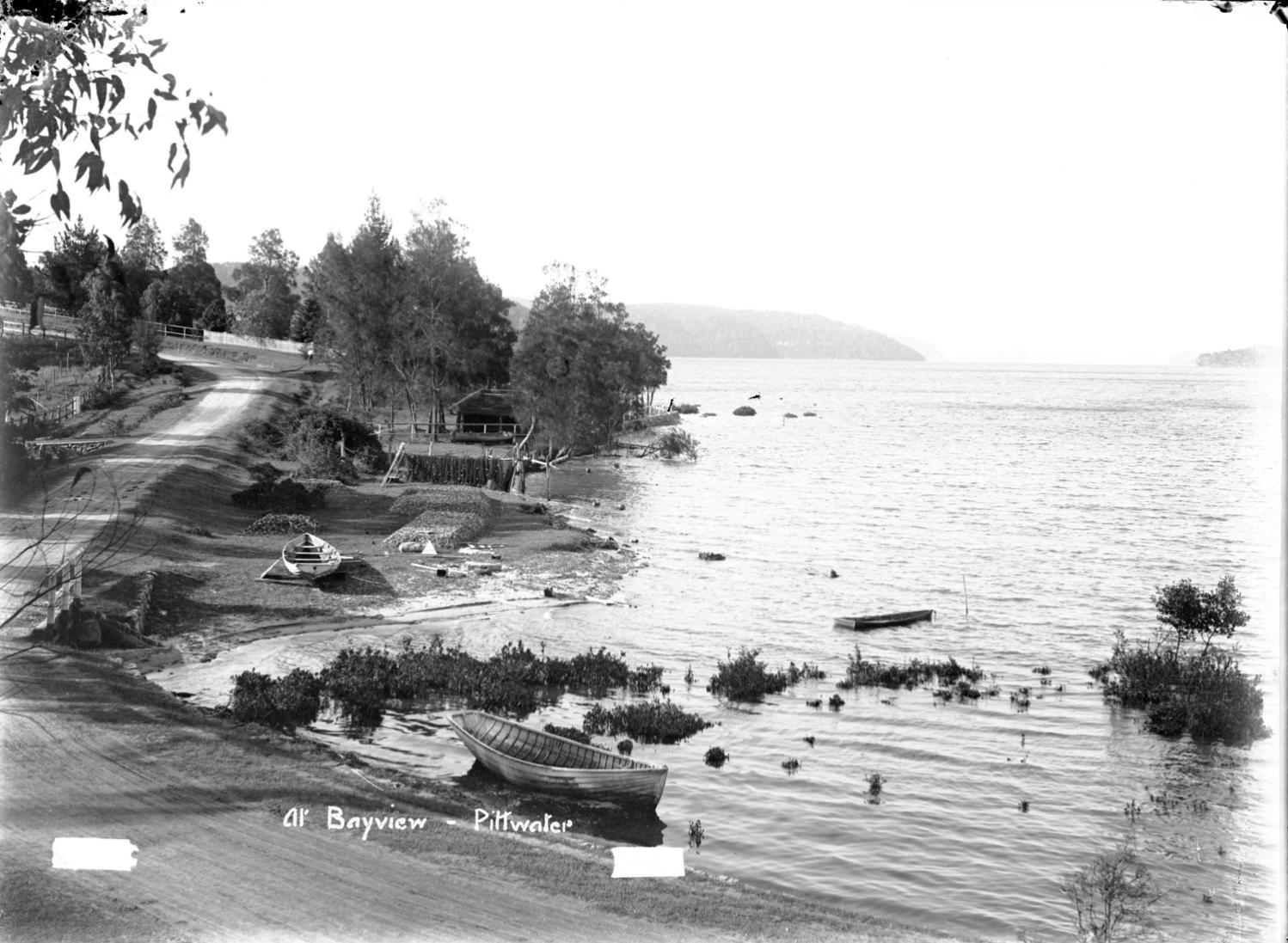Pittwater Roads II: Where the Streets have Your Name - Bayview
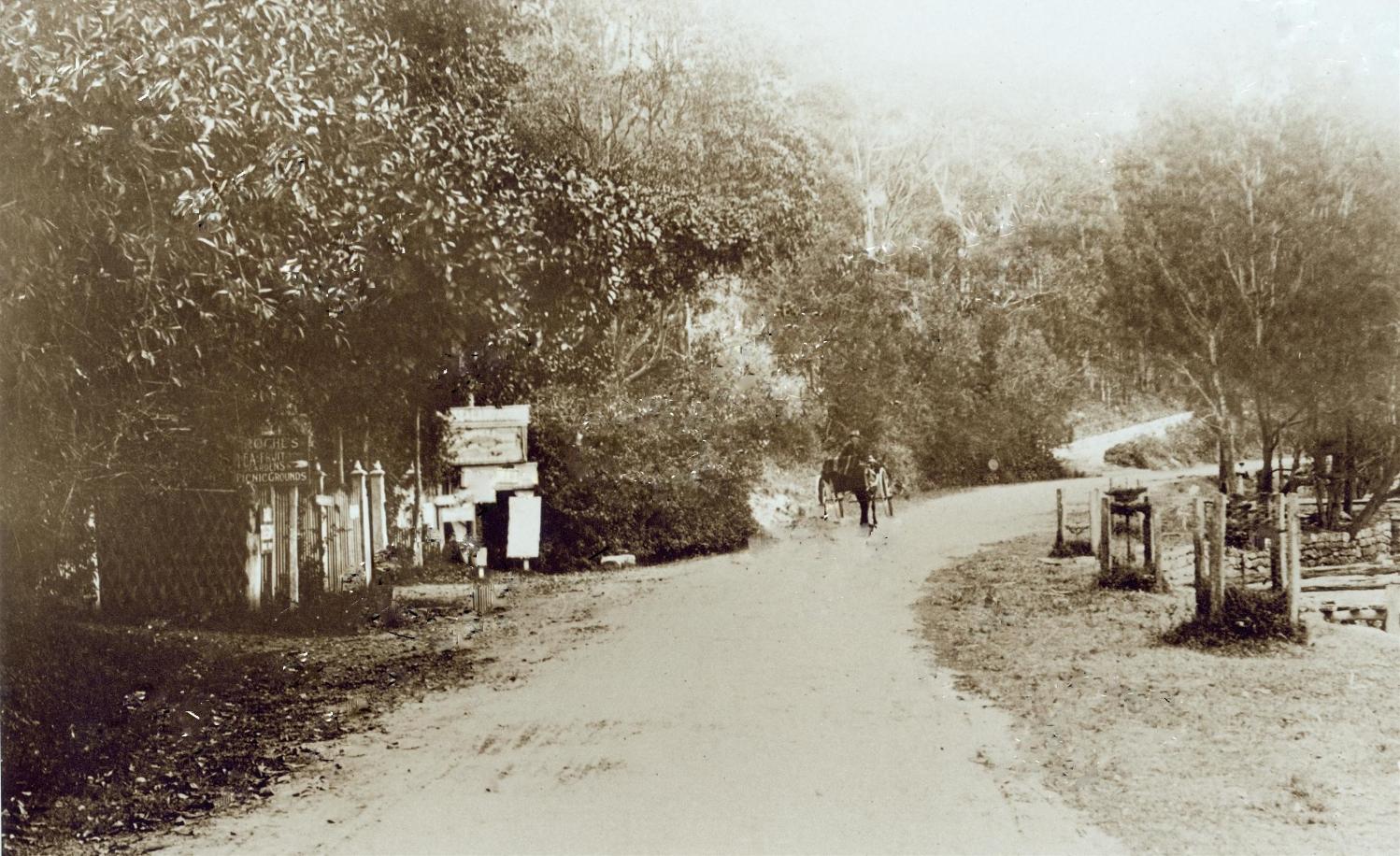
Bayview was named as 'Winne Jeramy' according to those who explored the area soon after Europeans and is marked on early subdivision maps under various names that are all variations given by the Indegenous peoples who lived here to those early Europeans in 1788 and 1789. Where Mona Vale becomes Bayview, in the golf course and this wetland and swamp, is one of the few places that has retained the name given by these original inhabitants to that place.
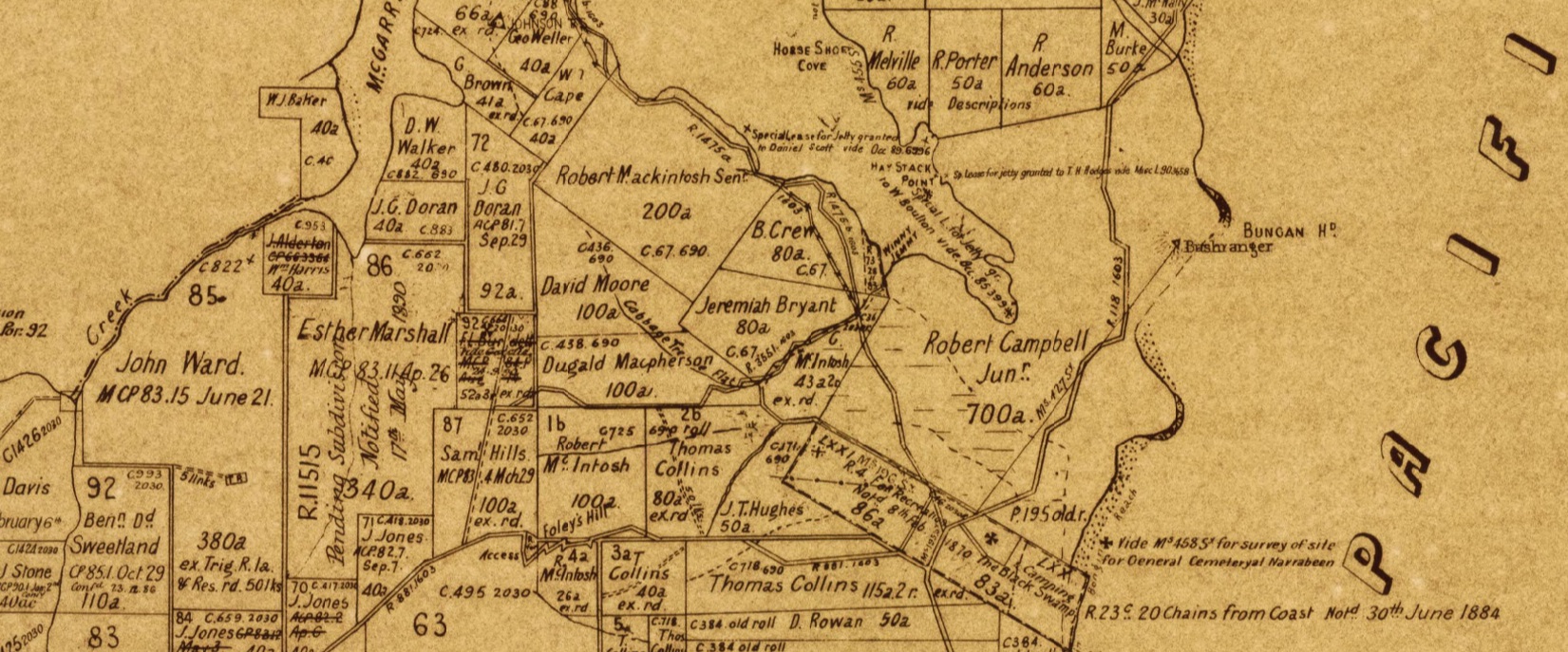
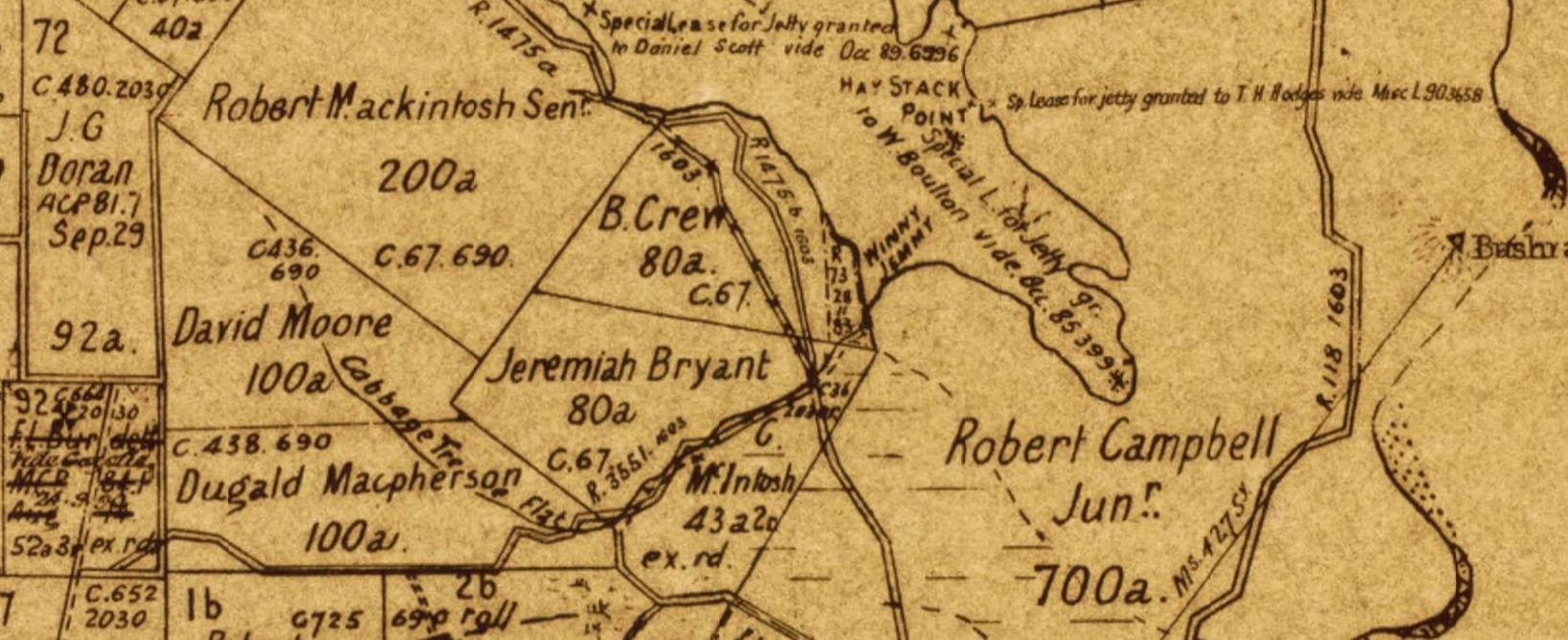
New South Wales. Department of Lands. (1886). Parish of Narrabeen, County of Cumberland Metropolitan Land District, Eastern Division N.S.W Retrieved from http://nla.gov.au/nla.obj-233833505 Section from - NB; 'Winny Jemmy'
An extract from Mr. Wheeler's Early Days of Bayview provides a physical description and some of those he recalled being in these places;-
At the head of the bay is the Newport “Maze,’’ a channel running into a tangle of mangroves, finishing in a swamp up near Bayview Road. A book of adventure — Drowning Maze —was written about this area by Miss Jean Curlewis. The Sydney Morning Herald commented as follows:
Visitors to Pittwater are acquainted with the intricate tangle of scrub and channel at the Newport end, but they probably have no suspicion of the exciting things that happen in this eerie locality. Miss Curlewis lets them into some of its intriguing secrets.
To the west of The Maze is Shaw’s Creek. I often saw old Jack Shaw stealing along silently in his ketch about dusk up McCarr’s Creek, like the “Old Grey Man of the Sea.”
GOVERNOR PHILLIP’S EXPLORATION.
On August 24, 1788, Governor Phillip, Lieutenants Johnston and Cresswell, Surgeon-General White and six soldiers were returning from an examination of the south entrance to the bay. We are indebted to Surgeon John White for his record of these early excursions. In his Journal of a Voyage to New South Wales, published in London in 1790, will be found many plates of plants, animals and birds, and valuable details of the discovery of lagoons and creeks along the coast from Port Jackson to Pittwater. Surgeon White writes with reference to the return of this party from what is now known as Barrenjoey:
We returned by the same passage along the coast, without seeing any objects worth notice, until we came to a convenient spot to encamp for the night, where there was great plenty of cabbage trees and tolerable water. While soup was making of some birds we had lately killed (which proved very good) and everything was getting ready for the night, the governor and myself and two other gentlemen took our guns and ascended a hill just above us. From this eminence we saw the southern branch of Broken Bay, which runs far into the country. During our return we picked up, in the distance of about half a mile twenty-five flowers of plants and shrubs of different genera and species, specimens of which I have transmitted to Mr. Wilson, particularly the Red Gum Tree. On the spot where we encamped, the grass was long, dry and sour; and in such abundance, that we set it on fire all around, for fear the natives should surprise us in the night by doing the same; a custom in which they seem always happy to indulge themselves.
We set off early* in the morning to look at the branch of Broken Bay (Pittwater), which we had seen the evening before; and were led to it by a path not very much frequented. At the head of this branch we found a freshwater river, which took its rise a little above out of a swamp. On this river we saw many duck and teal. Mr. Cresswell shot one of the latter, and I shot one of the former. At the head of this branch we found the country rough and impassable. Having followed the course of the river to its origin, we that day returned to Manly.
After traversing the terrain outlined in the preceding paragraphs, I gathered that Governor Phillip and his party camped on the evening of August 24, 1788, half a mile to the south of the lofty eminence which towers above Bungan Beach. There is a long vale in this locality situated just to the north-west of Bongin-Bongin, or, as it is now generally called, Mona Vale Beach, and many Cabbage tree palms are still to be seen there. Phillip and three members of his party walked to the top of the eminence (now called “Bushranger” trigonometrical survey station, 321 feet) just before dusk, and saw the southern part of Pittwater extending from Winnijimmi (Newport) to Church Point. The freshwater river that they explored the next day would be Shaw’s Creek, Bayview, and the swamp in which it took its rise was known one hundred years ago as Winnereremy. A map in the Department of Lands shows the entrance to that creek as Winni Jenny, and this name and Winnijimmi are probable corruptions of Winnereremy.
FIRST WHARF.
Returning to Bayview, the first wharf near the post office was erected by the Public Works Department in 1901 (* Bayview Wharf was Officially opened Saturday December 1st 1900) under the regime of the late E. W. O’Sullivan. The control of the wharf passed to the Warringah Shire Council at the inception of Local Government in 1906.
Bayview has always been famous for its Spotted Gums growing on the roadside. The grown trees are thirty and forty feet in the barrels, with bark of yellow-green shade. The foreshores in the early days were sold to settlers for £1 per acre—five shillings deposit, and the balance by yearly instalments. Swamp-oaks grew thickly round the shore, and the land was principally taken up by owners of small sailing vessels on account of the oak firewood, which was conveyed by sea and sold in Sydney. When the oak was depleted, owners sold their holdings for whatever they would fetch and bought another portion. As far back as 1829 heaps of shells were to be found in the creeks, and large vessels were engaged in shell-digging, the shells being taken to Sydney to be burnt for lime.
Before the road was made from Rock Lily to Church Point a track led through the farms, generally named after the nearest farm, and it is interesting to note the beginning of settlement along and near the shore of Old Bayview.
In May, 1814, Surveyor J. Meehan surveyed a farm of seven hundred acres for Robert Campbell where Mona Vale is situated to-day. In those early days fields of wheat and acres of cultivation flourished near Newport Road. In his survey book, written in pencil, Meehan refers to the mouth of a creek on Campbell’s property, and it is probably the one visited by Governor Phillip and his party.
EARLY SETTLERS.
In 1821 a man named Peter Patullo had a house near the south-eastern corner of Pittwater, where the beautiful green golf links of Bayview are situated to-day. In 1832 the following farms, extending from Winnijimmi to Church Point, were surveyed by J. Larmer : Jeremiah Bryant, eighty acres; P. Patullo, eighty acres; Robert Macintosh, two hundred acres and forty acres. On August 1, 1832, Thomas Langford applied to purchase forty acres within half a mile of Church Point. Some of these old settlers were squatters in the original sense of the term.
In the creek which passes under the Bayview Road, the Shaw brothers, old pioneers, kept the ketches which they built thirty years ago or more.
Close at hand is the home of Mr and Mrs James Shaw, pioneers of the district. Mrs Shaw, who was formerly Miss Ann Oliver, was born on the peninsula, Lovett Bay, in 1856. Before that, her father, William Oliver, lived in a cottage on Cape’s Flat, near the Fig-tree, the site of which has been swallowed up by encroaching tides. Mrs Shaw told me that she had a vivid recollection of a black fellow spearing fish under a mangrove on the point of the flat just below Baker’s orchard. That was when she was a young girl. “I can see that blackfellow now,” said she, “with the fish quivering on the spear just as I see the leaves shaking on that tree.”
On the bank of the small creek near the Bayview Post Office a blackboy who nursed her brother Tom was buried. Mrs Shaw said that probably the grave was covered over when the road was made to Church Point.
Why The Spear Was Stayed —
STORY OF GRIT AND SILENCE
"EVERY muscle tense, an aboriginal chieftain stood poised over a pond in a Mona Vale garden yesterday, his hunting spear drawn back for the deadly thrust. Although the carp beneath him was an easy target, the spear was not launched, for realistic though the figure is, it is made of cement, not flesh and. blood. He is one of the many works modeled by Mr. H. Tristram Squire, whose garden is filled with life-like representations. Kangaroo and wallaby, lizard and snake are mingled with a dozen flamingoes, whilst a group of children stand quietly looking on. The interior of the house is no less remarkable than the garden. "Blank walls are hard and damaging to the sight," said Mr. Tristram Squire yesterday, whose walls are painted to represent land and seascapes. "The effect of a distant scene keeps the eye at a more or less natural range." Mr. Squire told of a large, black snake that he recently made for a friend, who placed it in a natural position among some bushes in his garden. The next morning the snake was smashed by an alarmed milkman.
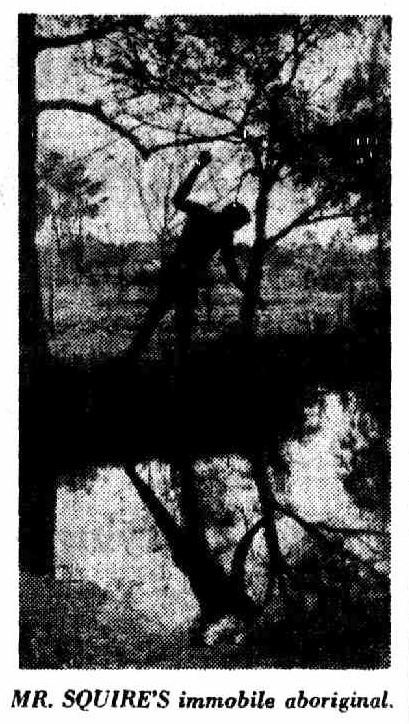
MR. SQUIRE'S immobile aboriginal.
Why The Spear Was Stayed (1935, May 14). The Daily Telegraph (Sydney, NSW : 1931 - 1954), p. 7. Retrieved from http://nla.gov.au/nla.news-article246472427
BLACKFELLOW STATUE REFUSED
Permission for the erection of a statue of a blackfellow spearing a water-buffalo, at the intersection of Park, Bassetts, and Bayview Roads, Mona Vale, has been refused by Main Roads Board.
One reason given was that the policy of the board was against the placing of objects on the road which might distract a driver's attention. The statue is a life-size one by a Mona Vale sculptor, Mr. H. Tristram Squire. BLACKFELLOW STATUE REFUSED (1937, June 17). The Daily Telegraph (Sydney, NSW : 1931 - 1954), p. 3. Retrieved from http://nla.gov.au/nla.news-article247138983
Haystack Point is near Newport and opposite Bayview. In the great flood of 1873 a haystack from a farm on the Hawkesbury River came floating down on its frame work of large logs. It was fastened to the logs with stringy-bark rope. By a freak of wind and tide, it drifted up Pittwater to a point just below the township of Newport. This gave it the name of Haystack Point. A number of pigs, which had managed to float down on the stack and feed on the hay, was retrieved by a fisherman from Mona Vale.
Continuing our old-time journey, the coach climbs a hill, and on the left was once a fine brick-kiln and drying sheds. Bricks of superior quality were made by J. Austin. I remember seeing Mr Symonds, an elderly gentleman, at a gypsy tea near Church Point in the year 1900; he was associated with Austin at the brickworks.
Near this spot, overlooking the water, were the residences of P. Taylor, W. G. Geddes, C. Bennett and Sir Rupert Clarke.
This has brought us to the twelfth mile-post from Manly. Along the road bordered with trees the coach descends to Figtree Flat, also known as Cape’s Flat, and the orchard of W. J. R. Baker, with “Killarney” cottage lying between the two. This flat with its green sward was a favourite picnic ground. The annual school picnic and distribution of prizes were held there on November 9 each year, the birthday of the then Prince of Wales (later King Edward VII.).
Baker’s orchard has long since disappeared. It comprised six acres of peaches, nectarines and other summer fruits, and two acres of oranges. The orangery was situated high up at the apex of the orchard. A row of quince and peach trees flanked the fence next to "Killarney." As Baker also kept poultry, it will be seen that Bayview was once a thriving poultry-farming and fruit-growing district. - - Extract from The Early Days of Bayview, Newport, Church Point and McCarr’s Creek, Pittwater By J. S. N. WHEELER. Journal and proceedings / Royal Australian Historical Society, Vol. 26 Part. 4 (1940) Pages 88, 7905 words. Call Number N 994.006 ROY Created/ Published Sydney : The Society, 1918-1964. Appears In Journal and proceedings, v.26, p.318 (ISSN: 1325-9261) Published 1940-08-01. Available Online: HERE
It will be recollected that last year, owing to the dry weather previous to harvest time, in several of the districts, especially about Pittwater, some of the wheat land was so dried up as to render the crop not worth reaping. One farm in particular, a field of no less than 70 acres was thus abandoned, and instead of reaping, the cattle and pigs were turned into it, to eat up what they could find, after which it was ploughed over and left until now, when an excellent crop has been reaped, yielding from 15 to 20 bushels an acre. THE CROPS. (1831, February 1). The Sydney Gazette and New South Wales Advertiser (NSW : 1803 - 1842), p. 3. Retrieved from http://nla.gov.au/nla.news-article2198797
Robert McIntosh Junior sold the 200 acres he inherited from his father to William Timothy Cape on 6 June 1834 for £130. On 1 January 1841 William Timothy Cape leased McIntosh’s 200 acre grant to John Johnson for £20 per annum. John and Charlotte Johnson were living there, with three children, at the time of the 1841 census. They were still there in 1845, when John Johnson, Peter Duffy, and Daniel Bullock were all named as being associated with illegal distilling at McCarr’s Creek. The three were all married to Oliver women. John and Charlotte’s children were: John Junior, born 1834; Frances (b.1836, married Richard Augustus Willoughby Green 1858); Henry (b.1840); William (b.1841); Charles (b.1847); Daniel (b.1850); Charlotte (b.1855, died 1875). William was born at Pittwater.
The Johnsons had departed from Pittwater by 30 August 1845, when Cape leased the 200 acres to Thomas Johnson Jones. This stretch of land at Bayview was known as Cape’s Flat. After Cape’s death it was sold to Albert Henry Turner for £200 on 2 June 1876.
No. 4,007. Pitt Water, parish of Narrabeen, 40 acres, granted to Wm. Timothy Cape. Applicant: Theodore Jas. Jacques. NOTICE UNDER REAL PROPERTY ACT. (1875, November 5). New South Wales Government Gazette (Sydney, NSW : 1832 - 1900), p. 3547. Retrieved from http://nla.gov.au/nla.news-article223586979
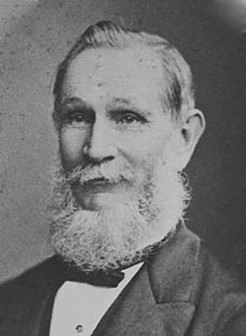 Theodore James Jaques (1823-1893; image at right), registrar-general and solicitor, was born on 6 October 1823 at Rochester, England, son of William Jaques, surveyor, and his wife Jane, née Hill. The Jaques family reached Sydney in July 1830 in the Roslyn Castle. Theodore was educated at the Sydney College under his brother-in-law, William Cape. In 1839 he became a junior clerk in the Supreme Court Registry Office. He applied for admission as a solicitor by virtue of his service to the Registry Office. Despite strong opposition from the legal profession the judges ordered that if he passed examination he could apply again. On 24 December 1856 he was finally admitted a solicitor but did not practice for many years. In 1852 he became a commissioner for affidavits. In 1857 he was made deputy registrar general, and took charge of the deeds branch. In the early 1860s he opposed the introduction of the Torrens titles system because it did not record marriage settlements and trusts. In 1864 Jaques was appointed registrar-general, a magistrate in 1865 and as chairman of the Land Titles Commission by 1867 advocated the handing to his department of all records of births, marriages and deaths, particularly those held by the Anglican registrar, Henry Kerrison James.
Theodore James Jaques (1823-1893; image at right), registrar-general and solicitor, was born on 6 October 1823 at Rochester, England, son of William Jaques, surveyor, and his wife Jane, née Hill. The Jaques family reached Sydney in July 1830 in the Roslyn Castle. Theodore was educated at the Sydney College under his brother-in-law, William Cape. In 1839 he became a junior clerk in the Supreme Court Registry Office. He applied for admission as a solicitor by virtue of his service to the Registry Office. Despite strong opposition from the legal profession the judges ordered that if he passed examination he could apply again. On 24 December 1856 he was finally admitted a solicitor but did not practice for many years. In 1852 he became a commissioner for affidavits. In 1857 he was made deputy registrar general, and took charge of the deeds branch. In the early 1860s he opposed the introduction of the Torrens titles system because it did not record marriage settlements and trusts. In 1864 Jaques was appointed registrar-general, a magistrate in 1865 and as chairman of the Land Titles Commission by 1867 advocated the handing to his department of all records of births, marriages and deaths, particularly those held by the Anglican registrar, Henry Kerrison James.
Jaques retired on 15 December 1870 because of ill health. He practised as a solicitor and in 1873 was appointed commissioner for affidavits for Victoria in New South Wales. In 1874 he went into partnership with his nephew, Alfred E. Jaques, who in 1878 joined Stephen & Stephen to establish the legal firm, Stephen, Jaques & Stephen, while Theodore continued to practise on his own. In September 1860 he had joined the Volunteer Infantry; he was commissioned captain in the Balmain company in December, promoted major in 1868 and retired as lieutenant-colonel in 1885. For years he was a vice-president of the Rifle Association of New South Wales. Jaques lived in Balmain and was active in local affairs and secretary of the Balmain Mechanics' School of Arts. He represented St Mary's Anglican Church, Balmain, on six synods. In 1876-79 he was registrar of the diocese of Sydney. He died from pernicious anaemia on 23 July 1893 and was buried in the Balmain cemetery. Predeceased by his wife Mary Ann (d. 4 December 1858), née Cook, he was survived by a son and a daughter. He left no will but his estate was sworn for probate at £13,826.
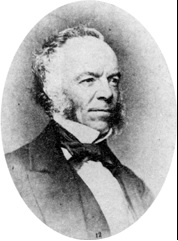 William Timothy Cape (1806-1863; image at left) was the eldest son and one of seven children of William Cape, schoolmaster and settler, and Mary Ann (nee Knight) who emigrated to Australia in 1821. He is known as among the best and most beloved early Australian teachers. He served in Sydney Council and then as the Member for Wollombi in the NSW State Parliament. He was renowned for adopting any cause which needed help and giving generously to others. For more, visit: http://adb.anu.edu.au/biography/cape-william-timothy-2234/text2207
William Timothy Cape (1806-1863; image at left) was the eldest son and one of seven children of William Cape, schoolmaster and settler, and Mary Ann (nee Knight) who emigrated to Australia in 1821. He is known as among the best and most beloved early Australian teachers. He served in Sydney Council and then as the Member for Wollombi in the NSW State Parliament. He was renowned for adopting any cause which needed help and giving generously to others. For more, visit: http://adb.anu.edu.au/biography/cape-william-timothy-2234/text2207
Part of 'Cape's Flat' was later reserved:
Department of Lands,
Sydney, 7th March, 1900.
HIS Excellency the Lieutenant-Governor, with, the advice of the Executive Council, directs it to be notified that, in order to enforce the saving and reservation contained in Crown Grant to William Timothy Cape, of 40 acres, being portion 27, on Pitt Water, parish of Narrabeen, county of Cumberland, dated the 8th day of April, 1840, and registered volume No. 59 (Register of Grants of Land 33), folio 33, it is the intention of the Crown to take possession of the lands comprised within the said reservation. [Ms. 1900-1,050 Dep.] T. H. HASSALL Government Gazette Notices (1900, March 7). New South Wales Government Gazette (Sydney, NSW : 1832 - 1900), p. 1917. Retrieved from http://nla.gov.au/nla.news-article221016173
In his own name, Robert II had applied to purchase 40 acres next to the 200 acres, on 28 March 1831. This was also sold to W.T. Cape on 6 June 1834, for £25. The deed of grant was made to Cape on 8 April 1840. In the 1889 lithograph below, half of this original McIntosh grant is shown being held by Benjamin James. On February 4th John Redman of Pittwater purchases 23 acres at Church Point on the point overlooking Pittwater from Jane James (nee Buist), the wife of Benjamin James junior (married 1868). Formerly the land was part of William Oliver’s land grant of 66 acres. On this property was a 3 room weatherboard cottage. After John Redman's death in April 1888, with his will naming Benjamin James Jnr. as one of the executors, the land now 17 ¼ acres, not 23 acres, is advertised for Auction on 15 August 1888. (SMH 13 August 1888 P.11)
Towards the Mona Vale end is the land grant of Jeremiah Bryant, who was a private soldier in the 73rd Regiment, stationed at Port Dalrymple (Launceston) when he was tried before a Bench of Magistrates on 3 September 1811 on a charge of having robbed His Majesty’s Stores there. He was convicted and sentenced to seven years’ transportation. On 13 May 1813 the remaining part of his sentence was remitted owing to “some degree of informality” in the trial and sentence. He was instructed to return to his duty as a private.
After going back to England, and being invalided out of the Army, he sought in 1819 to return as a settler. Meehan noted in his field book on 15 April 1821 that he meant to measure 80 acres for Bryant at Pittwater, next to Peter Patullo, “up to the swamp” (Winnyjimmy). He added “- cannot trace it”, perhaps indicating his difficulty measuring in the swamp.
Bryant advertised and cautioned the public in August 1822 that the 80 acres were his absolute and indisputable property. [Syd Gaz 23 Aug 1822] He had one acre of maize in September 1822. By 19 September however, he had sold the land to Robert Henderson. [Syd Gaz 4 Oct 1822] Henderson’s father-in-law, Patrick Geary, was living on this farm in 1826. It was officially granted to Jeremiah Bryant on July 6, 1833 and formally conveyed to Robert Henderson (also called 'Anderson' on some land maps) on February 8 1842. Henderson died on 11 November 1869, leaving the land to his grandson, who conveyed it to Frederick Thomas Humphery on October 14 1881.
Benjamin Crew was born in Bristol, England in about 1767. He arrived free in the Colony as a seaman on the Bridgewater, 750 tons, from London. The ship reached Port Jackson on 12 March 1803. Crew remained in the Colony for the rest of his life. Crew settled at Bong Bong, where he received a 60 acre grant of land on 9 July 1822. Although he may well have visited Pittwater, it does not appear that he ever resided there permanently.
Mary Finegan or Crew, the wife of Benjamin Crew, purchased Peter Patullo’s 80 acre grant at the head of Pittwater at a Sheriff’s sale in 1821. She died on 13 September 1831, leaving the 80 acre grant, and property in Pitt Street and Kent Street, Sydney, to Revd. J.J. Therry. On 22 November 1833 Benjamin Crew entered a caveat, stating his title to the land and his reasons for requiring the grant to be made out to him instead of Revd. Therry. Crew won his case, and was granted the 80 acres on 26 August 1834. He then sold all the property in question to the Revd. Therry on 10 September 1834 for £500, of which £400 was to be paid at a later date. Benjamin Crew died in Berrima NSW in 1856, aged 89 years. [2.]
The present day site of the Bayview Golf Course was originally part of three separate parcels of land owned by George McIntosh, Dugald MacPherson and Robert Campbell. Dugald Macpherson (also spelt Dugal McPherson) appears to be the D Macpherson who was Chief Clerk for the Colonial Treasury, passing away in 1854, when his wife inherited his holdings and held onto some lands, despite claims against them, until she passed away in 1877. J T Hughes is John Terry Hughes, a nephew of one of the richest landholders in colonial NSW, Samuel Terry, although he had thousands of acreage to his name as well. John Terry Hughes passed away in 1855, but not before he devised many of his landholdings to his children - more under Extras. Much of his Bayview-Mona Vale holdings were eventually brought under the Real Property Act by:
NOTICE UNDER REAL PROPERTY ACT.
APPLICATIONS having been made to bring the lands hereunder described under the provisions of the Real Property Act. Certificates of Indefeasible Title will issue, unless Caveats be lodged in Form B of the said Act, on or before the date opposite each case respectively. Diagrams delineating these lands may be inspected at the Registrar General's Office, in Elizabeth-street, Sydney.
Dated this 6th day of April. 1887, at the Registrar General's Office, Sydney.
E. G. WARD,
[2379] Registrar General.
No. 6,675, Pitt Water, 62 acres,—comprises the land granted as 60 acres to J. T. Hughes. Applicant Frederick Caesar Hedemann, Sydney. 15 June, 1887. NOTICE UNDER REAL PROPERTY ACT. (1887, April 7). New South Wales Government Gazette (Sydney, NSW : 1832 - 1900), p. 2508. Retrieved from http://nla.gov.au/nla.news-article224184871
More in Pittwater Roads II: Where The Streets Have Your Name - Warriewood.
Dugal Macpherson's grant of 100 acres was gazetted on November 15, 1853. Twenty five of these acres now comprise the 4th, 5th, 6th, and 7th holes of the Bayview Golf Club. This land was purchased by Walter Baker, a retired farmer of Manly in May 1928 who transferred it to Alfred Walter Pearce, tobacconist on June 20, 1932. It then passed to Francis Nugent, electrician on September 2, 1932 and subsequently to John Orr on August 30, 1933.
Robert McIntosh Snr. died in 1829. His son and heir, Robert Jnr., who also had land holdings in Pittwater, later married and had 10 children, George being born on June 14, 1833. George McIntosh became a clergyman and lived at Narrabeen. He purchased the Winnererremy Swamp holding shown on the map above on November 27, 1874 for the sum of £43 10 shillings. George held the land for only 19 months before it was transferred to Robert McIntosh (it is not recorded whether this was his son or his brother of the same name). The 42 acres and 2 roods of swamp stayed in the family and on the death of Robert Edward McIntosh in January 1908, the land was inherited by Grace Jane and Edward Donald McIntosh.
John Orr, sheep farmer of Mona Vale became the owner in 1924 and on May 9, 1933 he leased the land to Harry Cochrane Scott, golf professional and Owen Fenner Clayton, salesman, both of Bayview. Christina Denison Orr inherited her husband's land in November 1941 and it was eventually purchased by the Bayview Golf Club in 1967.
Another small section of the Bassett-Darley estates, just over 7 acres, passed to John Orr in April 1925 from Margaret Holliday of Manly. [3.]
The large section where Bayview Retirement Village now is was the site of the Koala Refuge created by Sir Edward Hallstrom, who died February 27th, 1970. A guest of the MWPHS in January 2014, John Bungey, Landscape Designer, was involved in the development of this site from 1975. John described his initial engagement by Tony Baldwin, a real estate developer on the North Shore, after the landscaper he had originally employed had been overwhelmed by the size of the project. The other important element in the creation of Bayview Gardens was the architect, Geoffrey Twybill, formerly of Waratah Street, Palm Beach (RIP), who had become a specialist in the design of retirement complexes.
John elaborated on the way the gardens were developed moving up the site and the creation of Annam Road which now encircles Bayview Gardens, although sections of this show up on earlier subdivision lithographs. In his Talk Mr. Bungey described the manner in which the native vegetation had been retained as much as possible, including such trees as Scribbly Gum, Swamp Mahogany and Angophora. The sheer scale of managing the various independent contractors on site, was not only due to Tony Baldwin, but also due to Noel Moss, the builder. The approximate time of development was 10 years and over time there were a number of awards earned by John and others involved in the development of the site.
While the focus of the talk was on Bayview Gardens, there were many questions from the audience as to the activities of Sir Edward Hallstrom. The zoo had been created as a forerunner to his involvement with Taronga Park Zoo which had commenced in 1937. Taronga Park itself opened in 1916 after the closing of Sydney’s first zoo at Moore Park. Sir Edward acquired the market garden and farmlet at Mona Vale/ Bayview in 1947 and this property functioned as a supplier of fodder to Taronga Park until 1975. [4.] Sir Hallstrom's land holdings in the present day industrial area of Mona Vale were all brought under the Real Property Act in the mid 1950's.
The other section nearby goes back to one of the earliest of the European settler families in the Pittwater area. On September 8th 1881 Honorah Collins, formerly of what we today call Careel Bay and Avalon Beach, purchased from Therry’s estate the 80 acre grant at Bayview, next to Winnyjimmi Swamp, for £80, which was the market value of the land at the time. Her daughter Katherine, married name Roche, became the postmistress at Bayview in 1882.
After the main road through Bayview and Church Point had been established, originally called the 'Bay View' road and later on, 'Pittwater' road, the subdivisions of land holdings away from this main thoroughfare necessitated access to these blocks and the building of all those side streets and roads. In choosing this a similarity to the names chosen for Careel Bay (then named 'Clareville') and present day Avalon Beach environs (then named 'Brighton'; and 'Josephtown' per J. J. Therry's wishes) was followed.
The other surprise, and in keeping with retaining the original indigenous name for the swamp area, is that only a handful of street names are in existence to honour those original land holders. A large number is named for fauna and flora and Aboriginal words are utilised. There are also a few references to favourite water craft - one of Mark Foys' favourite yachts giving the name to one street on the Bayview-Church Point verge.
Warringah Shire Council - October 1928 NAMING AND RENAMING OF ROAD
Deputy Shire Clerk: ... (b) Request by L. P. Horton for rearrangement of the naming Of Kananook Avenue and Noolinga Road, Bayview, and recommending that the section of Noolinga Road between Pittwater Road and Kananook Avenue be renamed Kananook Avenue. 21. Resolved that the recommendation be adopted.
Many of these subdivision lithographs that are in what we today call Church Point were also named as being in 'Bay View' - even into the years where the name that was used to describe this outlook, in being a place of a bay with a view, became one word as 'Bayview' and the road, formerly known as the 'Bay View Road' was renamed as 'Pittwater' road from its juncture with the same at Mona Vale in 1951, while everything north of there then officially became the 'Barrenjoey' road after being for so long the 'road to Barrenjoey'. Early Bayview and Church Point overlap in the way they were named during subdivisions - with many named 'Bay View' in what is actually current day Church Point. Those in what we today call Church Point will run in the Church Point Street Names page to follow.
Changes in the landscape itself show through the development of these places and the roads that gave access to them, as places for recreation for the growing permanent populace as the shift from a strictly rural area, to a recreation destination and then to one that is suburban took place. The difference between what we today call Winneremerrey Bay and park, or the reclaiming works that formed Rowland Reserve at Bayview, or even the building of bridges and covering over Aboriginal graves, as alluded to above, and even the works undertaken by Mr. Orr, with some articles stating tonnes of trees were cleared and watercourses changed, all shaped that landscape.
Land reserved at the Bayview-Mona Vale junctions:
Department of Lands,
Sydney, 28th November, 1881.
RESERVES FROM SALE FOR CAMPING AND OTHER PUBLIC PURPOSES.
HIS Excellency tlie Governor, -with the advice of the Executive Council, directs it to be notified that in pursuance of the provisions of the 4th section of the Crown Lands Alienation Act of 1861, the land specified in the Schedule appended hereto shall be reserved from sale for camping and other public purposes.
JAMES HOSKINS.
No. 73. County of Cumberland, parish of Narrabeen, area about 7 acres. The Crown Lands within the following boundaries : Commencing on the southern shore of Pitt Water, at the junction of the western margin of Wimererremy Swamp; and bounded thence on the west, by the margin of that swamp forming the eastern boundary of P. Patilla's, now B. Crew's, 80 acres, bearing southerly to the intersection of the prolongation of the north-east boundary of G. M'Intosh's 43 acres 2 roods; thence bounded on the south-west by that prolongation and that north-cast boundary bearing south-easterly to the western boundary of Robert Campbell's 700 acres ; and thence by part of that boundary and the southern shore of Pitt Water aforesaid northerly and north-westerly, to the point of commencement. RESERVES FROM SALE FOR CAMPING AND OTHER PUBLIC PURPOSES. (1881, November 28). New South Wales Government Gazette (Sydney, NSW : 1832 - 1900), p. 6134. Retrieved from http://nla.gov.au/nla.news-article221697390
After this land reservation - from Warringah Council records:
Department of Mines,
Sydney, 31st October, 1882.
PRELIMINARY NOTIFICATION OF PARISH ROADS.
HIS Excellency the Governor, with the advice of the Executive Council, having deemed it expedient to open and make the several Parish Roads mentioned in the Schedule appended hereto, to be maintained at the expense of the parishes through which they pass: Notice is hereby given that, in accordance with the provisions of the Act 4th William IV No. 11, plans and books of reference, showing the intended lines of the Roads in question, are now deposited at the Office of the Surveyor-General in Sydney, and at the Police Offices mentioned.
It is requested that any well-grounded objections that may exist to the formation of the Roads in question may be transmitted in writing to the Clerk of the Executive Council within one month from this date.
By His Excellency's Command,
ARTHUR RENWICK.
Schedule referred to.
Roads No. 82-3416 81-1243-7 S.G. R.1475b,
Description of Road.
Deviations in the road from the Manly Beach and Pittwater Road to McCarr's Creek, near the Church. (1) From the said road, within J. Bryant's (now Anderson's) 80 acres, to the said road, at the south boundary of R. Mcintosh, senr.'s (now A. H. Turner's) 200 acres. (2) From the said road within R. Mcintosh, junr.'s (now W. Baker's) 40 acres to the said road, near the Church, within W. Oliver's (now J. Wilson's) 66 acres, parish of Narrabeen, county of Cumberland,—in lieu of parts of road previously confirmed by notice in Government Gazette, 14th February, 1879, folio 684.
Names of reputed owners or occupiers through whose properties the Roads pass.
— Anderson, .T. Collins, A. H. Turner, W. Baker, J. Wilson. Police Offices at which plans and books of reference hare been lodged. Gosford. PRELIMINARY NOTIFICATION OF PARISH ROADS. (1882, October 31). New South Wales Government Gazette (Sydney, NSW : 1832 - 1900), p. 5749. Retrieved from http://nla.gov.au/nla.news-article225833100
And an advertisement for land that shows it has been built:
PITTWATER.
100 ACRES MAGNIFICENT LAND, on the southern shore, opposite the Pittwater Hotel, TO BE SOLD IN ONE BLOCK.
This land immediately adjoins the rapidly improving orchard property belonging to Mr. M'Keown. The new road has been completed right along this property, giving direct communication from Manly.
The soil is of the richest possible description, and the land gently rises from the water, commanding most Beautiful views of the charming Hawkesbury scenery.
Plans in course of preparation.
HARDIE and GORMAN have received instructions to sell by public auction, at their Rooms, Pitt-street, at 11.50 o'clock, WEDNESDAY, 20th September, 100 acres of land at Pittwater, the choicest spot In the whole district, and which was selected by the present owner as a site for a residence. Advertising (1882, September 7). The Sydney Morning Herald (NSW : 1842 - 1954), p. 15. Retrieved from http://nla.gov.au/nla.news-article28376790
Department of Roads and Bridges,
Sydney, 8th May, 1890.
TENDERS will be received until 11 o'clock on THURSDAY, the 22nd MAY, from persons willing to contract for
10 T. Eastern-road, Gordon.
17 T. Cowan-road, Gordon.
18 T. Manly to Pittwater-road.
19 T. Bay View-road, Pittwater.
Tenders to be addressed to this Department, where specifications may be seen. Advertising (1890, May 17). The Australian Star (Sydney, NSW : 1887 - 1909), p. 8 (THREE O'CLOCK). Retrieved from http://nla.gov.au/nla.news-article230617726
Pittwater.—Lost or stolen, about three weeks ago, from the person of Christopher Donohue, road contractor, Narrabeen, whilst in the vicinity of the “Rocklily Hotel,” Pittwater,— twenty-two £1-notes on the Union Bank, Sydney. Miscellaneous Information. (1890, October 1). New South Wales Police Gazette and Weekly Record of Crime (Sydney : 1860 - 1930), p. 305. Retrieved from http://nla.gov.au/nla.news-article251637772
As with so many rural enterprises, as Pittwater was considered 'country' then, residents had to step up and speak for themselves through their local MP;
MESSRS, BURNS AND CULLEN, members for St Leonards, brought under the notice of the Minister for Works yesterday the movement at Pittwater for the erection of a public wharf at Newport .They presented an influentially-signed petition in favour of the erection of a wharf at Sunnyside, and stated that another petition, praying that the wharf be erected at the foot of Queen's-parade, in the same quarter, had been sent to the Minister for Lands. Mr. Bruce Smith promised to make the necessary inquiries as to the necessity for the wharf, and to let the deputation know the result. The Sydney Morning Herald. (1889, May 22). The Sydney Morning Herald (NSW : 1842 - 1954), p. 8. Retrieved from http://nla.gov.au/nla.news-article13725373
THE WHARF AT PITTWATER.
Messrs. Burns and Cullen, M.L.A., introduced to the Minister for Public Works yesterday a number of the residents of Pittwater, who wished to bring under his notice certain matters concerning the erection of a wharf at Sunnyside, Pittwater. Mr. Bauer Smith told the deputation that there were already two reports in the Department, and these were in opposition to the erection of the wharf. However, he was not quite satisfied as to what was the best course to adopt, and he would therefore direct an officer of the department to specially report on the project. THE WHARF AT PITTWATER. (1889, July 26). The Sydney Morning Herald (NSW : 1842 - 1954), p. 4. Retrieved from http://nla.gov.au/nla.news-article13726589
There were already two wharves on the Newport side of the estuary, one towards where Waterview Street Mona Vale is now, and the Victoria Wharf built by Piles and Jeannerett in 1880 and named for Queen Victoria. This was the place her sons boarded a steamer for their visit and a day trip up the Hawkesbury River in 1881. It would take more lobbying of their representatives to get a public wharf built for the people on the western shores, and years of it before Tenders were called and a contractor selected - the reasoning was there weren't enough people or produce on the Bayview side and the Church Point wharf could service those needing to land here - it had been built in 1885 in order to meet the needs of children living further afield coming to school - visit Church Point And Bayview: A Pittwater Public School Set On The Estuary. Something closer to the farms around the Bayview end was needed though as the wharf at the same spot J J Roche had built had been destroyed by the water, and so the residents formed a Community Residents Association and renewed their efforts:
DEPUTATIONS TO THE MINISTER FOR WORKS.— A number of deputations will wait upon the Minister for Works this morning. At 11.30 Mr. D. Thomson, M.L.A. will introduce a number of residents of Bayview with reference to a wharf at Bayview. At noon the residents of Narrabeen and Pittwater will press upon the Minister the necessity of tramway traffic being provided between Manly and Narrabeen. The Sydney Morning Herald. (1898, October 13). The Sydney Morning Herald (NSW : 1842 - 1954), p. 4. Retrieved from http://nla.gov.au/nla.news-article14152336
WHARF ACCOMMODATION AT BAYVIEW. A deputation was introduced by Mr Dugald Thomson to the Minister for Works yesterday. It comprised representatives of Bayview, who urged the Minister to provide adequate wharfage accommodation for local requirements. There was at present a wharf at Church Point, but that was too far removed from the centre of population and trade. If there had been deep water right up to the shore that deputation would not have troubled the Government, but owing to the existence of long mudflats the cost of erecting a suitable wharf would be so great that it would not pay private enterprise to undertake the work. Fishermen and settlers generally were seriously handicapped now because of the cost and the difficulty of shipment of their fish and produce.
The Minister said he recognised that the construction of a wharf would be convenient to many persons, and he thought a case had been made out for further inquiry. He would not make any promise however, because he saw from the papers before him that the undertaking would be an expensive one, and he would not be justified in sanctioning it unless it appeared on further inquiry that the results which would follow would justify the expenditure. WHARF ACCOMMODATION AT BAYVIEW. (1898, October 14).The Sydney Morning Herald (NSW : 1842 - 1954), p. 6. Retrieved from http://nla.gov.au/nla.news-article14154847
Construction of wharf, &c , at Bayview. Pittwater, 5 tenders received, M J. Woodbury, £686 6s 5d, lowest PUBLIC TENDERS. (1900, April 25). The Sydney Morning Herald (NSW : 1842 - 1954), p. 5. Retrieved from http://nla.gov.au/nla.news-article14307801
M J Woodbury was Matthew James Woodbury of Wyong, a pioneer settler of that region who resided on Mangrove Creek. He was also responsible for the Tuggerah Wharf (sometimes called Woodbury's wharf) which was built for fisherman circa 1900 too. He was partners with a man named 'Smith' in Smith & Woodbury - Timber Merchants. As with so many Pittwater histories, the Central Coast and Hawkesbury people are intertwined. Many of the steamers that carried produce away took it to be offloaded onto trains at Brooklyn. Much of the timber and tin that was needed for local structures was milled on this great river and transported down it to Pittwater.
The Bayview Wharf was officially opened in December 1900.
BAY VIEW PIER. THE OPENING CEREMONY. The opening of the Bay View Pier took place on Saturday afternoon at Pittwater, in the presence of a large and representative gathering. The ceremony was performed by Mr. Dugald Thomson, M.L A.(member for the district), who was accompanied by Captain Millard and Mr. J.J. Cohen, M. L.A , Dr. Cullen. M.L.C , Messrs W. H. Fletcher (Mayor of Manly, J. M. Purves (Mayor of North Sydney), P T. Taylor, Hopkins, Waterhouse, J. Symonds, Vivian, Devlin, Bennett, Watt and others. The party left Sydney shortly after 9 o'clock in the morning for Manly, whence the journey was made to Bay View by special coaches. The drive was much enjoyed, and at its termination the party boarded a steam launch which was in attendance at the pier, and made a trip round Pittwater as far as Barranjoey and back to the wharf. The new wharf is a substantial structure, and has been erected by the Government for the purpose of landing and shipping passengers and produce. The water journey over, the party adjourned to Buist's Hotel, where luncheon was served. The chair was occupied by Mr. P. T. Taylor. A brief toast list was honoured, which included "The Queen," proposed by the chairman, and enthusiastically honoured , “Parliament" proposed by Mr. Hopkins, and responded to by Dr. Cullen and Captain Millard; " The District," proposed by Mr. J. J. Cohen, supported by Mr. J. M. Purves, and replied to by Messrs. J. Symonds and Waterhouse ; " The Member for the District," by Mr. Vivian, and responded to by Mr. Dugald Thomson; "The Visitors," and " The Press." BAY VIEW PIER. (1900, December 3). The Sydney Morning Herald (NSW : 1842 - 1954), p. 8. Retrieved from http://nla.gov.au/nla.news-article14374798
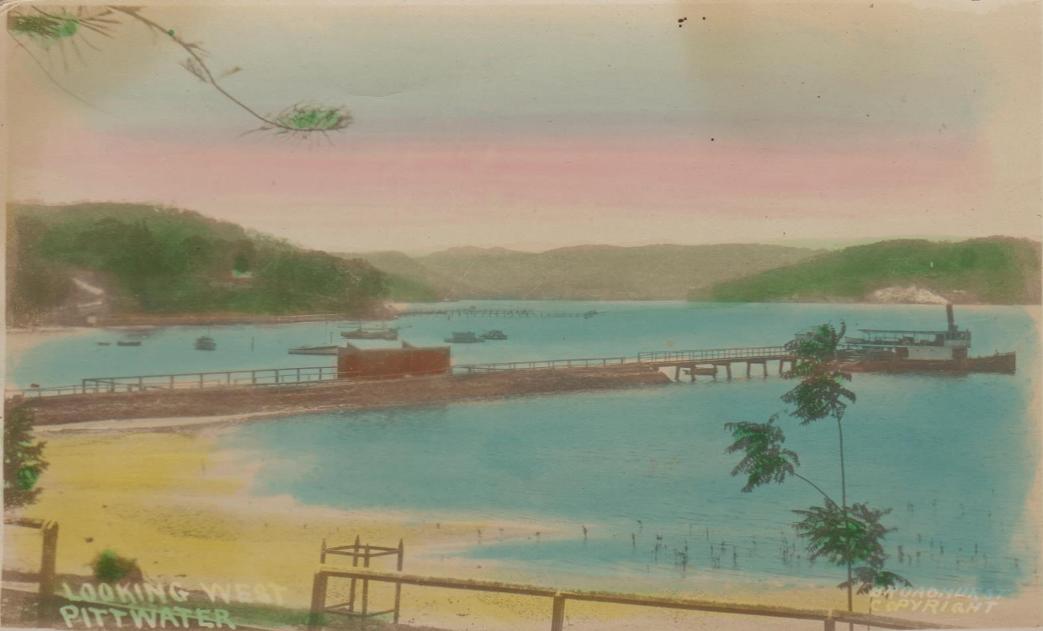
.jpg?timestamp=1599604639412)
One of the earliest sales of large holdings being split up into smaller 10 acre 'farm' blocks is associated with the above 'Sunnyside' location for this wharf;
PITTWATER.
BAY VIEW, SUNNY SIDE,
One of the prettiest spots in creation.
SCENERY GRAND IN THE EXTREME.
Just the spot for Pleasure Grounds.
Most of the land is singularly adapted for the profitable cultivation of the mango, lemon, peach, apple, and vine. Winters here are mild, frosts unknown, springs early.
The Land can be Cleared at £4 per acre.
Those in search of a MARINE RESIDENCE should make an early inspection ; NURSERYMEN also, are particularly invited to inspect the land.
It has a fine frontage to Pittwater, opposite Newport, and is only 12 miles from Manly. Public School and Church adjoin the property.
Coaches ply between Manly and Pittwater three times a week.
EDWARDS and M'KEOWN have received instructions to sell by public auction, at Mears'-chambers, Pitt street, on FRIDAY, 21st instant, at 11.30 a.m.,
The above desirable property, in blocks of 10 acres each. Advertising (1882, February 11). The Sydney Morning Herald (NSW : 1842 - 1954), p. 15. Retrieved from http://nla.gov.au/nla.news-article13505017
CHEAP LAND-10-acre Blocks, rich soil, fronting bay, opposite Newport for SALE on 24th instant. EDWARDS and M KEOWN, Mears -chambers, Pitt-street. Advertising (1882, February 16). The Sydney Morning Herald (NSW : 1842 - 1954), p. 3. Retrieved from http://nla.gov.au/nla.news-article13505247
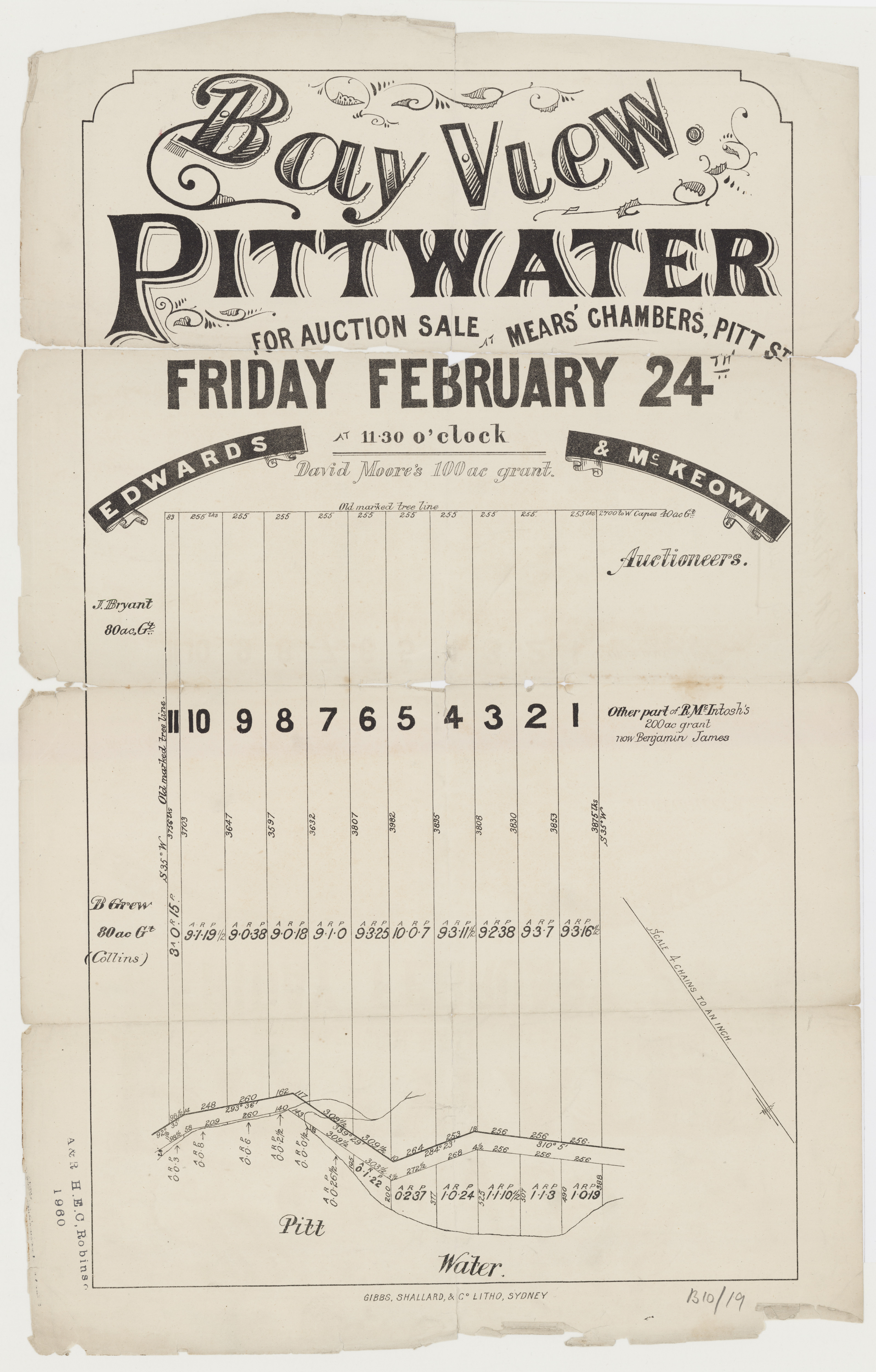
Bayview subdivision Feb 24, Item c029500018 Bayview subdivisions folder, courtesy State Library of NSW
NOTICE UNDER REAL PROPERTY ACT.
APPLICATIONS having been made to bring the lands hereunder described under the provisions of the Real Properly Act, Certificates of Indefeasible Title will issue, unless Caveats be lodged in Form. B of the said Act, on or before the date named opposite each case respectively:—
No. 5,443. Pittwater, 105 acres 2 roods 30 1/2 perches, parish of Narrabeen,—comprises part of 200 acres granted to R. M'Intosh. Applicant: William henry M'Keowan of Lane cove Road, North Shore. NOTICE UNDER REAL PROPERTY ACT. (1882, June 30). New South Wales Government Gazette (Sydney, NSW : 1832 - 1900), p. 3407. Retrieved from http://nla.gov.au/nla.news-article221706894
Onsold:
LOT 2. PARISH of NARRABEEN, near BAYVIEW. Valuable BLOCK of LAND, comprising an area of about 53 acres 37 1/2 perches, fronting a road off the MAIN ROAD Manly to Bayview, and between Robert M'Intosh's 200 acres and Benj. Crew's 80-acre grant.
The above land is midway between Pittwater-road and Church Point, almost opposite Mona Vale Estate. RICHARDSON and WRENCH have received instructions to sell by public auction, at the Rooms, Pitt-street, on FRIDAY, 7th December, at 11 o'clock. The above properties. Full particulars in future issue.
Messrs. STEPHEN, JAQUES, and STEPHEN, O-Connell- street. Solicitors for the Mortgagee. Advertising (1888, November 28). The Sydney Morning Herald (NSW : 1842 - 1954), p. 14. Retrieved from http://nla.gov.au/nla.news-article13705100
NARRABEEN. 53 acres fronting road off Main Road. Manly to Bayview, between Pittwater road and Church Point. Mortgagee Sale. RICHARDSON and WRENCH Advertising (1888, December 7). The Sydney Morning Herald (NSW : 1842 - 1954), p. 11. Retrieved from http://nla.gov.au/nla.news-article13706402
S. LEVIN.-At Sunnyside, Pittwater, at 12, Furniture, &c. Auction and Sales Advertising (1889, April 30). The Sydney Morning Herald (NSW : 1842 - 1954), p. 6. Retrieved from http://nla.gov.au/nla.news-article13729248
It is also a place where there was a fair sized 'village' of people living and working, mainly in rural trades, as indicated in the 1893 petition for a telephone to be attached to the Post Office to remain at Bayview indicates, as per Katherine Roche, postmistress. Some of those who signed were residents, others were visitors. Bayview, alike early Newport and Palm Beach, attracted those who were excelling in professional spheres and could afford a 'country holiday house'. Academics, Artists, Doctors, Politicians and Captains of Industry all had places at Bayview, with quite a few of the Professors of early University of Sydney within 'cooee' or right next door to each other. They came for the fresh sea breezes and respite from the dusty toil of inner 'Sydney Town'.
The influence of aquatic sports, particularly sailing should not be underestimated either. The first Pittwater Regatta of 1888, and the Basin Regattas of the 1890's, led to the first 'official Pittwater Regatta' after a race in 1906 between two Bayview sons of Pittwater - W D M Taylor and John Roche and two Queenslanders. These regattas went on for decades, were immensely popular, and often official parties were taken aboard the flagship steamers for each from the Bayview wharf.
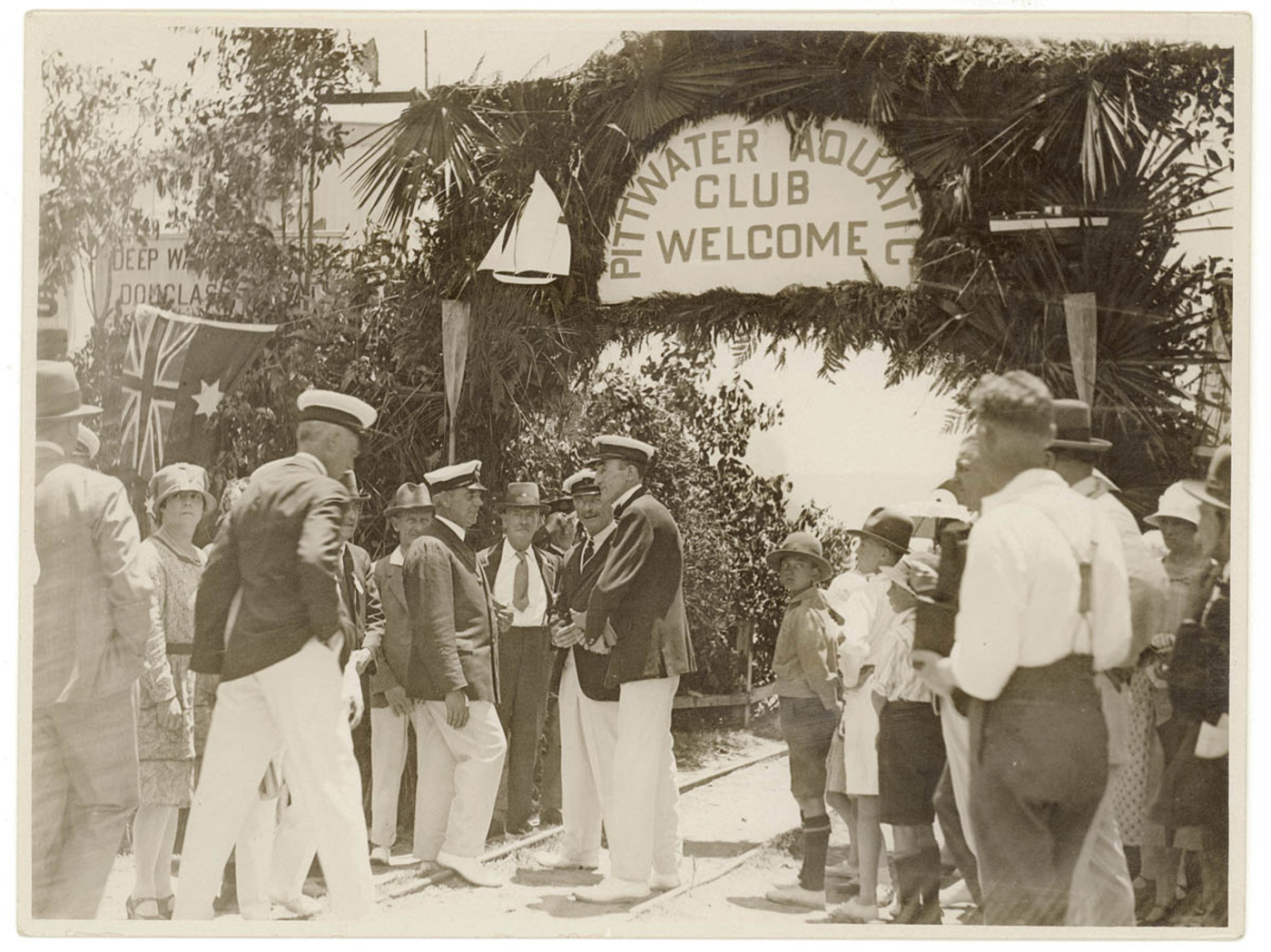
Large land lots remained at Bayview into the 1910's and 1920's simply because those who had bought the larger 'farm blocks' held onto them, for generations. Those closer to Mona Vale were cut into smaller suburban blocks sooner than those at the Church Point end - the focus on making this a village or town centre commenced when the acreage set aside a few decades earlier as a place for recreation was subsequently sold by another state government. Even though there are not a lot of 'street names' from these earlier subdivisions, those that did occur as the area was proclaimed a residential place, and left behind its rural beginnings reflect the thinking of those whose lands these were.
One of the families that remained living on site sub-dividers were the Collins-Roche people. In 1897 Honorah Collins died:
DEATH OF MRS. COLLINS.
Full of years spent worthily, Mrs. Honora Collins relict of the late John Collins, died on the 20th instant the residence of her son-in-law, Mr. J. J. Roche, Bay View, Pittwater. For more than half a century she had lived at Pittwater, and no family was better known or more highly respected than the Collins family of Careel Bay.
Mr. and Mrs. Collins were natives of the County Cork, whence they emigrated 60 years ago. Soon after their arrival in the colony they settled on Father Therry's grant at Pittwater, where Mr. Collins engaged in grazing and farming. The district has always been a great health resort. Many an invalid from Sydney recruited his health at the hospitable homestead of the Collins family. The cottage was flanked by two hills, named Mount St. Joseph and Mount St. Mary by Mr. Collins. It is told of him that he would allow none of his sick guests to leave until he saw that they were completely 'on their legs,' his test for which was a given time to ascend and descend these hills before breakfast.
The remains of the deceased lady were brought on the 21st from Bay View to St. Mary's, North Sydney, where Masses were said for the repose of her soul. The funeral took place at Chatswood Cemetery, the family burial-place, the same day. The chief mourners were Mr. J. Collins, of the Harbours and Rivers Department; Mr. P. Collins (sons); Mr. J. J. Roche, son in-law; Messrs. J. T. and E. P. Swanson, nephews. Among others present were Mrs. Black, of Barrenjoey Customs Station, Mrs. Midden, Mrs. Roche, Mrs. Earl, Mrs. Robertson, Mrs. F. Collins, Mrs. P. Collins, Messrs. D. J. Glacken, M'Teague, J. Wall, J. Crowley, H. Coyle, J. Macintosh, and Boulton. The Rev. Father Dowling, of St. Patrick's College, Manly, attended Mrs. Collins during her last illness, and officiated at the grave. May her soul rest in peace. DEATH OF MRS. COLLINS. (1897, October 30). Freeman's Journal (Sydney, NSW : 1850 - 1932), p. 16. Retrieved from http://nla.gov.au/nla.news-article115471628
In Memoriam. COLLINS.-In memory of my dear grandma, died October 20th, 1897, at Bayview, Pittwater. Mourned by her loving grandchildren, John, Nellie, Molly, Kathleen, Nano, and Frankie Roche. May her soul rest in peace. COLLINS.-In affectionate remembrance of our dear grandmother, Honorah Collins who departed this life October 20, 1897. Requiescat in pace. Inserted by J. and E. Swanson. Family Notices. (1898, October 20). The Sydney Morning Herald (NSW : 1842 - 1954), p. 1. Retrieved from http://nla.gov.au/nla.news-article14143849
Soon afterwards the deceased lady was applying to have her Bayview holdings placed under the Real Property Act. There began a series of testing times for the Roche's, which seem to show that those who stand up and be counted can also easily be those targeted by opportunists. A further report on this incident attributes the theft to young men visiting the district over the weekends and perhaps becoming the worse for drinking too much alcohol:
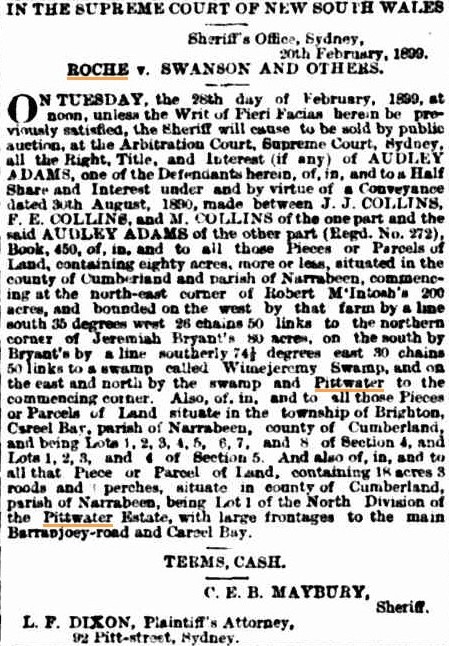 Audley Adams tries selling property out from under Katherine. Imagine finding this in the paper!
Audley Adams tries selling property out from under Katherine. Imagine finding this in the paper!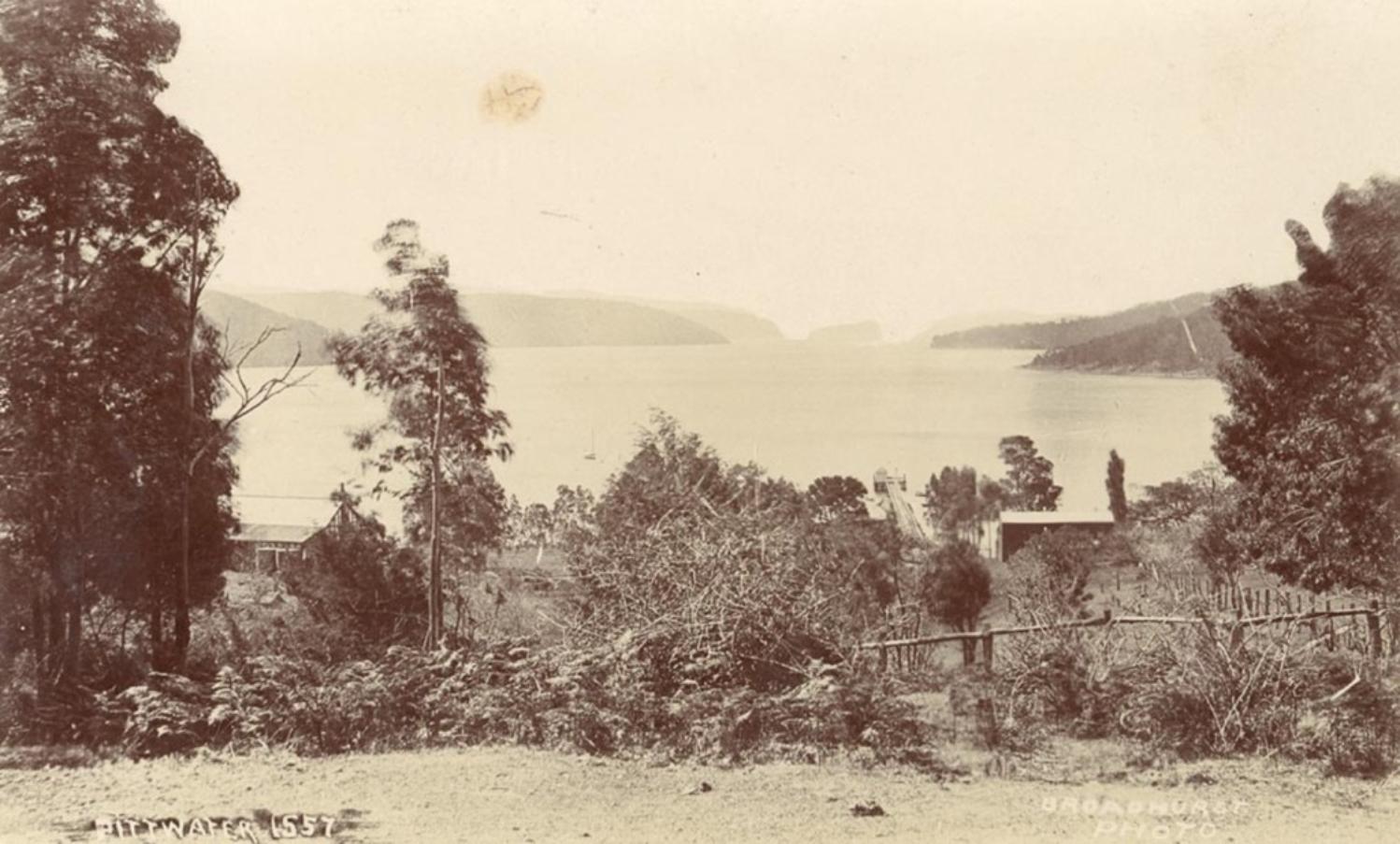
NOTICE UNDER REAL PROPERTY ACT
No. 9,766. County of Cumberland, parish of Narrabeen, 31 acres 0 roods 32 1/2 perches, at Pitt Water, adjoining the properties of Katharine M. Roche, F. Anderson, F. Chave, and James Shaw,— is part of 80 acres granted to Benjamin Crew. – Applicant: Honorah Collins.
No. 9,767. County of Cumberland, parish of Narrabeen, 42 acres 3 roods 20 perches, at Pitt Water, adjoining the properties of Honorah Collins and F. Anderson,—is part of 80 acres granted to Benjamin Crew. – Applicant Katharine Mary Roche NOTICE UNDER REAL PROPERTY ACT. (1899, June 9). New South Wales Government Gazette (Sydney, NSW : 1832 - 1900), p. 4485. Retrieved from http://nla.gov.au/nla.news-article220943318
The Subdivision lithograph:
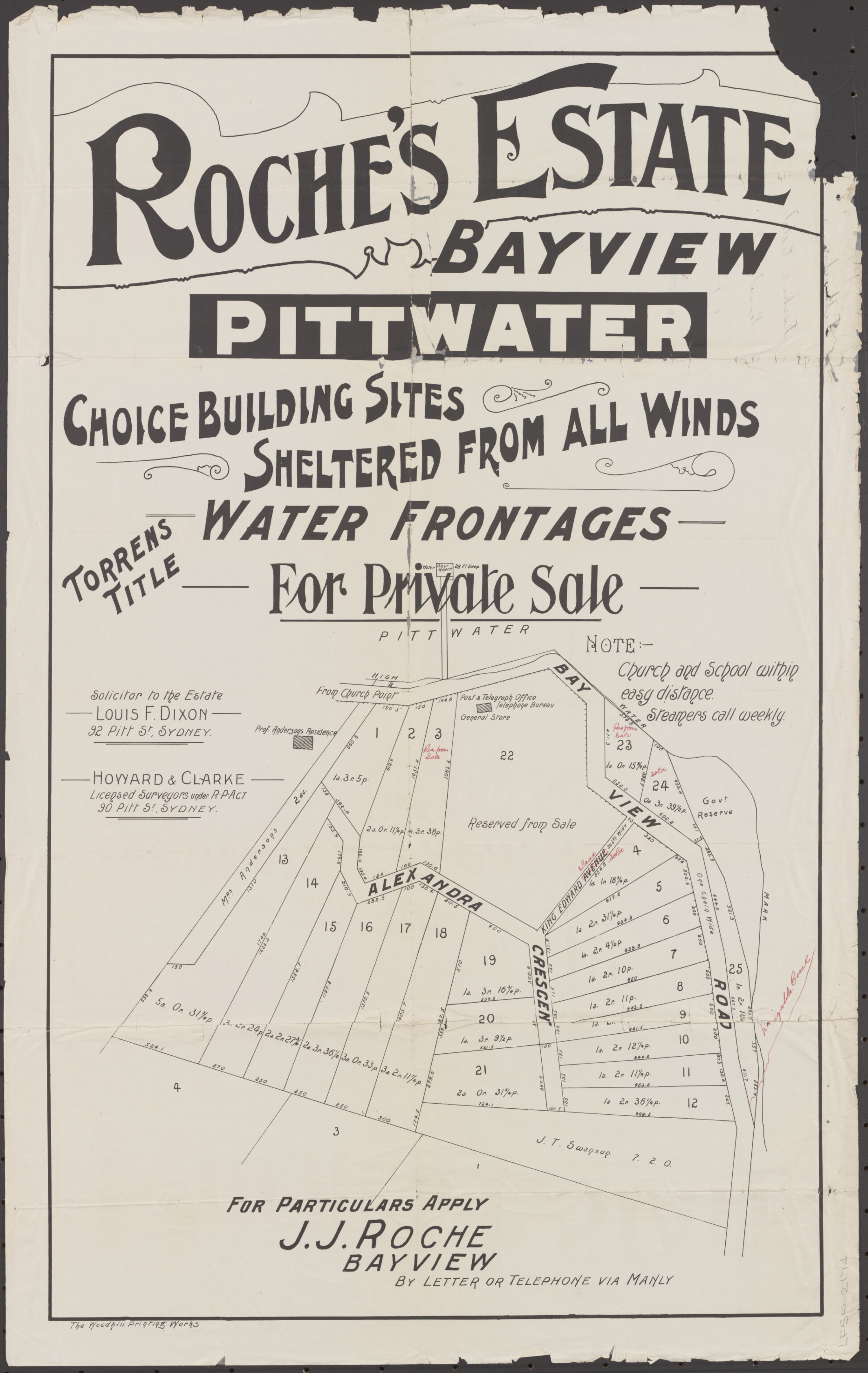
Roche, J. J & Dixon, Louis F & Woodhill Printing Works & Howard & Clarke. ([1899 -1902]). Roche's Estate, Bayview, Pittwater choice building sites, sheltered from all winds, water frontages : for private sale Retrieved from http://nla.gov.au/nla.obj-230421806 - NB 7 acre 2 roods section set aside for J T Swanson and Kind Edward Avenue and Alexandra Crescent - named for the then ruling monarchs.
BAYVIEW, - Pittwater. — Cotts., water frontage; Build. Sites, Sale, Let. Tel., Manly Exch. Roche, Bayview. Advertising (1902, September 6). The Daily Telegraph (Sydney, NSW : 1883 - 1930), p. 5. Retrieved from http://nla.gov.au/nla.news-article236814829
James Joseph Roche, husband of Katherine, died in 1904:
Professor Francis Anderson's premises, as shown on this lithograph, was already present years prior to this subdivision and sale. He married Maybanke Wolstenholme (nee Selfe) in 1899 and the couple used this place as a weekender and resided there full-time during at least one of his illnesses. Maybanke Cove next to the old wharf is named to honour this lady. She purchased two acres, shown on the map above.
Professor Pitt Corbett's picnic last week was certainly most enjoyable and enjoyable-first, the journey on the steamer to Manly, and the drive by coach to the rendezvous, the lunch and the suceeding ramble, and then the tea at Professor Anderson's charming house at Pittwater. It was all most delightful. The weather was everything that could be desired, and the arrangements were perfect. Everybody had a lovely time, and the outing will certainly live as a red-letter day in the memory of everyone who had the happiness to be present. Our Social System. (1893, September 16). Australian Town and Country Journal (NSW : 1870 - 1907), p. 34. Retrieved from http://nla.gov.au/nla.news-article71189236
Marriages.
ANDERSON—WOLSTENHOLME.—March 2, at Eversley, Balmain, by the Rev. James Hill, M.A., Francis Anderson, Professor of Logic and Mental Philosophy, University of Sydney, to Maybanke Wolstenholme, daughter of the late Henry Selfe. Family Notices (1899, March 11). The Sydney Morning Herald (NSW : 1842 - 1954), p. 1. Retrieved from http://nla.gov.au/nla.news-article14203949
AT the Sydney School of Arts, March 8, the Womanhood Suffrage League held its usual monthly meeting. The president of the league was in the chair. Miss B. Golding moved,"That the league sends sincere congratulations to Mrs. Wolstenholme on her marriage with Professor Anderson, and earnest wishes for her future happiness." Miss Golding said Mrs. Wolstenholme deserved this from the league, as she was one of the first promoter of the W.S.L., and although business arrangements had prevented her, for the past two years from taking active part in public, she had never ceased to work in private. Mrs. Wolstenholme had always proved herself the friend of her sister women. Mrs. Dickie seconded the motion which was carried unanimously. Miss Scott then read a paper on "War v. Arbitration," which caused considerable discussion, in which Mrs. Brodrick, Mrs. Dickie, Miss Golding, Mr. Henry Willis, and several strangers took part. NEWS AND NOTES. (1899, April 1). The Dawn (Sydney, NSW : 1888 - 1905), p. 8. Retrieved from http://nla.gov.au/nla.news-article76967249
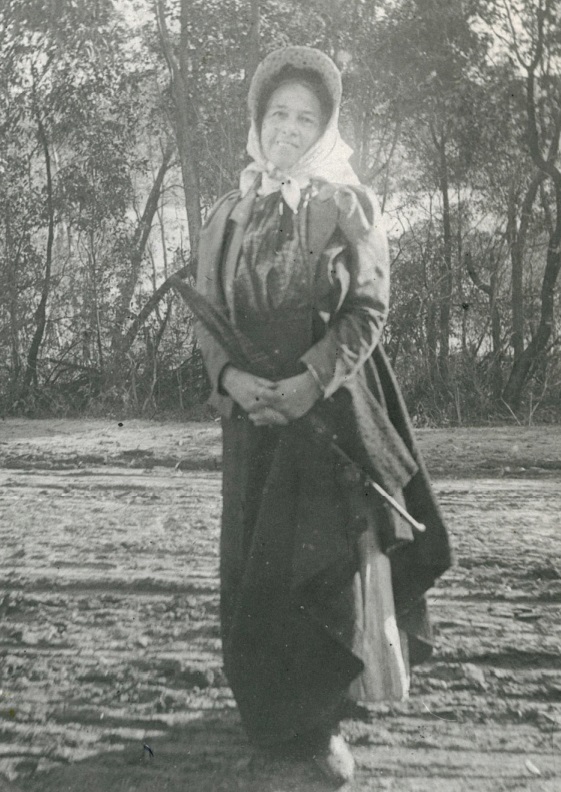
Maybanke - photo taken in 1890 - courtesy Sydney University Archives - which means that's Pittwater in the background and she is standing on a section of road, the Bay View Road, near Professor Anderson's Pittwater home.
Prof. Anderson and Maybanke Anderson at 'Maybanke' Bay View - circa 1899 -1900 - photos courtesy Jan Roberts and Marjorie Wolstenholme (daughter of Harry Wolstenholme - Palm Beach Land Company)
Is the above photo a Belgian Fund sewing circle?: World War One, the Great War, came to Pittwater and all the young men and able-bodied middle aged men who were settled in their fields or on their fishing boats went away to war. Even before Britain declared war on Germany on 4 August 1914, this nation had pledged support alongside other states of the British Empire and began preparations to send forces overseas to participate in the conflict. For the women here, apart from years of worry to come, and many losing family members or having men come home who were permanently maimed in body or mind, the initial focus outside of their loved ones was on the women and children. The Commission for Relief in Belgium or C.R.B., also known as the Belgian Relief, was an international organisation that arranged for the supply of food to German-occupied Belgium and northern France during the First World War. Pittwater residents, led by the women of Bay View, Church Point, 'Clairville', Newport and Mona Vale, were part of the efforts to help:
BELGIAN CIRCLES.
EFFORTS OF PITTWATER.
Mrs. Francis Anderson, of Pittwater, writes of the efforts made to assist the distressed Belgians. She says: —
"We are a scattered people. Our shire spreads over hill and gully. In our riding there are streets whose only claim to the fame is the tipsy sign-post of the auctioneer, and there are cottages, lonely in the bush, which seem to look all ways for the promised road which never comes.
"But even a scattered people has eyes and ears and duties, and the cry of harried Belgium has reached our hearts and made us want to do something. So a week or two ago we began to think. There must be, among these quiet folk, some who would like to give a mite to Belgium, some who will be glad by and bye that they am their little share, and it must be someone's duty to offer everybody an opportunity to give nobly and willingly, according to their means .and according to their hearts.
"To talk of getting a shilling a week from everybody would be, we knew, absurd. A shilling a week Is four shillings a month, the price of a pair of little shoes, and most of our babies go barefoot, for money is scarce where nearly every man works for a daily wage. Besides,- the maximum often becomes the minimum, and we did not want to limit the donations of our friends who might have unsuspected money bags. So we ruled the shilling out. Then the way to collect was a problem. We decided that this must be done mainly by women. Woman proves her value most In the small things of life. So we bought a dozen notebooks with a money column, and Invited her severally and collectively to a meeting, in order that she might discuss our plan.
"We proposed that anyone who would should take a book, and should collect every week as much as she could. The penny was not to be scorned; the lordly shilling would be welcomed., if Smith was out of work, and could give nothing but sympathy, he would still got a smile of thanks. If Mrs. Brown sent her subscription in eggs or cabbages they would be as welcome as cash. Even a doll, or a teapot, or a pot plant need not be refused, for we can have a 'social' and a Bruce auction by and by. Everything can be done up In parcels, and we shall nil laugh uproariously when an adventurous bidder Gives half a crown for a clothespeg, because It was wrapped so neatly in a fascinating piece of paper.
"We had to dispose of the books to collectors, and we began with our friendly postmistresses. As we have not reached the luxury of a postman with a bag, the post office offers many opportunities. Then each of the storekeepers took a book. Wives and daughters do much of the business, and we talk of many things on the verandahs. The school people, always ready to work, were Invited to help, and all the kindly women who go to see their friends and neighbors promised to do something. The boarding-house and the hotel each offered to try to catch the fish who might escape from other nets, and there were then left only the stay-at-homes, who live so far away, and love their solitude so much that they never venture into the giddy whirl of our little community. For them we needed a collector or two; and we found the ever-cheerful and willing girl.' She flourishes everywhere, and Is always ready to walk and talk — with a companion.
"Very soon a second dozen of books had to be bought, and we had to face the question of collecting from the collectors, 'Memories of the Feudal system came to our aid, and we decided to imitate to our forefathers. There is a head centre, which collects from smaller centres, and they In their turn from collectors. To the head centre the money must come, so that each weekly dole shall go to the shire hall as soon as possible.
"So our riding is working Its Belgian circles. They are small. We may never get more than two or three pounds in a week. But even that will keep a few Belgian babies from starvation, and at least we know that, we are trying to do a little of our duty." BELGIAN CIRCLES. (1915, March 27). The Daily Telegraph (Sydney, NSW : 1883 - 1930), p. 19. Retrieved from http://nla.gov.au/nla.news-article238825631
Now in her late 60's, the still energetic and keen mind stayed trained on bettering the lot of children far from that green and blue oasis:
CHILDREN'S PLAYGROUNDS.
TO THE EDITOR.
Sir, — Friends of childhood are glad to know that occasionally the question of playgrounds for children Is considered by those in authority. We hear now that the municipal council of Sydney will soon carry out a long-discussed plan, and will set aside a portion of the Flagstaff-hill for the use of boys— a third area for this large city — and we are thankful for small concessions. But If you will allow me I would call the attention of the general public, and particularly of women, to the fact that such play areas, especially without superintendents, have little value except to big boys, and are of no use at all to small children or to girls.
During the past month — May — 146 children, under five years of age, died in Sydney. How many under ten, we may guess. I do not for a moment wish to infer that this small crowd of babies all died for want of fresh air. We have many ways of killing babies, and they die easily. But there can be no doubt that many of them died mainly because of their surroundings. A child who Is born, and who has to struggle for life, in a lane which even our sunshine cannot purify, is handicapped from its birth, and falls an easy prey to the attacking microbe. In some parts of Sydney four' families now live in one house. Their small homes were, some time ago, taken from them, and pulled down, in order that Sydney might be beautiful, and they have' never been replaced. A mother who sits on the doorstep of such a house. In a narrow street, to nurse her baby, and gossip with her neighbors, has neither the wisdom nor the energy, neither the time nor the money, to take her children into pure air. A visit to some of our mean streets makes one wonder not that so many die, but that so many manage to escape disease and live.
The question of saving the children of the ignorant and poor is not only one of charity and philanthropy, both now for reasons which I need not specify, at a low ebb in Sydney; It Is also and mainly one of economy and common sense. Why ask other countries to send us their children, while we allow ours to die! Why spend money in enlarging hospitals, and at the same time breed invalids? Why deplore a lowered birth-rate, while we do so little to lessen the death-rate?
Many associations are doing their utmost to give Ignorant mothers the knowledge necessary to enable them to rear healthy children, but every hard-working woman Is hampered by her surroundings. What Is wanted In Sydney, more than unsuperintended playgrounds for big boys, though they have their value, Is a number of small play areas for little children. They need not be ornamental or expensive. A portion of any park could be arranged to answer the purpose for a small amount of money. The principal expense would be the salary of a director or two— perhaps £ 200 per year. In many of our reserves such an area would take little from the space devoted to the public who are no longer children; In some It would add an interesting attraction, and would be an object-lesson for parents.
A visit to the Lance playground, In High-street, Miller's Point, the only playground in Sydney which the principles of the Playgrounds Association allow it to approve, will convince the most sceptical of the great benefit such an area can be to a crowded neighborhood. That Is the type of playground which the Playgrounds Association is now trying to establish In Sydney. There should be one in every thickly-peopled part of the city, and at least one in every suburban municipality.
How long will It be before the men and women of Sydney will stand beside the Playgrounds Association and give them not only assent, but help, in order that the coming generation shall have at least fresh air and space in which to play.— Yours, etc.;
MAYBANKE ANDERSON,
Hon. Sec., Playgrounds Association,
Bayview, Pittwater, June 5.
CHILDREN'S PLAYGROUNDS. (1913, June 7). The Daily Telegraph (Sydney, NSW : 1883 - 1930), p. 18. Retrieved from http://nla.gov.au/nla.news-article240053486
Research done for Katherine Roche during the first round of Pittwater Matriarchs shows her husband was a great chicken keeper and even had prize-winning fowls. The description below indicates that the Andersons took over much of this 'chook run' after Katherine moved the family to Mosman during their later schooling years to be closer to higher education facilities.
PRACTICAL PHILANTHROPIST.
MRS. FRANCIS ANDERSON.
Playgrounds for Children
Suffragettes Denonuced.
Many people, no doubt, are familiar with Mrs. Francis Anderson, through her writing, and the keen Interest she has taken in so many philanthropic movements, but to really know the woman herself one must spend a couple of hours with her in her picturesque town house at Forest Lodge, and listen to her talk of her hopes for the children and mothers of Australia. Mrs, Anderson has worked so strenuously, and done so much to brighten the lives of the workers and the children, that the knowledge of the happiness that she has brought them has clung to her, and left her bubbling over with an infectious optimism, and a tremendous sense of the Joys and possibilities of life. She is one of the ideal women of the age, whose brain has developed to the utmost degree without changing theirfemininity and heart. Women who actually prove by their personality that intellectuality in a woman and unattractiveness and hardness are not necessarily associated.
A BUSY WOMAN.
Mrs. Anderson was asked how she managed to find sufficient time to attend to so many philanthropic duties.
"Well, I don't know," she replied. "I can always find time. ' You see, I have one advantage, and that is I have all the time, to myself that other women spend visiting and otherwise uselessly. I read a tremendous lot, and while I am reading I knit socks and cosy woollen garments for grand-children, who keep me well employed in that direction.
"As to the domestic virtues, I haven't much time to talk about their cultivation, but I try to practise them. At our home at Bayview there is almost a farm to look after. You should see our roses, and quite as important, our vegetables. I work a great deal in the garden, and in my spare time attend to the comforts of about 70 fowls,
"So far as I can see there is a much -greater interest In scientific domestic work than of old. Women are finding out that work must be done, and they are trying to do it with brains— no one likes drudgery.
"And now about this great servant question that is troubling so many people. I have never had much trouble. I am afraid some mistresses fall to touch the human note, the sympathy that makes the whole world kin'. But a great change has begun, though we are hardly conscious of It, and tire old despised servant or 'slavey,' will be a thing of the past."
Anderson came to Australia from England when quite a child with her family reminiscences of the early days are so numerous that they would fill a good solid volume. For many years, and until quite recently, she wrote for the papers, and one of her first public Interests was the Womanhood Suffrage League, of which she was president for most of Its strenuous years.
NO SEX IN POLITICS.
"I think," she said, "that In the politics of a democracy there should be no sex. A woman without a vote Is an Inferior, and therefore liable to be so regarded, but it is easy to exaggerate the power conferred by the vote. That Is the initial mistake of the militant suffragettes' In England. I decidedly disapprove of militancy. The tendency of modern times Is for arbitration rather than for war, for reason rather than force. The militant women are reverting to the methods of the middle ages, and going further back still, and behaving like Huns or vandals. Besides, they are spoiling; their Cause. If you can't convince an English man by argument, you certainly won't do so by breaking his windows. No; I believe in men and women working together, the one helping the other.
In olden times men did what they liked, and made mistakes, simply because women sat back and let them. They sat back and did their wool work' and occasionally fainted, and that was all. But now, to go to the other extreme and .think everything can be done by women is just as ridiculous. All through my work I have found men my best friends, and by going about the right way I have always found them only too anxious to help me."
It is very interesting .to listen to Mrs. Anderson talk about present-day interests, but she fairly carries you along with her enthusiasm when she commences to unfold her; ambitions for her, two pet schemes, the play grounds for children, and the free kindergartens. She was one of the few bold founders of the Kindergarten Union in 1896. There are now eight free kindergartens— not nearly enough, but' as many as the union can support. They are not so large as the State kindergartens, but a great many small ones supply the need better than a few large ones. A child of three or four cannot walk a great distance to school. The kindergartens are really centres of, influence for mothers and fathers. The union is now trying to buy premises for a training college. The present college is self-supporting, but the rent, £295 a year, Is high.
A CHANCE FOR THE WELL-TO-DO.
"We hope," said Mrs. Anderson, "some good friends may be found to help us. Our hope for the future really rests, in the children, doesn't it? The present generation will soon be gone, and they will reign. As to playgrounds for children, they will have to come. I cannot believe that municipalities and people will continue to be apathetic. Many a woman spends as much on a diamond as would make 100 children healthy and happy for a year.
"I should like to see the playgrounds supported by different trades. The drapers might have one, and the butchers another. Every factory owner ought to help, for It is from the class of children that the play ground serves that he must draw his operatives, and their health should he his care. The money needed to keep one sick child In a hospital would keep fifty healthy ones well and happy, and people must see the sense of It some day. "Then there Is the possibility of memorial playgrounds. What better memorial to a child loved and lost than a playground, or a kindergarten, called by the never-forgotten name?
PLAYGROUND SCHEMES.
"We have only one so far. That is the Lance Playground, at Miller's Point, but J many others are coming. Our Idea is to get small areas of land In the different parks I In Sydney- and the suburbs, and erect a I shelter shed, and, of course, a sand-pit, for I the children. We don't want elaborate ones. We prefer to have them simple and more I numerous. Children want the fresh, health-giving air- more than anything, and a place where they can shelter from the rain.
"Every playground will have one or two young women in charge of it. If there Is no supervision it simply means a place where the bullies tyrannise the smaller and weaker children."
Mrs. Anderson started the Playgrounds' Association about four years ago. She came back from England at that time with her head full of the work that Is being done for children in England and America, and decided to Introduce the spirit here. She started writing, first of all, letters and articles in the daily press. Then she thought an association with a president would carry more weight than merely Mrs. Anderson. Her next step was to persuade Professor Mackie to be president of a Playgrounds' Association, of which she would be secretary. It would seem impossible to refuse Mrs. Anderson anything, so naturally Professor Mackie agreed. Last year, when the association added to its list a committee, the nucleus of which was composed of the members of the Women Workers' Association.' Now it is an Important organisation, boasting many of Sydney's i leading women as supper' era, also a deputy town clerk, and a Lady Mayoress. Naturally, when an association possesses a large committee, and an energetic and enthusiastic secretary, results are found to follow, and If Mrs. Anderson is able to carry out all that Is In her head there will soon not be a small citizen In Sydney who will not be able to sing In real earnest, "This bit of the world belongs to us."
.jpg?timestamp=1544230900806)
MRS. FRANCIS ANDERSON. (Photo, by Crown Studios.)
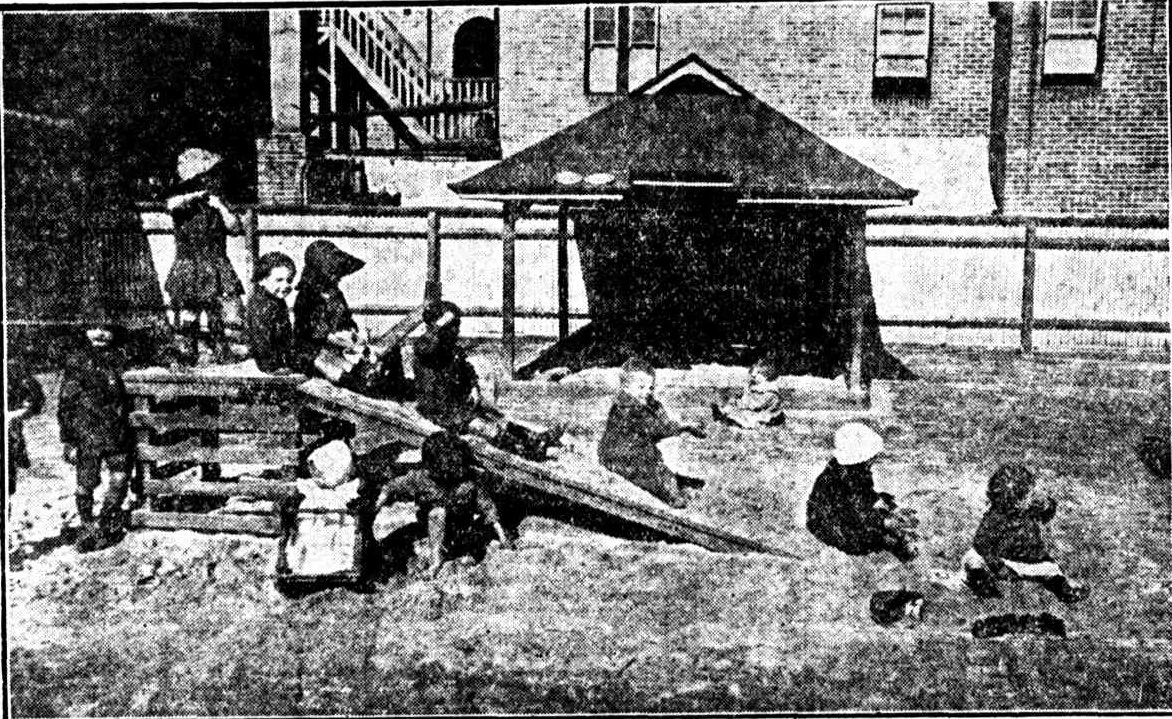
THE SAND SLIDE AT THE LANCE PLAYGROUND, MILLER'S POINT.
PRACTICAL PHILANTHROPIST. (1913, July 6). The Sun (Sydney, NSW : 1910 - 1954), p. 20 (SUNDAY EDITION). Retrieved from http://nla.gov.au/nla.news-article229674671
Maybanke circa 1915 - 'On the Road, Bay View - Broadhurst postcard - courtesy Jan Roberts and Marjorie Wolstenholme (Harry Wolstenholme's daughter)
The other premises shown in this circa 1899-1903 lithograph is the holiday home of Professor James Thomas Wilson, who was a friend of Professor Anderson's (both were from Scotland originally) with whom along with Professor (Sir) Mungo MacCallum, he promoted adult education through University Extension Board lectures, the Workers' Educational Association, the Toynbee Guild and the Student Christian Movement.
James Thomas Wilson was born in 1861 in Dumfriesshire, Scotland. His father was a schoolmaster from whom Wilson received his education. He evinced an early interest in natural history and was torn between this and medicine when he entered Edinburgh University in 1879. He graduated in Medicine with Second Class Honours in 1883, having taken a medal in Botany. After a short session as Resident House Surgeon at the Royal Infirmary, he spent a year as ship's surgeon in a far eastern cargo trader. The next two years were spent as a Demonstrator in (Sir) William Turner's Anatomy Department in Edinburgh (then the most prestigious Anatomy Department in Great Britain). Wilson sailed to Sydney on The Orient in 1887 with Professor (Sir) Mungo MacCallum, who was to become a close friend to take up a position at the University of Sydney as a Demonstrator in the new medical school. He would subsequently be the first occupant of the Challis chair of anatomy. That same year, on September 4th, at Chalmers Presbyterian Church, Adelaide, he married Jane Elizabeth Smith, sister of his Edinburgh friend. Jane died on July 14th 1891, leaving a 3-day-old daughter, Jane Elizabeth Margaret Lorrain ('Jeanie'). On September 14th, 1898 at Woollahra Presbyterian Church, Sydney, he married Mabel Mildred Millicent (d.1944), daughter of Sir Julian Salomons.
University of Sydney - Demonstrator in Anatomy, Professor of Anatomy (1890-1920), Dean of the Faculty of Medicine (1920), MB ChM (Edin) MA FRS
Daughter born was Jane: NSW BDM's - WILSON JANE E M L 29099/1891 JAMES T JANE E PETERSHAM
He had a house at Woollahra which he sold in 1920 when returning to the U.K to take up a an appointment at Cambridge.
Well versed in literature, theology and especially philosophy, Wilson tried to reconcile deep religious sensibilities with materialist science. In two fine addresses as president (1898-99) of the Linnean Society of New South Wales he challenged the vitalist views of his friend Haldane. A mechanist who regularly attended church and took communion as 'a toast to the Almighty', and a devout Christian who yet denied the divinity of Christ, Wilson pursued scientific truth with religious dedication. With fellow Idealists (Sir) Francis Anderson and MacCallum, he promoted adult education through University Extension Board lectures, the Workers' Educational Association, the Toynbee Guild and the Student Christian Movement. He joined colleagues like Archibald Liversidge and (Sir) Edgeworth David to stimulate and gain recognition for science through the Australasian Association for the Advancement of Science, the Royal Society of New South Wales, the Linnean Society and the Australian Museum, Sydney. Wilson addressed medical congresses and student medical societies, and in 1916 helped to inaugurate at the university a society for combating venereal diseases. As an Imperialist, he supported the Victoria League, the Round Table and the Australian National Defence League.
A keen naturalist from boyhood, Wilson readily espoused Edinburgh's traditional emphasis on comparative anatomy. His great achievements were to found in Sydney an anatomy school in the Edinburgh mould and to build a tradition of research which drew international respect. He taught anatomy as a biological science, emphasising dissection and museum and laboratory techniques in which he was highly accomplished. For thirty years he ran a rapidly expanding department with heavy teaching commitments, assisted only by a small technical staff and teams of student demonstrators.
Tall, spare and severe, but really the kindest of men, a dull lecturer who yet inspired his students by his fierce dedication to his subject, 'Jummy'—as he was called by staff and students (except in his presence)—was at his best in the laboratory 'advising, criticising and, above all, encouraging, all with great vehemence'. With the physiologist (Sir) Charles Martin, Wilson led a distinguished group of researchers, including (Sir) Grafton Elliot Smith and James Peter Hill, in the first sustained and authoritative studies by locally-based scientists of Australia's native fauna. A self-supporting, interdisciplinary, informal postgraduate team, they kept abreast of British, European and American developments. Wilson's contribution to the first international congress of anatomists in Geneva (1905)—on his work with Hill on the embryology of the platypus—was accorded first place by Nature's reviewer. In 1909 Wilson was elected a fellow of the Royal Society, London. Biographers state that ''Anderson Stuart built the Sydney medical school; Wilson furnished it with a reputation.'' - Patricia Morison, 'Wilson, James Thomas (1861–1945)', Australian Dictionary of Biography, National Centre of Biography, Australian National University, http://adb.anu.edu.au/biography/wilson-james-thomas-9140/text16127 and also Mellor, Lise (2008) Wilson, James Thomas. Faculty of Medicine Online Museum and Archive, University of Sydney..
The article 'A RUN TO PITTWATER BY VIATOR' published in 1893 and actually penned by Manlyite Patrick Quinn (Issue 145), may have been describing him his 'theosophist' tendencies and property, or that of his neighbour, Professor Anderson.
Professor Wilson died on September 2nd 1945 at Cambridge and was cremated. The daughter of his first marriage survived him, as did the three daughters and three sons of his second. At the University of Sydney he is commemorated by an anatomical museum and a portrait by William Nicholson.
The holiday home at Bayview, called 'Sheoks' remained in the family for three generations until it was mysteriously burned down in October 2003, a mere 8 hours prior to being scheduled to go to auction. The land holding around what is said to be one of the first ever asbestos-cement homes built, was on 10,700 square metres of prime waterfront land and was expected to fetch more than $4 million at its scheduled auction with same stating the block could be subdivided into six parcels for homesites.
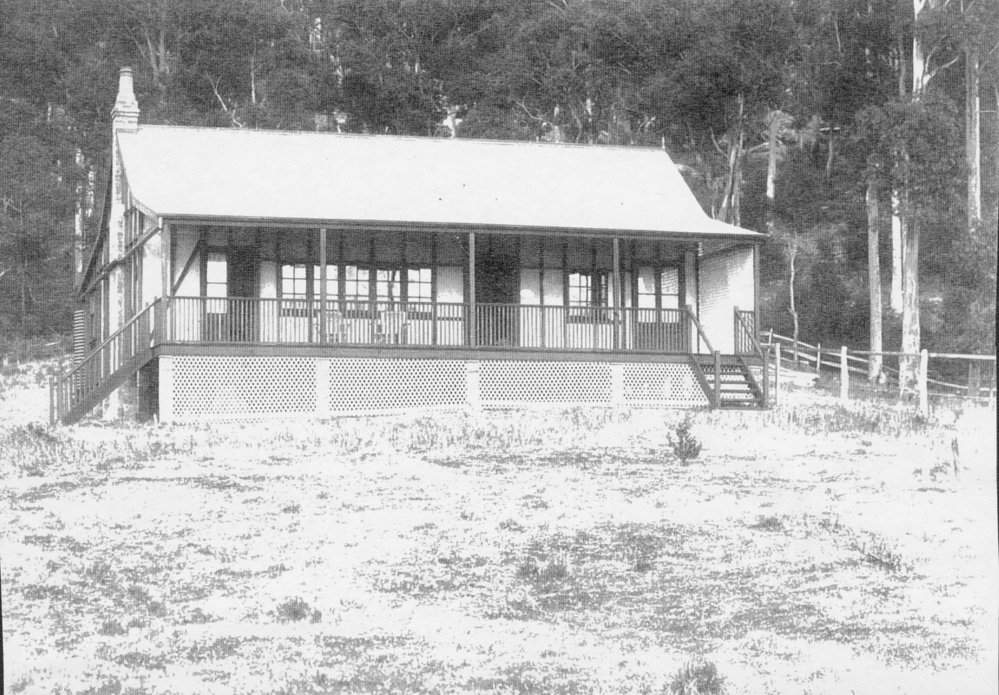
Sheoaks, circa 1910 - 38 Alexander Crescent, Bayview
Two days prior to burning down and interim heritage order had been placed on the property by Dr Simon de Burgh, a Sydney drug and alcohol specialist, and one of fiver siblings of the de Burgh family the property then belonged to.
Patrick de Burgh (1916-2010) was the son of Jane (Jeanie) and Thomas de Burgh.
In 1914 Jeanie Wilson became engaged to a civil engineer:
Miss Jean Wilson, B. A., the pretty daughter of Prof. J. T. Wilson, is engaged to Mr. Tom de Burgh. Miss Wilson has recently returned with the family from abroad. The younger children have all had whooping cough, including the baby boy, who was born in England. THE WORLD AND HIS WIFE (1914, March 29). Sunday Times (Sydney, NSW : 1895 - 1930), p. 7. Retrieved from http://nla.gov.au/nla.news-article120354528
DE BURGH-WILSON.-August 29, at Woollahra Presbyterian Church, by the Rev. G. R. S. Reid, Thomas Hubert Macartney, elder son of E. M. de Burgh, to Jane Elizabeth Margaret Lorrain, eldest daughter of J. T. Wilson. Family Notices (1914, September 5). The Sydney Morning Herald (NSW : 1842 - 1954), p. 12. Retrieved from http://nla.gov.au/nla.news-article15534462
Ernest de Burgh, father of Thomas, was then chief bridge builder and then chief dam builder for NSW. One de Burgh brother was a medical student and went to England and was in Edinburgh for a year waiting to serve during WWI - a 1918 published article details his return and all the exciting adventures he was witness to.
Thomas and Jeanie's son was born in May 1916:
DE BURGH.—May 16, at La Mascotte, River-street, Bellevue Hill, to Mr. and Mrs. T. H. M. De Burgh—a son. Family Notices (1916, May 22). The Sydney Morning Herald (NSW : 1842 - 1954), p. 8. Retrieved from http://nla.gov.au/nla.news-article15639700
However, the marriage didn't work out:
"IRKSOME MARRIAGE TIE"
De Burgh Divorce Case
Separation as Experiment
Jane Elizabeth Margaret Lorrain de Burgh (formerly Wilson) petitioned Mr. Acting- Justice Ralston in the Divorce Court to-day for a decree for restitution of conjugal rights against Thomas Herbert Macartney de Burgh, to whom she was married on August 29, 1914, at Woollahra. He was then a civil engineer. Mrs. de Burgh, who was represented by Mr. H. G. Edwards (instructed by Messrs. Minter, Simpson, and Co.) said her husband was an officer in the employ of the Public Works Department. His father was a civil engineer, and her father was a professor of anatomy. Her husband was 24 at the date of the marriage.
VISIT TO ENGLAND
"We lived at various places in the country after our marriage," added Mrs. de Burgh, "and in February, 1917 came to Sydney. My husband had an illness, and thereafter he appeared to regard the marriage tie as irksome. In May, 1918, I became ill and wont to the Blue Mountains. A suggestion was then made by my husband that we should part for 12 months, in order to see if his attitude towards me would change. I went to England, where my people live, in January, 1922, and returned in March, 1923. While I was away I wrote by each mail to my husband. He met me at the boat, and took me to a boarding-house at Woollahra, but I failed to bring about a reconciliation." Mr. Acting-Justice Ralston directed de Burgh to return to his wife within 21 days after the service of the decree upon him. "IRKSOME MARRIAGE TIE" (1923, August 23). The Sun (Sydney, NSW : 1910 - 1954), p. 15 (FINAL EXTRA). Retrieved from http://nla.gov.au/nla.news-article224098816
Jane remarried in 1929, the marriage registered at Moss Vale:
MARRIAGES.
CLUNIES ROSS—DE BURGH. — January 3, at All Saints' Church of England, Sutton Forest, by the Rev. C. M. Thomas, Allan Clunies, elder son of the late William Clunies Ross, of Sydney and Bathurst, and Mrs. Clunies Ross, of Woollahra, to Jane de Burgh, eldest daughter of Professor and Mrs. J. T. Wilson, of Cambridge. Family Notices (1929, January 23). The Sydney Morning Herald (NSW : 1842 - 1954), p. 14. Retrieved from http://nla.gov.au/nla.news-article16525789
Allan(1889-1946), as a son of William Clunies Ross of Bathurst and Hannah Elizabeth (née Tilley) was older brother to Sir William Ian Clunies Ross (1899-1959), veterinary scientist and administrator, and after serving overseas in studying for C.S.I.R., on January 1st 1946 'Ian' Clunies Ross was appointed a full-time member of C.S.I.R.'s executive committee, with general responsibility for the agricultural and biological divisions. He moved to Melbourne that year. In 1947-48 the institution came under intense political scrutiny because of allegations that it was lax in regard to security. C.S.I.R. underwent a minor reorganisation, including the change in name to C.S.I.R.O. in 1949. The chairman Sir David Rivett retired and Ian Clunies Ross replaced him on May 19.
Allan has been described by biographers as of a gentle disposition with his father's thirst for knowledge. It was the second marriage for both, although Allan was up for alimony after the marriage to Jane:
IN DIVORCE.
(Before the Judge in Divorce, Mr. Justice Owen.)
ROSS v ROSS.
This matter arose out of a case in which Allan Clunies Ross was the petitioner in a suit for dissolution of his marriage with Flora Kathleen Ross (formerly McDonald), on the ground of desertion on her part for three years and upwards. The parties were married in England in 1919 and they afterwards came to Australia. The respondent left the Com-monwealth in August, 1924, for America. In 1927 petitioner instituted the divorce proceedings, and the case was heard before Mr. Justice Davidson, as an undefended one, on February 24, 1928, a decree nisi for dissolu-tion of the marriage being pronounced on that date. The decree was made absolute on September 25 of the same year.
In June, 1930, the respondent in the suit applied for permanent alimony, and the Registrar in Divorce made an order in her favour. The matter was now referred to his Honor by way of appeal by the husband. The questions now were, briefly, whether a wife, adjudged guilty of desertion, was entitled to permanent maintenance after the decree absolute, and whether an application made nearly two years after that decree, was too late, having regard to the circumstances, and the relation of the parties.
His Honor reserved his decision. IN DIVORCE. (1930, September 6). The Sydney Morning Herald (NSW : 1842 - 1954), p. 12. Retrieved from http://nla.gov.au/nla.news-article16676327
Allan was an Accountant and also a great teacher:
DEATH OF MR. A. CLUNIES-ROSS
Mr. Allan Clunies-Ross, Sydney accountant, died at his home yesterday. He was 57.
Mr. Clunies-Ross was State president of the N.S.W. Division of the Commonwealth Institute of Accountants, honorary treasurer of the Royal Society and the N.S.W. branch of the Economic Society of Australia and New Zealand, and lecturer in Business Administration at the University of Sydney.
He served for three years with the A.I.F. in the 1914-18 war, and during the last war was attached to the Directorate of Man-power. He is survived by Mrs. Clunies Ross. DEATH OF MR. A. CLUNIES-ROSS (1946, February 11). The Sydney Morning Herald (NSW : 1842 - 1954), p. 4. Retrieved from http://nla.gov.au/nla.news-article17970150
CLUNIES—ROSS.—February 10, 1946, Allan, beloved husband of Jane, Private cremation. Memorial service St James's Church Wednesday February 13 at 1 15 PM. Family Notices (1946, February 11). The Sydney Morning Herald (NSW : 1842 - 1954), p. 12. Retrieved from http://nla.gov.au/nla.news-article17970121
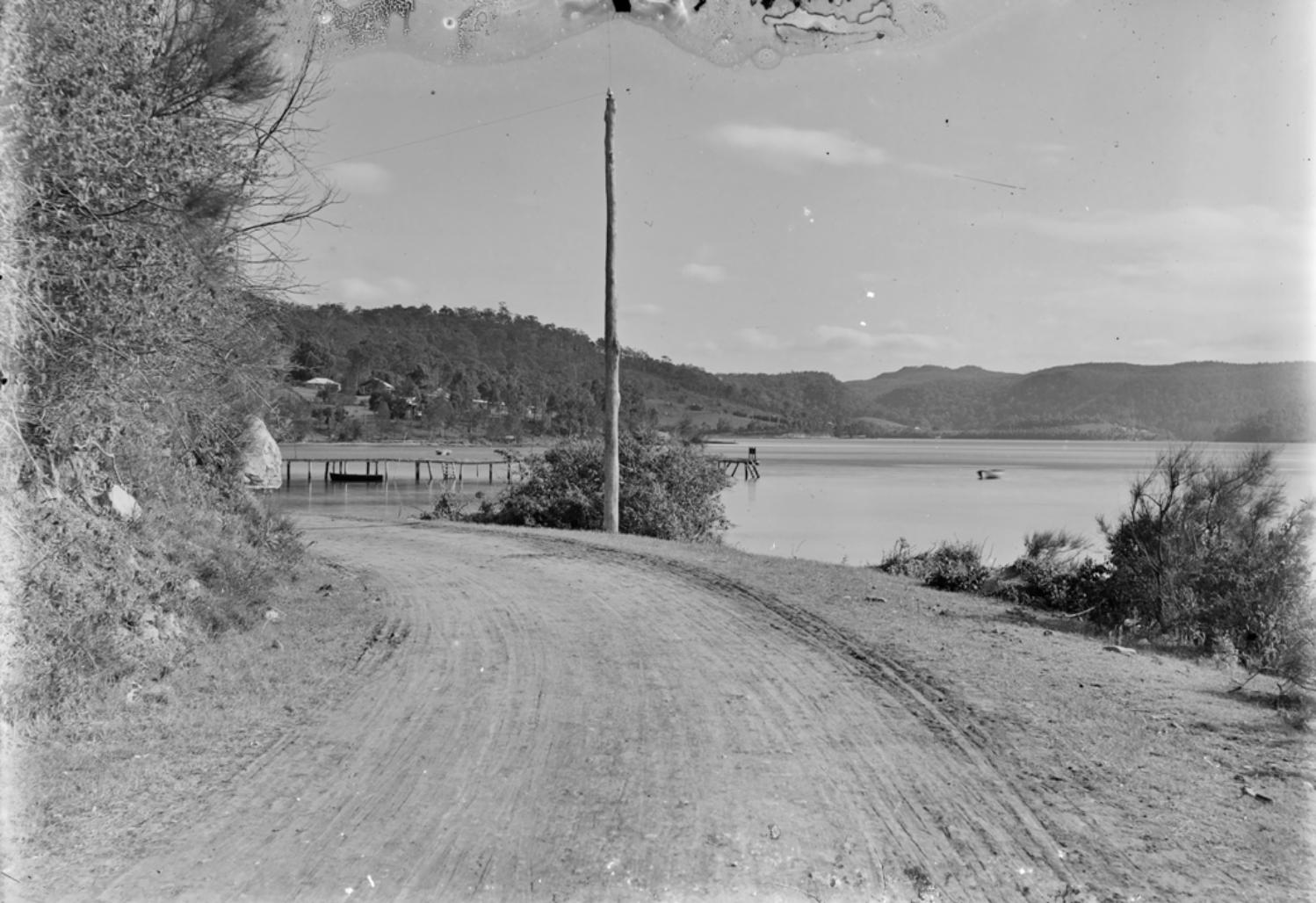
See same image in:
MANLY TO BAY VIEW—A POPULAR EASTER RESORT BY ROAD
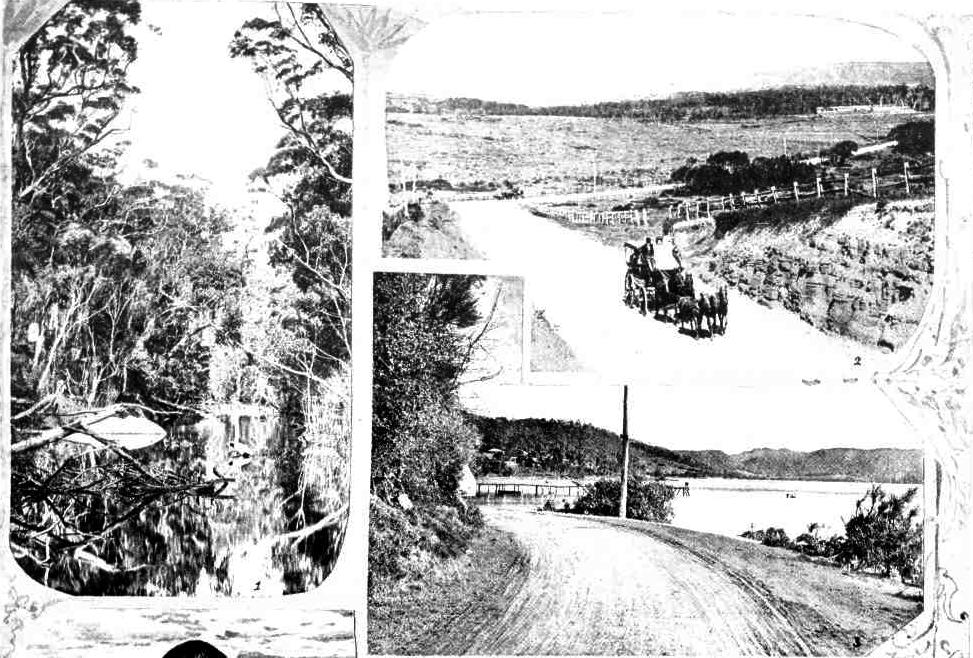
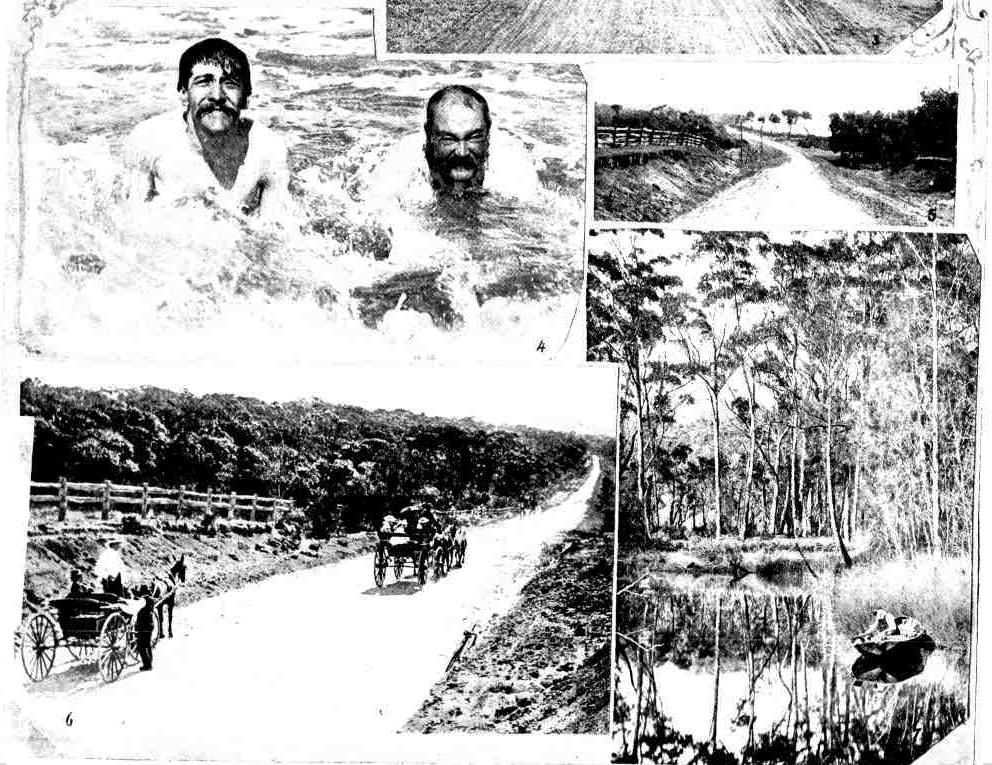
1. On the Narrabeen Lagoon. 2. View from Sheepstation Hill, looking south. 3. Bay View. 4. a dip in the surf at Narrabeen. 5. Near Long Reef. 6. Approaching Narrabeen. 7. One of the creeks.
The distance from Manly to Bay View is about 15 miles. The road is by the Narrabeen-road past Rocklily. A proposal to put down a tram line is now being considered, and a member of the ministry was recently driven over the country, which in many parts is remarkably picturesque.
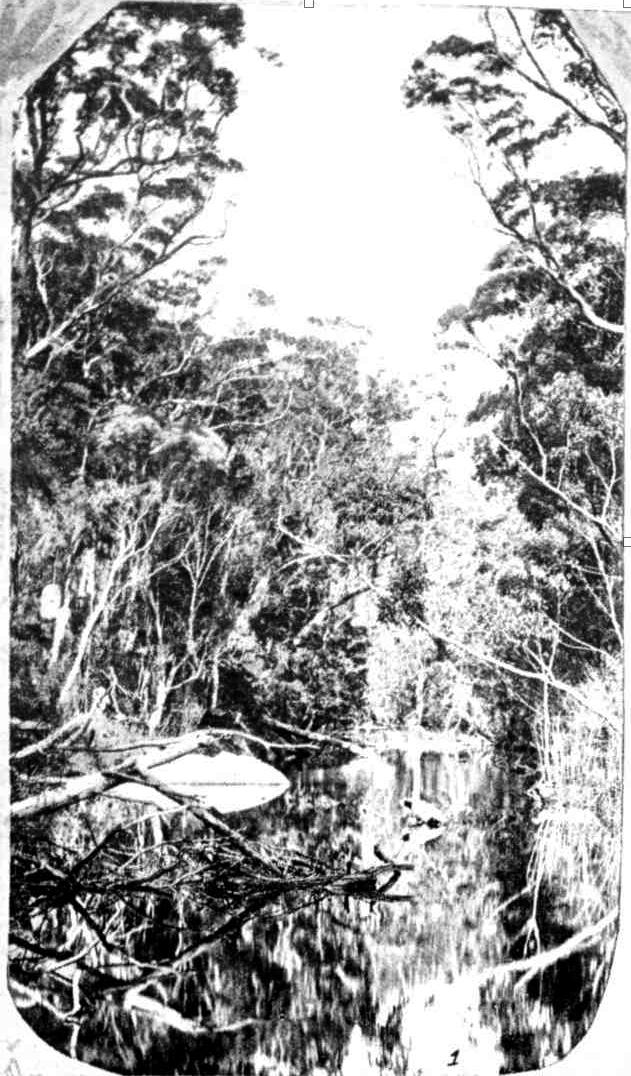
1. On the Narrabeen Lagoon.
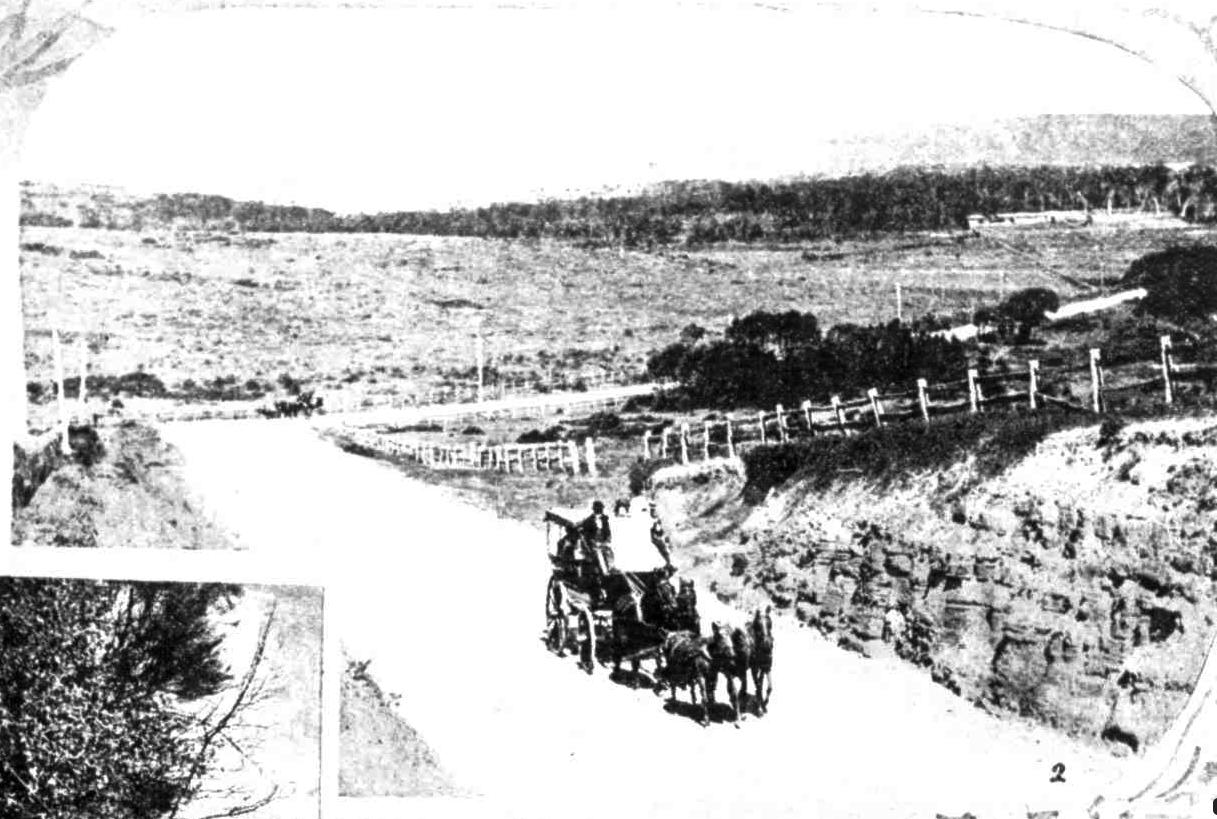
2. View from Sheepstation Hill, looking south.
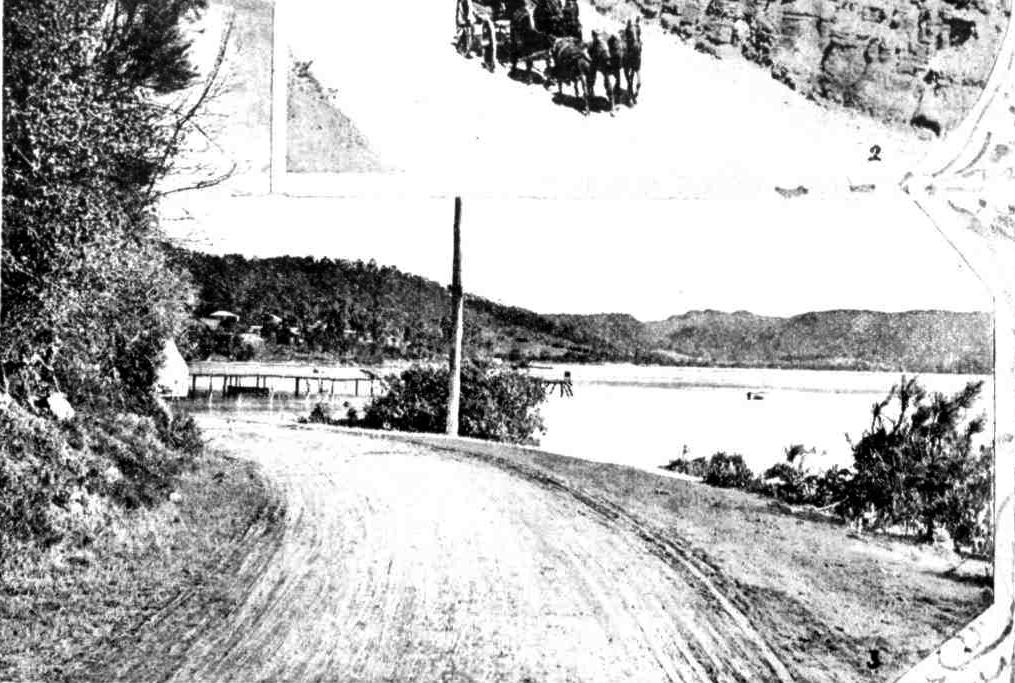
3. Bay View.
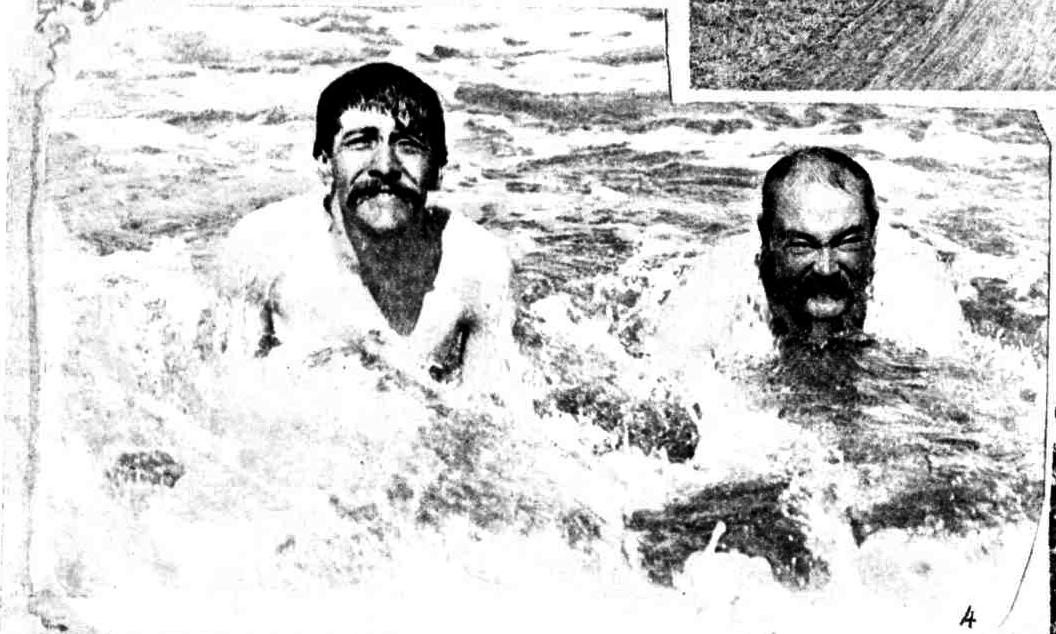
4. A dip in the surf at Narrabeen.
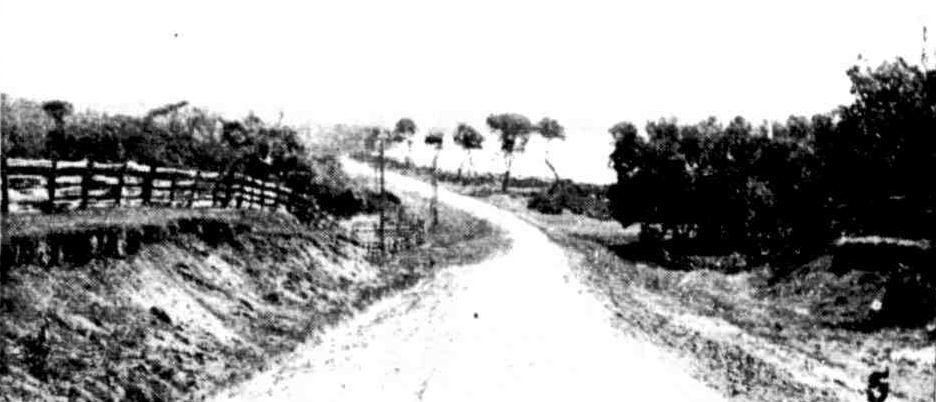
5. Near Long Reef.
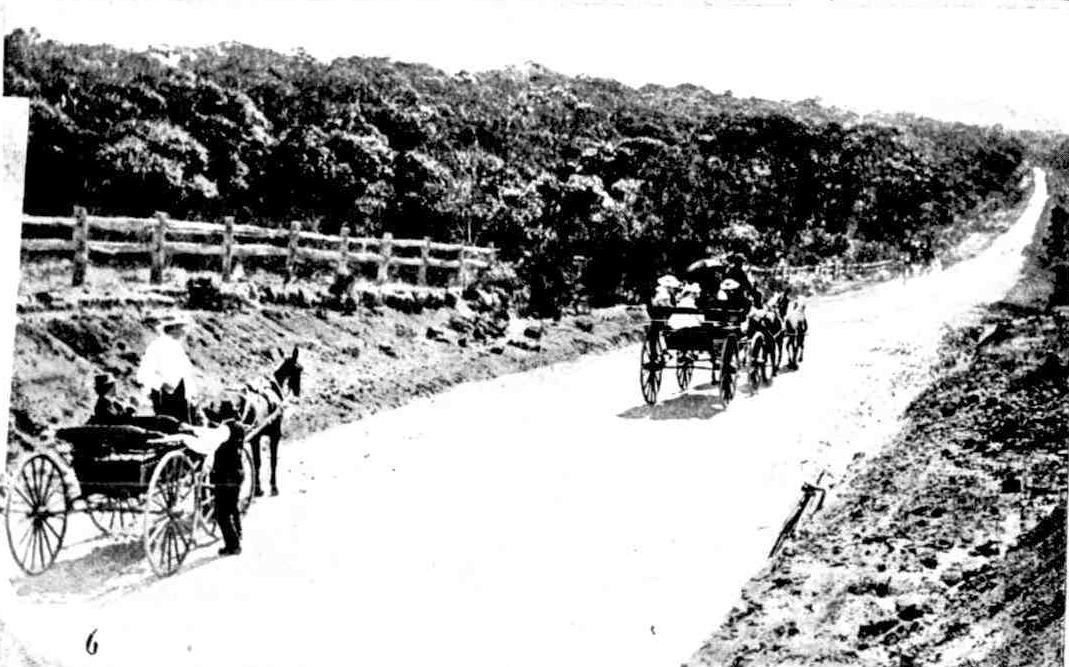
6. Approaching Narrabeen.
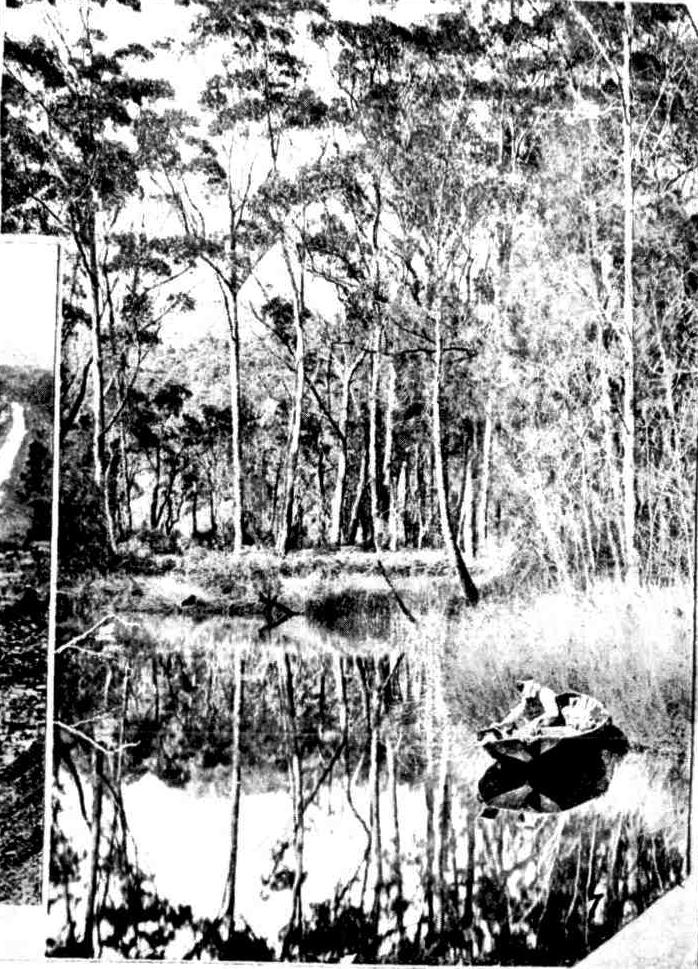
7. One of the creeks.
MANLY TO BAY VIEW—A POPULAR EASTER RESORT BY ROAD. (1900, April 14). The Sydney Mail and New South Wales Advertiser (NSW : 1871 - 1912), p. 878. Retrieved from http://nla.gov.au/nla.news-article165297416
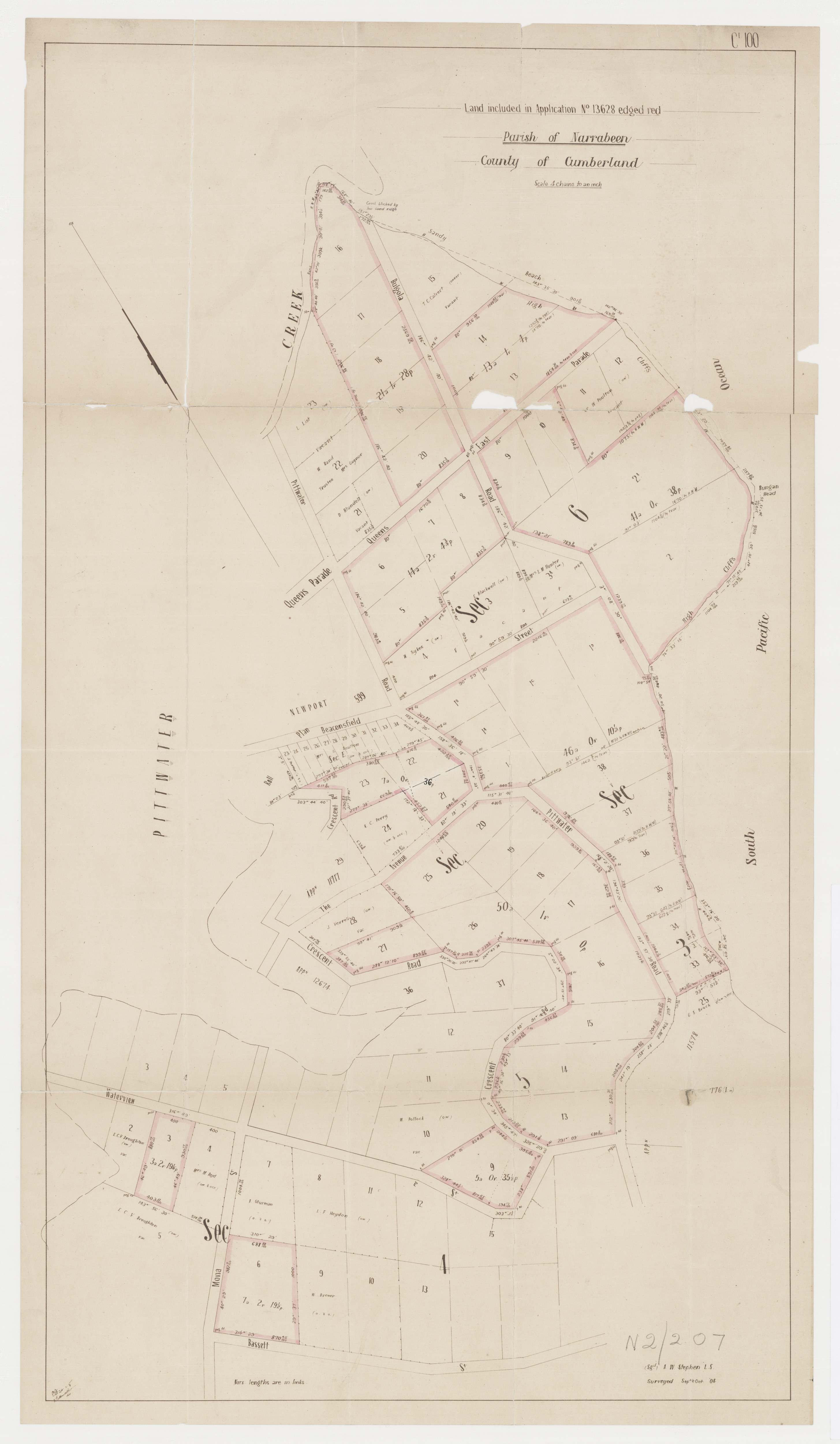
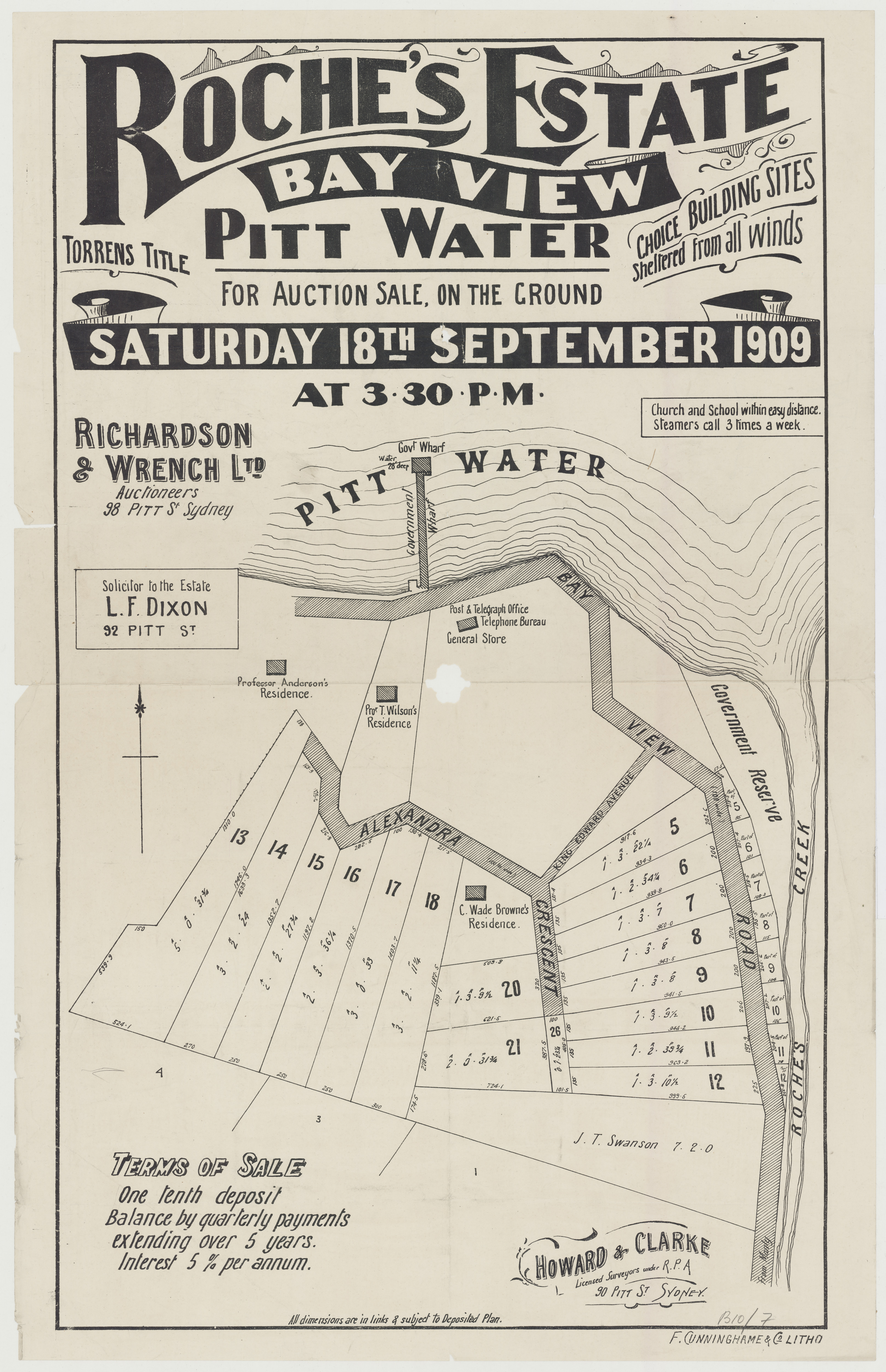
Roche Estate Bay View Pitt Water, September 18th, 1909 - Subdivision Plan, Item: c029500007h, courtesy State Library of NSW - from Pittwater Subdivision Plans folder
ROCHE'S ESTATE.— Messrs. Richardson and Wrench, Ltd., will sell by auction, on the ground, next -Saturday, lots at Bayview, Pittwater. COMING SALES. (1909, September 12). Sunday Times (Sydney, NSW : 1895 - 1930), p. 4. Retrieved from http://nla.gov.au/nla.news-article126590985
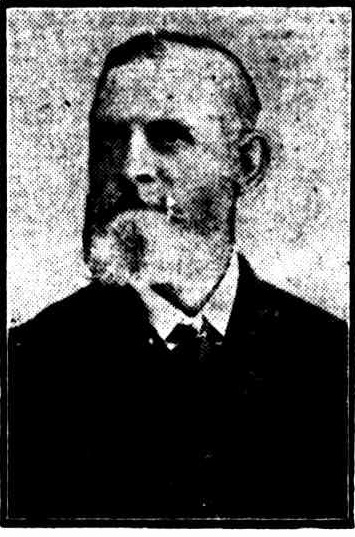 Lieutenant Wade Browne, of Medlow Bath and Bayview, Pittwater, who died recently in his 85th year, was a Crimean and Indian Mutiny veteran, and a pioneer in the improvement of cattle-breeding methods and sugar-planting in Australia.
Lieutenant Wade Browne, of Medlow Bath and Bayview, Pittwater, who died recently in his 85th year, was a Crimean and Indian Mutiny veteran, and a pioneer in the improvement of cattle-breeding methods and sugar-planting in Australia. 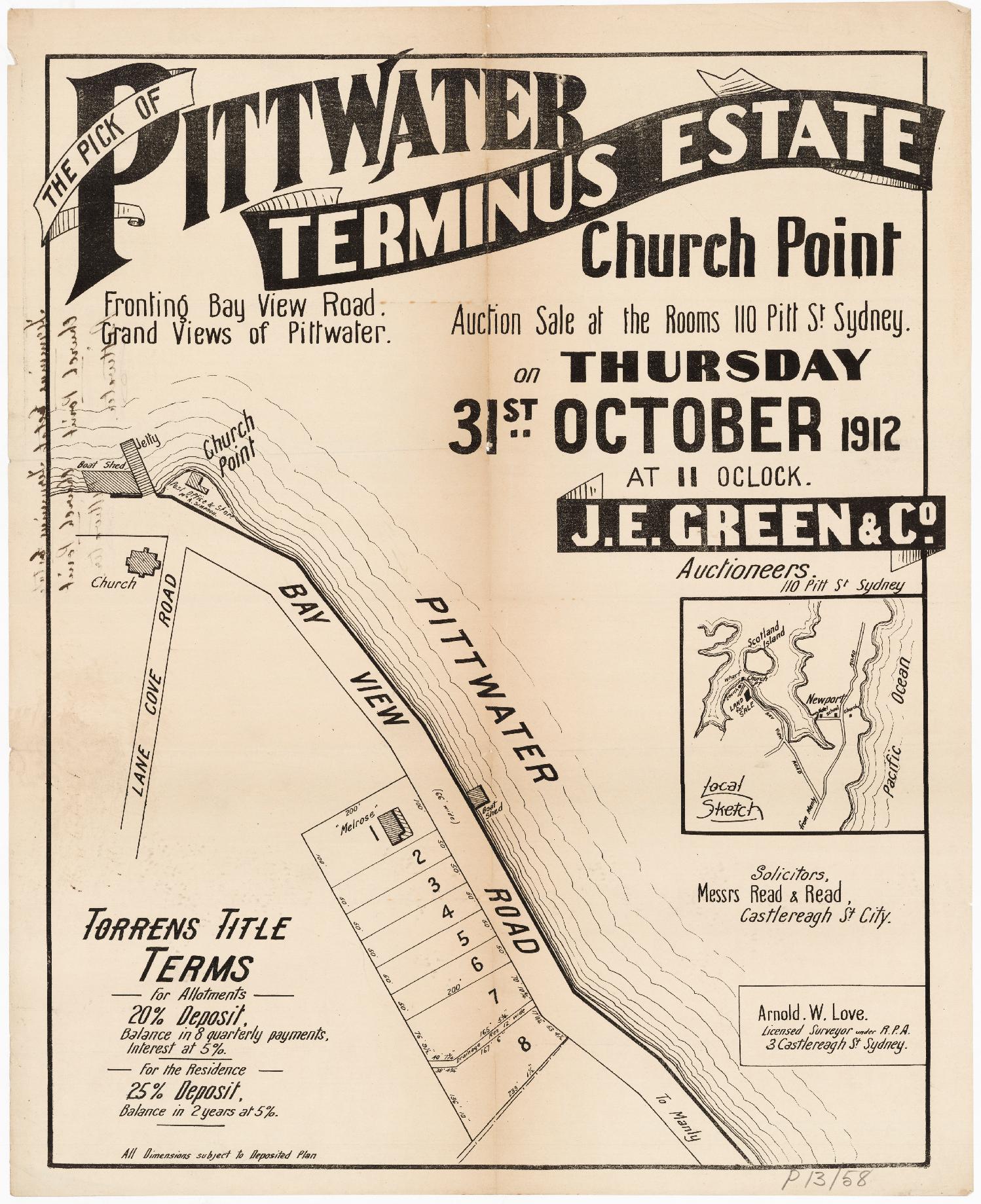
Terminus Estate- Bay View Rd, Pittwater Rd, 1912 - Subdivision Plan, Item: c053460062, courtesy State Library of NSW - from Bayview Subdivision Plans folder
From Shelagh and George Champion OAMs (7.1.2013):
Bellemere-Melrose is one property, while The Green Frog is an entirely separate property. This became very clear to me when I researched the Church Point land in the Land Titles Office. The Melrose property was transferred by Benjamin James to Philip Charley on 22 December 1890; then by Charley to Arthur Morris Simpson on 30 August 1911; and then by Simpson to Mrs Ada Ellen Pritchard on 22 December 1915. It remained in the Pritchard family as a private residence.
The Green Frog property (lots 7, 8, 21 and 22 with a house on lot 7, on the attached map) was transferred by Simpson to de Kantzow and then to Herbert L. Alford and his wife on 4 February 1923, and remained the property of the Alfords.
Visit: Bellemere-Melrose-The Green Frog, Church Point
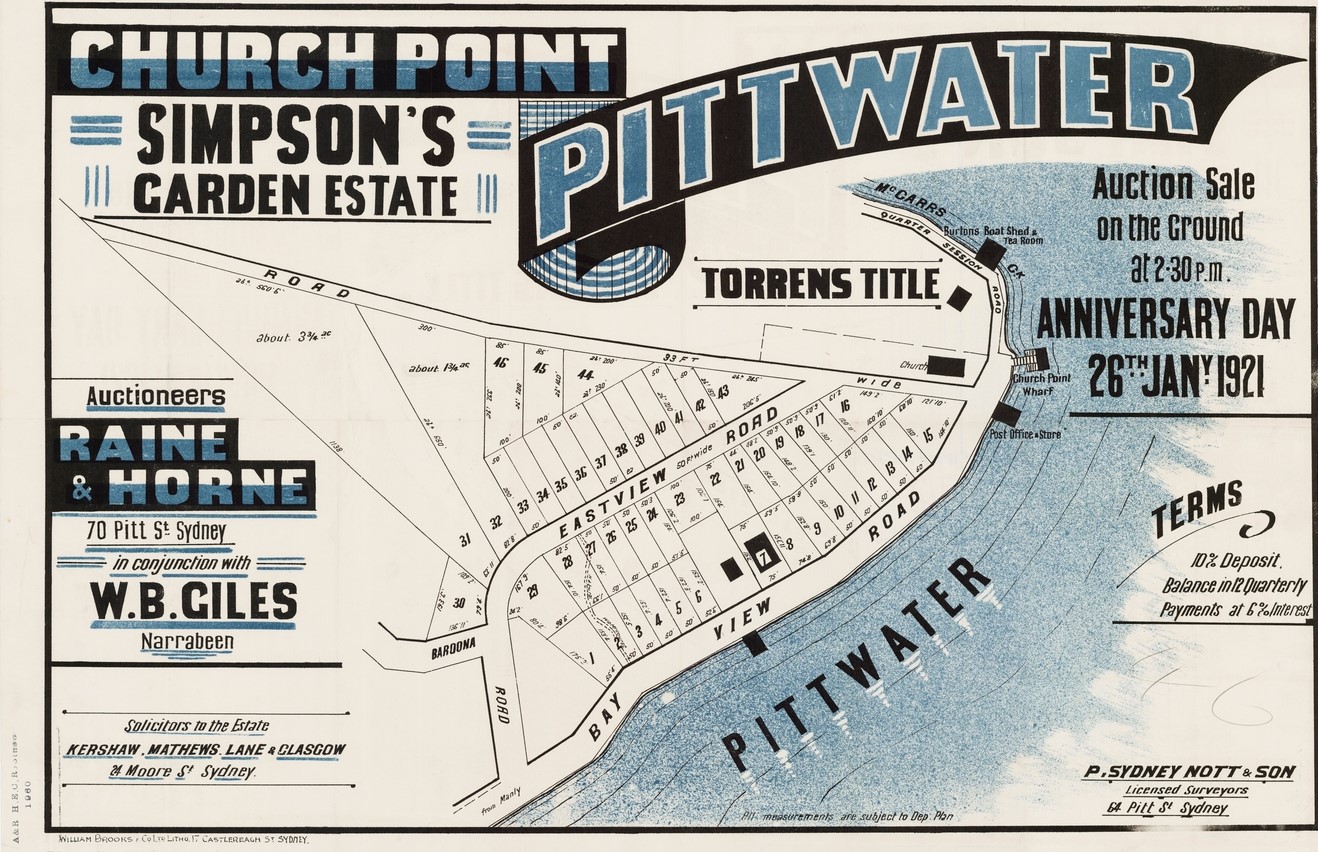
Simpson Garden estate, Church Point, 1921 - Subdivision Plan, Item: c035690005 courtesy State Library of NSW - from Bayview Subdivision Plans folder
NEWPORT,
Opposite the Newport Hotel and Vogan's Point,
Almost adjoining Allen's Wharf, 5 minutes from Bayview-road, along Mona-street.
WINTERGREEN ESTATE.
30 BEAUTIFUL SITES, NICELY SLOPING TO THE WATER. PRETTILY TIMBERED.
AUCTION SALE ON THE GROUND,
SATURDAY, 23TH OCTOBER, 1913-
Illustrated Plans on Application.
TERMS: 10 per cent. Deposit, Balance
in 12 Quarterly
Payments at 5 per cent. int.
HARDIE AND GORMAN PROPRIETARY, LTD.,
Auctioneers, 183 Pitt-street.
W. E. DREW, Esq.,
14 Moore-street, Solicitor to the Estate. Advertising (1913, September 27). The Daily Telegraph (Sydney, NSW : 1883 - 1930), p. 21. Retrieved from http://nla.gov.au/nla.news-article238908480 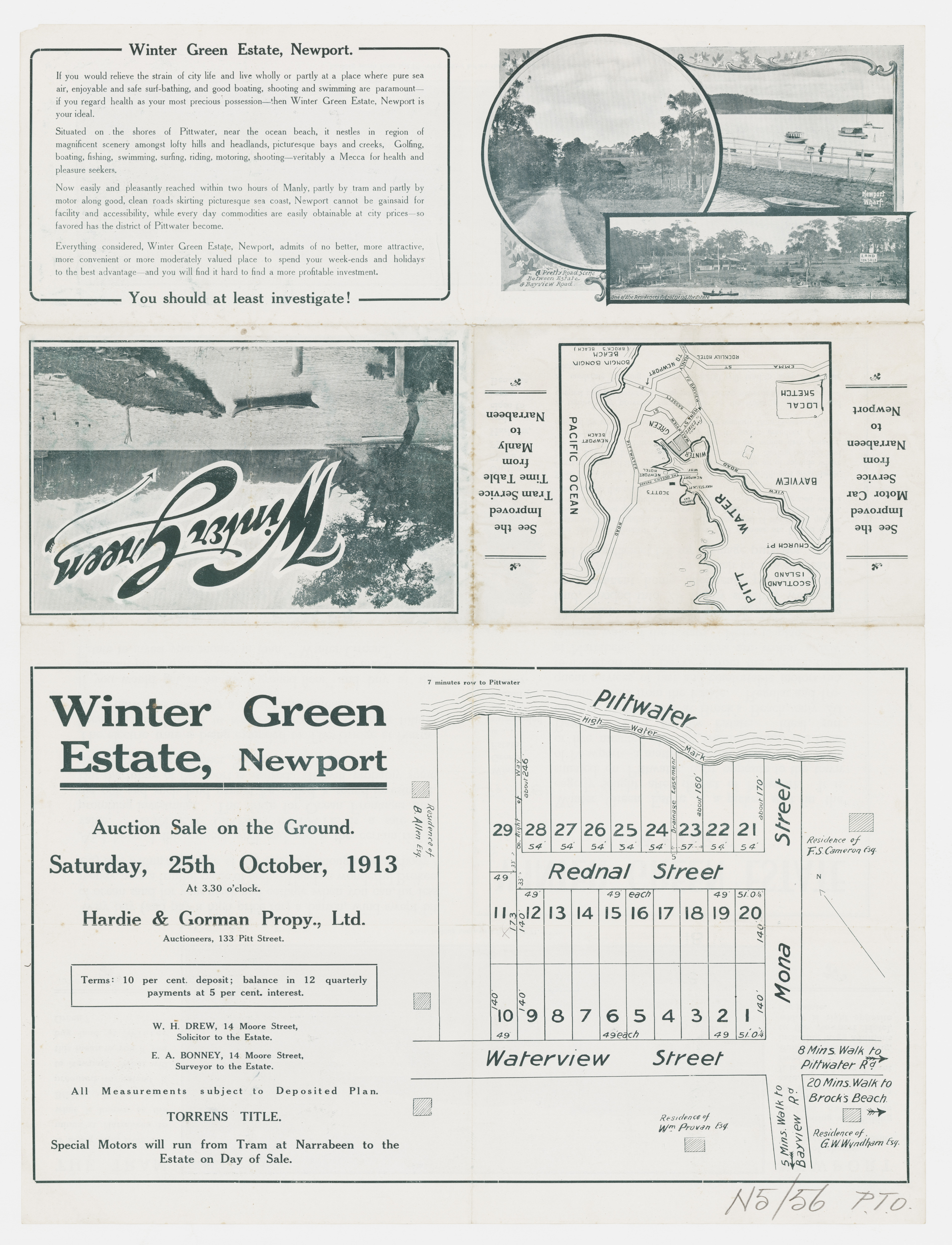
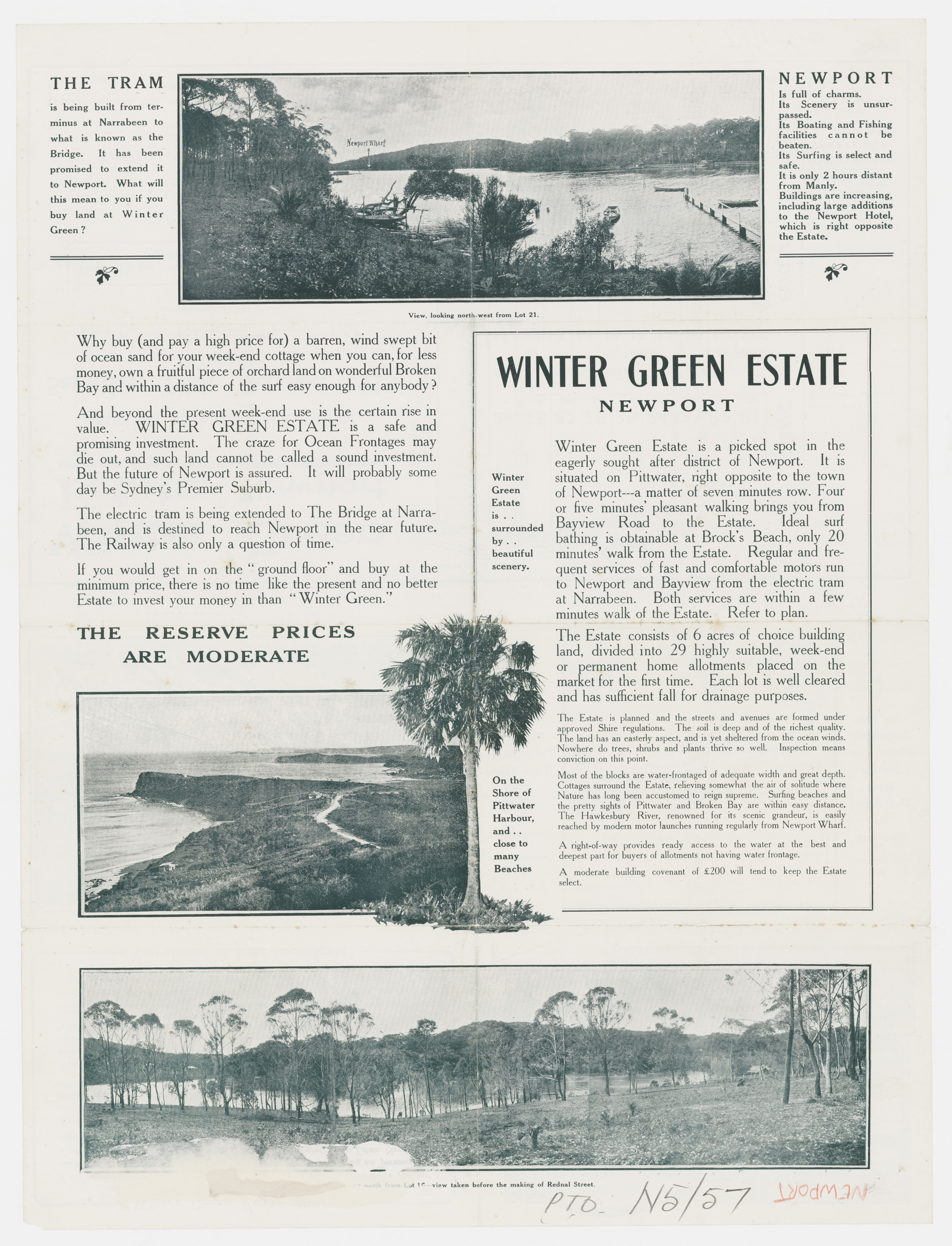
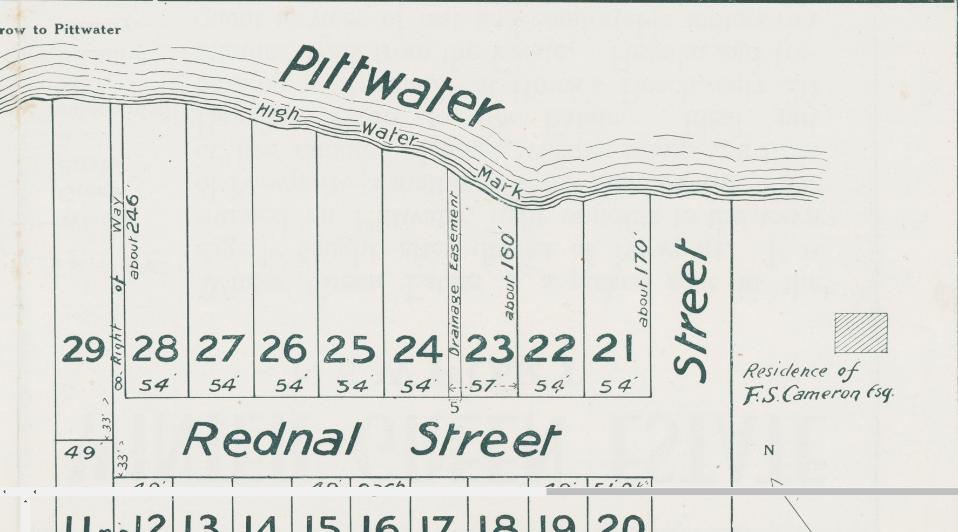

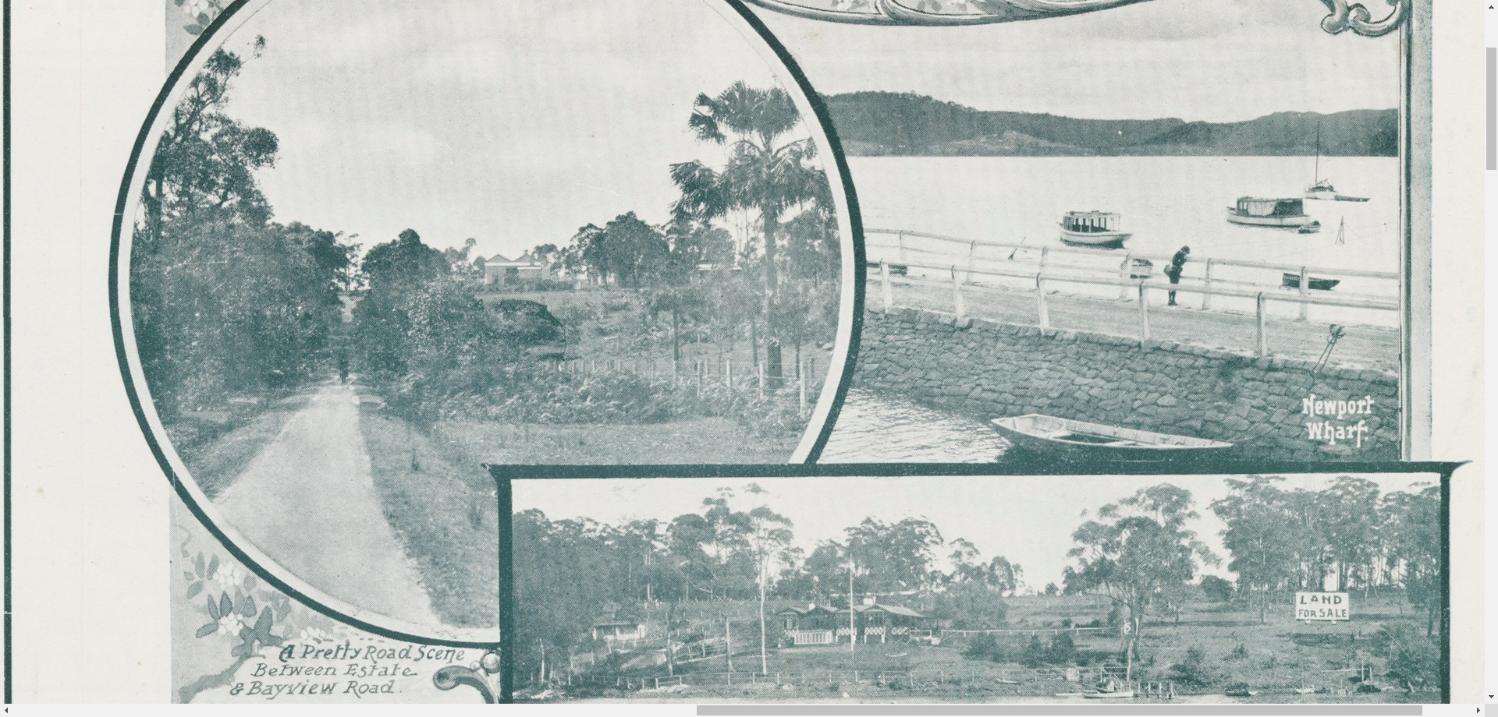
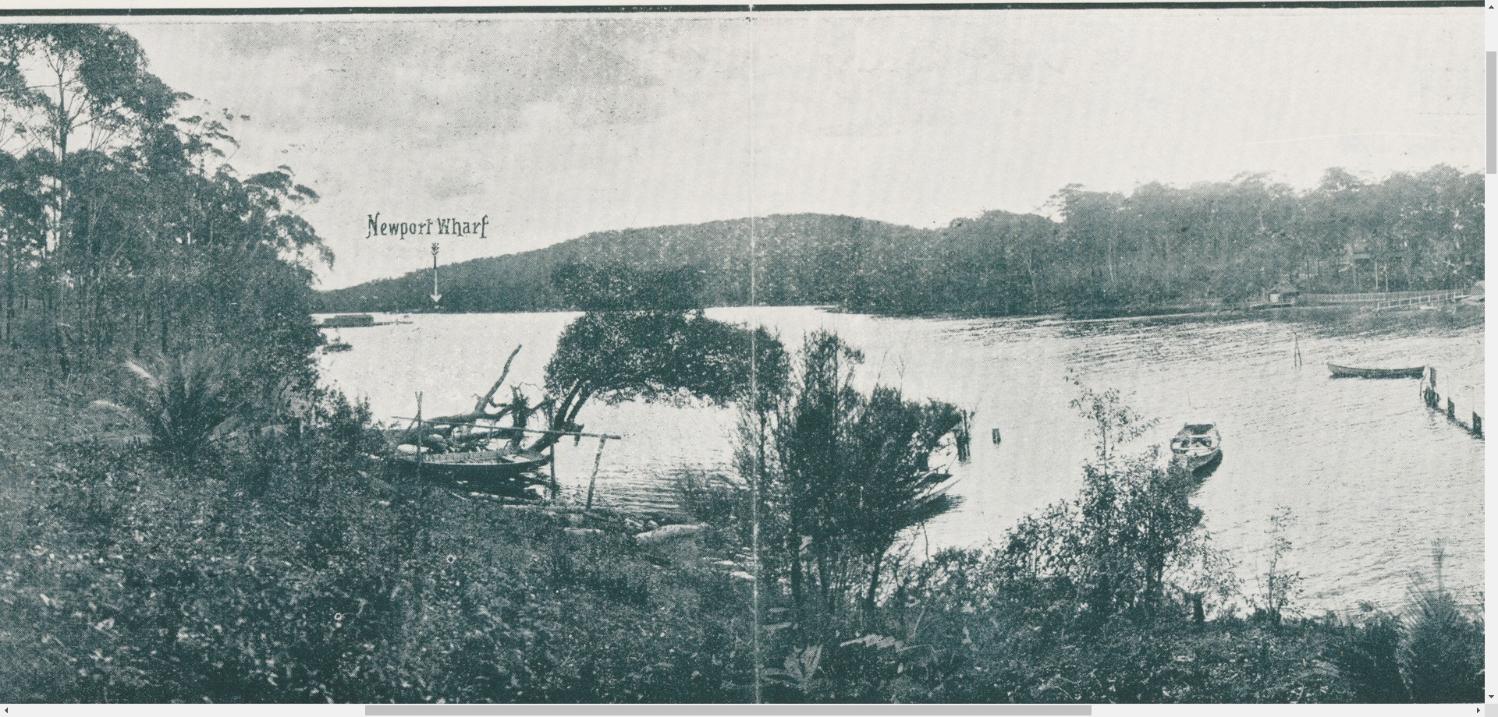
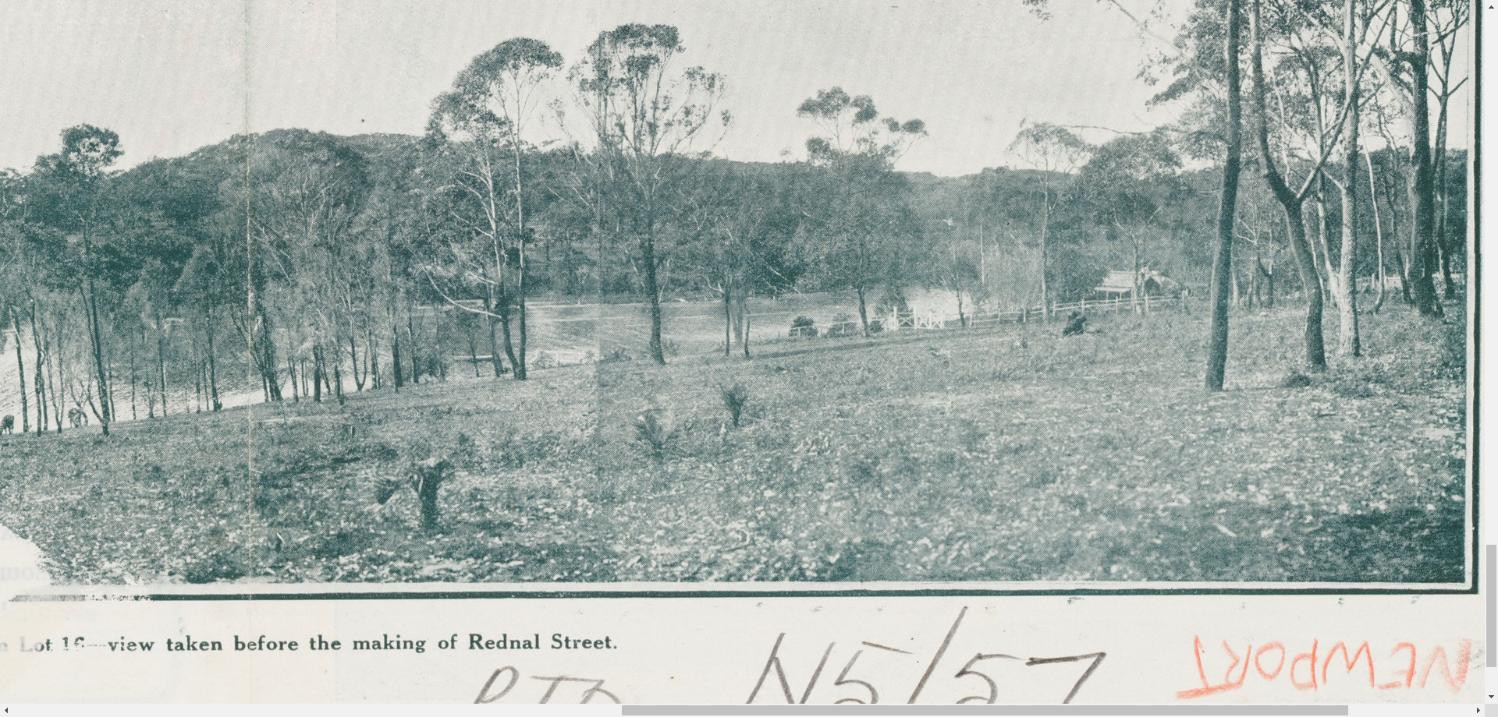
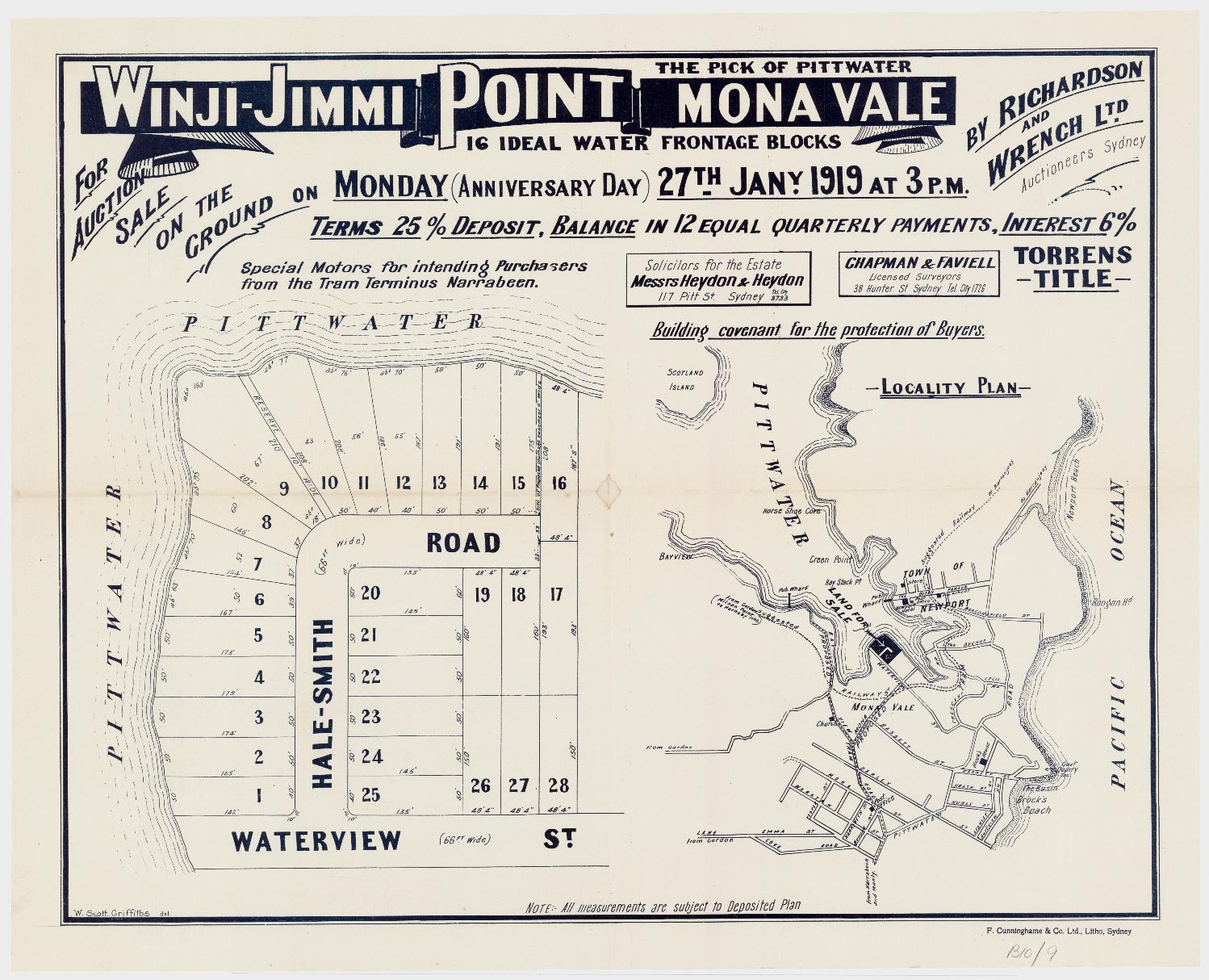
Winji Jimmi Point Mona Vale - Waterview St, Pittwater, Hale-Smith Rd, January 27th, 1919. Item: c029500009
Quite a number of subdivisional sales will be held to-day or on Monday. Messrs Richardson and Wrench will offer on Monday the Mona Vale Estate, Pittwater, on Winji Jimmi Point. There are 28 allotments, of which 16 have water frontages. The same firm, in conjunction with Mr. Lance Giddings, will offer also on Monday the Second subdivision of Matson City, Cronulla. REAL ESTATE. (1919, January 25). The Sydney Morning Herald (NSW : 1842 - 1954), p. 9. Retrieved from http://nla.gov.au/nla.news-article15821838
Warringah Shire Council Minutes of Meetings provides: Winji Jimmi Subdivision - Heydon and Heydon, 3/1/ 19, forwarding cheque for £190, for Winji Jimmi Subdivision road construction : Resolved, That the writers be informed that the Council is prepared to carry out the work in accordance with the letter so far as the money will go, but that it will probably not be able to start the work before the 26th inst., and that it will not object to the selling of the allotments before the subdivision road is constructed. It was decided to suggest that the new street be named Hale-Smith Street.
A few years on:
UNDER INSTRUCTIONS FROM THE UNION TRUSTEE COMPANY OF AUSTRALIA. LIMITED, ADMINISTRATORS C. T. A. OF THE ESTATE OF THE LATE B. B. ALLEN.
ABSOLUTE DEEP WATER FRONTAGE TO PITTWATER.
WITH COTTAGE RESIDENCE, "WINGI JIMMI." FRONTING WATERVIEW-STREET, and TWO CHOICE BUILDING ALLOTMENTS.
Only a few minutes' walk from Main Pittwater -road.
1. A MOST DESIRABLE WATER FRONTAGE COTTAGE, with a SPECIAL APPEAL to YACHTS NORTH-EASTERLY ASPECT. "WINGI JIMMI," A WELL-CONSTRUCTED COTTAGE OF BRICK, finished in roughcast cement, with roof of galvanised iron, containing dining-room end two bedrooms, each with fireplace, bathroom, verandah to front 9 feet wide, verandah at rear 10 x 10, kitchen with fuel stove, laundry. Water laid on from tanks to kitchen, bathroom, and laundry.
THE OUTBUILDINGS comprise WEATHER-BOARD GARAGE with concrete floor. Hardwood 2-stall stable, feedroom, and woodshed.
ON THE WATER FRONT is erected a SUBSTANTIAL WEATHERBOARD BOATSHED, with roof of galvanised Iron, with skids attached,
ALSO a WELL-CONSTRUCTED RUBBLE JETTY and a LARGE ENCLOSED SWIMMING BATH.
THE LAND has a frontage to WATERVIEW STREET Of 100ft by a depth of 529ft. IN AREA 1 acre 0 roods 3 perches. FREEHOLD NOTE.-This property should COMMEND Itself to YACHTSMEN and OTHERS desirous of securing In a HANDY. GET ABLE, and CHARMING LOCATION a DESIRABLE WATERSIDE HOME, eithe- as a permanent residence or for holiday or week-end periods.
THE WHOLE IN ABSOLUTE PERFECT ORDER.
TERMS: 25 per cent, deposit, balance In 3 years. Interest 6 1/2 per cent.
FOR INSPECTION apply H. E. PORTER, Newport
ADJOINING "WINGI JIMMI" are TWO CHOICE BUILDING ALLOTMENTS, as follows:
VACANT LAND, Lot 28, having a frontage to WATERVIEW-STREET of 48.4 by a depth of VACANT LAND at rear of Lot 28. being Lot 17 with a frontage to HALE-SMITH-STREET'of 33ft by a depth of 193, rear line 48.4. Torrens.
TERMS: 10 per cent, deposit, balance In equal quarterly payments. Interest 6 per cent.
GRAY and CO., 135 PITT-STREET : and at MOSMAN, in conjunction with H.E. PORTER, Pittwater road, NEWPORT, will submit the above-deseribed PROPERTIES at PUBLIC AUCTION on THURSDAY.21st
NOVEMBER, at 11.15 am.. at THE REAL ESTATE INSTITUTE, 30a MARTIN-PLACE. SYDNEY.
Messrs. MINTER SIMPSON and CO.. Union Bank Chambers, Hunter-street, solicitors to the Estate. Advertising (1929, November 9). The Sydney Morning Herald (NSW : 1842 - 1954), p. 27. Retrieved from http://nla.gov.au/nla.news-article16600388
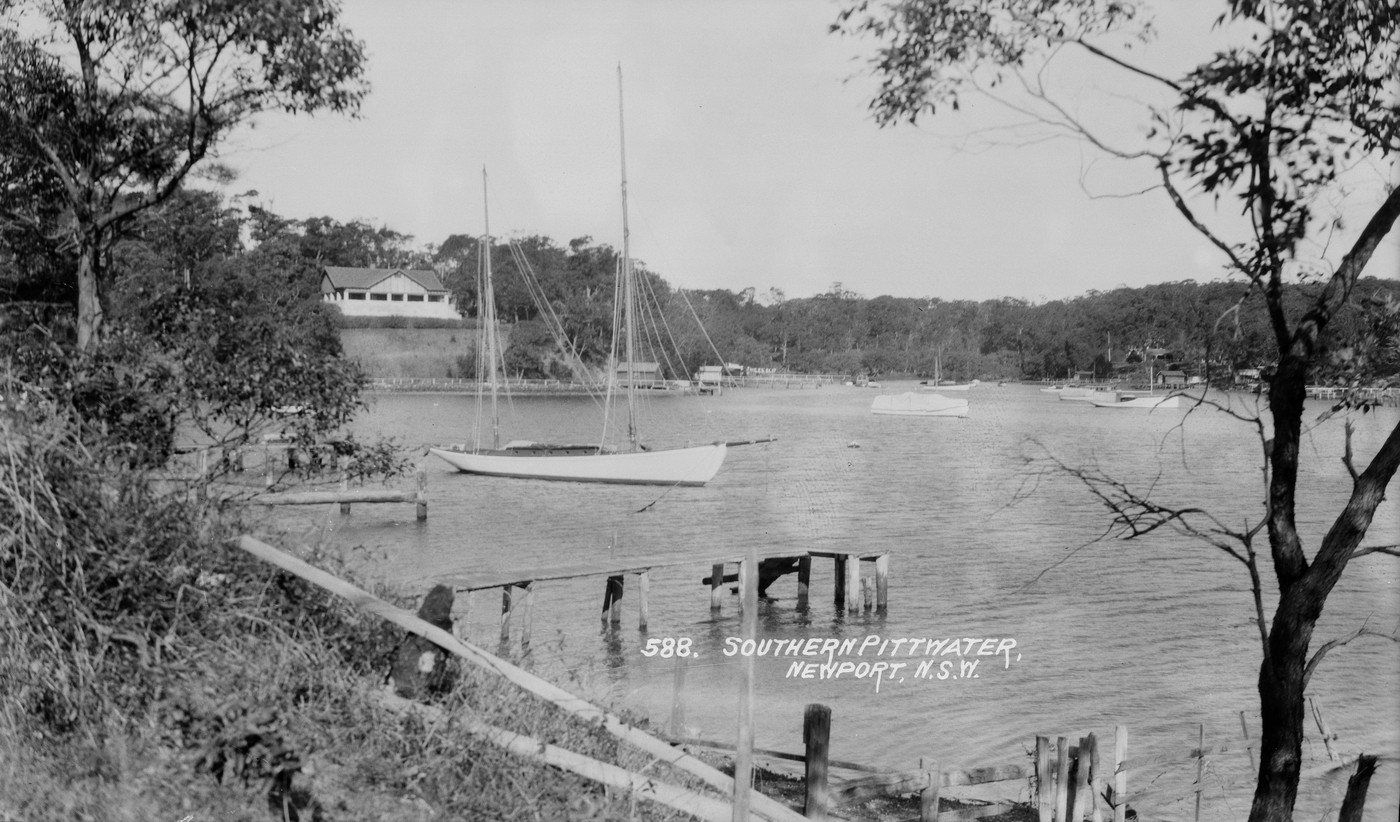
Southern Pittwater (Newport - Winji Jimm) from album ''Samuel Wood - postcard photonegatives of Avalon, Bilgola and Newport, ca. 1928'', Item: a1470007h , Courtesy Mitchell Library, State Library of New South Wales
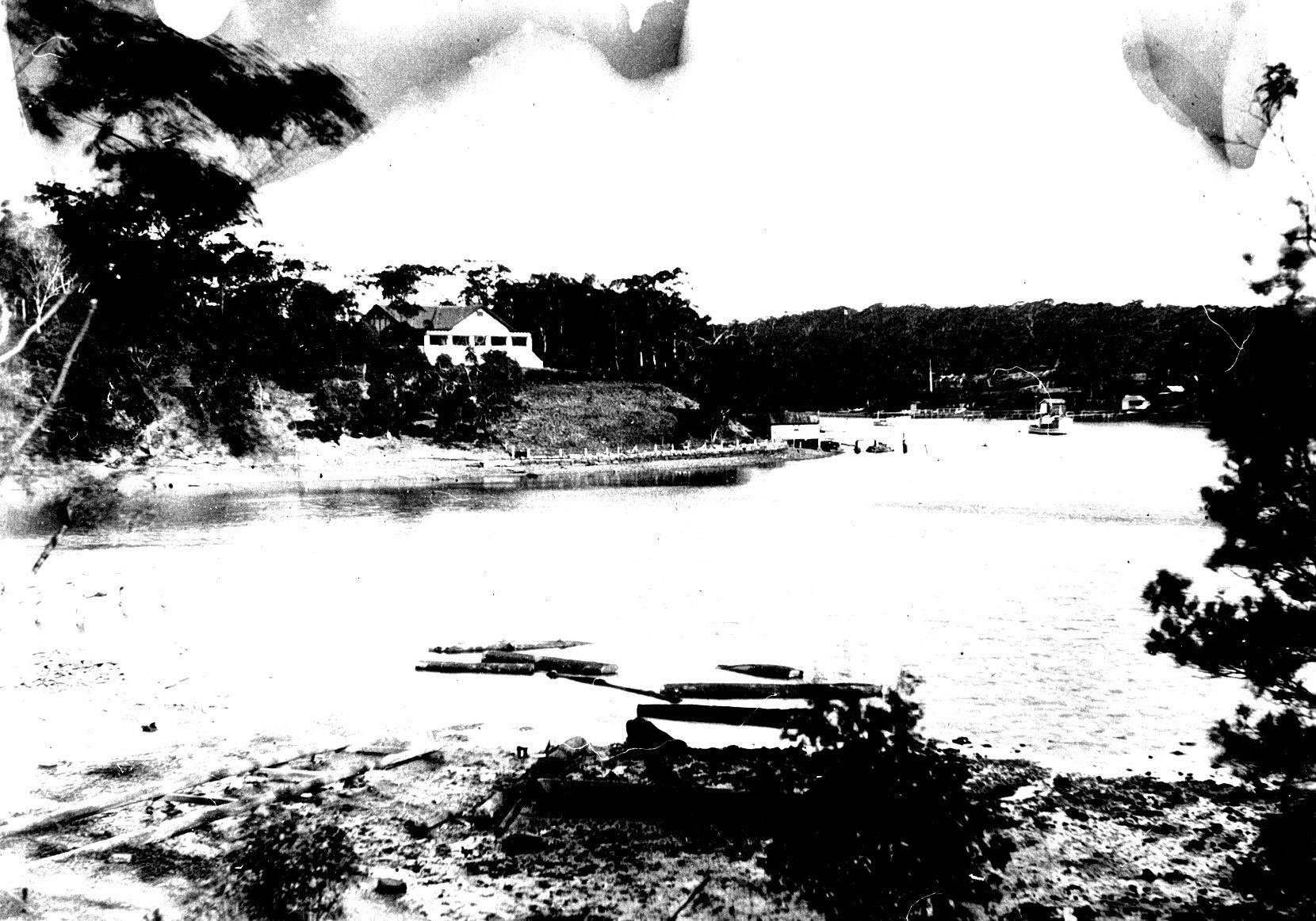
Pittwater. There is a boat moored to a small pier in the foreground. Creator; Alan Jackson, circa 1930. Courtesy Museums Victoria
Mr Allen passed away at his home in Wahroonga at the age of 61:
DEATH OF MR. B. B. ALLEN
The news of the death of Mr. B. B. Allen was received with sincere regret throughout New South Wales. Many graziers will feel that they have lost a personal friend. For years Mr. B. B. Allen was chairman of the Executive Council of the Graziers' Council, and he was a most successful chairman. His tact was proverbial, his knowledge was comprehensive, and his one desire was to do the right thing by the pastoral industry.
Everybody who knew B. B. Allen liked him. He had personal charm, and nothing ever seemed a trouble to him. You could go to him for advice, or you could go to him to do something for you, and you would always be sure of the most courteous consideration; and if it was in his power he would help you.
Since 1902 Mr. Allen had been a member of the Executive Committee. In April, 1910, he was appointed chairman of the committee and retained that position until a few months ago. He was chairman of many important conferences, and he represented the Association at several Federal Conferences. His never-failing tact helped to make him an admirable chairman, and an exceedingly worthy representative. Mr. Allen was a member of the committee of the Sydney Wool Selling Brokers for many years, and for several years past occupied the position of treasurer. He was also a member of the Sydney Chamber of Commerce and the Sheep Breeders' Association of New South Wales.
Mr. Allen is survived by Mrs. Allen, and by two daughters — Mrs. McKechnie, wife of the manager of Manaroo Station, Central Queensland; and Mrs. Auschau, of Sydney — and one son, Mr. Ernest Allen, of Eumarra Station, Brewarrina. DEATH OF MR. B. B. ALLEN (1928, October 2). The Tumut and Adelong Times (NSW : 1864 - 1867; 1899 - 1950), p. 1. Retrieved from http://nla.gov.au/nla.news-article139291643
In the Supreme Court of New South Wales.
PROBATE JURISDICTION.
In the will of Bernard Barnett Allen, late of Sydney, in the State of New South Wales, company manager, deceased.
PURSUANT to the provisions of the Wills, Probate and Administration Act, 1898, of the Testator's Family Maintenance and Guardianship of Infants Act; 1916, and of the Trustee Act, 1925: Notice is hereby given that all creditors and other persons having any claim, demand upon or against the estate or otherwise interested in the property and assets of the abovenamed deceased, who died at Wahroonga, on the 23rd day of September, 1928, and letters of administration, with the will annexed, of whose estate were granted by the Supreme Court of New South Wales, in its Probate Jurisdiction, on the 21st day of December, 1928, to The Union Trustee Company of Australia Limited, the administrator of the estate of the abovenamed deceased, are hereby required to send on or before the 11th day of March, 1929, full particulars of their claims and demands upon the said estate or in respect of the said property and assets or any part thereof to The Union Trustee Company of Australia Limited, 2 O'Connell-street, Sydney, at the expiration of which time the said The Union Trustee Company of Australia Limited intends to proceed to administer the said estate and to convey, distribute and/or appropriate the property and assets of the said deceased to and among the parties and persons entitled thereto, having' regard only to the claims, demands and interests of which they shall then have notice; and the Company will not, in respect of the property and assets or any part thereof so conveyed, distributed or appropriated, be liable to any person of whose claim they shall not Have had notice at the time of such conveyance, distribution or appropriation.—Dated this 28th day oil December, 1928.
The Union Trustee Company of Australia Limited,
A. E. NORDEN,
Manager. Minter, Simpson and Company, Proctors for Administrator,
** Union Bank Chambers,
Hunter-street, Sydney.
PROBATE JURISDICTION. (1929, January 4). Government Gazette of the State of New South Wales (Sydney, NSW : 1901 - 2001), p. 75. Retrieved from http://nla.gov.au/nla.news-article223987798
Council could not afford garbage collections for this area until 1943, an R C Taylor was requesting the road be tarred in November 1948 - in June 1950 they decided to acquire a small section of the frontage of Mrs. Vanstone's Lot 28, Rednal Street, be acquired, the estimated cost being from £30, to connect Rednal and Hale-Smith streets, and although there was a streetlight in 1948, the rollout of streetligfhts, plural, was still being asked for from Mackellar County Council in June 1952.
Towards the Bayview-Church Point (Capes Flat-Fig Tree Flat) one of the first subdivisions was that which occurred after William Lambert passed away. William Lambert had 42 acres 33 perches at Bay View on Pittwater.
When Robert McIntosh Junior sold the 200 acres he inherited from his father to William Timothy Cape on 6 June 1834 for £130 Cape leased McIntosh’s 200 acre grant to John Johnson for £20 per annum. John and Charlotte Johnson were living there, with three children, at the time of the 1841 census. They were still there in 1845, when John Johnson, Peter Duffy, and Daniel Bullock were all named as being associated with illegal distilling at McCarr’s Creek. The three were all married to Oliver women.
The Johnsons had departed from Pittwater by August 30th 1845, when Cape leased the 200 acres to Thomas Johnson Jones. This stretch of land at Bayview was known as Cape’s Flat. After Cape’s death it was sold to Albert Henry Turner for £200 on June 2nd 1876. In his own name, Robert II had applied to purchase 40 acres next to the 200 acres, on 28 March 1831. This was also sold to W.T. Cape on June 6th 1834, for £25. The deed of grant was made to Cape on April 8 1840.
BY ORDER OF THE EXECUTORS OF THE LATE MR. JOHN REDMAN.
LOT 1. CARLYLE, EDROP-STREET, BURWOOD, FAMILY RESIDENCE containing hall, 5 rooms, &c, also stabling, &c The LAND has a frontage of 100ft. by 175ft
LOT 2. PITTWATER, W. B. COTTAGE containing 5 rooms, &c., also W. B. COTTAGE containing 4 rooms, &c, erected on a Block of Land containing an area of about 2 1/2 acres, fronting Pittwater Bay.
LOT 3. PITTWATER, BLOCK of LAND containing an area of about 17 1/2 acres, fronting the Bay, and close to the Post Office, upon which is erected a W. B. COTTAGE, containing 3 rooms, &c.
HARDIE and GORMAN have received instructions from the executors of the late Mr. John Redman to sell by public auction, in the Rooms, at 11.30 o'clock, ON AUGUST 15th, 1888. The above described properties. Advertising (1888, August 13). The Sydney Morning Herald (NSW : 1842 - 1954), p. 11. Retrieved from http://nla.gov.au/nla.news-article13693226
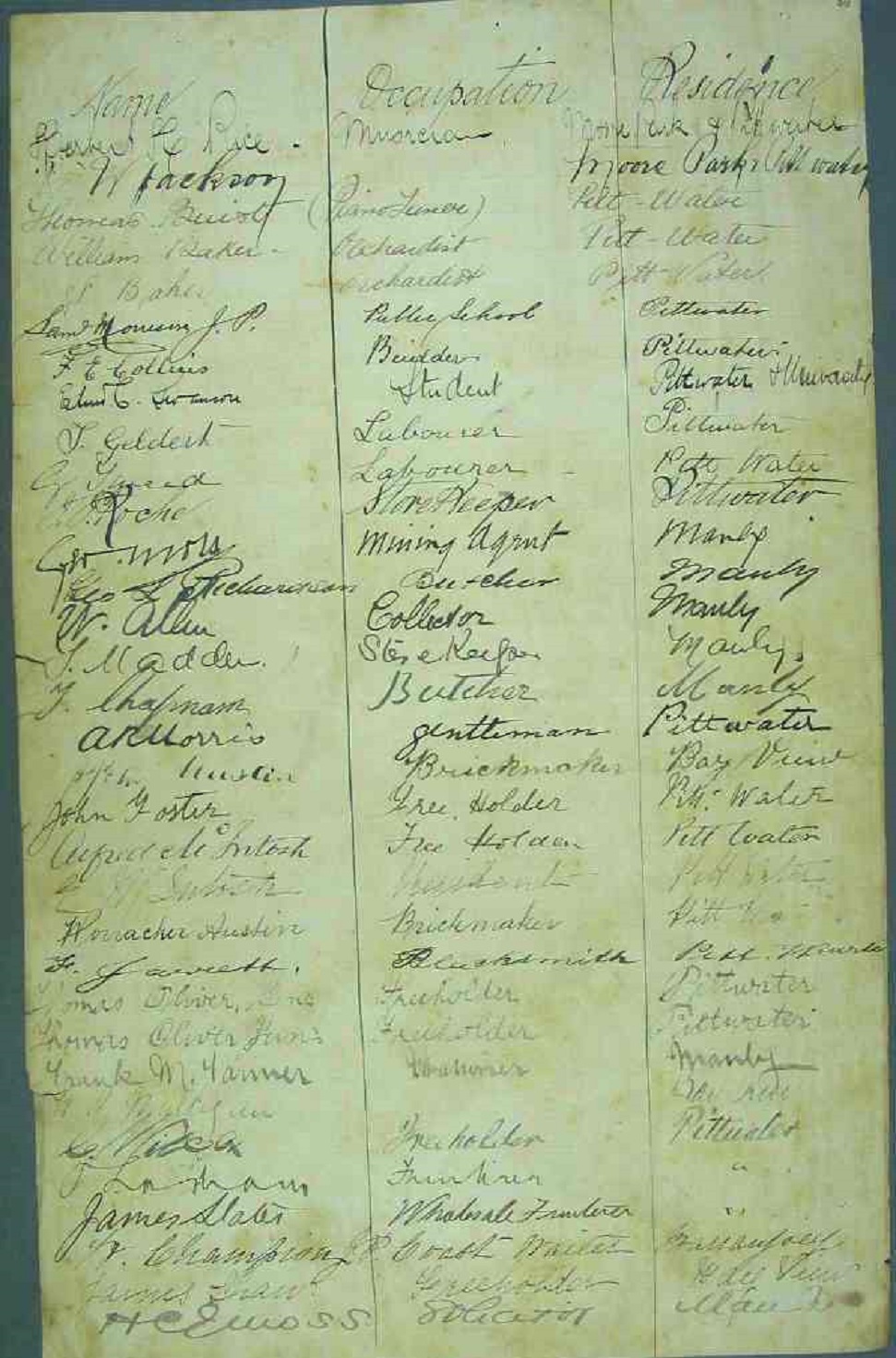
Manchester Unity Independent Order of Oddfellows (MUIOOF) is a fraternal order and was founded in Manchester, England in 1810. Some of its lodges claim histories dating back to the 18th century. These various organisations were set up to protect and care for their members and communities at a time when there was no welfare state or National Health Service. The aim was and still is to provide help to members and communities when they need it. The friendly societies are non-profit mutual organisations owned by their members. All income is passed back to the members in the form of services and benefits. The elimination of the Trade Guilds removed an important form of social and financial support from ordinary working people. In major cities like London, some Guilds (e.g. the "Free Masons" and the "Odd Fellows") survived by adapting their roles to a social support function. Both of these had their base in London, but had established branches (called 'Lodges') across the country. The earliest surviving record of an Oddfellows Lodge is the manuscript of the rules, dated 1748, of the "Loyal Aristarcus Lodge No. 9" which met in inns in the Southwark, Hatton Garden and Smithfield areas of London. Many pubs in Britain are named 'The Oddfellows' or 'Oddfellows Arms', probably because they were once meeting places of Lodges.
NSW BDM's: AUSTIN JOHN 14638/1924 Parents: THOMAS ANN registered at: MANLY
Their children's marriages:
Engaged in China
News was cabled to Mr and Mrs. J. W Austin, of Mona Vale, from their only daughter, Miss Thelma Austin, who is making her fourth trip to Shanghai, that she has become engaged to Mr. Frederic Stoechl, whom she met five years ago on her first trip to China. Miss Austin, who left Sydney by the Changte about a month ago, does not expect to return for some time, for she announced an early marriage in her cable, with a world tour to follow. Engaged in China (1932, June 23). The Sun (Sydney, NSW : 1910 - 1954), p. 29 (FINAL EXTRA). Retrieved from http://nla.gov.au/nla.news-article230118317
MARRIAGES
AUSTIN-HOUSTON. -June 28, 1948, at St. Philip's Church Hill, Doris Humphrey elder daughter of late R F Jenkins and Mrs P V Jenkins of Rose Bay to John Worroker, son of Mr. and Mrs. J W Austin of Bayview. Family Notices (1948, June 30). The Sydney Morning Herald (NSW : 1842 - 1954), p. 20. Retrieved from http://nla.gov.au/nla.news-article18076130
One of the J W Austin's becomes a JP:
Chief Secretary's Department,
Sydney, 12th December, 1933.
HIS Excellency the Governor, with the advice of the Executive Council, has appointed the undermentioned persons to the Commission of the Peace for the State of New South Wales, viz. :
Austin, John Worroker, Darley-street, Mona Vale; … Government Gazette Appointments and Employment (1933, December 12). Government Gazette of the State of New South Wales (Sydney, NSW : 1901 - 2001), p. 4359. Retrieved from http://nla.gov.au/nla.news-article223540988
A Council furore over bad bookkeeping:
CHARGE AGAINST COUNCILLOR
Dismissed at Manly Court.
At the Manly Summons Court yesterday, Mr. May, S.M., dismissed an information against John Warwick Austin, a former councillor and president of Warringah Shire, which alleged that Austin acted as a councillor while subject to a disqualification, under section 31 of the Local Government Act, in that he had received moneys for travelling expenses in excess of the amount to which he was entitled.
Austin, who was represented by Mr. E. R. Mann, pleaded not guilty. Mr. W. A. Windeyer appeared in support of the information.
Mr. Mann, at the conclusion of the evidence for the informant, submitted that there was no case to answer, as no evidence had been given as to how much Austin was entitled to as travelling expenses, the number of meetings he attended, and the meetings he was taken to in other conveyances.
Mr. May said he was not satisfied that the evidence supported the allegations made, and dismissed the information, with £4/13/ costs against the informant.
Mr. Windeyer intimated that there would be an appeal. CHARGE AGAINST COUNCILLOR (1936, May 8). The Sydney Morning Herald (NSW : 1842 - 1954), p. 8. Retrieved from http://nla.gov.au/nla.news-article17330937
Back into brick-making:
MINING FOR SEA-SHELLS
Three applications have been made to the Mines Department for permission to mine for sea-shells In Pittwater. "There is an enormous market for the sea-shells, which are used for making lime and feeding fowls," said Mr. W. S. Gray, of Bellevue Street, North Sydney, who is one of the applicants, yesterday. The mining will be carried out at Church Point, Bay View, and Careel Bay. The president of Warringah Shire Council (Councillor A. H. Hughes), who lives at Bay View, said that a quarter or a mile of electricity cable would have to be run across Bay View beach to the mining machinery. MINING FOR SEA-SHELLS (1937, June 21). The Daily Telegraph (Sydney, NSW : 1931 - 1954), p. 6. Retrieved from http://nla.gov.au/nla.news-article247134535
Department of Mines,
Sydney., 15th July, 1938.
NOTICE is hereby given that the necessary evidence and report with reference to the undermentioned applications for dredging leases having been received, I have determined that leases may be granted of the areas specified therein, subject to the usual and the following conditions:—
(1938-8,536 L.B.)
Sydney No. 207, Walter Sidney Gray, nominee: John Worroker Austin, portion ML 5, county Cumberland, parish Narrabeen, 100 acres, dated 7th October, 1936.
1. The term of the lease shall be twenty years.
2. The lessee shall within nine months of the grant of a lease instal thereon dredging plant valued at not less than £1,000.
3. The lessee shall observe, fulfil and perform the provisions of the Navigation Act, 1901-1935, and any Regulations made thereunder so far as they may be applicable.
4. The lessee shall not conduct any dredging operations within 25 feet of any pile beacon and plant or machinery shall not be moored or placed in such a position as to obscure any such pile beacon.
5. The lessee shall not conduct any dredging operations on Saturdays, Sundays or Public Holidays nor between the hours of 5 p.m. and 7.30 a.m. on other days.
6. The lessee shall so conduct the operations hereby authorised in such a manner as not to cause any interference with shipping.
7. The lessee shall use such anchors only as are approved by the Maritime Services Board of New South Wales and all anchors, mooring posts and any like obstructions shall "be removed immediately after operations are completed in the locality of such anchors, mooring posts or like obstructions.
8. The lessee shall not conduct any dredging operations within 50 feet of any mooring already laid down or any mooring site which has been or which may be allotted by the Maritime Services Board of New South Wales.
9* The lessee shall not conduct any dredging operations within 50 feet of any existing retaining wall or jetty or any retaining wall or jetty which may be constructed in the future.
10. In the event of electric or other cables being connected to the dredging plant from the shore such cables or the piles on which such cables are suspended shall be placed and 'maintained in such a position as not to interfere with navigation.
11. The lessee shall not foul existing channels with grit, sand or mud land shall carry out dredging operations in such a manner to the satisfaction of the Secretary .for Mines as not to cause potholes to be left or not to cause shoaling or erosion.
12. The lessee shall exhibit the uniform dredger signals and the regulation day and night signals on all plants punts and machinery.
13. The Secretary for Mines may, upon written notice to the lessee, prohibit the continuance of dredging operations on any defined part of the area demised if, in the opinion of the said Secretary for Mines, it is desirable in the public interest so to do.
14. The lessee shall so conduct the dredging operations hereby authorised to the satisfaction of the Secretary for Mines as not to interfere with fish life, or with fishermen.
15. The lessee shall at all times permit the holder of and Permissive Occupancy or Special Lease to have free and uninterrupted access to his or their holdings and the lessee shall observe, fulfil and perform any directions of the Secretary for Mines designed to protect the interests of any residents on neighbouring foreshores or any other persons.
16. The lessee shall serve a notice in writing on the Metropolitan Engineer, Department of Works and Local Government immediately after dredging operations have been commenced and shall serve a similar notice immediately after operations have been completed.
17. Dredging operations shall be subject to surveys or inspections by any officer appointed by the Secretary for Mines or the Department of Public Works and Local Government at such times as the said Secretary for Mines or the said Department of Public Works and Local Government may determine, and the cost of such surveys or inspections shall be borne by the lessee.
18. The lessee shall dredge or excavate such material only as shall be necessary to obtain sea shells and shall dispose of any surplus material in a manner satisfactory to the Secretary for Mines.
19. The lessee shall not make any excavation of a greater depth than 10 feet from the present bottom and the sides of any such excavation shall not be of a steeper grade than two in one.
20. The dredging operations hereby authorised shall be conducted in such a manner that the bottom of Careel Bay is not raised above the level easting at the date of this demise.
21. The lessee shall indemnify and keep indemnified the Crown from and against all actions, suits, claims and demands of whatsoever nature and all costs, charges and expenses which may be awarded or brought against the lessee or which the lessee may incur in respect of any accident or injury to any person or property which may arise during the term of the lease through any cause whatsoever, or for any damage which may be consequent upon dredging operations on the leased area notwithstanding that the conditions and covenants contained or referred to in such lease shall in all respects have been observed by the lessee or that any accident or injury shall arise from any act or thing which the lessee may be authorised or compelled to do in respect of the above conditions.
22. The Governor with the advice of the Executive Council may cancel this lease without compensation to the lessee at any time during the currency of the said lease provided that the lessee shall be given not less than twelve months' notice of the intention to cancel such lease. Government Gazette Notices (1938, July 15). Government Gazette of the State of New South Wales (Sydney, NSW : 1901 - 2001), p. 2685. Retrieved from http://nla.gov.au/nla.news-article225066850
Research was unable to determine if this is his son, but it seems probable: Knights Bachelor: John Worroker Austin, of Rose Bay, 1971 In recognition of service to industry.
AUSTIN, Sarah Elizabeth.—March 29, 1949, Sarah Elizabeth, beloved wife of John Worroker Austin, of Fermoy Avenue, Bayview, and loved mother of Thelma and John. For funeral notice see Thursday's "Herald." Family Notices (1949, March 30). The Sydney Morning Herald (NSW : 1842 - 1954), p. 24. Retrieved from http://nla.gov.au/nla.news-article18109040
AUSTIN -Sarah Elizabeth remembered on this day by her loving husband John Worroker and children Thelma and John on the anniversary of her passing away March 29 1949. Family Notices (1950, March 29). The Sydney Morning Herald (NSW : 1842 - 1954), p. 32. Retrieved from http://nla.gov.au/nla.news-article18154106
Death: father and grandson, per NSW BDM’s
AUSTIN JOHN WORROCKER 10412/1956 JOHN SARAH MANLY
AUSTIN JOHN WORROKER 25212/1980 parents: JOHN WORROKER
Prior to William Lambert passing away the lands he held had quite a few cottages or waterside sheds on them that were rented out:
BAYVIEW, Pittwater.— Furnished Cottage, boat, encl. bath, pier. W. Lambert, Bayview. Advertising (1907, October 5). The Daily Telegraph (Sydney, NSW : 1883 - 1930), p. 17. Retrieved from http://nla.gov.au/nla.news-article238252498
BAYVIEW Pittwater-To Let, furn Cottages, from 25s per week. Boating; fishing. Bathing. W. Lambert Harrington, Ivy st. North Sydney. Advertising (1911, September 9). The Sydney Morning Herald (NSW : 1842 - 1954), p. 18. Retrieved from http://nla.gov.au/nla.news-article15272695
PITTWATER.— Furn. Cottages, from 25/ per wk., boat, jetty, enclosed bath. Mrs. Lambert, Bayview. Advertising (1916, November 4). The Daily Telegraph (Sydney, NSW : 1883 - 1930), p. 20. Retrieved from http://nla.gov.au/nla.news-article239424167
William Lambert (1841-1917) was born at Bridgefoot farm, Ripley, Surrey, England on August 1st 1841 to Arthur Lambert and Ann Eager. He married in 1869 Sarah Maria Caitcheon, who had family in New Zealand, migrating to Auckland in 1858, and whose brother worked as a Captain, transporting goods and people back and forth as well as to ports along the eats coast of Australia.
NSW BDMs:
Death LAMBERT WILLIAM 308/1917 Parents: ARTHUR ANN SYDNEY
Marriage:
196/1869 LAMBERT WILLIAM CAITCHEON SARAH M SYDNEY
Children:
LAMBERT LILIAN J 2219/1869 WILLIAM SARAH M SYDNEY
LAMBERT FREDERICK E 1524/1871 WILLIAM SARAH M SYDNEY
LAMBERT ELIZABETH ANNIE 1651/1873 WILLIAM SARAH M SYDNEY
LAMBERT SAMANTHA D 1991/1884 WILLIAM D SARAH SYDNEY
PAUL-LAMBERT. -On February 9, 1908, at Presbyterian Church, Crow's Nest, North Sydney, by Rev. W. H. Ash, Charles James, only son of the late William James Paul, of Sydney, to Elizabeth Annie, youngest daughter of William Lambert, of Bayview, Pittwater. Family Notices (1908, February 29). The Sydney Morning Herald (NSW : 1842 - 1954), p. 12. Retrieved from http://nla.gov.au/nla.news-article14934311
Lilian’s marriage: 3965/1899 DIBDEN SIDNEY T LAMBERT LILIAN J NEWTOWN
SILVER WEDDINGS.
DIBDEN-LAMBERT -June 7, 1899, at Christ Church Enmore, by the Rev Charles Dunstan, Sidney T., youngest son of the late Frederick E. Dibden, of North Sydney, to Lilian J., daughter of the late William Lambert, of Bayview, via Manly. Present address Ottery, Carlyle-street, Wollstonecraft. Family Notices (1924, June 14). The Sydney Morning Herald (NSW : 1842 - 1954), p. 14. Retrieved from http://nla.gov.au/nla.news-article16135539
Born in Sydney, New South Wales, in 1871 to William Lambert and Sarah Maria (nee Caitcheon), Frederick Eager Lambert married Mabel Mildred Smith and had 3 children. He passed away in 1945 in Canterbury, Sydney.
William Lambert died as a result of wounds after being struck by a car:
LAMBERT.— Mr. William Lambert, of Pittwater Sydney, died on Friday night last as a result of injuries he received in an accident on February 27th, when he was knocked down by a motor car while returning from a philharmonic practice. Mr. Lambert who has resided for over fifty years in New South Wales was formerly an inspector in the tramway department, but retired some years ago, and took up orcharding for some years. He was seventy-five years of age. PASSING OF THE PIONEERS. (1917, March 13). The Farmer and Settler (Sydney, NSW : 1906 - 1955), p. 4. Retrieved from http://nla.gov.au/nla.news-article116638006
Fatal Motor Accident
William Lambert, aged 75, of Bayview, Pittwater, who was knocked down by a motor car in Oxford-street, Darlinghurst on the night of February 27, died In Sydney Hospital yesterday. Lambert was running across the street when the car struck him, one of the wheels passing over his legs. Fatal Motor Accident (1917, March 10). The Sun (Sydney, NSW : 1910 - 1954), p. 7. Retrieved from http://nla.gov.au/nla.news-article221960697
CASUALTIES.
William Lambert (75), who resided at Pittwater, on the 27th of last month was knocked down by a motor car while crossing Oxford Street near Dowling-street. He was removed to St Vincents Hospital, where he died yesterday. CASUALTIES. (1917, March 12). The Sydney Morning Herald (NSW : 1842 - 1954), p. 8. Retrieved from http://nla.gov.au/nla.news-article15723884
LAMBERT.—March 9th, 1917, at St. Vincent's Hospital, William dearly loved husband of Sarah Maria Lambert of Leyland Parade, Belmore, aged 75 years. Home and New Zealand papers please copy.
LAMBERT-—9th March, at St. Vincent's Hospital, William Lambert, beloved father of Mr. and Mrs. Sid Dibden of Bungendore, and late of Wollstonecraft (result of motor-car accident). Family Notices (1917, March 10). The Daily Telegraph (Sydney, NSW : 1883 - 1930), p. 8. Retrieved from http://nla.gov.au/nla.news-article239228447
LAMBERT. —March 9, at St. Vincent' s Hospital, William Lambert, late of Ripley, Bayview, Pittwater, in his 75th year. Late of Tramway Department, and for many years a member of the Sydney Philharmonic Soc. Interred at Rookwood March 10. Family Notices (1917, March 12). The Sydney Morning Herald (NSW : 1842 - 1954), p. 6. Retrieved from http://nla.gov.au/nla.news-article15723833
Some places Mr. Lambert's sailing and philharmonic, and works to advance Pittwater are recorded:
Philharmonic Society.
The annual meeting of the Sydney Philharmonic Society was held in the High School, Castlereagh-street, on Thursday evening. There was a large attendance, and Mr. H. Gorman (vice-president) occupied the chair. After some of the rules had been amended, the report was read, and showed that the chorus now numbered 359 members. The thanks of the society were due to the conductor, Signor Hazon, to whose unremitting care and attention so large a proportion of the musical success was due. The balance-sheet showed that although there was a credit balance of £3183 0s 9d at the bank, there were outstanding accounts to the amount of £232 0s 6d. A statement of the liabilities and assets showed a credit : balance of .£51 0s 3d. On the motion of the chairman, who complimented the society on the success of the last season, the report and balance sheet were adopted. The following officers were elected: President, Alderman Manning (Mayor of Sydney) ; vice-presidents, Messrs. H. Gorman and T. Pope; hon. secretary, Mr. William Briggs; hon. treasurer, Mr. W. B. Scott ; hon. librarian, Mr. H- W. S. Crammer ; -hon. assistant librarian, Mr. J. S. Huthnance; committee, Messrs. James Anderson, E. E. Boissier, W. Lambert, J. J. Lowden, R. JB. Treacy, and Dr. Laure. Philharmonic Society. (1891, May 29). Evening News (Sydney, NSW : 1869 - 1931), p. 5. Retrieved from http://nla.gov.au/nla.news-article113883465
PITTWATER REGATTA
A Successful Function
A great crowd of people assembled at the annual Pittwater Regatta, which was held off Scotland Island yesterday. This year's function was most successful, and the executive officers, led by Mr. Jack Roche, as one of the Hon, secretaries, are to be complimented upon the display. The regatta officials were:— Sailing: Starters, J. Cronin, S. J. Keegan; judge, F. J. Donovan; timekeepers, D. Henry, L. Gibbons; umpire, A -Martin; handicappers, J. Barrett, A. Huntley, J.Roche. Rowings Starter, C. J. Atkinson; timekeeper, J. Ellison: judge, B. Cormack; umpire, -A. L. Davis; handicappers, W. Boulton, E. J. Miles, D. Boulton; hon. treasurer, S. Greig; hon. secretaries, Miss G. Lloyd, Mrs. S. Greig, John Roche. Motor Launches: Handicappers. Messrs-J. Williams, jun., IC. Taylor, J. Booth; committee, Miss G. Lloyd, Mrs. S. Greig, John Williams, jun.. J. Booth, W. Boulton , A Huntley, S. Greig, W. Lambert, J. Barrett, J. Roche. Mr. N. H. Murray was commodore of the day.
The results were: — 14ft. to ISft. Boats.— Dorothy (C. J. Saunders), 6min., 1; Dauntless (W. Boulton), 7jmin, 2; Lameroo (C. Trouton), 32min., 3, 14ft. to. 18ft. Boats (Pittwater boats only). —Elsie (E. Wilson,) Grnin., 1; Gertie (J. B. Nlcol), Smin., 2; .Weary Willie (IC. Taylor); 9mln„ 3. 16ft. -Skiffs.— Cornstalk ,(J. iB -Moffatt), eer., 1; Amanda (iC. Stewart), 4mln, 2; Mat (W. Riddle), 4mln., 3. Boats 16ft. to 34ft.— Erl King (D. Taylor); » n., 1; Millie (J. Latta), scr., 2; Petrel (K. Wilson), Smin., 3. . Boys' Single Sculls.— A'. Peters, scr., lr T« Hordern, scr., 2. Ladles' Single Sculls.— Miss T. Erlelcson, lOsec., 1; Mrs. W. J. Oliver; ser., 2; Miss G-Lloyd, 5sec„ 3. Gentlemen's Double Sculis.— J.: Bulo and J Malone, ser., 1; E. Devlin and C. Morris, 12sec., 2; C. J. Kuhlmorgen and E, Sykes, 15sec„ - 3. Youths' Single Sculls .Handicap.-J, Sutton, scr., 1; C. Devlin, 5sec„ 2. Ladies and Gents.' Double Sculls.-— Mr. and Miss T. Erlckson, 4see„ 1; Mr. E. and Miss L. Devlin, Gee.. 2: Mr. C. J. Kuhlmorgen and Miss E. Sykes, 15sec., 3. _ Gentlemen's Single Sculls.— J.V Malone, usee., 1; J,Bule, scr., 2; F. Douglass, 12sec., Ladies Double Sculls!— Mrs. W. T. Olives and Mrs. X Holding, scratch, 1; Misses G Lloyd and T. Erickson, scratch, 2. 1' Old Buffers' Single Sculls Handicap. — Devlin, scrat'di, 1. Motor Launch Handicap '(Pittwater boats-only). — Bangala (J. Newmarch), 2Sradn.Fairbanks (J. Barrett), 4min., 2; Greebank(K Bennett), scratch, 3. Open Motor Launch; Handicap:— Waterwitch (R. A. Hollingdale), amSia., Mr Fairbanks- (J. Barrett), 4min., 2t Tih6ambelEj(iRaS« sell Sirrola'lr), 4min.,. 3. min im PITTWATER REGATTA (1909, January 17). The Sunday Sun (Sydney, NSW : 1903 - 1910), p. 3. Retrieved from http://nla.gov.au/nla.news-article227026562
MANLY-PITTWATER TRAM.
DEPUTATION TO VISIT THE MINISTER.
Speaking at the annual general meeting of the Manly to Pittwater Tramway League, Dr. Arthur, MLC stated that the Brookvale line would be extended to Pittwater. The Government's intention was to electrify all the tramways, including one to Pittwater. This would cost £8000 or £10,000 a mile, and would necessitate reference to the Public Works Committee... should endeavor to escape this reference, and he suggested that the league should approach the Minister with a view to having the Narrabeen section carried out at a cost reduced to under £20,000. They could afterwards agitate for further extension. The suggestion did not meet with approval, and a resolution was carried that It would be advisable to claim for the extension of the tram from Brookvale to Manly-it in ... before the Public Works Committee.
Messrs. Lambert, Williams, Ridge, Quirk, and Powell were appointed as a deputation to wait on the Minuter. The following officers were elected;— Patrons, Mr. Duguld Thomson and Dr. Arthur. M.L.A.; president, Mr. Kartell; vice-presidents; Messrs. G. S. Brock, J. P. Wright, A. Crane, S. C. Sadler. G. Ridgce, H. F. Hallloran, W. Smith, P. J. Carew, Markham, Arthur West, E. Trevor Jones, Arthur Rickard, R. Reid, W. Bremer, Loden, A. B. Shand. Gordon, Gibbons, Hayne, J. W. Williams, Briquet, Blackwood, J. Booth, and Struman; executive committee, Messrs. W. Parker, sen.. Jamieson, Keirle, Dames, J. Collins, Tate, M Lean, J. Austin, Lambert, M. Burke, Hope, Criten, J. Duffy, W. Austin, jun., G. Woollett, Large, J. Sykes. W Boulton, L. Scott, Aldridge, Huntley, Baker, and Hewitt: hon. secretary. Mr. S. L. Ridge; hon. treasurer, Mr. Lambert. MANLY-PITTWATER TRAM. (1910, March 11). The Daily Telegraph (Sydney, NSW : 1883 - 1930), p. 4. Retrieved from http://nla.gov.au/nla.news-article238361831
AQUATICS.
PITTWATER PICNIC REGATTA
The seventh annual Pittwater picnic regatta was held successfully on Saturday. Though showers fell in the morning, the afternoon was an ideal one for the sport. There was a large attendance, and the flagship, Erringhi, was laden with a full complement of patrons. Almost every point of vantage on land was occupied, motor launches from Bayview, Church Point, and Newport wharfs conveyed passengers to the flagship.
Mr. F. J. S. Young was commodore, and the following were the officials:-Sailing: Starter, 31 r. S. J. Kee-ra» : judge, Mr. F. S. Adams; timekeeper, Mr. T. J. Mulhall; umpire, Mr. H. J. Perkins: handicappers, Messrs. W. Honiton, II .1. Miles, and John Roche. Rowing events: Starter, Mr. Ii. Cormack; judge, 3fr. C. llawksford; timekeeper, Mr. C. .1. Atkinson: umpire, Mr. A. Davis; timekeeper, .Mr. C. .1. Atkinson; umpire li. .1. Miles, ,1. .VI. simpson. Motor bout events. Starter, Mr. S. .1. Keegan.
The- All Yachts Handicap was the principal linn, and although only four entries were received great Interest was centred in the race, which was won by Petrel (Skipper W. D. M. Taylor) by im ib. The second prire Went to Raw-hill (her,), which Just got up in time to beat Aoma (2-liu) by a second. The contest was most exciting. Tile Tlii-lnui was a long way back fourth. 4
After the regatta a public dinner was held at Grieg's Newport Hotel, at which Mr. J. Willimill presided. Subsequently a continental took place In the grounds adjoining the hotel, where the prizes won at the regatta were handed over by Colonel Ryrie.
Allcomers' Yachts Handicap, under the auspices of the Royal Sydney Yacht Squadron and Royal Prince Alfred Yacht Club. First prize, ... Petrel (Skipper, W. D. M. Taylor),-17m . 1 Rawhiti (E. Sayers), scr. J Aoma (C. Fleming), 'Jim .'..i,. 3 Thelma (C. Lloyd),
All got away well to their respective ... round Lion Island,... Single Sculls Handicap, for boys, 10 years and under, ... Boys' Single Sculls aged years and under... Ladies Single Sculls ....Youths' Single Sculls Handicap, 18 years and under, Men's. Double Sculls ....Old Buffers' Single Sculls...Ladies' Double Sculls...,Men's Single Sculls Handicap,...Motor Launch (Iocal boats only), 8 miles. First prize, £2: second, .... Allcomers' Motor Boat Handicap, distance 8 miles. First prize,Gattling Ger (E. J. Miles), 1; Elsie (W. Lambert) 2. AQUATICS. (1913, January 6). The Sydney Morning Herald (NSW : 1842 - 1954), p. 7. Retrieved from http://nla.gov.au/nla.news-article15388274
A few years later his land at Bayview was divided into 'farm-sized' blocks and offered for sale:
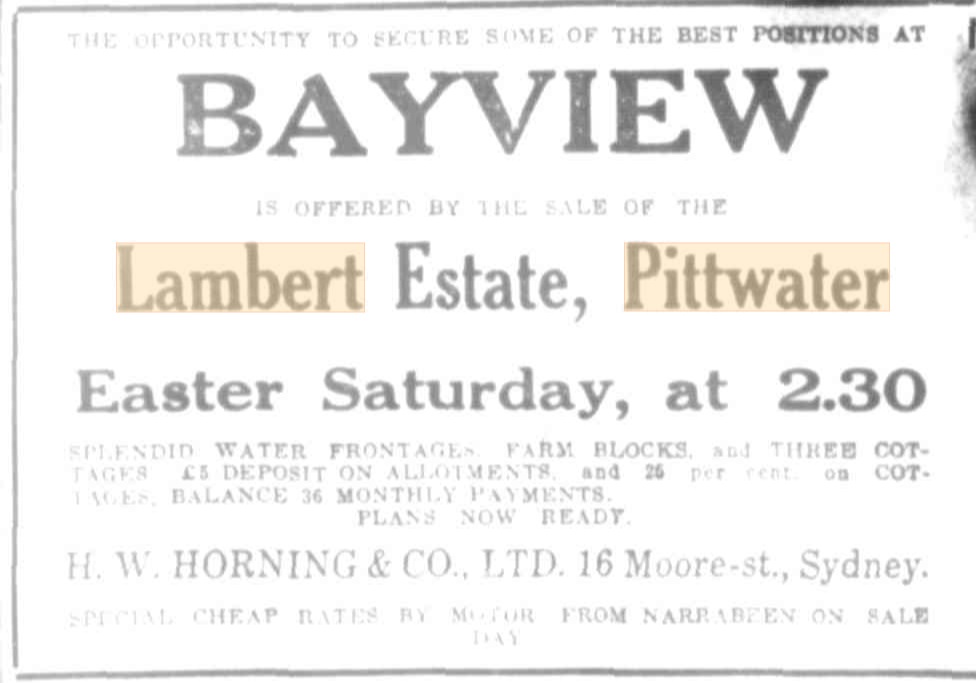
Advertising (1919, April 2). Evening News (Sydney, NSW : 1869 - 1931), p. 6. Retrieved from http://nla.gov.au/nla.news-article120840299
Messrs. H. W. Horning and Co. have a sale this afternoon at Bayview, Pittwater, where the Lambert Estate will come under the hammer. REAL ESTATE. (1919, April 19). The Sydney Morning Herald (NSW : 1842 - 1954), p. 7. Retrieved from http://nla.gov.au/nla.news-article28098021
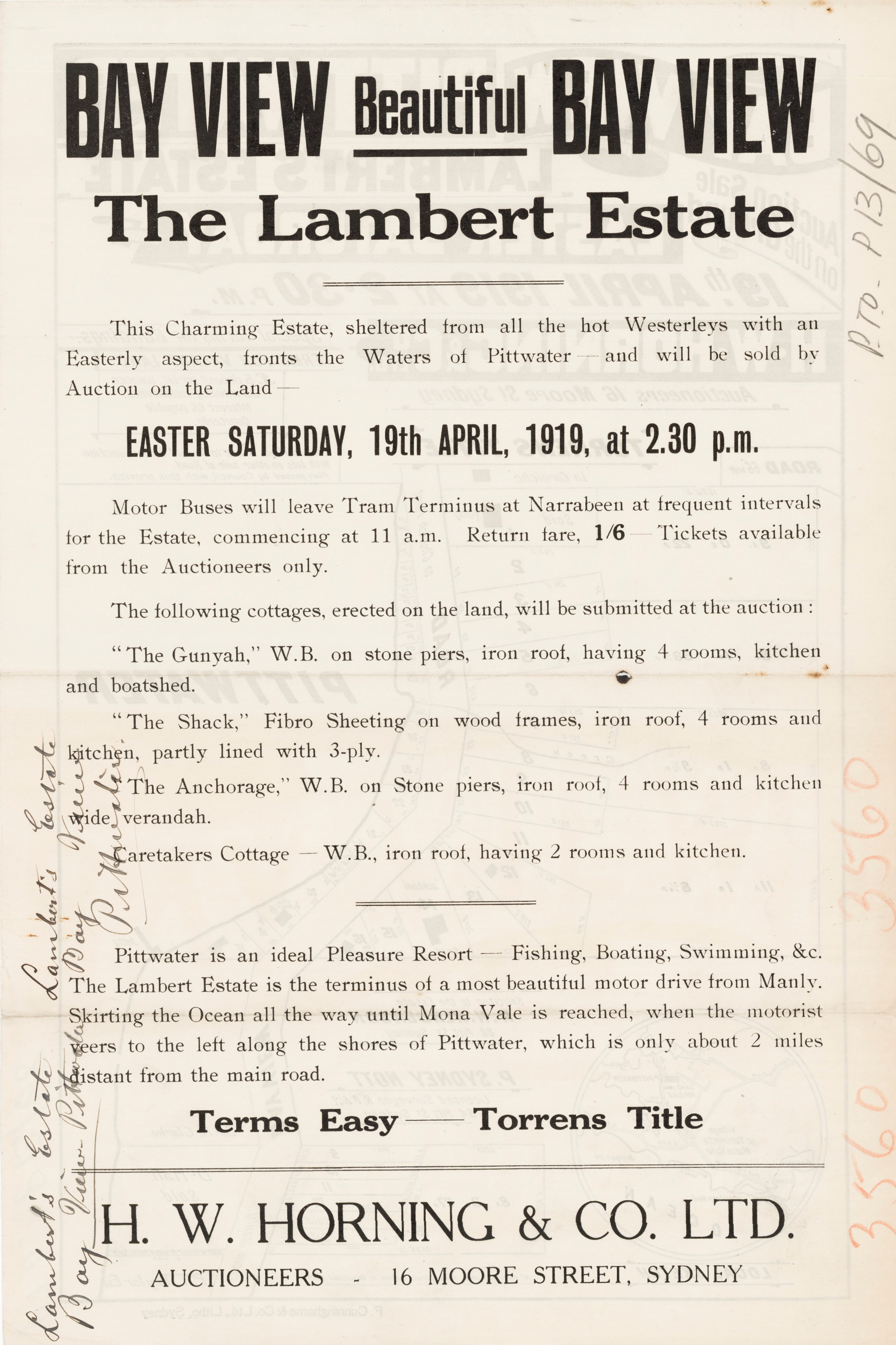
Lamberts estate Bayview 1919 - Item c053460073, Bayview subdivisions folder, courtesy State Library of NSW
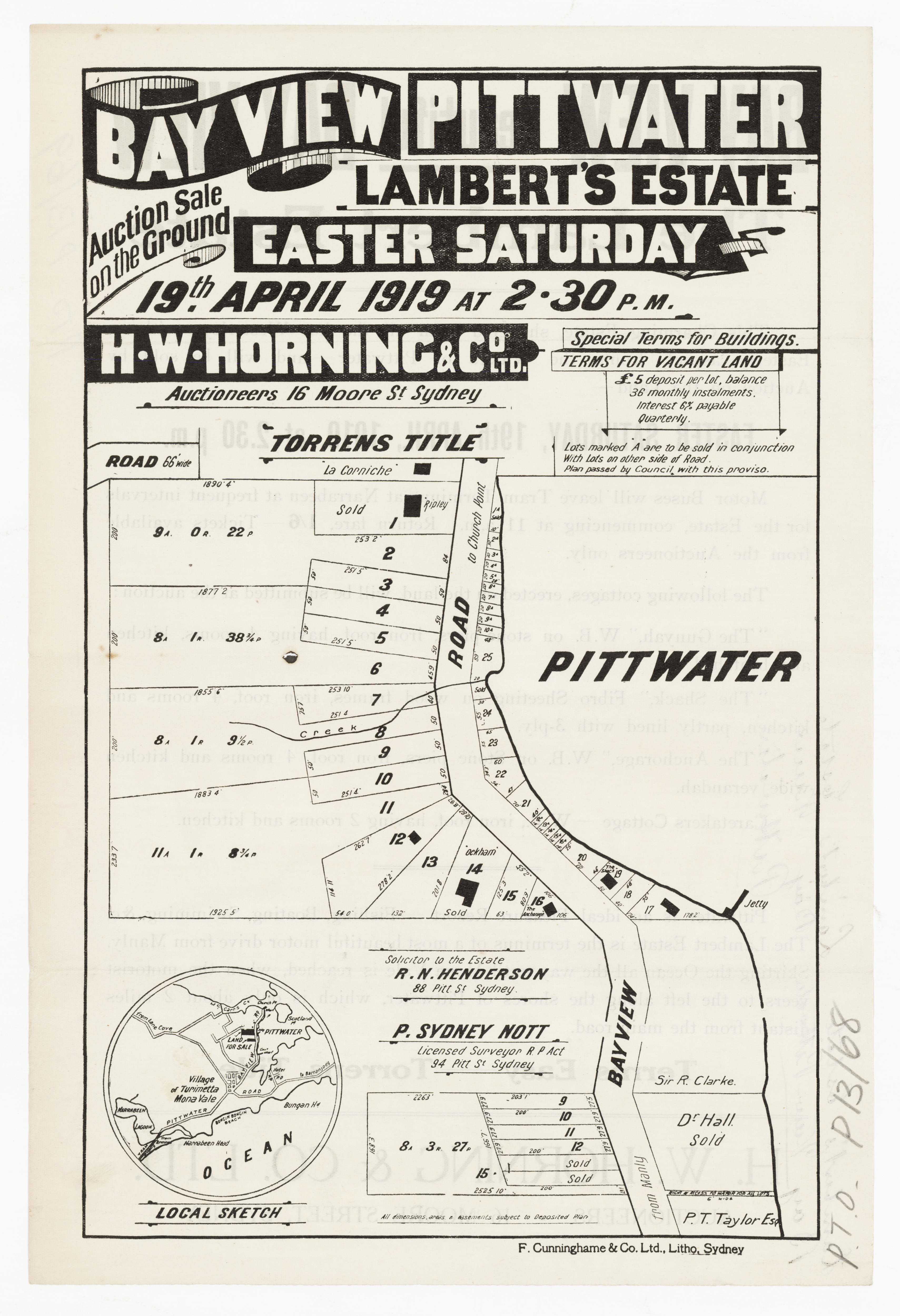
Lamberts estate Bayview 1919 - Item c053460072, Bayview subdivisions folder, courtesy State Library of NSW
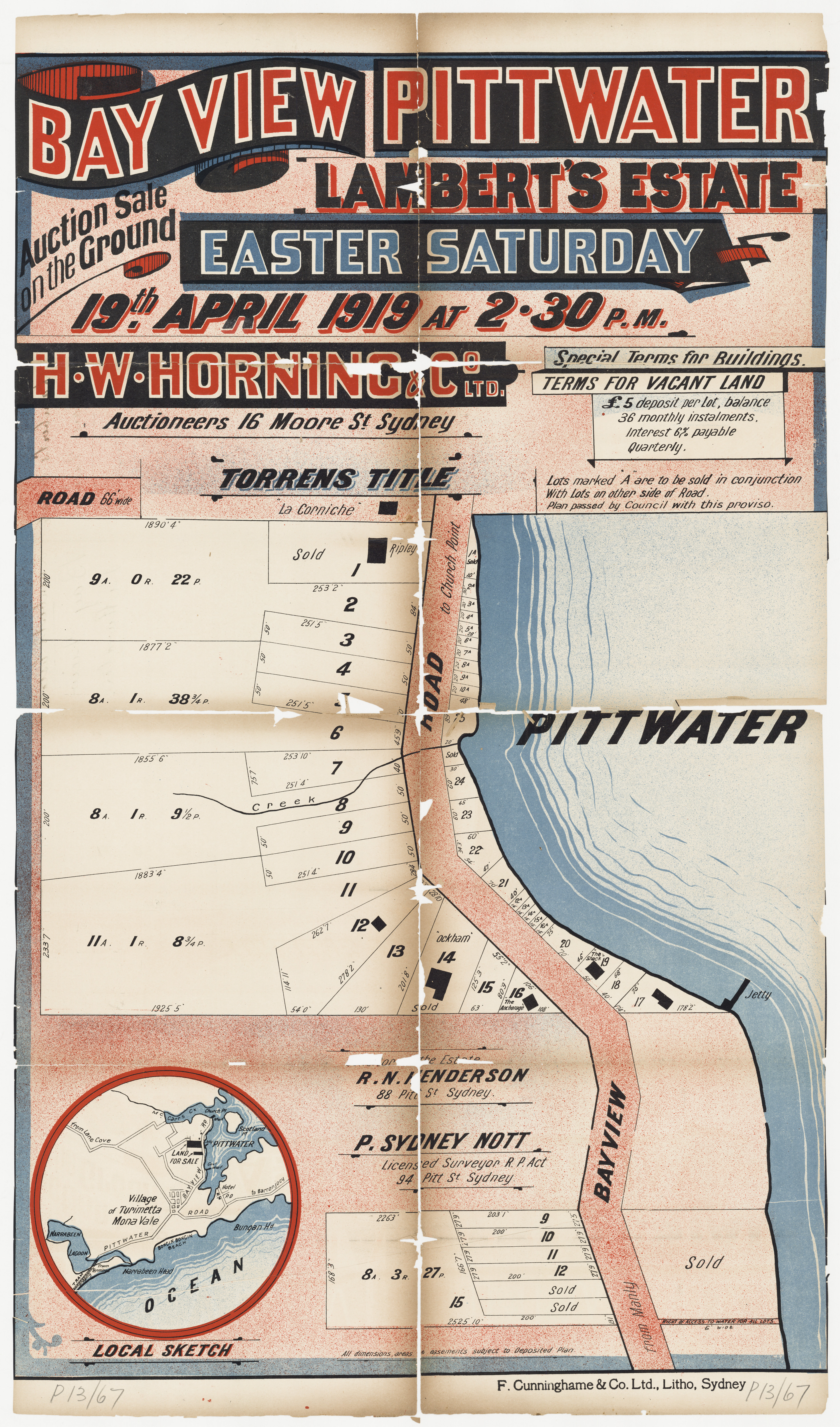
Lamberts estate Bayview 1919 - Item c053460071, Bayview subdivisions folder, courtesy State Library of NSW
Hardie and Gorman, Ltd., this week sold a cottage at Bayview, Pittwater, with 20 acres of land, for £1000 …. and seven lots of the Lambert's Estate, Bayview, £1460… REAL ESTATE. (1919, May 3). The Sydney Morning Herald (NSW : 1842 - 1954), p. 7. Retrieved from http://nla.gov.au/nla.news-article15837039
REAL PROPERTY ACT.
Notice of Intended Registration of Notice of Death.
AND TRANSFER WITHOUT PRODUCTION OF THE DUPLICATE of a Mortgage.
In the matter of the mortgage No. 129,165, dated 1st December, 1887, James Symonds to William Lambert, over the whole of the land comprised in Certificate of Title, Vol. 634, Fol. 121, being 10 acres 3 roods 6 perches or thereabout, lot 4, at Pittwater, parish Narrabeen, county Cumberland.
NOTICE is hereby given of the intention of the Registrar-General to register a transmission of the estate of the said William Lambert, the said mortgagee, to Lilian Jessie Dibden and Elizabeth Annie Paul, also a transfer of the untransferred balance of the said land from the said Lilian Jessie Dibden and Elizabeth Annie Paul to Sir Rupert Turner Havelock Clarke, after the expiration of twenty-one days from the date hereof, without production of the duplicate of the mortgage, reasonable cause having been shown, pursuant to section 33 of the abovenamed Act. All information respecting the above may be obtained at the Land Titles Office, Sydney.
W. G. R-WILLAMS,
7th May, 1920. Registrar-General. Private Advertisements. REAL PROPERTY ACT. (1920, May 7). Government Gazette of the State of New South Wales (Sydney, NSW : 1901 - 2001), p. 2781. Retrieved from http://nla.gov.au/nla.news-article222080416
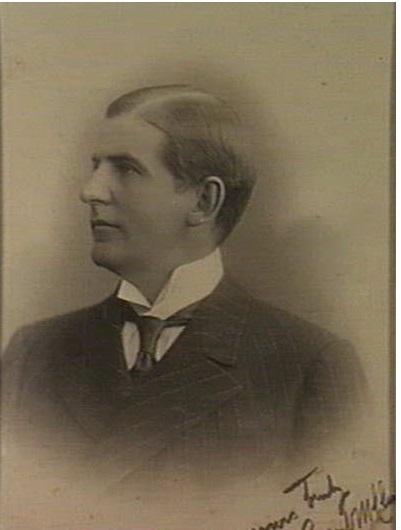 Sir Rupert Turner Havelock Clarke (1865-1926) was a son of Sir William John Clarke. Born on 16th of March 1865 at Rupertswood, Sunbury, Victoria, eldest son of Sir William and his first wife Mary, née Walker, he was educated at Hawthorn Grammar School, Wesley College, Melbourne, and Magdalen College, Oxford, but took no degree.
Sir Rupert Turner Havelock Clarke (1865-1926) was a son of Sir William John Clarke. Born on 16th of March 1865 at Rupertswood, Sunbury, Victoria, eldest son of Sir William and his first wife Mary, née Walker, he was educated at Hawthorn Grammar School, Wesley College, Melbourne, and Magdalen College, Oxford, but took no degree.
In 1891 he leased his father's Cobran station, near Deniliquin, New South Wales, and later inherited the Sunbury properties of Bolinda Vale, Red Rock and Rockbank, totalling some 130,000 acres (52,608 ha). He sold these over a period, except for a reduced holding at Bolinda Vale and 800 acres (324 ha) near Rupertswood named Kismet Park, on which he built a house. Rupert successfully carried on his father's stud of English Leicester sheep and Derrimut Shorthorn cattle. As his holdings in Victoria diminished, he developed pastoral and other interests elsewhere, notably in Queensland, where he later owned Isis Downs in partnership with R. S. Whiting.
Photo: Rupert Turner Havelock Clarke (1865-1926), by unknown photographer, c1905. La Trobe Picture Collection, State Library of Victoria, H41976/8
Succeeding to the baronetcy on his father's death in May 1897, Rupert followed him into the Legislative Council of Victoria as member for Southern Province, retaining the seat until 1904. Rupert took his father's place as governor of the Colonial Bank of Australia and had other business interests over the next thirty years, not all successful, included a rabbit cannery and a butter factory at Sunbury, gold-mining at Coolgardie, Western Australia, in 1895, banana and peanut farming, and a rubber and coconut plantation (also with R. S. Whiting) in Papua. In 1914 he financed and led an expedition up the Fly River in his yacht Kismet. In the early 1900s with John Gunn and Clyde Meynell he leased the Theatre Royal, Melbourne, and the Criterion, Sydney; in July 1911 Clarke and Meynell amalgamated with J. C. Williamson Ltd, and Clarke became a director of the company.
Rupert had served in his father's Rupertswood Battery of horse artillery. At the outbreak of World War I he went to England and was commissioned a lieutenant in the (British) Army Service Corps in 1915; he served at Salonica, Greece, and was invalided out in 1917. Biographers state he was an excellent horseman, and horses which he owned won the Victoria Derby, Oaks and Caulfield Cup, although the Melbourne Cup eluded him, and that he was also a first-class shot.
On 22 December 1886 he had married Amy Mary (later 'Aimée'), daughter of pastoralist Thomas Cumming. They had two daughters. The marriage ended in divorce in 1909 and on November 6th 1918 in Sydney he married 22-year-old Elsie (later Elise) Florence Tucker; by her he had two sons and a daughter. Apart from his country properties and 12 Bank Place, Melbourne, Clarke owned several houses in Sydney, two in England (Brockwood Park, Alresford, Hampshire; and Old Place, Sussex) and a villa in Monte Carlo, where he died on December 25th 1926.
One holiday home near this area may be read about in Pittwater Summer Houses: Waiwera - Hopton Lodge, Bayview.
REAL ESTATE AUCTION SALES.
BAYVIEW. PITTWATER.
Convenient to NEWPORT.
And adjoining the week-end homes of Sydney Stone, Esq., C. J. Saunders, and near Sir Rupert Clarke's.
WAIWERA, Charming Water Frontage property, having about 93ft to the Bay, 102ft 6in to the Main Road, by a depth of 826ft 8in on one side and 307ft 6in on the other.
A WELL-BUILT BRICK COTTAGE, having wide verandahs at front, side, and rear, and containing drawing room, dining-room, five (5) bedrooms, kitchen, laundry, bathroom; two garages, and caretaker's
cottage.' *
Ample water supply, Septic Tank, Air Gas Tank.
Jetty, Boatshed, and Bathing Shed
The property occupies the finest position in this popular Resort, with an outlook extending to Lion Island, and commanding a full view of the Regatta Course.
TORRENS TITLE.
RICHARDSON and WRENCH, LTD.. will offer the above Property at PUBLIC AUCTION, in the Rooms, 92 Pitt-street, on FRIDAY, 21st NOVEMBER, at 11 a.m. Advertising (1924, November 12). The Sydney Morning Herald (NSW : 1842 - 1954), p. 18. Retrieved from http://nla.gov.au/nla.news-article16178492
PITTWATER, BEAUTIFUL PITTWATER.
*- BEACH FRONTAGE.
Splendid Week-end Bungalow.
With 3 blocks of land.
Fully Furnished. Torrens.
Can accept £850. Worth double.
_ _ Inspections arranged.
H. W. HORNING and CO., LTD.. 80 Martin-place. Advertising (1924, September 29). The Sydney Morning Herald (NSW : 1842 - 1954), p. 14. Retrieved from http://nla.gov.au/nla.news-article16178732
TO YACHTING MEN AND OTHERS,
Pittwater
PITTWATER. IN A PICKED POSITION
PITTWATER AT BAYVIFAV.
Commanding Beautiful Panoramic Views of Broken Bay,
"LYNTON," BAYVIEW ROAD.
WEATHERBOARD BUNGALOW, Iron roof, on stone piers. FRONT VERANDAH, 33 x 12.
Hall, dining-room, with Inglenook and casement windows, overlooking the Bay. Breakfast-room and three bedrooms, bathroom with heater. Kitchen and laundry. Back verandah concrete floor. 2 x 600 gallon tanks, 1 x 1000 gallons. METTERS' WINDMILL pumps water from well to tanks.
WEATHERBOARD GARAGE, BOATSHED, JETTY, AND LAUNCH.
TELEPHONE, WIZARD GAS PLANT.
FLOWER AND VEGETABLE GARDENS AND FRUIT TREES.
The Land has a frontage of 106 foot 6 ¾ Inches to Bayview Road by a depth on one side
of 201 feet 8 Inches and 125 feet on the other, with a back lino of 90 feet 6 ¾ Inches, and 33 feet to WATER FRONT opposite, by a depth of 80 feet.
TORRENS TITLE.
The Property will be offered first in one line. Including WATER FRONTAGE, and if not sold will then be offered separately.
SHARPE AND SON, LIMITED. will sell the above Property by PUBLIC AUCTION, at the Rooms, 107 PITT STREET (near Hunter Street), WEDNESDAY, 17th MARCH, 11.30 A.M. Advertising (1926, March 13). The Daily Telegraph (Sydney, NSW : 1883 - 1930), p. 11. Retrieved from http://nla.gov.au/nla.news-article245845109
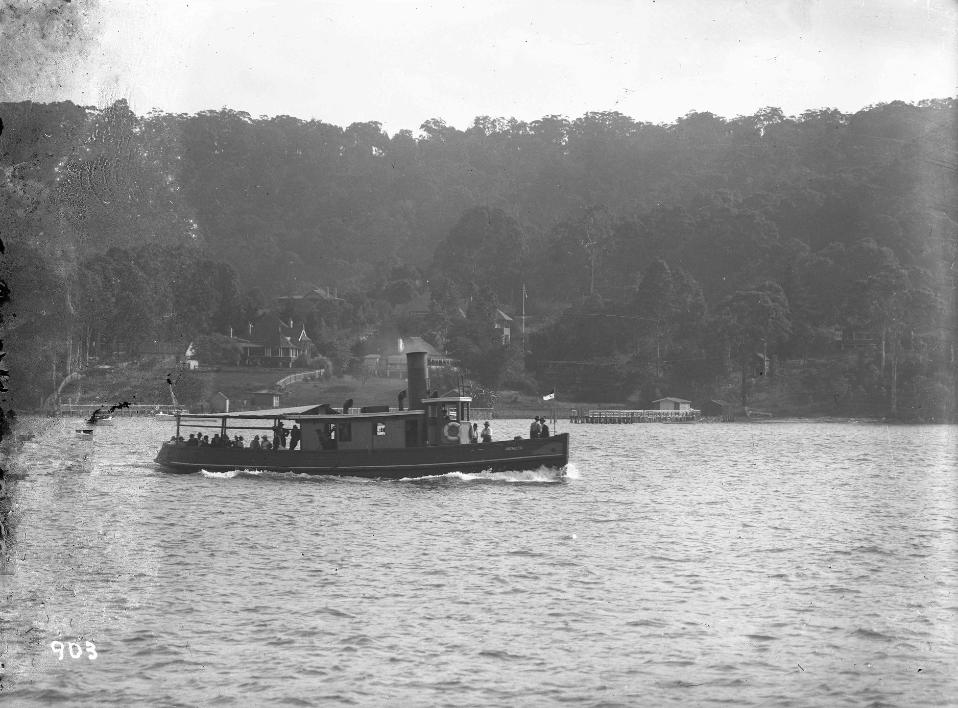
Tugboat ANTARCTIC during the 1924 Pittwater Regatta, courtesy Australian National Maritime Museum, Image no.: 10670, photo taken by William J Hall or his father William Frederick Hall - Waiwera in its 1924 form is in the background
Margaret Tink kindly provided some insights into this place from when her family owned this holiday home:
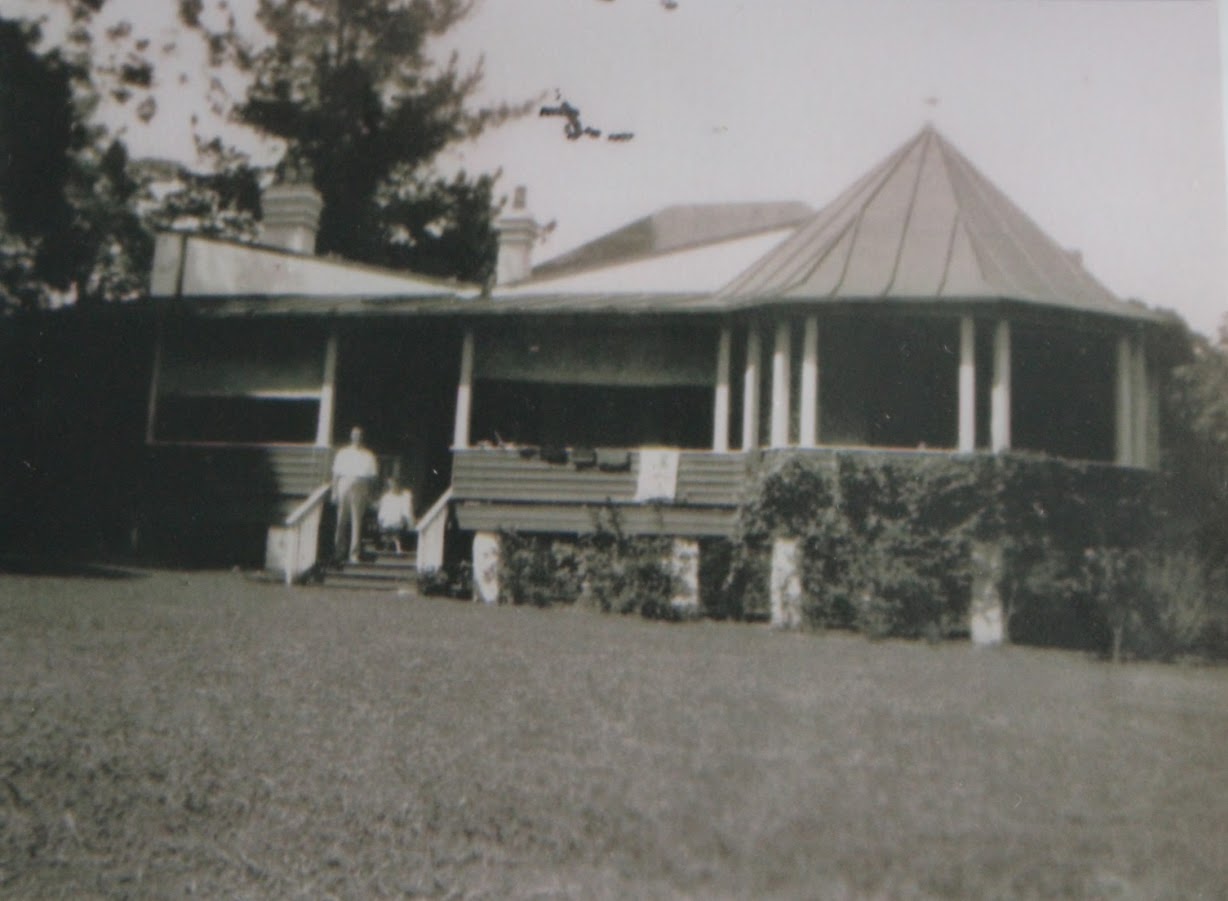
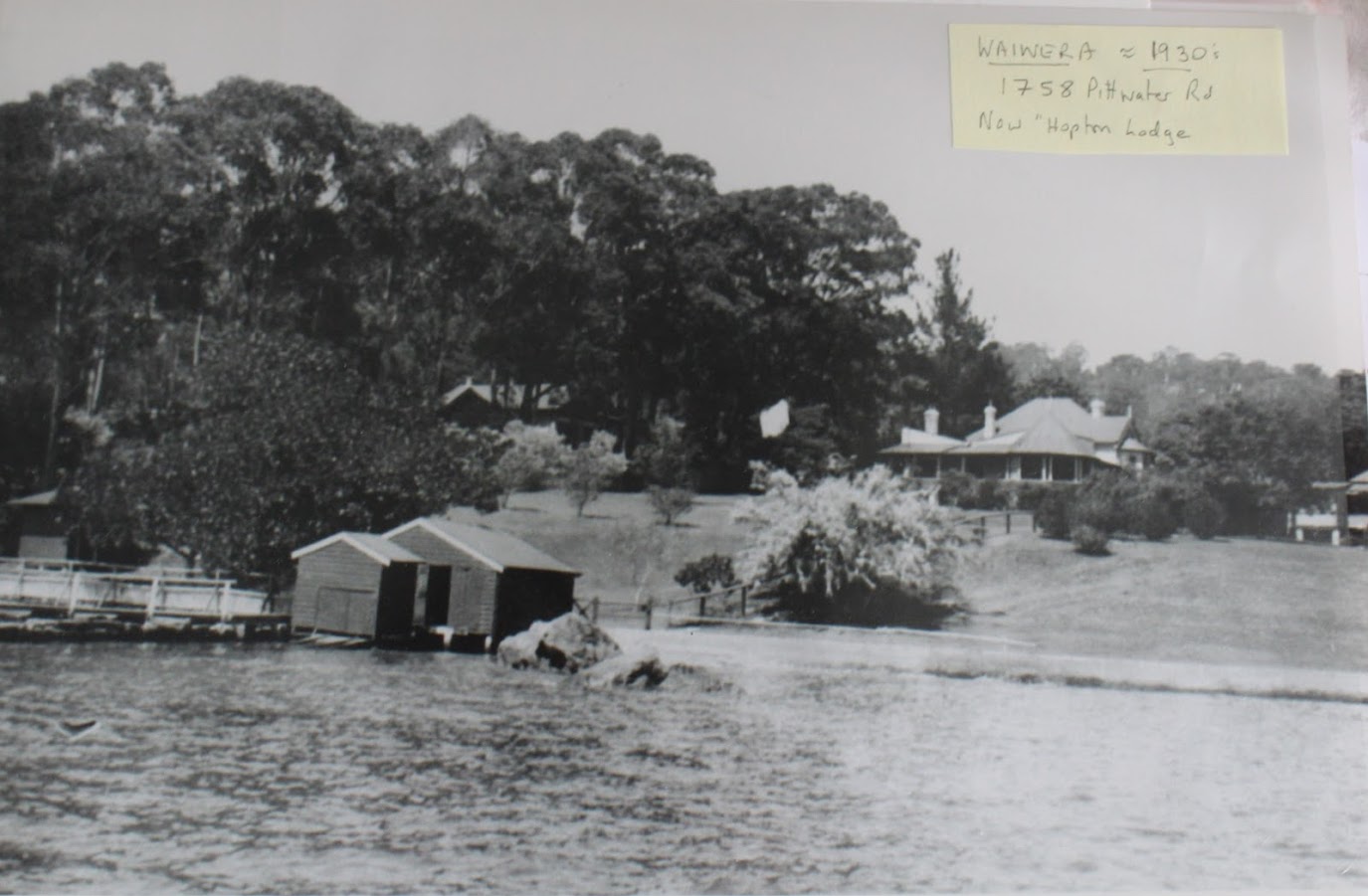
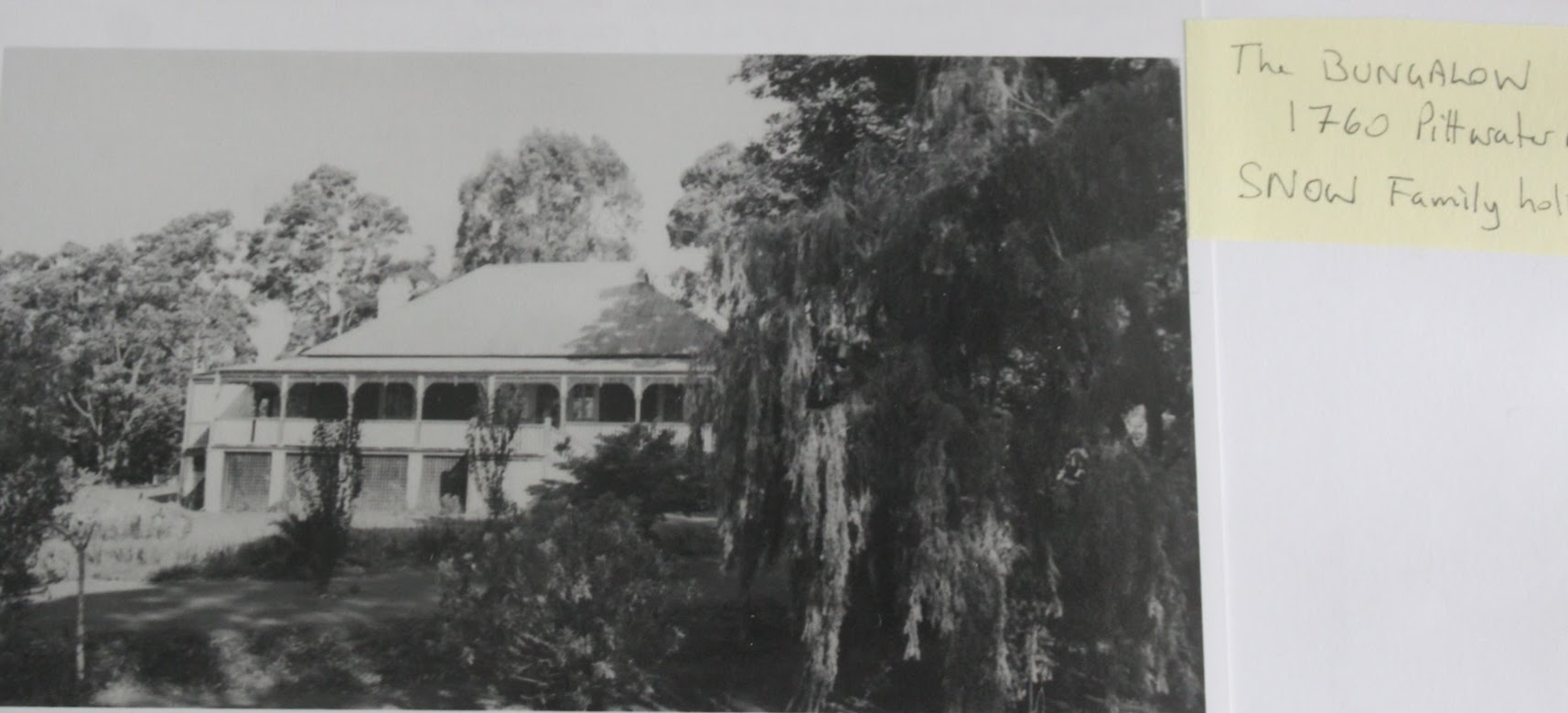
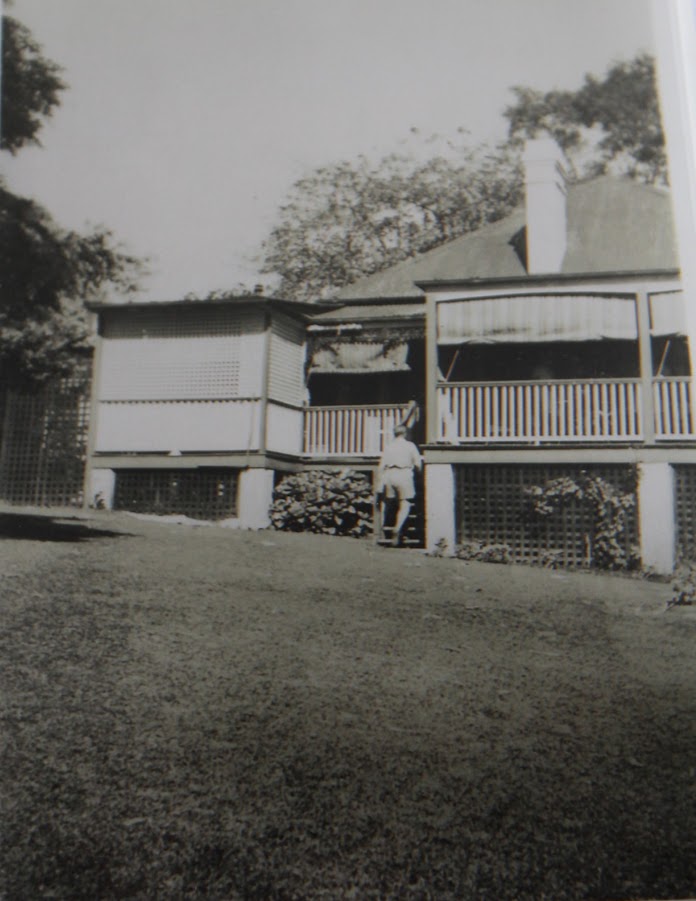
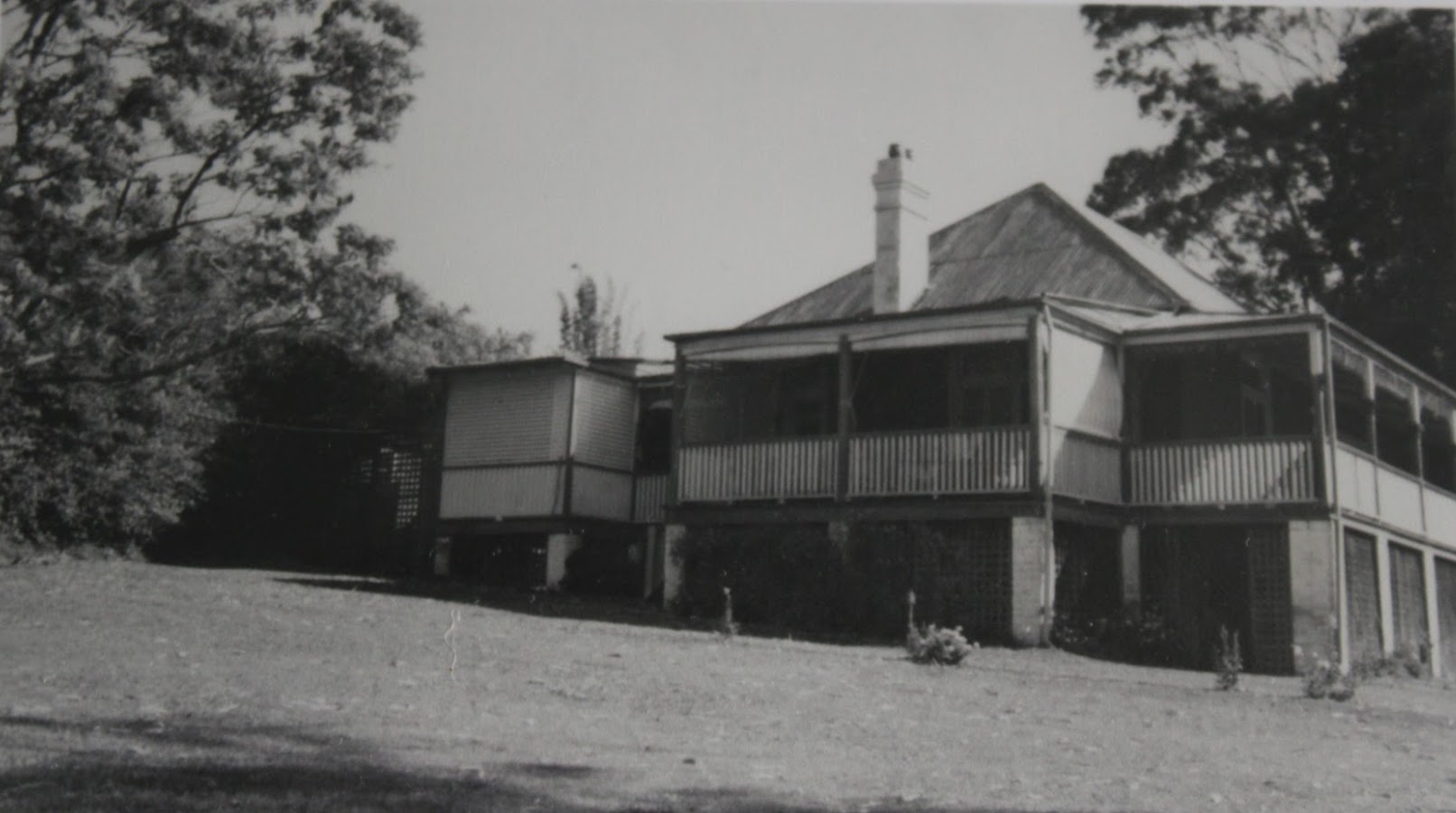
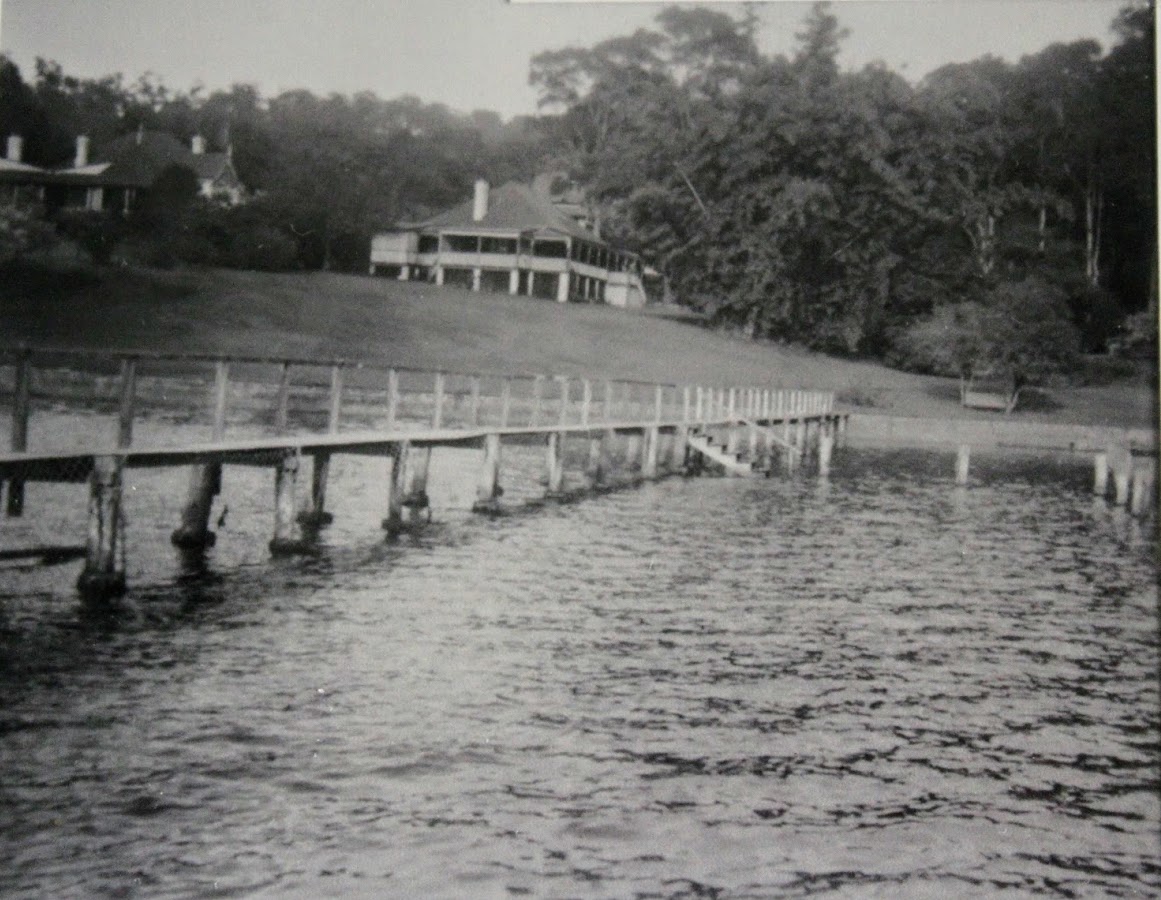
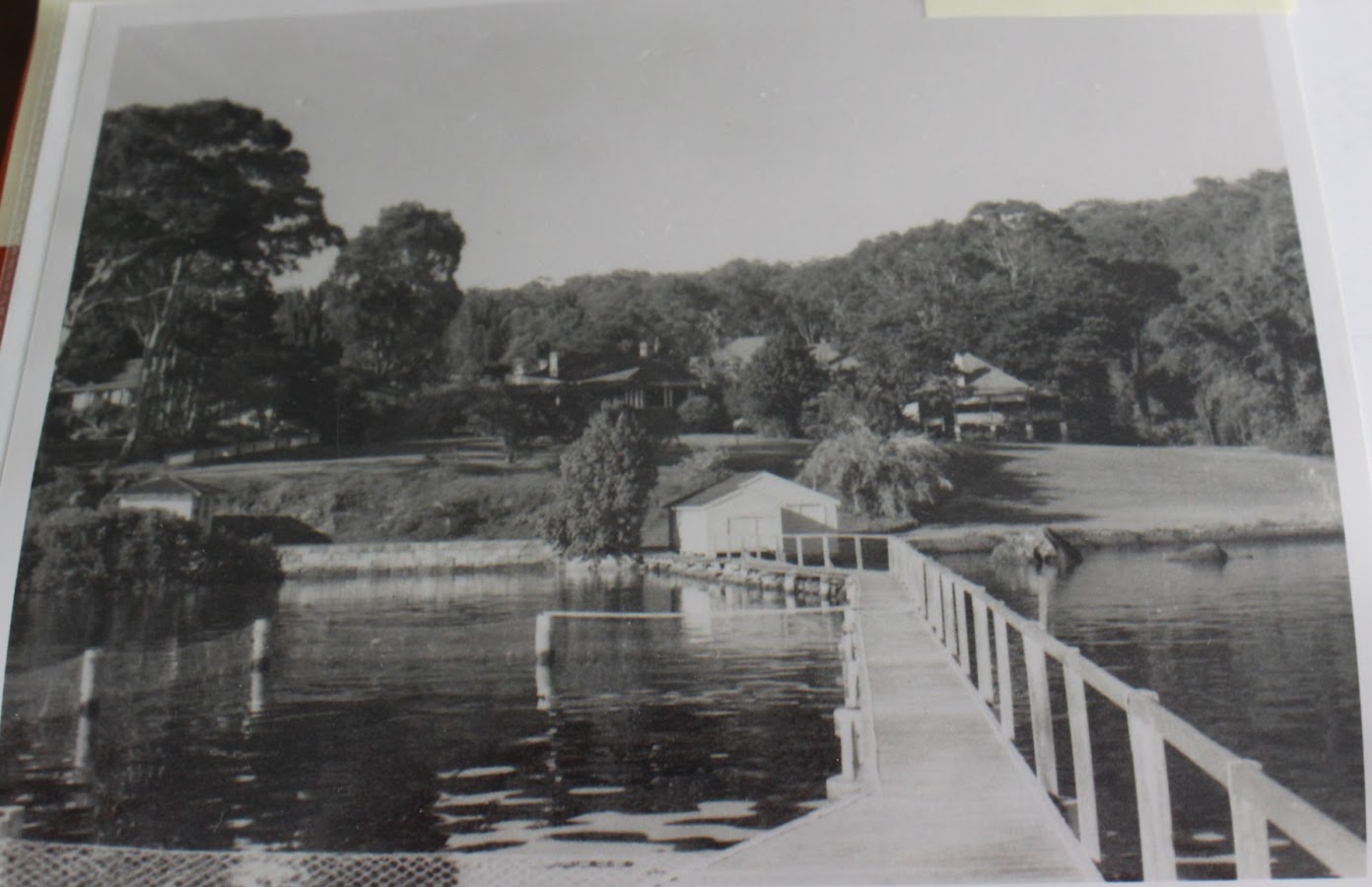
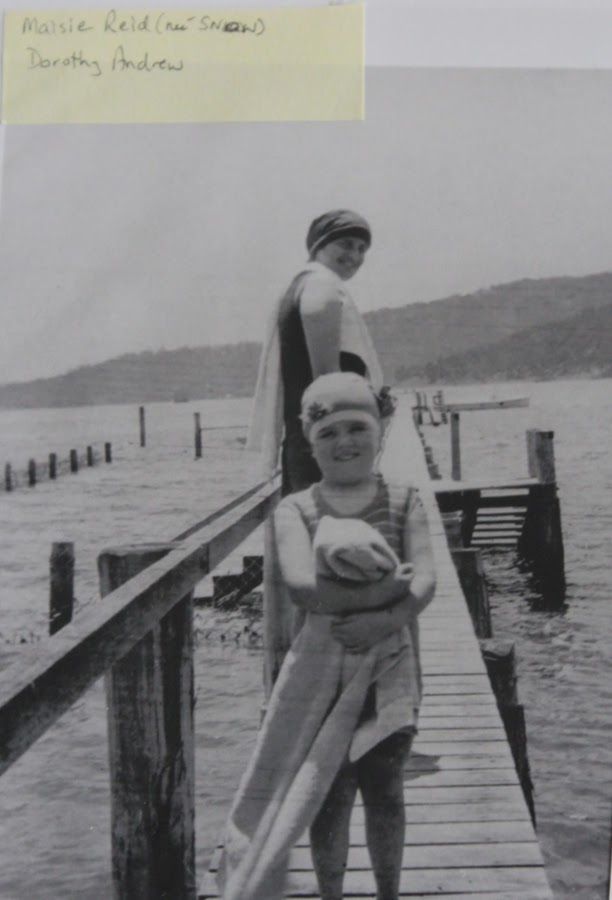
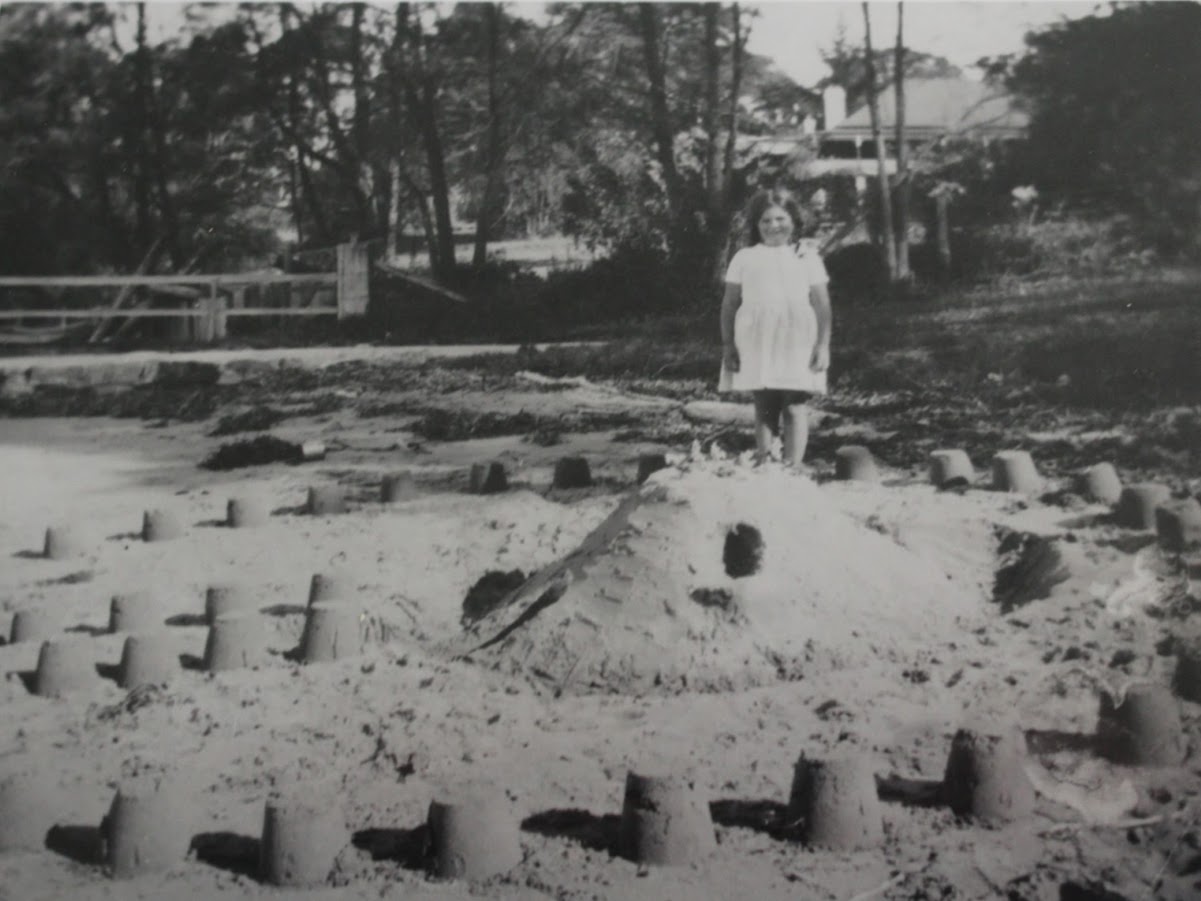
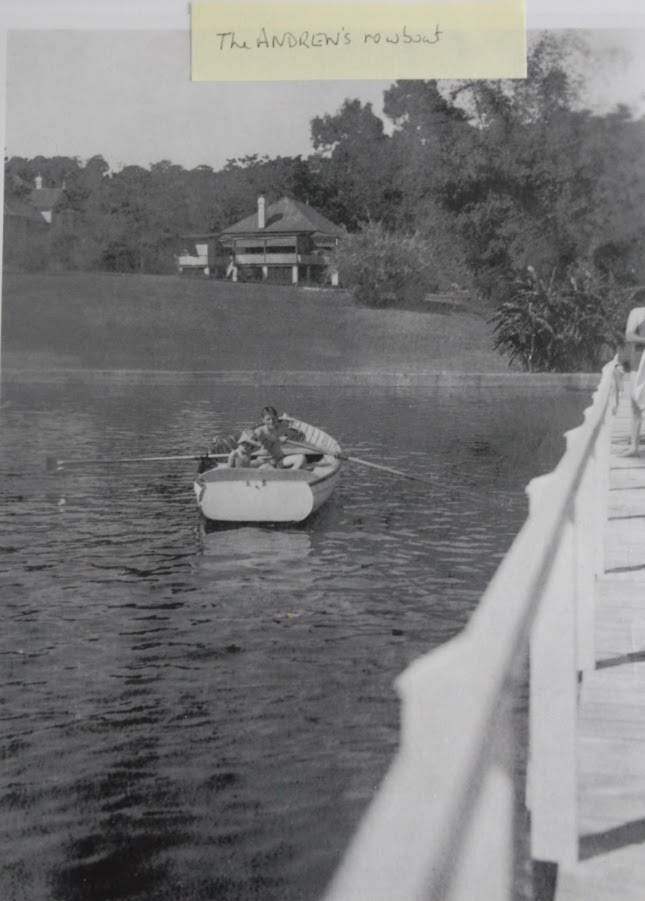
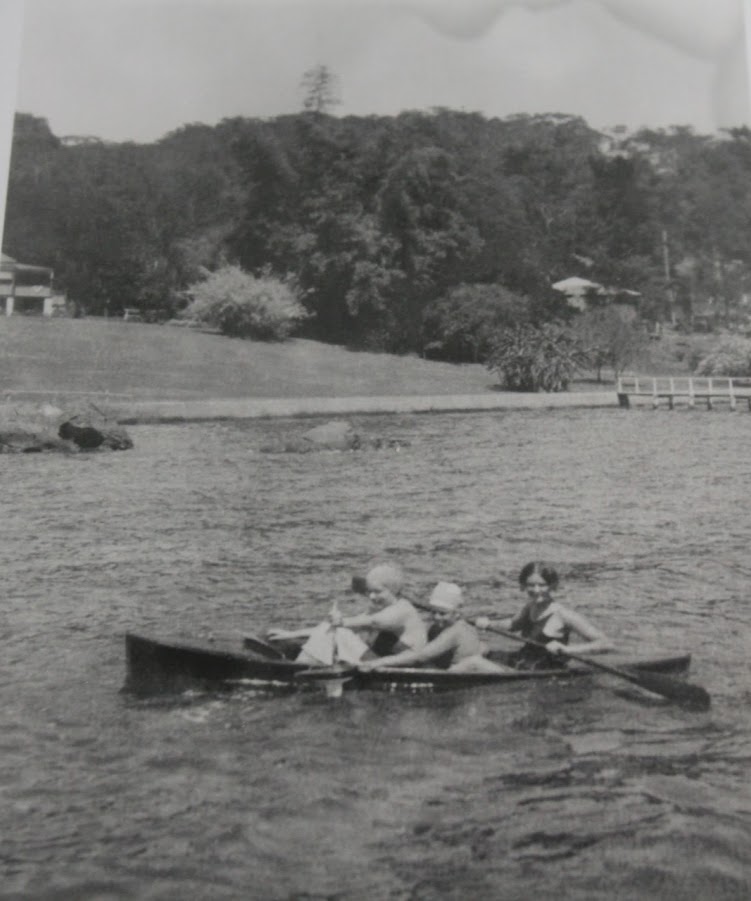
Next to Sir Clarke's 10 acres can be seen 'P. T. Taylor', which is Patrick Thomson Taylor (1862-1922), businessman and politician and father of Sir Patrick Gordon 'Bill' Taylor, William Don M Taylor, Kenneth Taylor and Norah. In 2017 an interview with Don Taylor, son of W D M provided insights into the family holdings and Summer fun at Bayview.
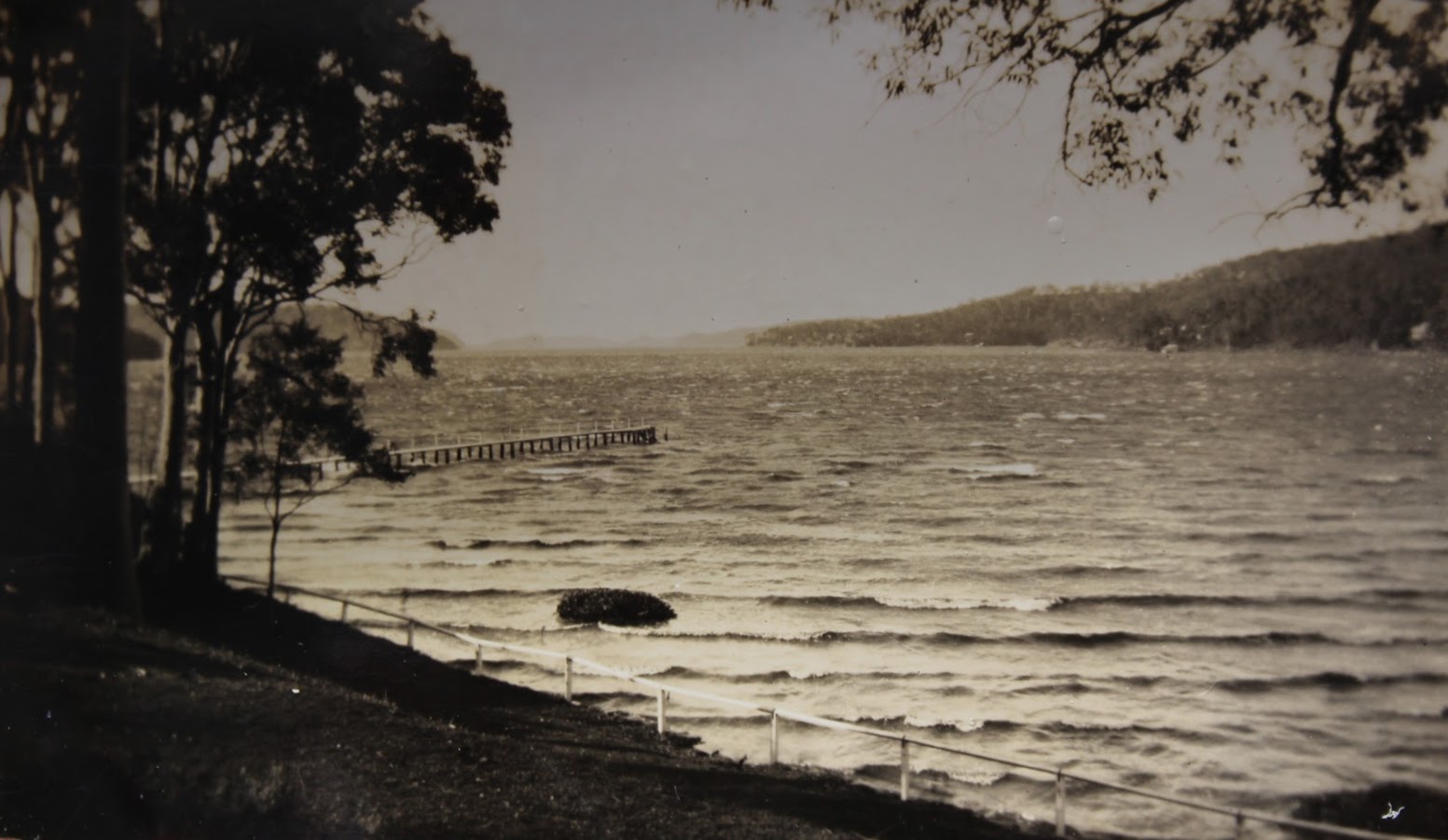
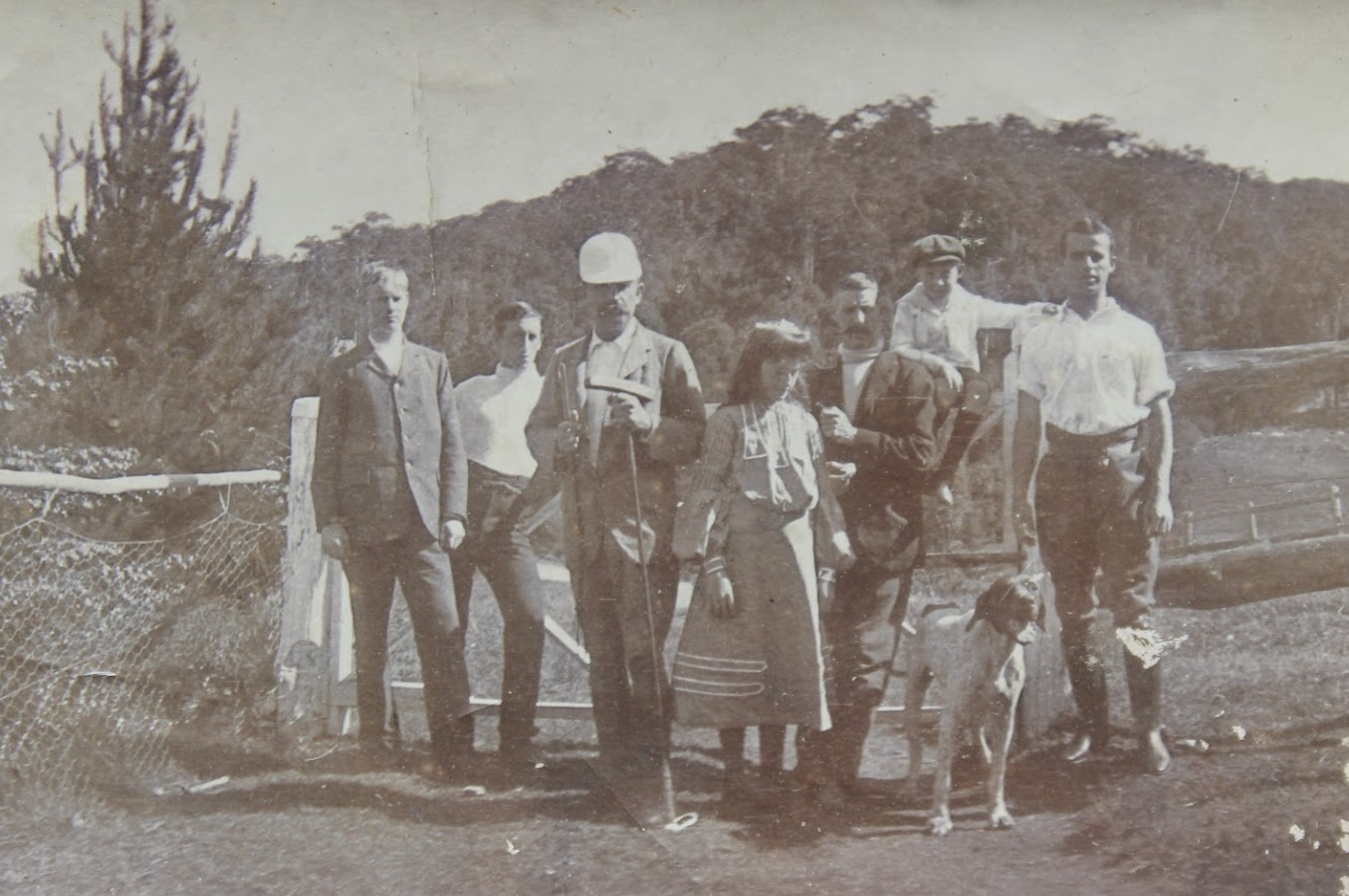
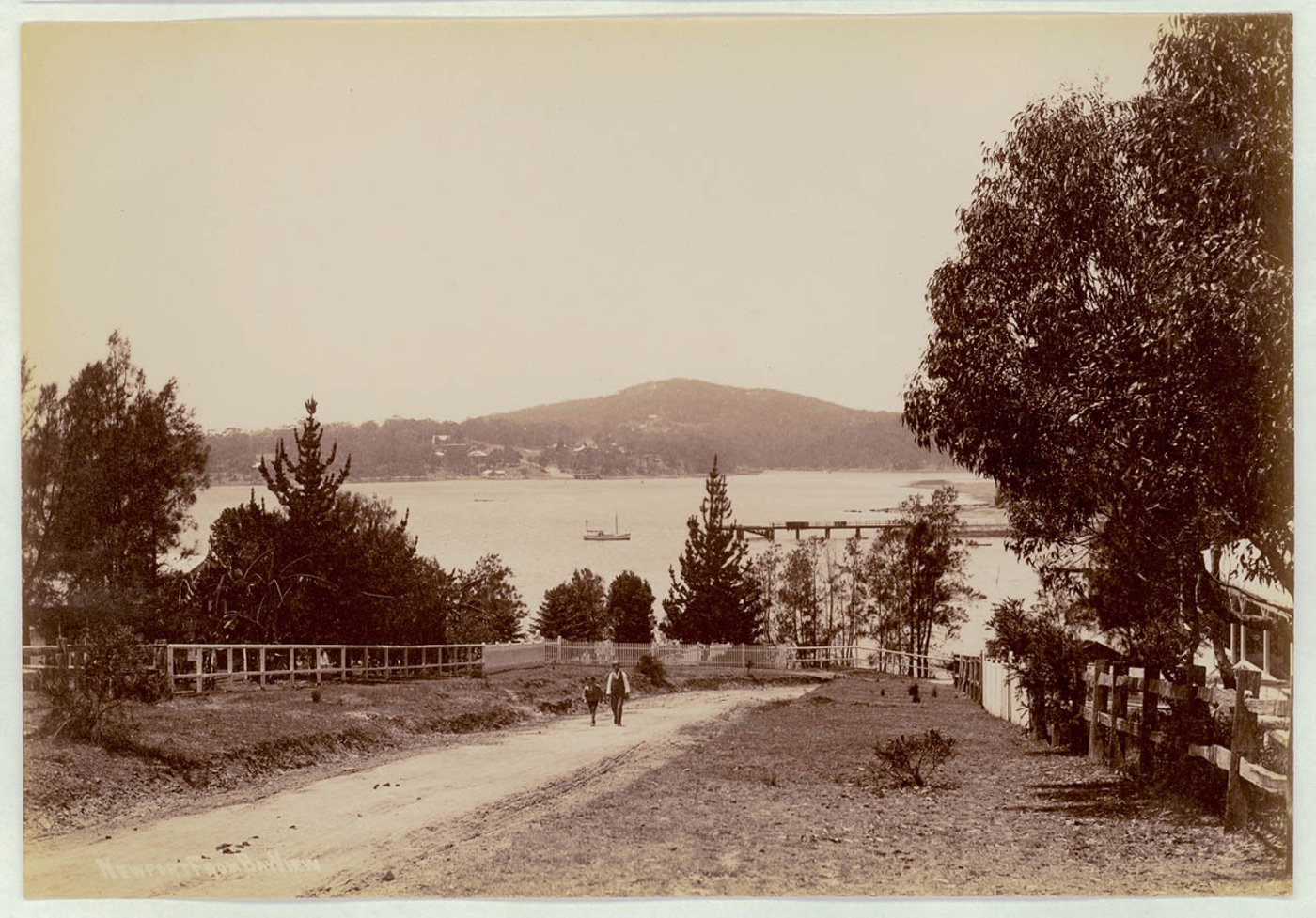
Above: 'Newport from Bayview', ca. 1900-1910, Image No.: a116491, courtesy State Library of NSW.
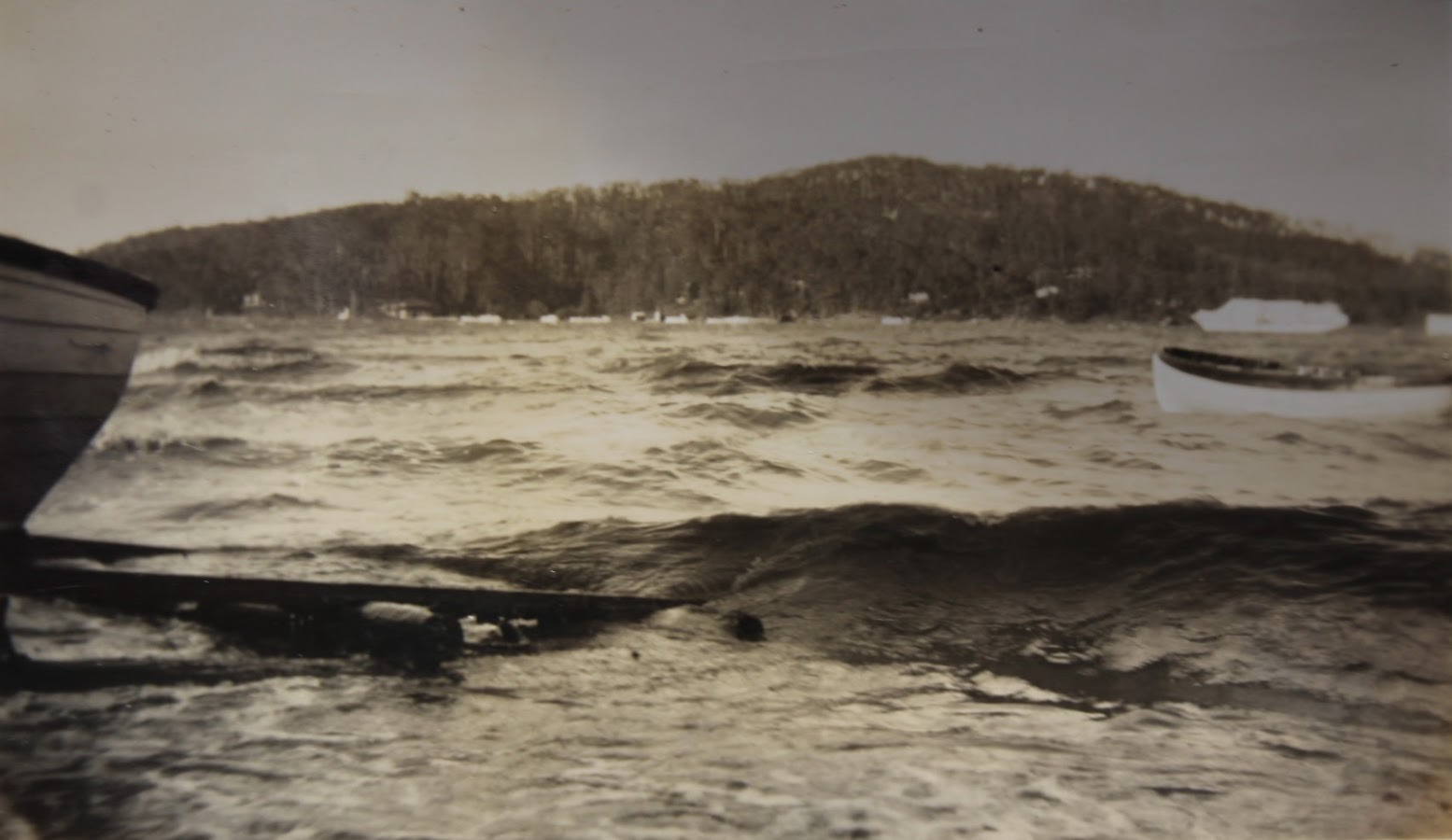
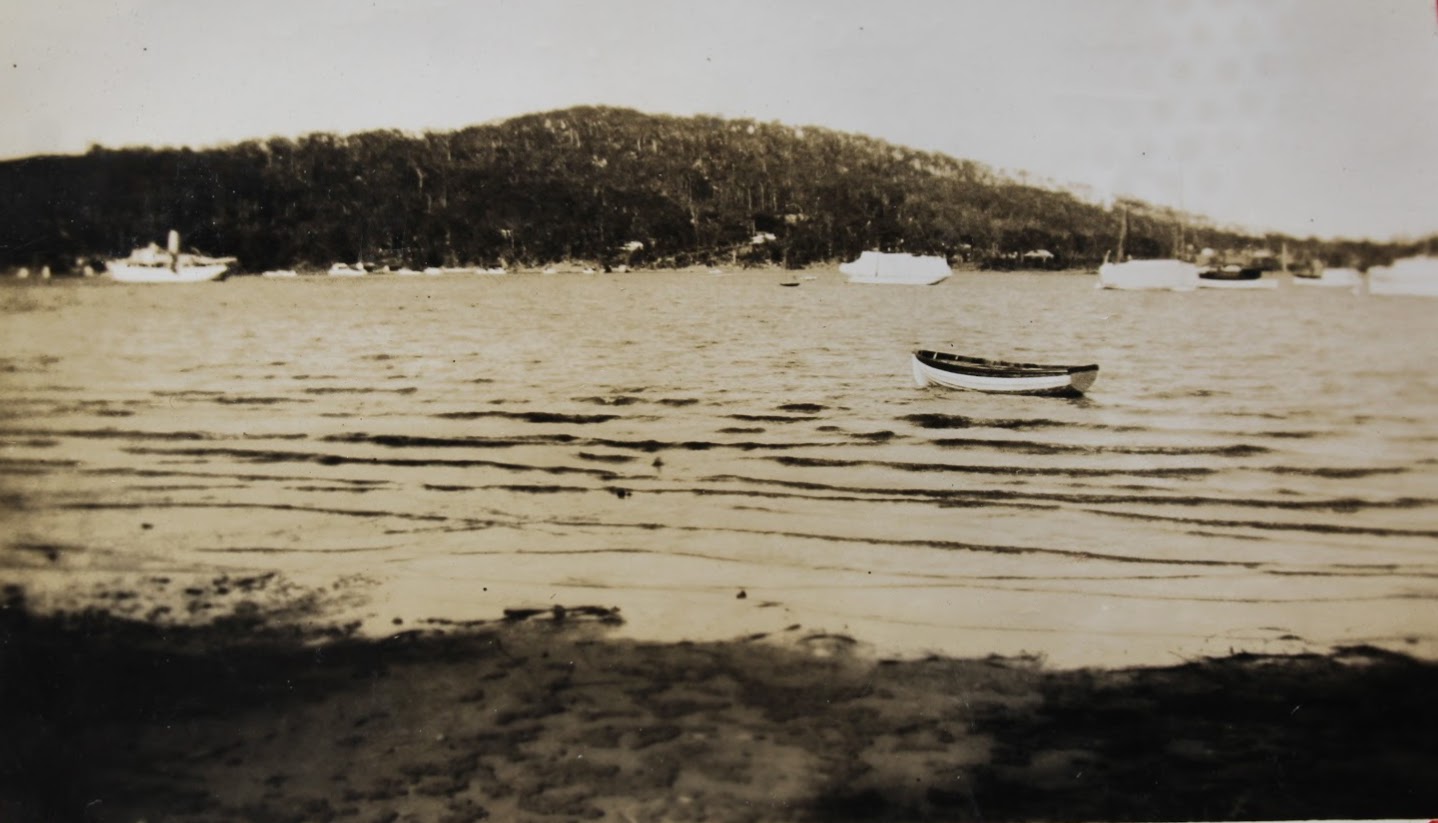
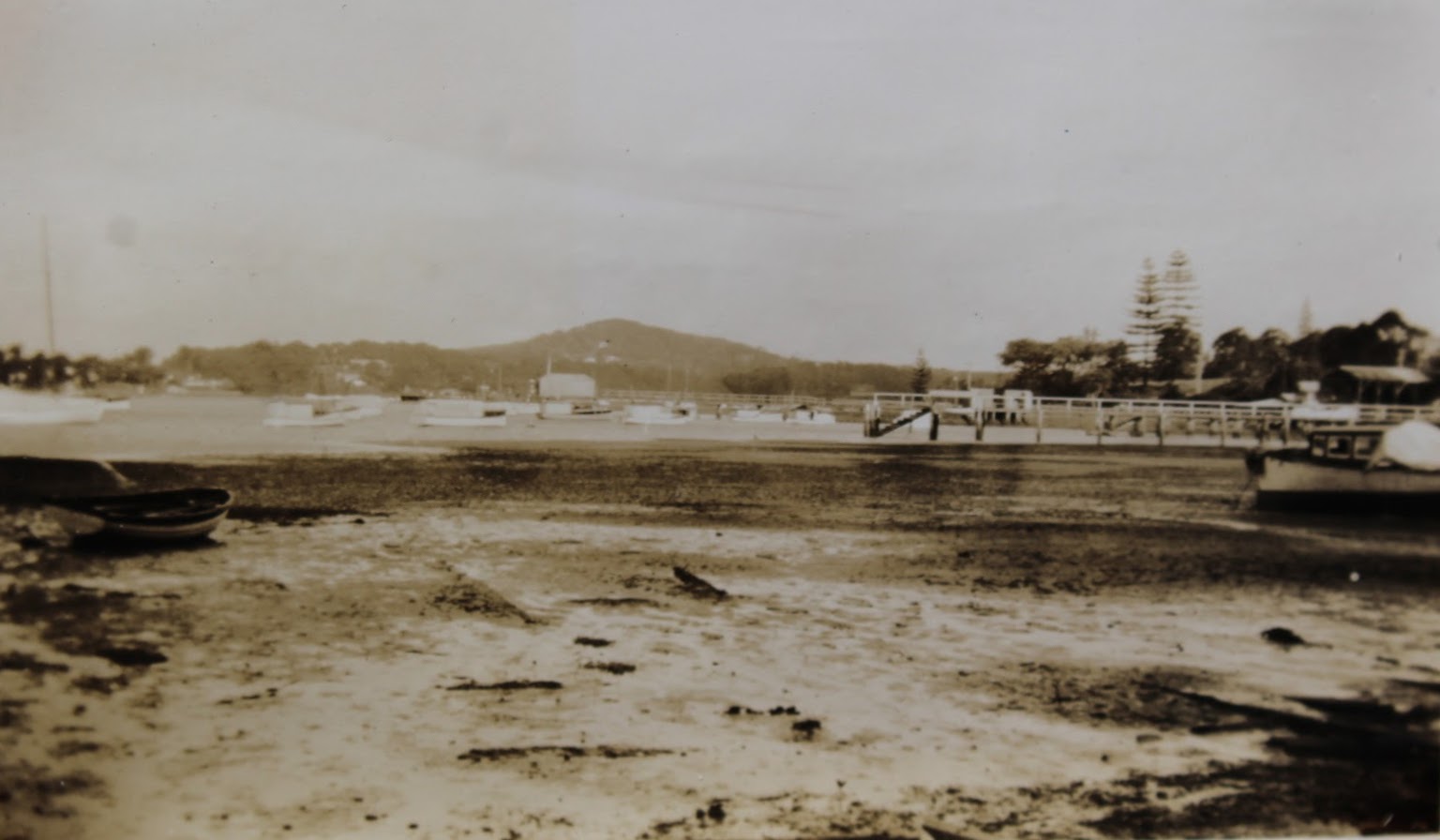
The other sections of land had connections to the Oliver family and then the family of Samuel Morrison of the school in the Church Point church, and stretch into Church Point proper. On March 23rd 1899 Emma Morrison purchased ten acres from Martha Oliver, the property of Thomas Albert Oliver (deceased). (Certificate of Title 1277 – 51). This land is part of the original 40 acre land grant to William Cape in 1840 (Portion 27). This property with a cottage (once the Olivers’ home) is next to the small property which Emma purchased in 1891 from Thomas Oliver. The newly acquired cottage on the ten acres, near Killarney, is named Drumtochty.
"I had two on the Bayview side, near Fig Tree Flat, named Killarney and Drumtochly. … Mr Ireland had another furnished cottage near Church Point. Each of these furnished cottages were supplied with a good pulling boat and had enclosed baths.” (S. Morrison 1929)
1900 “Bayview Pittwater Furn Cottages, 4 bedrooms from …., boat firewood, water.S. Morrison, P.O.“ (SMH 6 October 1900 P.15)
1901 “Summer Resorts - Bayview – Furn. Cottages ev. conv., good fishing, bathing, boat. Term S. Morrison Bayview P.O.” (SMH 16 March 1901 P.6)
1903 “Country Resorts Bayview – Drumtochty, 7 rooms, …. Boat, baths, fishing, oystering. S. Morrison Bayview P.O.” (SMH Sat 31 Jan 1903 P.3)
1904 “Summer Resorts – Bayview – Furnished Cottages, 6 r, enclosed baths, boat, low rent, best position. S. Morrison Bayview P.O.” (SMH Sat 26 Nov 1904 P.17)
1905 “Bayview – Furn Cott, 6 rms, bathing enclosure, tennis, boat, firew. Low rt. Morrison, Bayview P.O.” (SMH 11 November 1905 P.20)
In 1905-6 Henri and Hedwig Rainaud take over Drumtochty and set up a restaurant and accommodation house. In December 1905 Henri Rainaud advertises that he is applying for a certificate authorising the issue of a Colonial Wine License for a house situated at Church Point, Bay View. (SMH 23 December 1905 P.14) ; “Bayview – Drumtochty and *Ripley – First class Accom., French cuisine, ev. Home con. H. Rainaud” (SMH 24 March 1906 P.6) - {*Ripley is a house to the east of Drumtochty}
On September 1st 1908 there is a transfer of land from Emma Morrison to Hedwig Rainaud. In the same month Monsieur Rainaud advertises his accommodation house, formerly Drumtochty, with the name “La Corniche”. (SMH 19 September 1908 P.22) Visit: La Corniche at Bayview
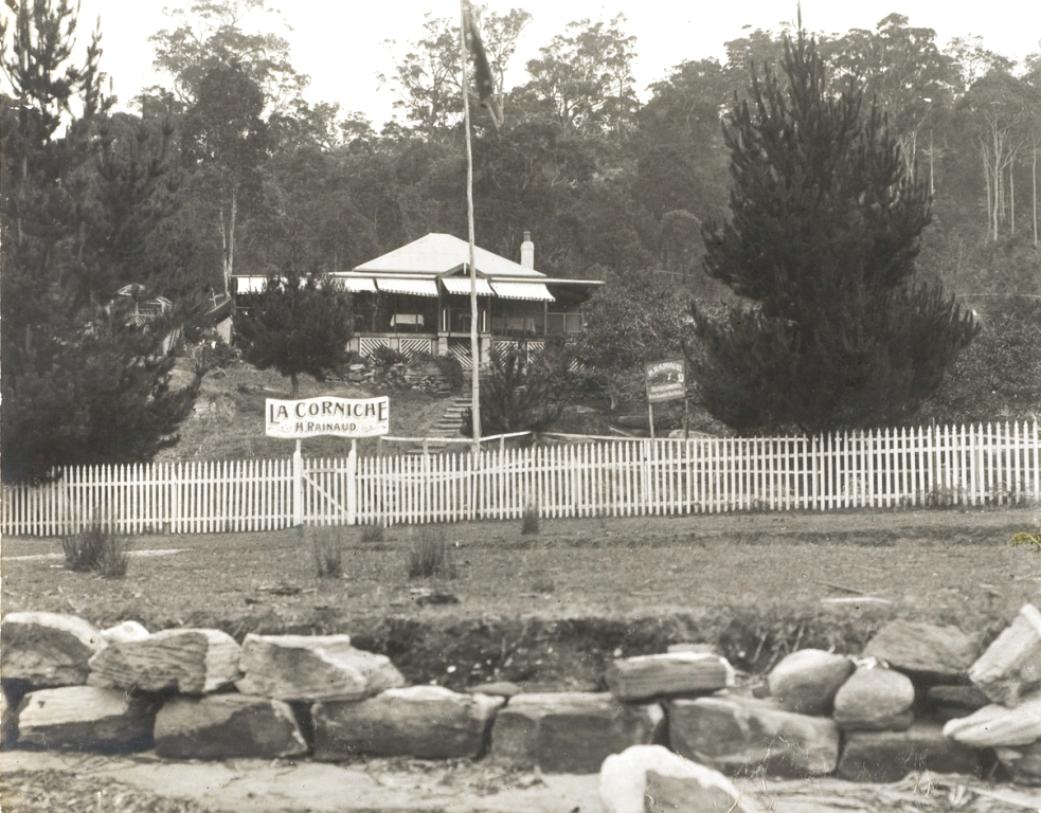
From The Mort Family Album, Image 131. H.Rainaud's restaurant La Corniche, Digital Order No. a1780131, from State Library of NSW: A note scribbled at side of this photograph says " Renaud - after his Restaurant in Macquarie Street - Morts Rooms-Chambers'.
In 1898 the Wheeler family rent the Morrisons’ cottage ‘Killarney’ at Bay View at one pound per week with seabaths and a good boat included. Mr. J. S. N. Wheeler relates insights on this cottages in his 1940 published The Early Days of Bayview, Newport, Church Point and McCarr’s Creek, Pittwater:
This has brought us to the twelfth mile-post from Manly. Along the road bordered with trees the coach descends to Figtree Flat, also known as Cape’s Flat, and the orchard of W. J. R. Baker, with “Killarney” cottage lying between the two. This flat with its green sward was a favourite picnic ground. The annual school picnic and distribution of prizes were held there on November 9 each year, the birthday of the then Prince of Wales (later King Edward VII.).
Baker’s orchard has long since disappeared. It comprised six acres of peaches, nectarines and other summer fruits, and two acres of oranges. The orangery was situated high up at the apex of the orchard. A row of quince and peach trees flanked the fence next to "Killarney." As Baker also kept poultry, it will be seen that Bayview was once a thriving poultry-farming and fruit-growing district.
CHURCH POINT.
Before describing this district in detail, it is fitting that I should mention the furnished cottages, a feature of early tourist days, and tending to make the place known.
In 1898 we rented “Killarney” cottage at £1 per week, sea baths and a good boat included. My first evening at this spot includes a boyish reminiscence of a walk after tea to Bayview Post Office store for provisions, and a glimpse of the red beacon of Barrenjoey Lighthouse. “Killarney” had a lawn, summer-house, and a white fence—a spot where cool nor’-easters blew the tang of salt sea across the bay. I remember that a big, green-painted lugger, the Thomas and Martha, owned by Thomas Oliver, used to anchor off this spot. She carried firewood for sale in Sydney. Next door lived a fisherman, Tom Wilson, in a squat cabin-type of cottage half hidden by bracken and bush shrubs. From him we used to buy a dozen large black bream and black fish for a shilling for breakfast. Cases were packed with fish—the night’s harvest—and sent up to Manly on the roof of the coach in the morning.
At Mrs Chave’s orchard, a quarter of a mile away, a bucket would be filled with grapes for a shilling. The grape vines grew in a dingle half way between the house and the road. Mrs Chave, an old lady aged ninety-three years, passed away in 1934.
Just above “Killarney” was another furnished cottage, “Drumtochtee,” in which some of the Oliver family once lived. S. Morrison, schoolmaster, owned both these cottages. Later “Drumtochtee'’ was bought and renovated by Rainaud and named “La Corniche.” Luncheons were provided there for visitors. Another furnished bungalow, “Rosstrevor,’’ prettily situated with a beach in front, in a combe on McCarr’s Creek, belonged to J. Ireland, a confectioner of Leichhardt. It was named after his house in that suburb. It was cosily furnished, and had the usual appurtenances of a boat and baths.
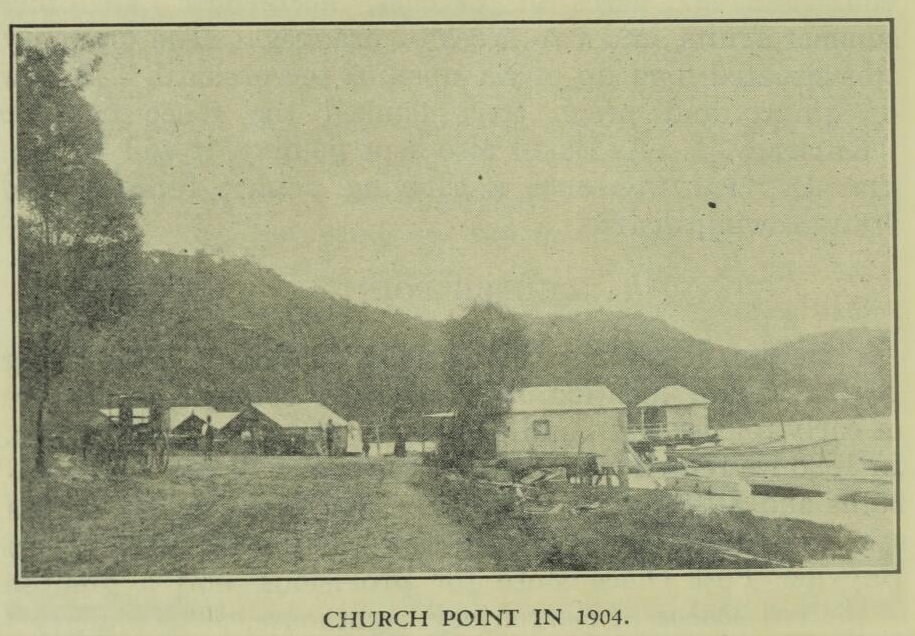
CHURCH POINT IN 1904.
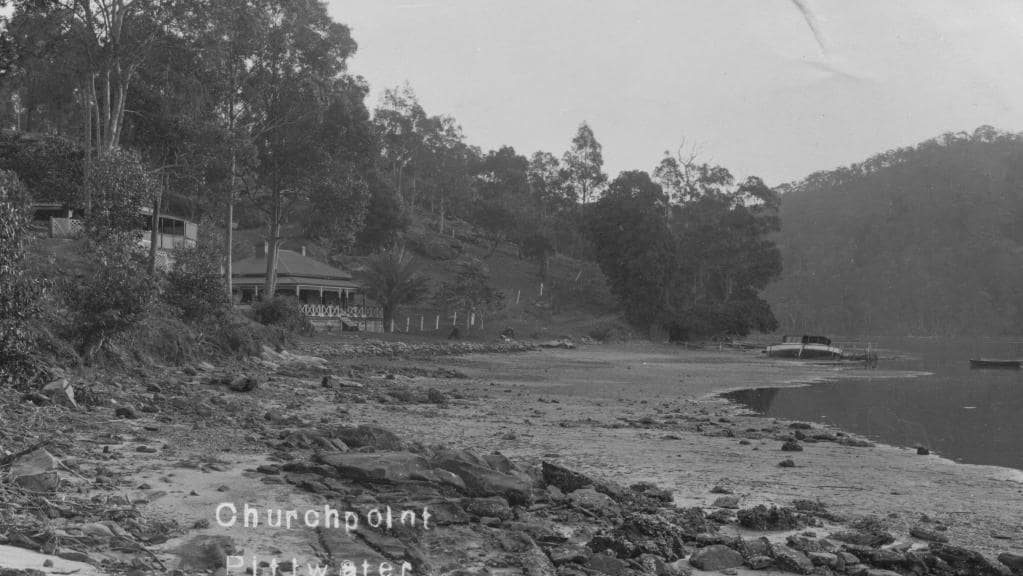
Rosstrevor circa 1905-1910
Bay View.
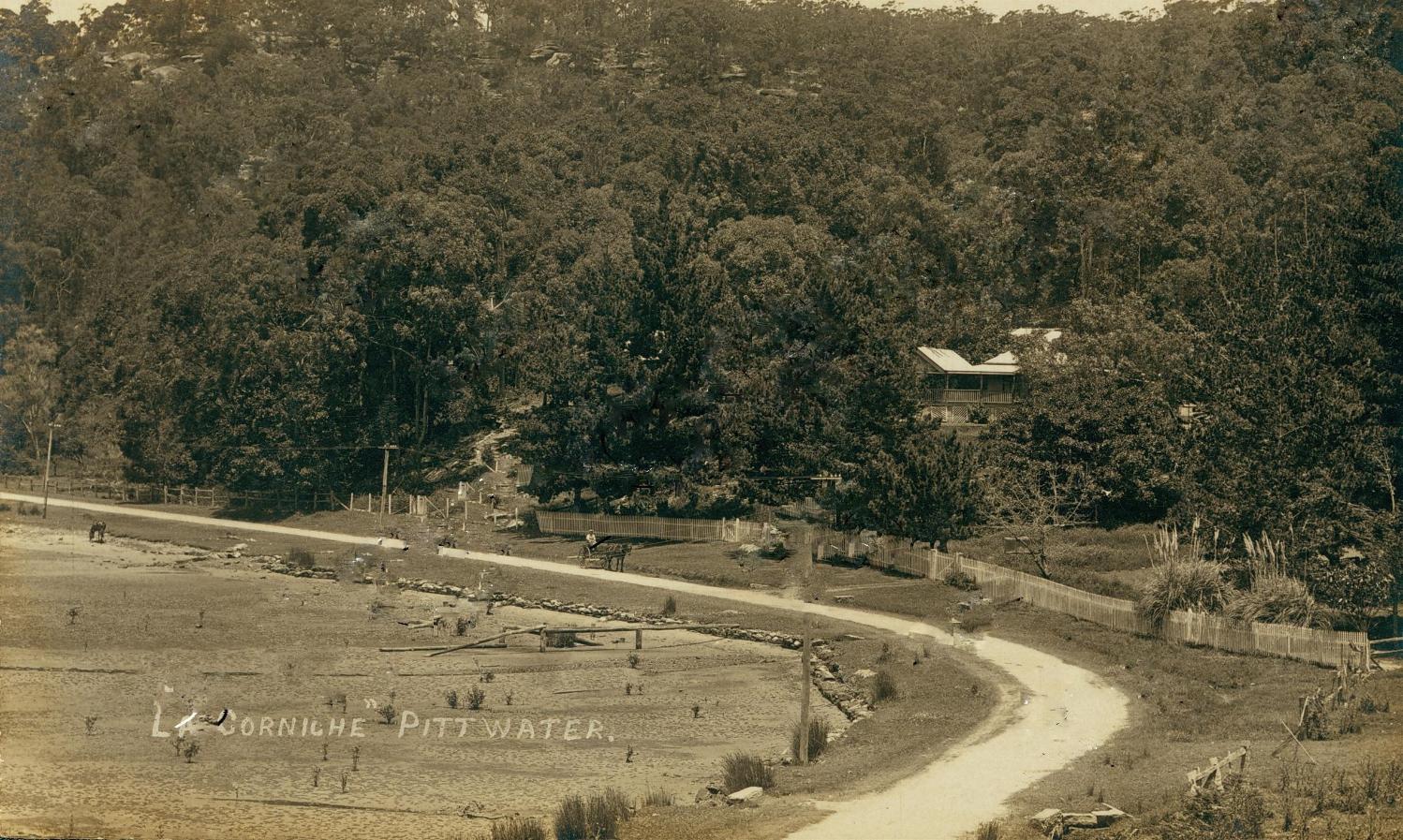
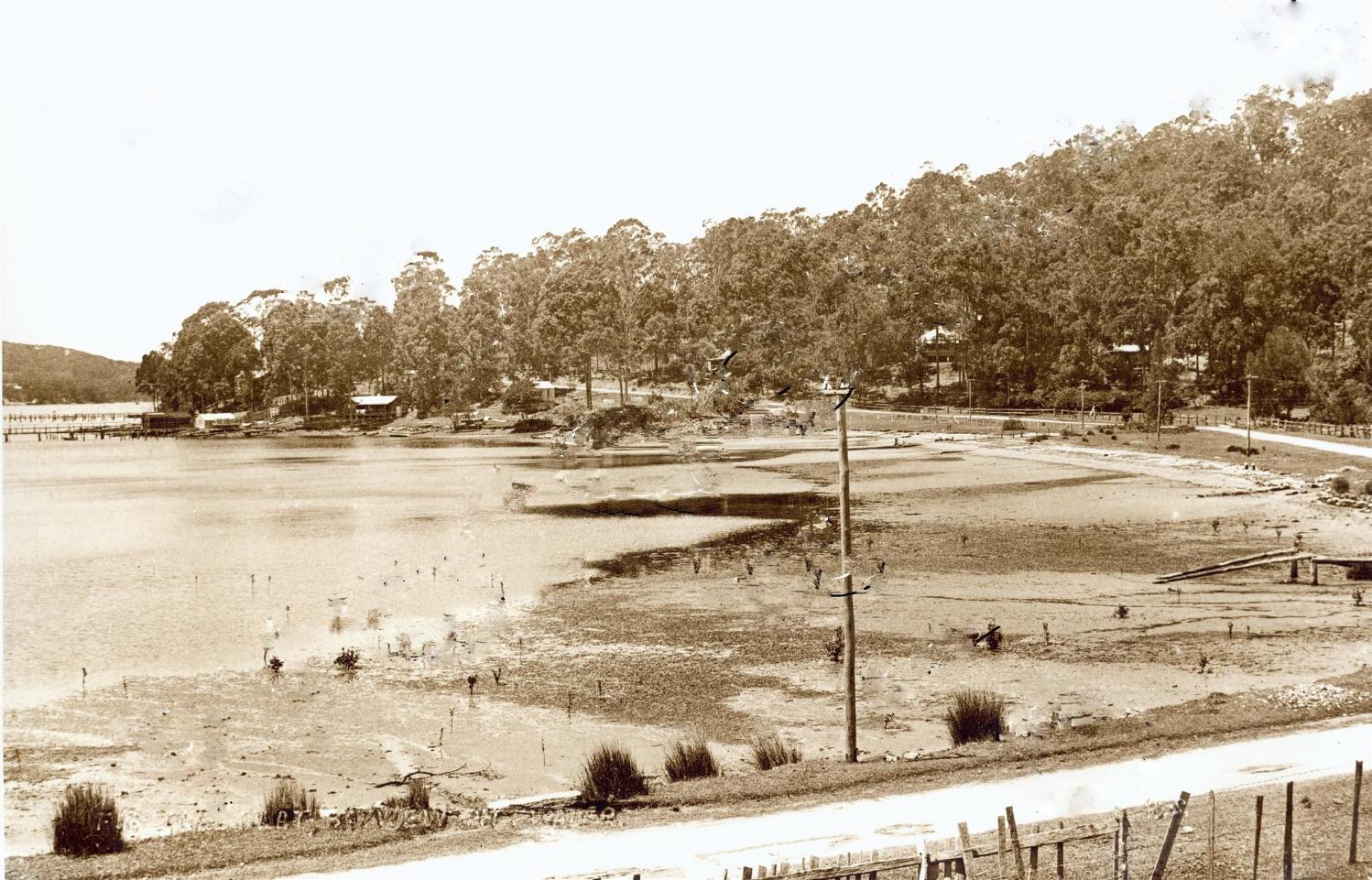
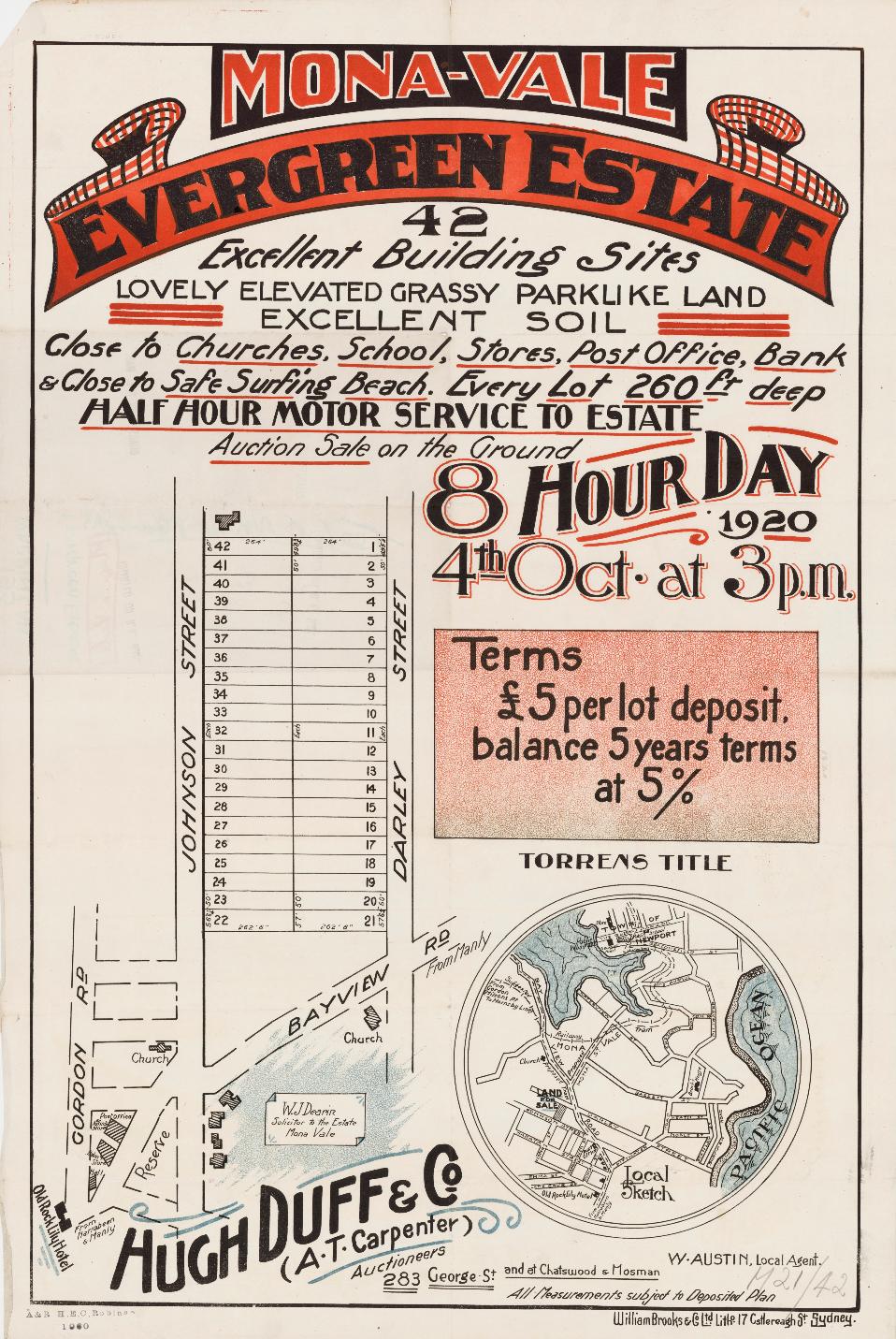
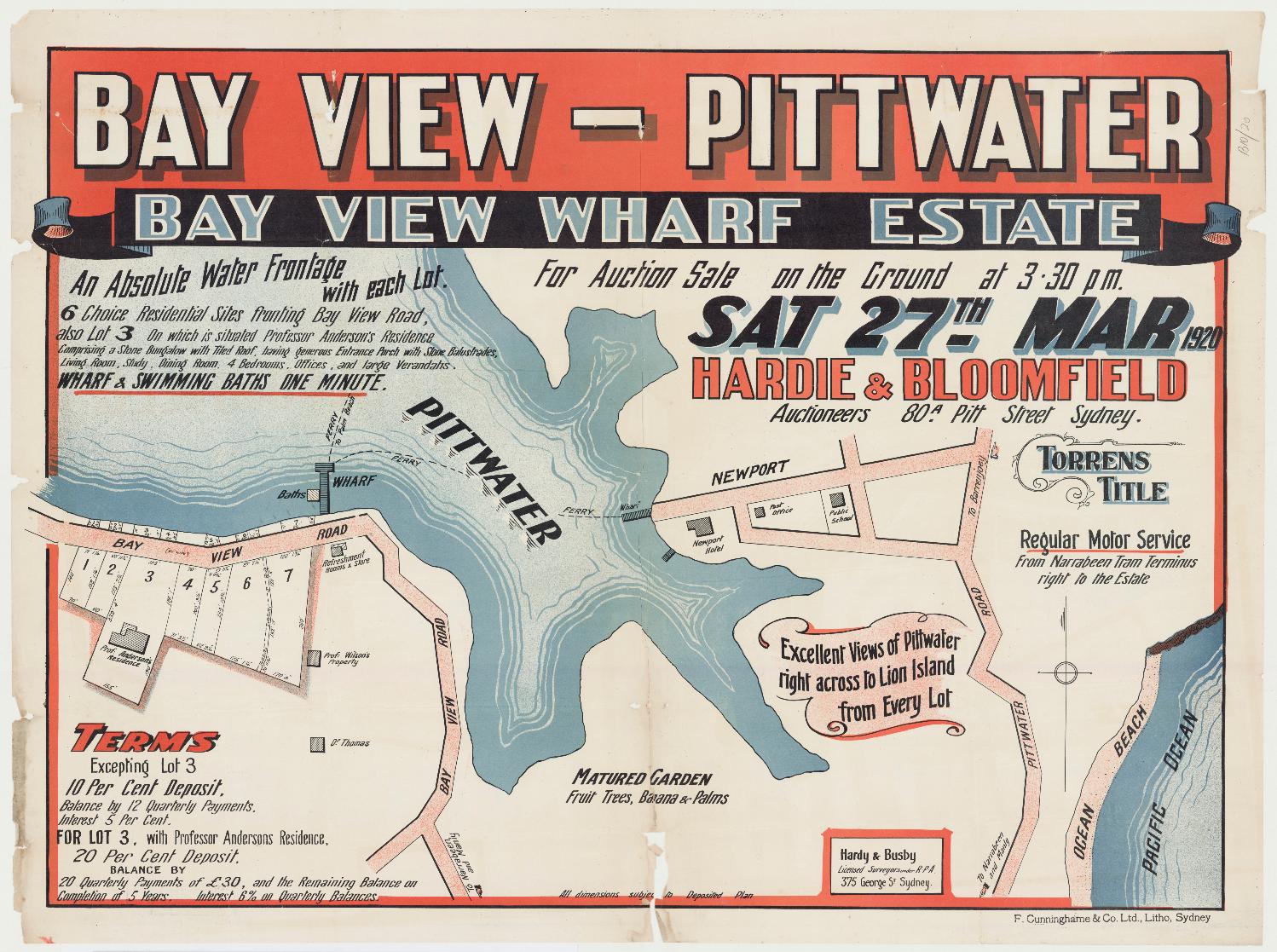
The Anderson "Maybanke' home at Bayview on the market in 1920.
Bay View, Pittwater.— Hardie & Bloomfield submit the well-situated Bay View Wharf Estate on 27th March, 1920.The estate lies at the Ferry Wharf, and consists of comfortable stone cottage and six vacant sites, each with a water frontage. Title Torrens, easy terms. REAL ESTATE WORLD (1920, March 20). Smith's Weekly (Sydney, NSW : 1919 - 1950), p. 13. Retrieved from http://nla.gov.au/nla.news-article234220077
NEXT SATURDAY - BAY VIEW, PITTWATER. -NEXT SATURDAY.
BAY VIEW WHARF ESTATE, RIGHT AT THE WHARF AND SWIMMING BATHS. BEAUTIFUL RESIDENTIAL SITES.
ABSOLUTE WATER FRONTAGE WITH EACH ALLOTMENT
Also PROFESSOR ANDERSON'S FINE RESIDENCE, COMMANDING EXQUISITE VIEWS RIGHT ACROSS TO LION ISLAND.
FOR AUCTION SALE, ON THE GROUND, NEXT SATURDAY, MARCH 27, AT 3.30 P.M.
TORRENS TITLE. TORRENS TITLE.
TERMS : 10 per cont. Deposit. Balance, 12 Quarterly Paymonts. Interest, 6 percent. For Lot 3, with Professor Anderson's Residence, 20 per cent. Deposit. Balance by 20 Quarterly Payments of £30, and the remaining balance on completion of 5 - years. Interest, 6 per cent., on Quarterly Balance.
CALL, WRITE, OR 'PHONE FOR PLAN.
HARDIE AND BLOOMFIELD, ' :
AUCTIONEERS, 80A PITT STREET, SYDNEY.
HARDY and BUSHY, Surveyors, 373 George Street, City,
TELEPHONE 301 CITY. .
WINDEYER, FAWL, WILLIAMS and OSBORNE, Solicitors to Estate, 25 O'Connell Street. Advertising (1920, March 21). Sunday Times (Sydney, NSW : 1895 - 1930), p. 7. Retrieved from http://nla.gov.au/nla.news-article120519457
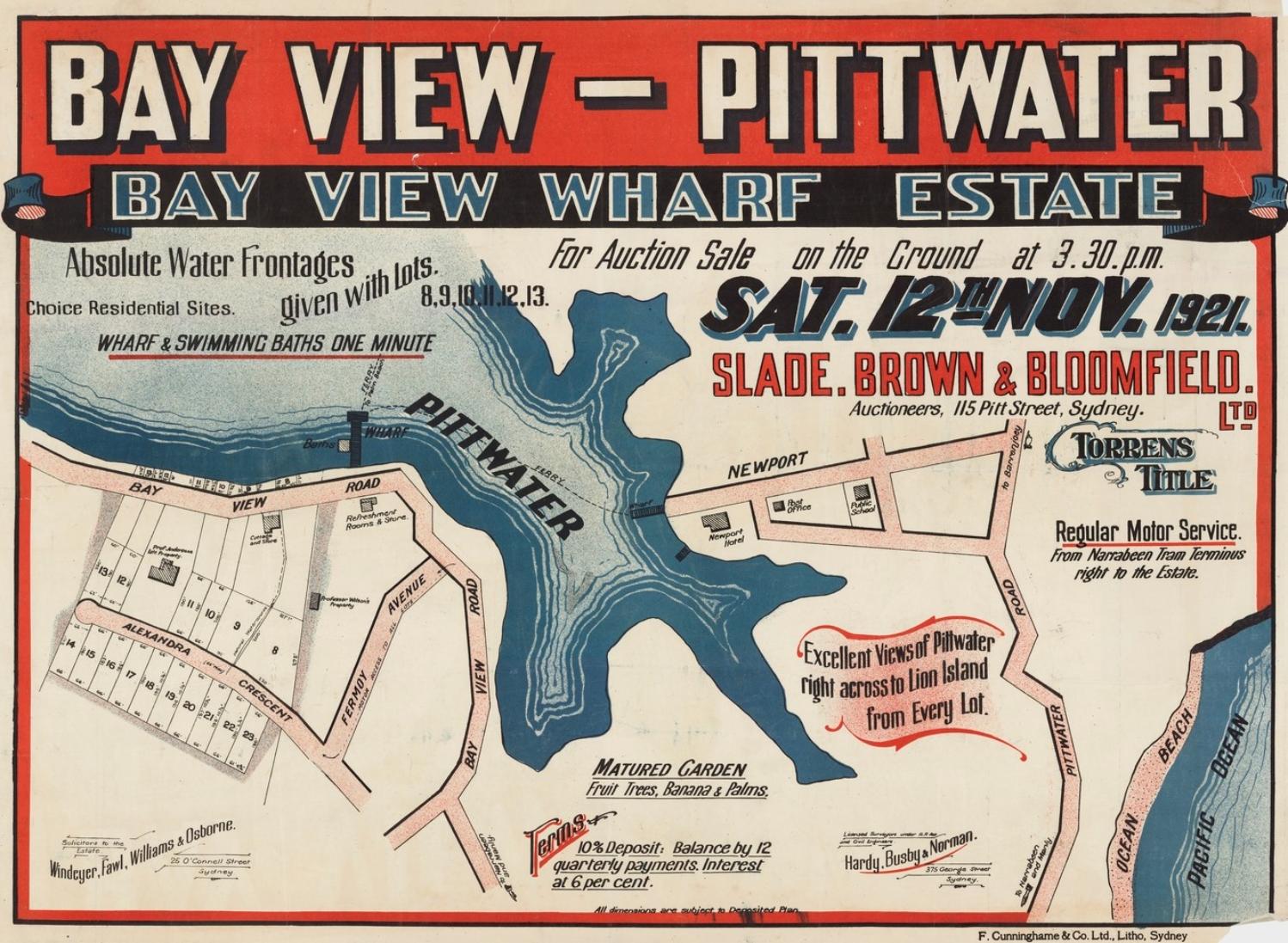
Blade, Brown, and Bloomfield, Ltd., will hold an auction at Bayview, Pittwater, of the Bayview Wharf Estate consisting of a number of fine sites, six of which have absolute water frontages. The estate commands extensive views of Pittwater, and Is adjacent to the wharf, from which a regular ferry service runs to Palm Beach. Bayview Is also connected by a regular motor service with Narrabeen. REAL ESTATE. (1921, November 12). The Daily Telegraph (Sydney, NSW : 1883 - 1930), p. 20. Retrieved from http://nla.gov.au/nla.news-article239718125
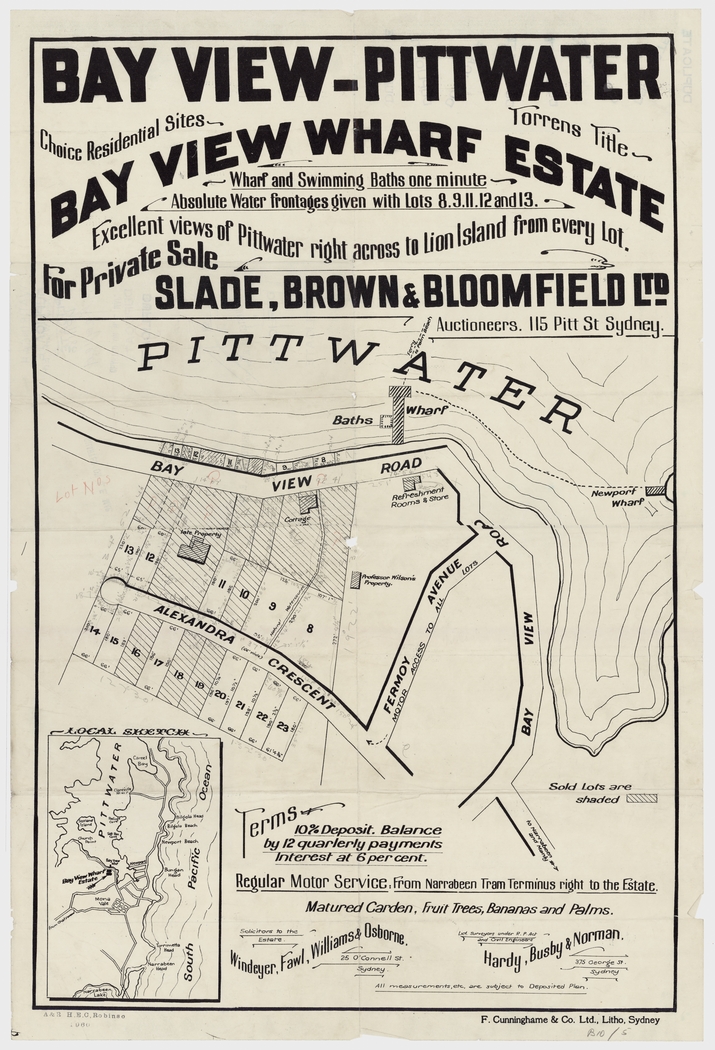
Bay View Wharf Estate - Subdivision Plan, Item: c029500005h, courtesy State Library of NSW - from Pittwater Subdivision Plans folder
As the rain last Saturday interfered with the original sale of Bay View Wharf Estate, Pittwater, the auctioneers, Slade, Brown, and Bloomfield, Ltd., will hold a continuation sale on the ground this afternoon. This estate commands views of Pittwater in the direction of Taylor's Point, and absolute water frontages will be given with a number of the lots. REAL ESTATE. (1921, November 19). The Sydney Morning Herald (NSW : 1842 - 1954), p. 11. Retrieved from http://nla.gov.au/nla.news-article15971979
RELIEF WORKERS IN MOTOR CRASH 47 Involved - CRASH INTO TREE SYDNEY, Friday.
With the driver frantically trying to regain control, a motor lorry, carrying 47 relief workers to-day crashed into a tree in Bayview Road, Bayview, throwing the men in all directions. But for the tree, the lorry would have fallen over a 6ft. drop Into Pittwater.
Nine of the men were taken to Manly District Hospital by Manly District Ambulance for treatment. Bushell, who was found to have suffered a probable fracture of the skull, and Tickner and Hyslop with severe lacerations and shock, were admitted to hospital. The others were allowed to leave.
The more seriously Injured men are: —John Bushell, 50, of Osborne Road, Manly, head injuries, large wound on right leg and right finger. Arthur Hyslop, 54, of Banksia Road. Dee Why, probable fractured left leg, Injuries to right arm. and probable internal injuries. Henry Tickner, 61. of Daisy Street, Dee Why abrasions to legs and severe shock. Other men, treated for minor injuries, were: —Arthur Brunette, 53, of High Street, Dee Why, Alonda Augustus Roney, 35,Bennett Street, Manly Vale; Herbert Pomfrett, of Headland Road. Curl Curl; Frederick Loxton, 40, of Dalley Street, Harbord; Charles Rowles, 50,of Pittwater Road. North Manly Arthur Smith, 44, of Pittwater Roard, Brookvale. Ambulance treated several others at the scene of the accident for shock and minor abrasions. The lorry was one of four conveying the men to the scene of roadway construction in progress at Church Point. Approaching a sharp bend in the road near Fermoy Avenue, the steering gear of the third lorry suddenly failed, and, failing to take the bend, the lorry crashed headlong into the tree, catapulting Its passengers into the air. Mr. Cedric Williams, who lives in Fermoy Avenue, about 50 yards from the accident scene, was at the rear of his home when a terrific crash was heard.
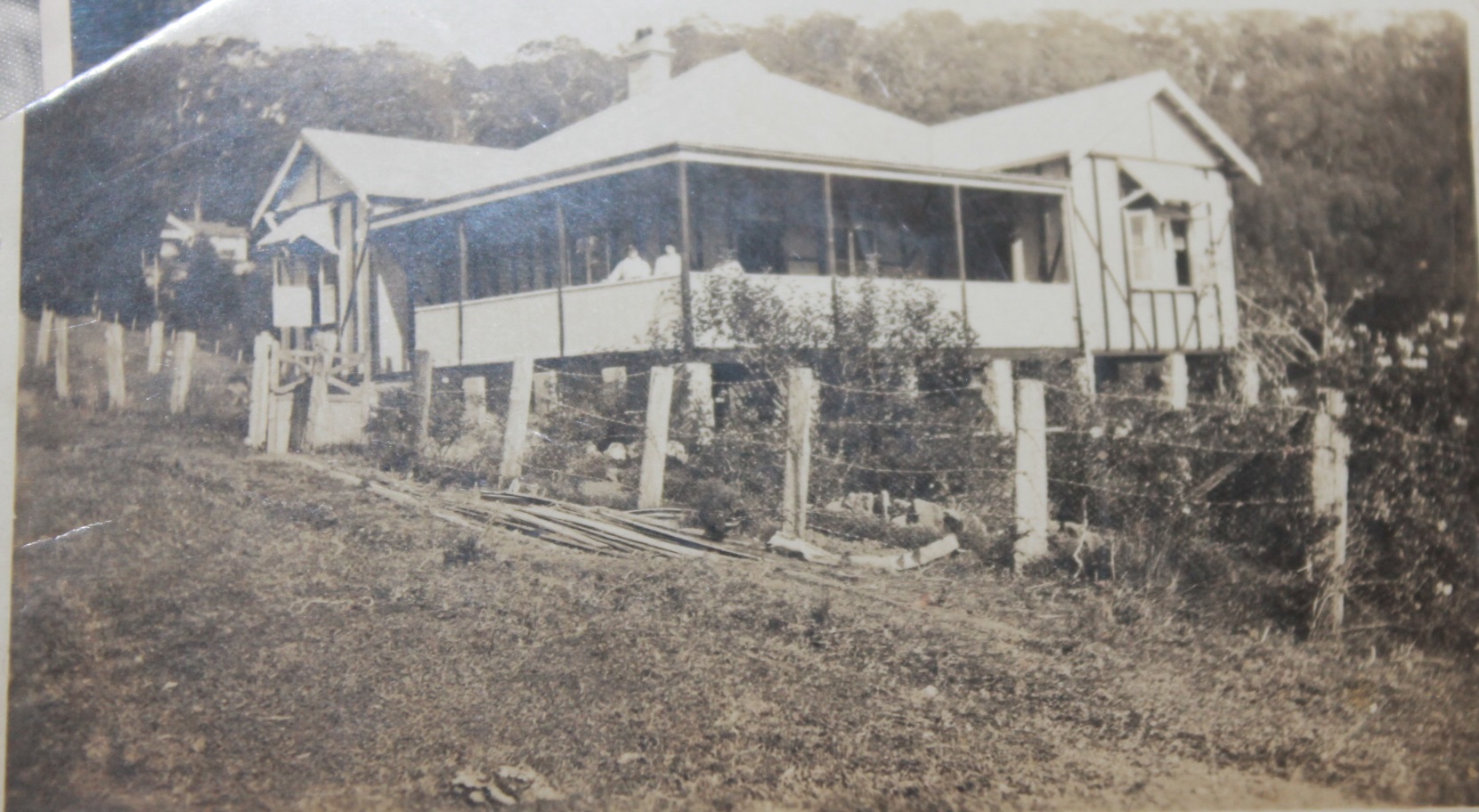
The Williams Home in Fermoy Avenue - Elizabeth Hird (Nee Williams), explained her father built this property and her mother Sophie Iris Williams (nee Fox) had told her rooms were added as needed. John L Williams and his wife had a home further up the hill and Kathleen Fox (nee Williams) eventually resided next door. Picture courtesy Elizabeth.
'We couldn't see what had happened from where we were,' he said, 'but before we could investigate, a man came running up, shouting out. 'We've had a smash at the bottom of the road. Quickly, can you give us some water.' The man's clothes were torn and he was covered In dust.' Mr. Williams provided the man with a can of water and with his mother accompanied him to the scene of the accident. ''It was an amazing sight. Men were lying everywhere.' he said. 'A local doctor, who had been called, was attending to the injuries of the men.' They certainly were lucky men, for the most part. Only for that tree, which prevented the truck from going into the water, some of them may have been drowned.' Manly District Ambulance was not long in arriving, and after first aid treatment was administered, nine of the men were taken to Manly Hospital. Miss Ruby Cowell, of Bayview post Office store,' was standing at the doorway of a shop when she heard what she describes as a loud bang
'Four trucks pass dally.' she said, 'and I had already seen two of them go by, and when I heard the crash. I guessed it was one of the other trucks.' Miss Cowell directed one of the relief workers to a telephone to call the ambulance. NINE INJURED. (1938, January 29). National Advocate(Bathurst, NSW : 1889 - 1954), p. 4. Retrieved from http://nla.gov.au/nla.news-article160704753
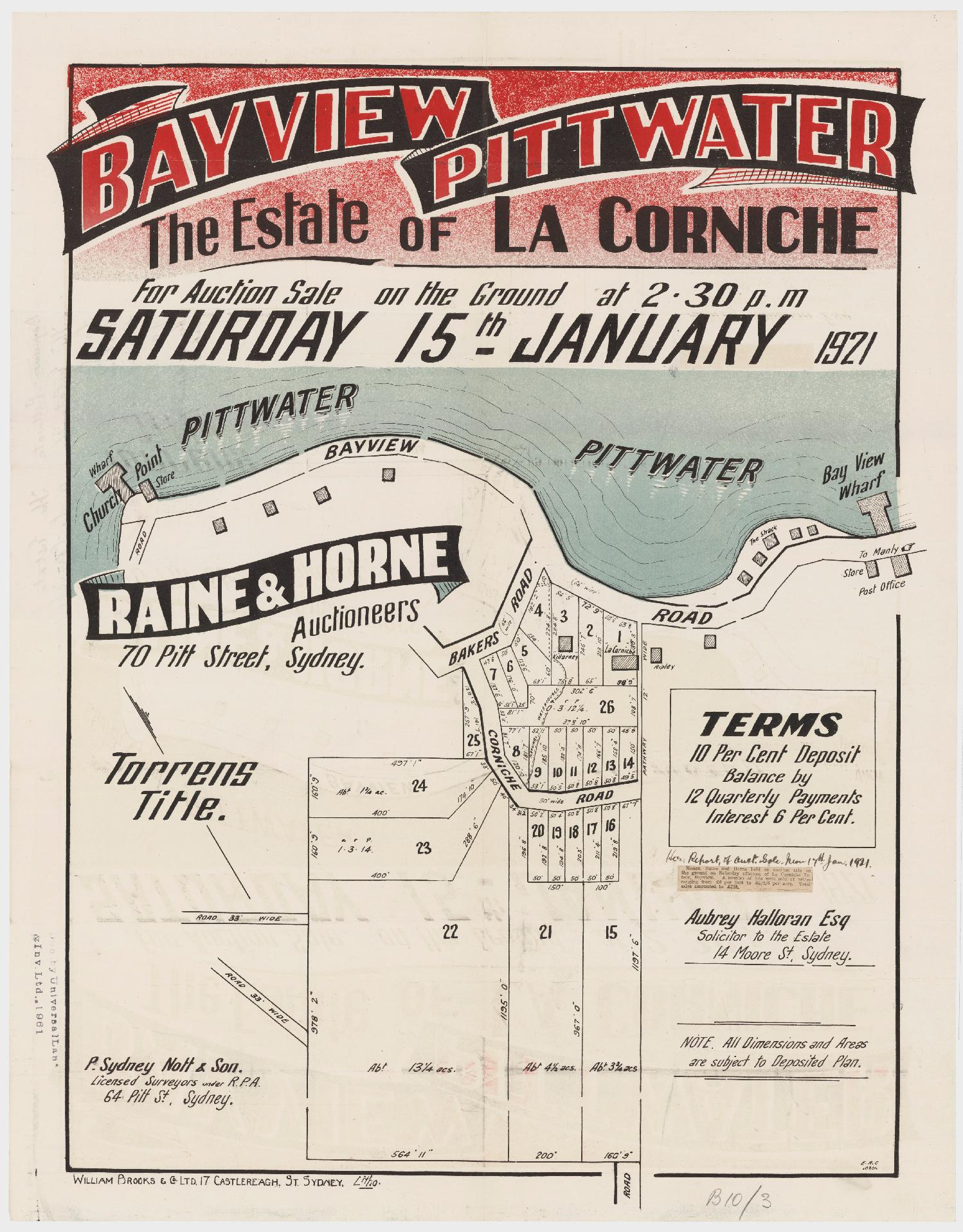
Bayview subdivision, January 15, 1921 - La Corniche Estate, Corniche road, Item c029500003 Bayview subdivisions folder, courtesy State Library of NSW - (Church Point verge - overlap and acrages)
Warringah Shire Council Minutes of Meetings records;
35. N. K. Bennett. 4/7/24. Submitting further plan of proposed re-subdivision of Lots. 4 and 24, P. P. 40106, Roche's Estate. A. Bayview : Resolved, - That he be informed of. the Board of Health's intention to proclaim portion of the land as unfit for — building purposes 3. Same. 3/7/24. submitting plans of (a) proposed re-subdivision of Lots 1, 9-15, By the Sea Estate, Mona Vale, D. P. 5497 and (b) proposed re-subdivision of Lots 13-14, Section 7, Lot 8, Section 8, Lots 6 and 8, Section 9, and Lots 78 Section 13, Turrimetta Estate. referred, to the Engineer for report. 37. Chapman and Faviell 7/7/24. submitting plan showing proposal to add a strip of R. V. Henderson's Lot 9, Simpson' s Garden Estate, Church Point to Lot 20 to give the latter access Sub. to Bayview Road. Resolved, - (Crc. Hewitt, Hitchcock) That the Engineer make an inspection, and if he is satisfied the plan be approved.
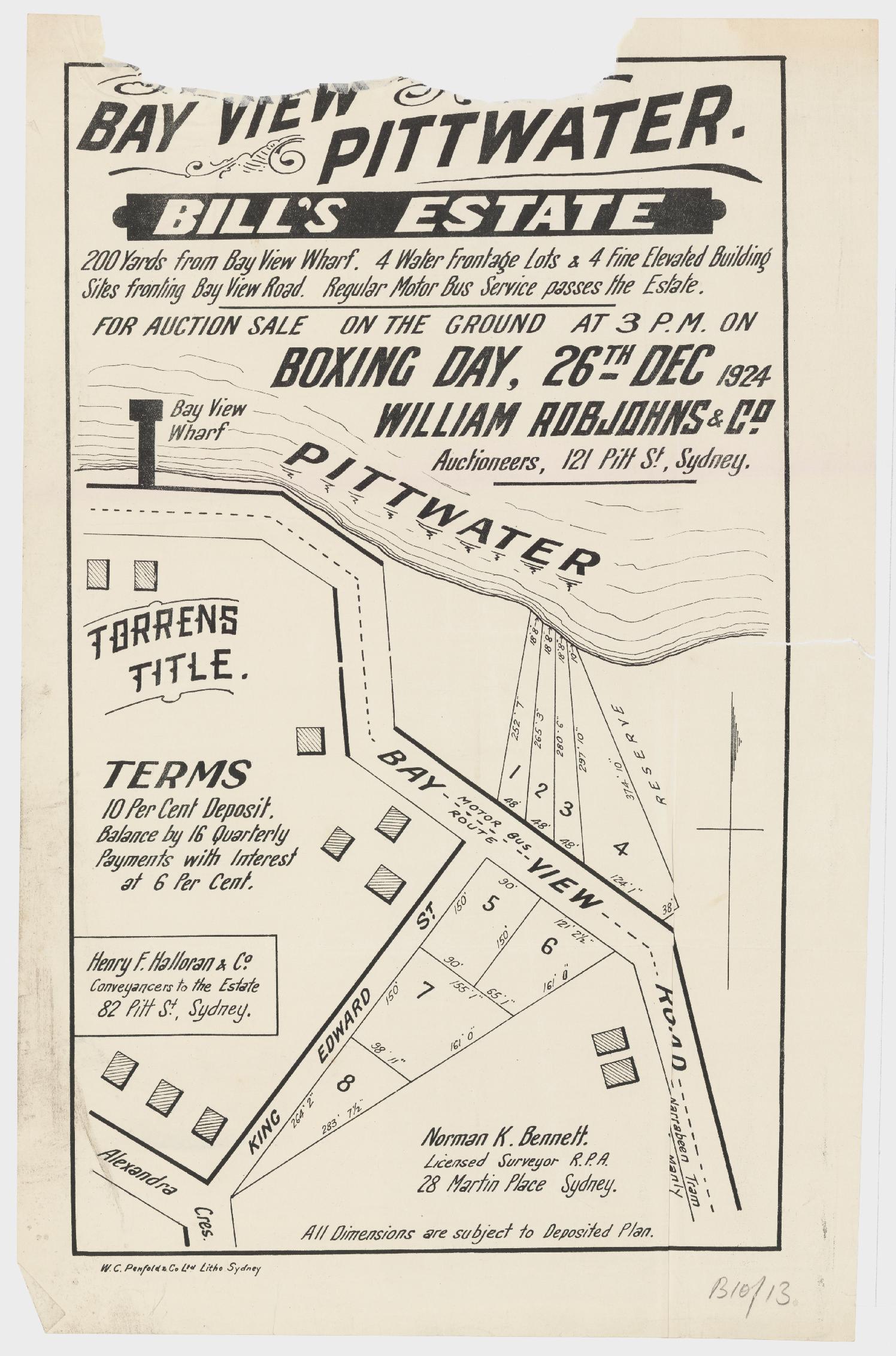
Bills Estate, Bayview Pittwater - Bay View Rd, Alexandra Cre. Boxing Day December 26th, 1924. Item: c029500013. Bayview subidivisions folder, courtesy State Library of NSW
BILL'S ESTATE
Popular Pittwater
On Boxing Day William Robjohns and Co. will submit eight building allotments at Pittwater, on tho ground, at 3 p.m. Four of the blocks are situate on the corner of Edwards-street and Bay view -road, about 200 yards from the Bayview Wharf, while the other four allotments are water-frontage blocks facing Pittwater and Sandy Beach. Pittwater is becoming more and more popular with the land-seelccr who is desirous of acquiring ail allotment handy to any of our wonderful beaches, and, in view of the splendid situation of these blocks, a brisk sale should result. The title of the land is Torrens, and 10 per cent deposit is required. Further information is obtainable from the auctioneers, William Robjohns and Co., 121 Pitt-street, Sydney. BILL'S ESTATE (1924, December 24). The Sun (Sydney, NSW : 1910 - 1954), p. 2 (LAST RACE EDITION). Retrieved from http://nla.gov.au/nla.news-article223574942
In 1924 John Roche married a Manly girl, Hester Clay:
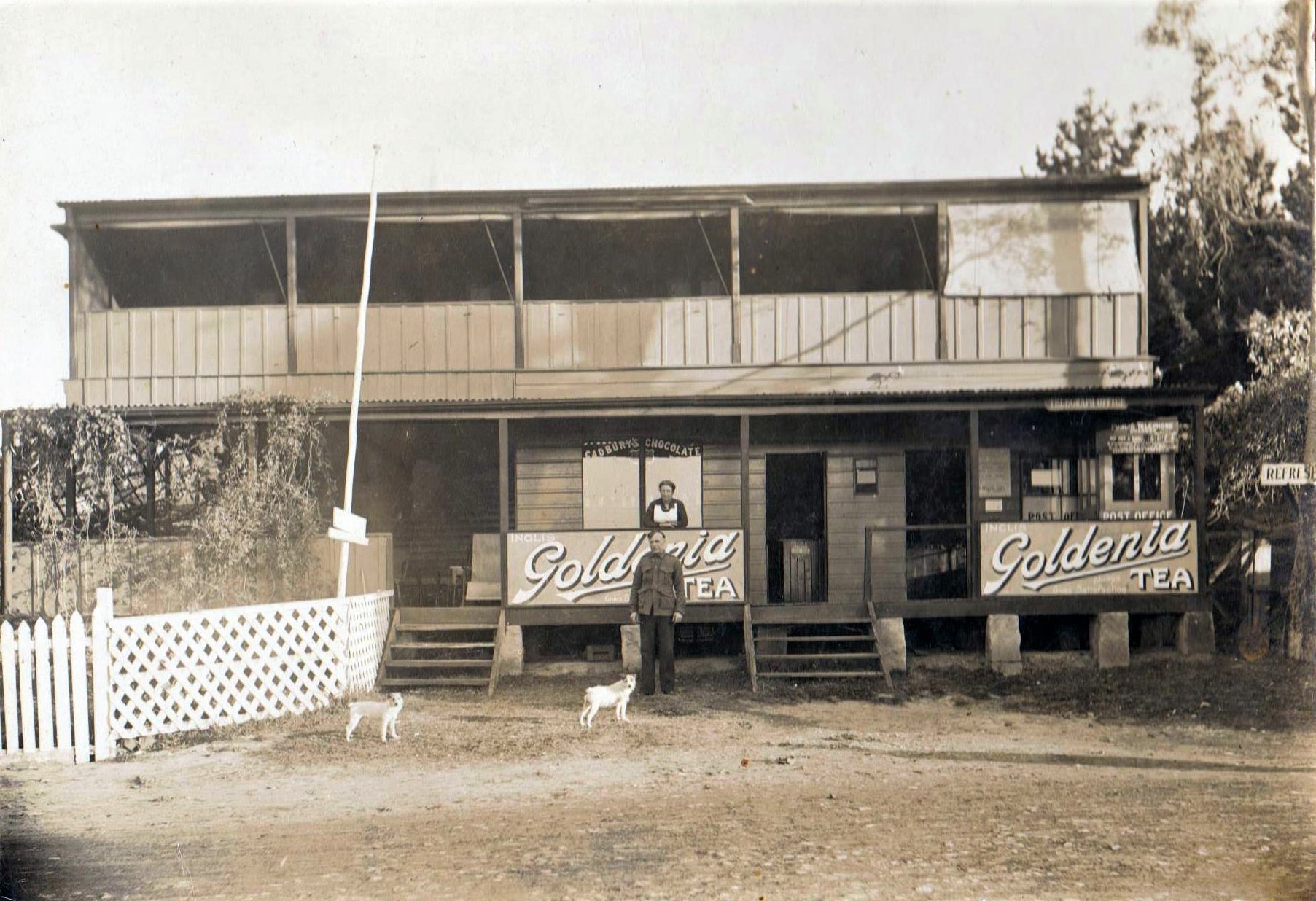
From Warringah Council records:
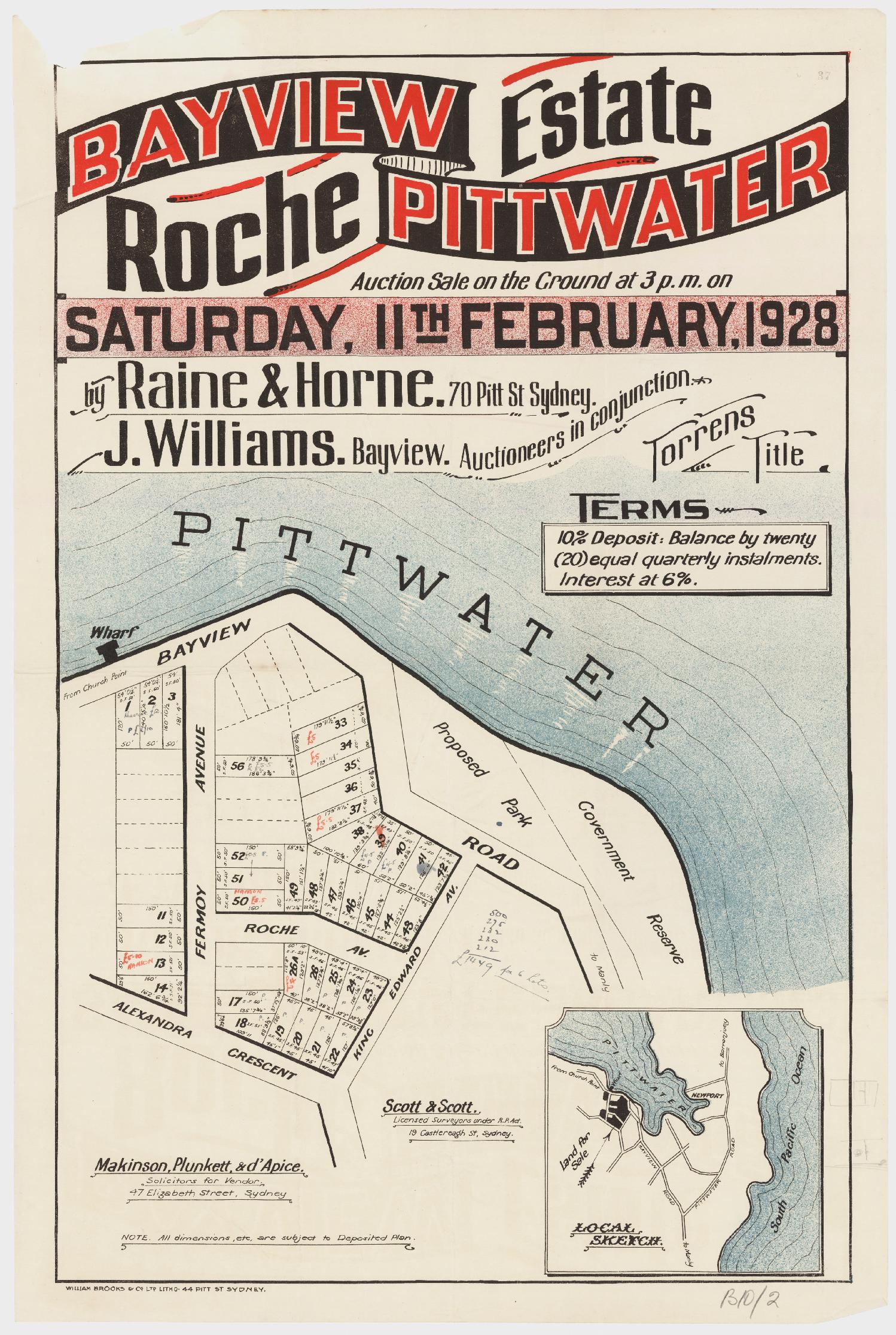
Bayview Roche Estate Pittwater - Bayview Rd, Alexander Crescent, King Edward Avenue, Fermoy Avenue - February 11, 1928. Item c029500002. Bayview subidivisions folder, courtesy State Library of NSW - NB 'Proposed Park'
BAYVIEW-PITTWATER
ROCHE ESTATE
Auction Sale on the Ground, 11th February, 1928
A Subdivision of the 39 Allotments. Practically opposite the main BAYVEW WHARF. 13 Lots with Frontages to Bayview Road. The balance to Subdlvisional Roads. All Lots are well protected from heavy winds.
'All Excellent Building Sites, with MAGNIFICENT OUTLOOK over Pittwater, and views extending to LION ISLAND and BARRENJOEY.
Good motor road from MANLY, and regular 'Bus Service.
NOTE THE TERMS: 10 PER CENT. DEPOSIT, balance by 20 quarterly Instalments.
Interest 10 per cent. Saturday 11th February at 3 p.m. Lithographs on application. Vendor's Solicitors: Makinson, Plunkett and D'Apice.
RAINE & HORNE. 70 PITT-STREET, J. WILLIAMS Auctioneers - In conjunction. Advertising (1928, February 3). The Sun (Sydney, NSW : 1910 - 1954), p. 2 (CRICKET STUMPS). Retrieved from http://nla.gov.au/nla.news-article224220959
The Shortage of Shell Grit
The closing of metropolitan beaches to the operations of shell grit merchants occasioned enquiries by the APPA regarding the possibility of having certain beaches reopened. In all instances, however, the efforts have been met with refusal. The dredging company at Bay-view in addition is requiring its entire output for smelting purposes and this important source of supply accordingly cannot be relied upon. The position was I represented to the Minister for Agriculture with the request that a survey of the position would be made and efforts made to ensure adequate sup-plies being made available. The reply received from the Minister for Agriculture, copy of which is given hereunder, is of very great interest in view of the advocacy of ground lime stone as a substitute and a much cheaper equivalent to shell grit:
"Dear Sir, POULTRY FARMERS (1946, December 19). The Leader (Liverpool, NSW : 1946 - 1949), p. 3. Retrieved from http://nla.gov.au/nla.news-article66417294
BRICKS FROM SAND
Warringah Shire Council decided last night to grant a special lease to Composite Brick Pty. Ltd. for the dredging of sea sand at Bayview, Pittwater.
The sand will be used to make clay-cement bricks. It will be taken from areas in the Newport channels that have been silted up by previous dredgings.
The Council rejected a proposal that a special lease be granted for an area at the head of the bay which the company is willing to reclaim by dredging. The company wanted to build a factory on the reclaimed land. BRICKS FROM SAND (1947, September 3). The Sydney Morning Herald (NSW : 1842 - 1954), p. 4. Retrieved from http://nla.gov.au/nla.news-article18041363
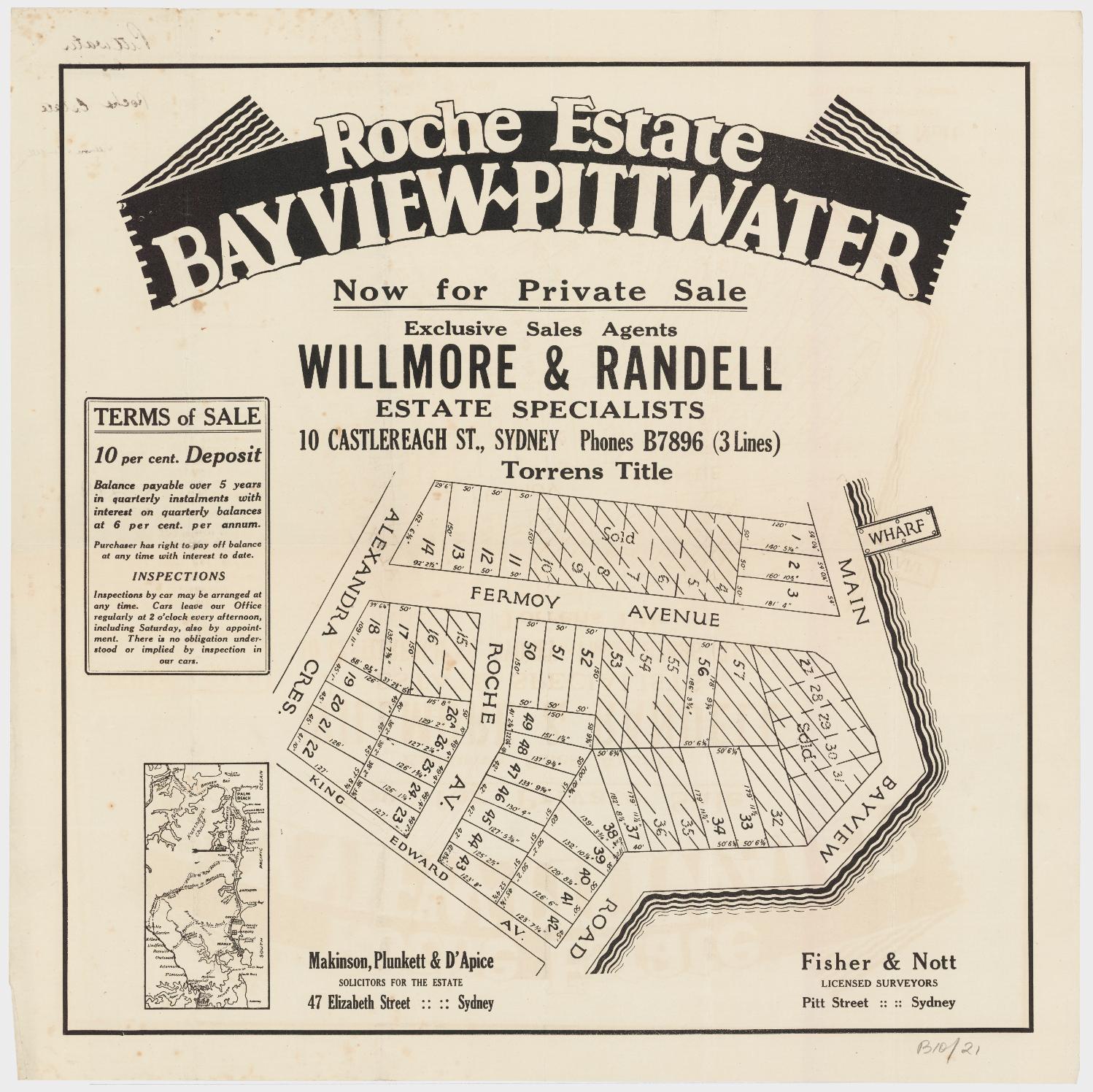
Roche Estate, Item c029500020 - Willmore and Randell Bayview subidivions folder, courtesy State Library of NSW
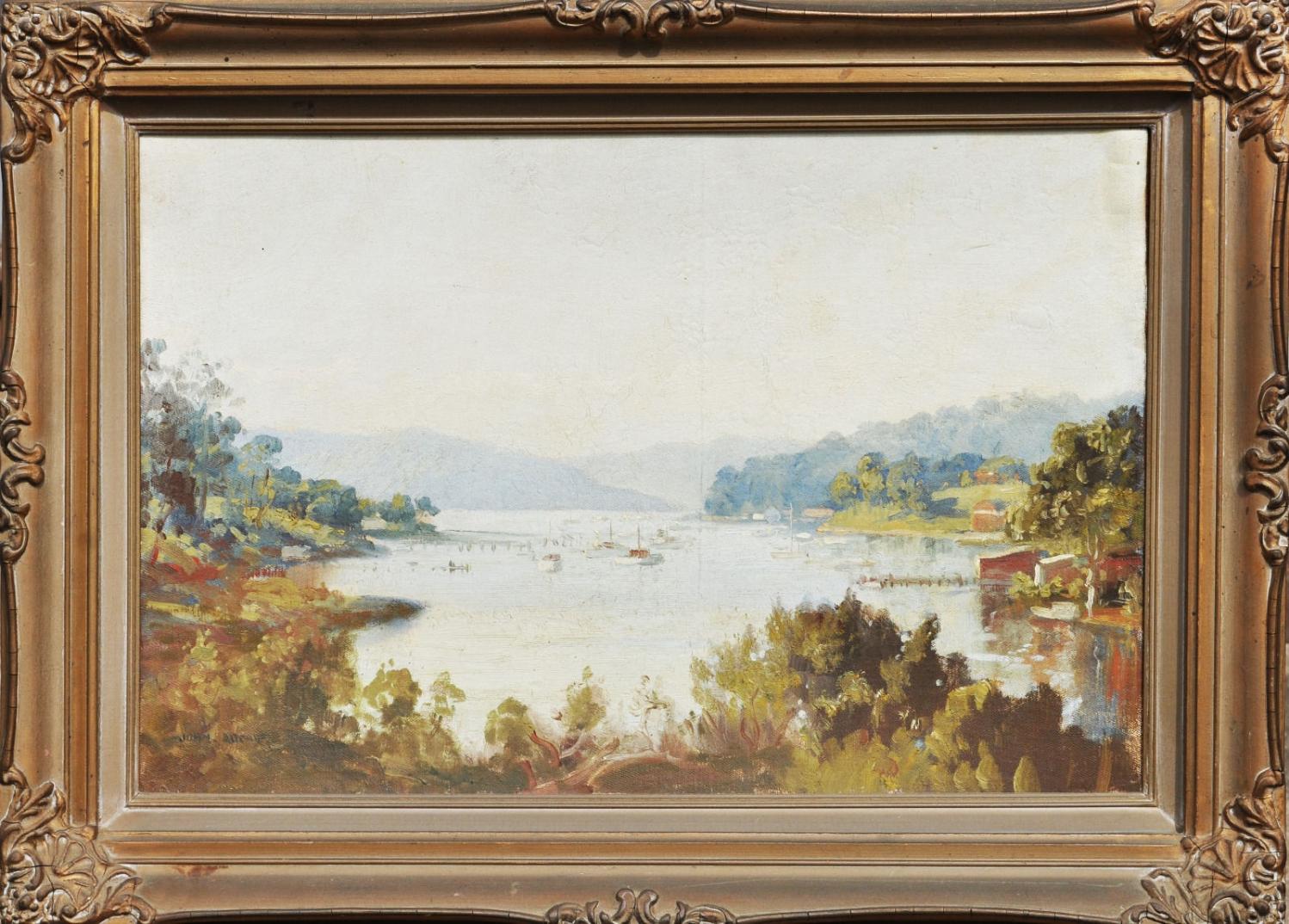
John Charles Allcot (1888-1973), artist, was born on 14 November 1888 at Liverpool, Lancashire, England, son of George Allcot, mariner, and his wife Mary Elizabeth, née Phillips. Educated at Arnot Street Board School, at the age of 14 John was apprenticed to Tillotson & Son Ltd, lithographers, and attended classes at the Liverpool Institute and School of Art. In 1906 he worked in the Mersey tugboats and next year sailed as a deck-boy in the barque, Invermark. He loved painting and would scrounge ship's paint, sailcloth and handkerchiefs with which to depict the sea, ships and life on board.
Arriving in Sydney in the Miltiades in 1909, Allcot signed on with the old clipper, Antiope. He worked in coastal, island and intercolonial vessels out of Sydney before giving up the sea in 1912. At the Pitt Street Congregational Church on 13 September 1915 he married Elsie Alma Johnson, but they later became estranged. Supporting himself by painting theatre sets, he obtained commissions for ship paintings from Sydney photographers and toured the countryside, completing landscapes which he exhibited regularly with the Royal Art Society of New South Wales from 1920. About this time he formed an enduring friendship with Phyllis Zanker.
He gained widespread recognition in the 1920s with a series of oil paintings (on the founding of the Australian colonies) which were later acquired by the Australasian Pioneers' Club. Other commissions followed. Allcot also worked as an illustrator and wrote articles about the sea for the Sydney Mail.
A fellow (1956) of the local Royal Art Society, Allcot was a member of the League of Ancient Mariners and of the Shiplovers' Society. He was elected an honorary life member (1962) of the Australasian Pioneers' Club and appointed O.B.E. in 1970. Survived by his wife, son and daughter, he died on 13 July 1973 at North Sydney and was cremated with Anglican rites. Extract from - Daina Fletcher, 'Allcot, John Charles (1888–1973)', Australian Dictionary of Biography, National Centre of Biography, Australian National University, http://adb.anu.edu.au/biography/allcot-john-charles-9334/text16387 - first published in hardcopy in Australian Dictionary of Biography, Volume 13, (MUP), 1993
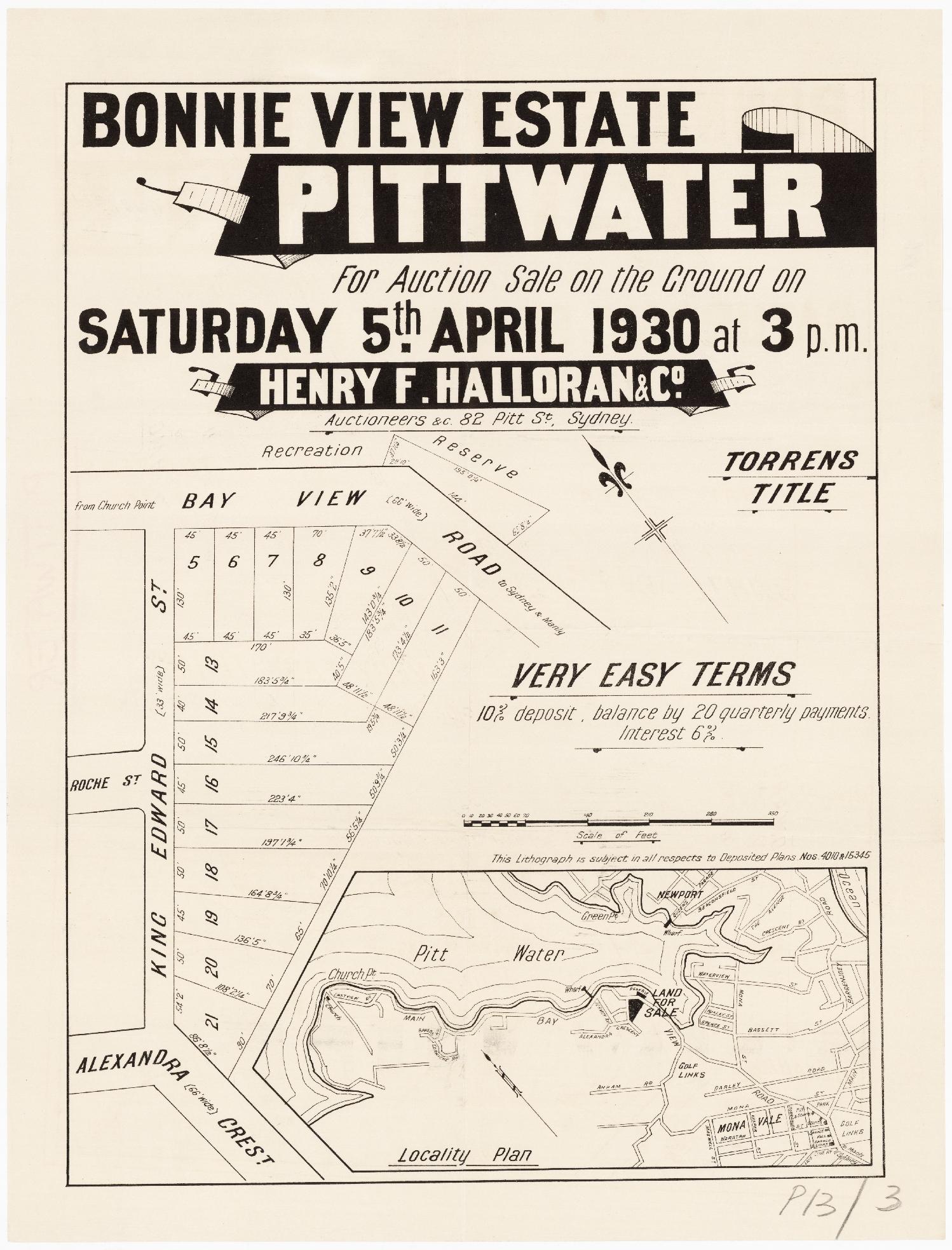
RECENT ACTIVITIES IN THE REAL PROPERTY MARKET
LAND BUYERS' CHANCE Bonnie View Auction at Pittwater
Magnificent surf beaches, four golf courses, a splendid road access from Manly and the northern suburbs— these are some of the things which should attract buyers to the auction sale on Saturday, April 5, of the Bonnie View Estate, Bayview-Pittwater. It is a glorious locality, and as land values in the district from Manly to Church Point and Palm Beach have increased enormously in the past few years, the sale should be well patronised. Only sixteen lots are for offer, comprising high, good building land, and most of them have far-reaching and permanent views over Newport and Pittwater as far as Lion Island. The situation of the estate is particularly good. It fronts a reserve to the shores of Pittwater, and has frontages to the main road. The auctioneers are Henry F. Halloran and Co., 82 Pitt Street, Sydney, from whom lithos. are available, and the sale will commence at 3 p.m. RECENT ACTIVITIES IN THE REAL PROPERTY MARKET (1930, March 29). Daily Pictorial (Sydney, NSW : 1930 - 1931), p. 10. Retrieved from http://nla.gov.au/nla.news-article246125976
Mr. John Orr, a retired sheep raiser from New Zealand, who recently came over to N.S.W. to live, bought about 60 acres of swamp land at Bayview, Pittwater, and has constructed there a full championship golf course of nine holes. With flood gates to keep the flood tides off, he had the mud flats cleared and the timber grubbed from them. It is estimated that between 15,000 and 20,000 tons of timber, growing and rotting, was removed before the course could be laid. To-day there stand the fairways and greens of modern links, where a few years ago only swamp served as mosquito-breeding ground. And Mr. Orr's home is a sanctuary for birds, with drinking fountains for the feathered, friends. SPORTING ITEMS. (1930, May 23). The Richmond River Herald and Northern Districts Advertiser (NSW : 1886 - 1942), p. 4. Retrieved from http://nla.gov.au/nla.news-article126353133
NEWPORT. NEWPORT.
AIR MAIL BASE.
TO THE EDITOR OF THE HERALD.
Sir,-I am directed to suggest the use of Pittwater as the base for the air mail service in place of Rose Bay, and to express our sur-prise that this site should have received such small consideration, in view of its apparent suitability for the purpose.
There we have a sheltered stretch of water about 6 miles long by an average of one mile broad, and, further, with an east-west width at the southern end of two miles, and a large area of flat land to the south and south-east, to facilitate the take off'of 'planes to the south.
Then, for building docks, etc., there are about 40 acres of the Winnererremy Swamp which needs reclaiming. Should this be thought too exposed, or in any other way, un-suitable, there is McCarr's Creek, having deep water of about 400 yards wide for about three-quarters of a mile, and about 200 yards wide for a further third of a mile, and shel-tered from every wind that blows.
Ample cheap land is also available for development. We feel that the authorities would do well to investigate Pittwater further before decirine elsewhere.
I am, etc.,
F. T. JEFFERY,
hon. secretary,
Warringah Direct Transport League.
July 9. AIR MAIL BASE. (1937, July 12). The Sydney Morning Herald (NSW : 1842 - 1954), p. 6. Retrieved from http://nla.gov.au/nla.news-article17372302
Sydney, 15th October, 1948.
OBJECTIONS TO SPECIAL PURCHASES.
IT is Hereby notified that applications have been lodged for the purchase of areas particularised below. Any objections should be accompanied by a deposit of £10 in each case, and lodged with the Metropolitan District Surveyor, Sydney, on or before the 12th November, 1948.
A. E. JONES, Under-Secretary for Lands. Land District—Metropolitan; Shire—Warringah.
Parish Narrabeen, county Cumberland; Special Purchase 47-10 of an area below high-water mark of Pittwater, Mona Vale, on the frontage to C.T., volume 2,402, folio 11. Applicant, estate of the late Thomas Sidney Douglas. S. 48-11,827.
Parish Narrabeen, county Cumberland; Special Purchase 46-36 of an area below high-water mark of Pittwater, Wingi Jimmi Point, on the frontage to lot 14, d.p. 9,500. Applicant, Mrs. Vera Adele Taylor. S. 47-13,211. OBJECTIONS TO SPECIAL PURCHASES. (1948, October 29). Government Gazette of the State of New South Wales (Sydney, NSW : 1901 - 2001), p. 2900. Retrieved from http://nla.gov.au/nla.news-article224783922
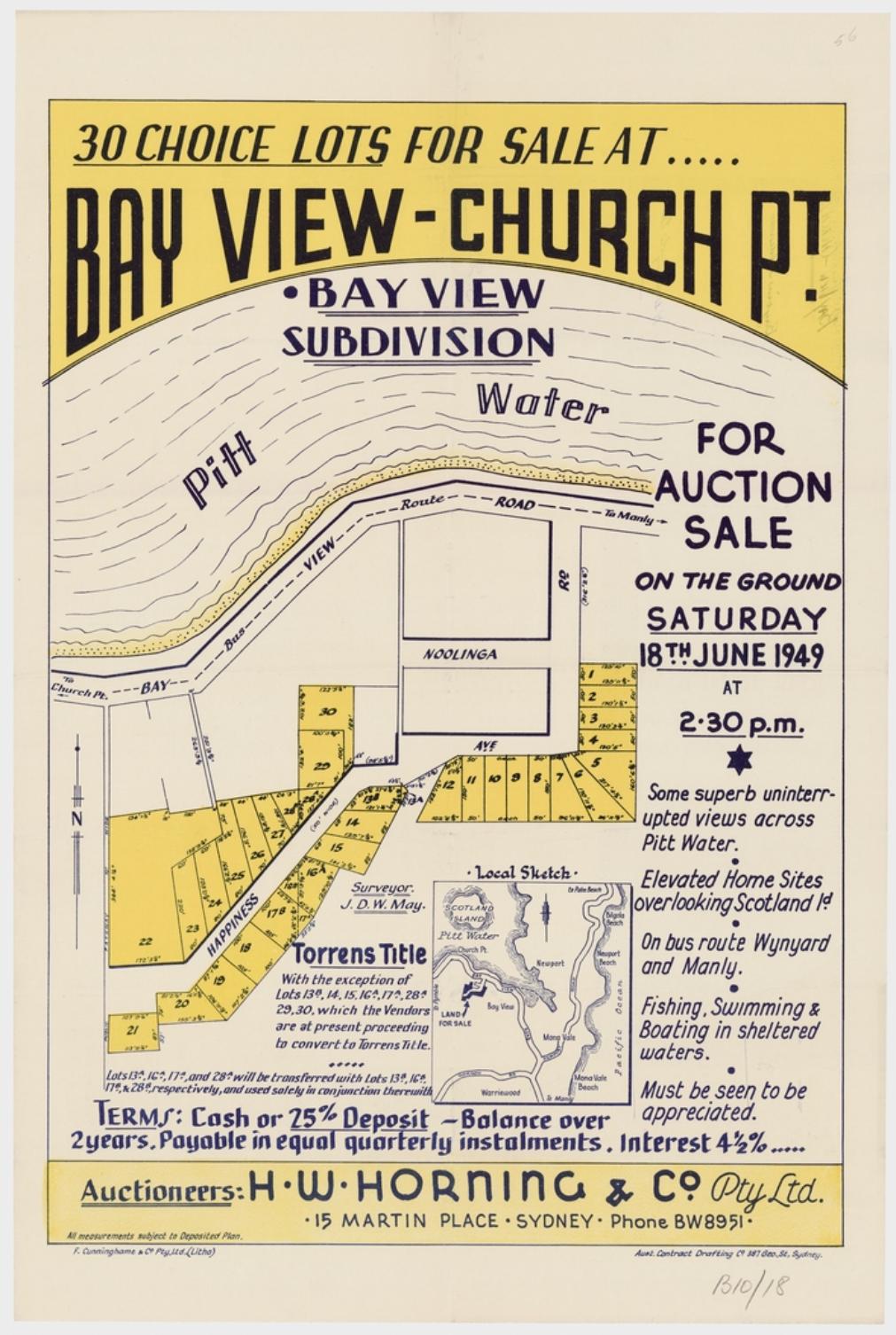
Bayview subdivision, June 18, 1949, Item c029500017h Bayview subidivions folder, courtesy State Library of NSW
List of Streets in Bayview
Alexandra Crescent: Roche subdivisions - named for Alexandra of Denmark (Alexandra Caroline Marie Charlotte Louise Julia; 1 December 1844 – 20 November 1925) was Queen consort of the United Kingdom and the British Dominions and Empress consort of India from 1901 to 1910 as the wife of King Edward VII. At the age of sixteen, she was chosen as the future wife of Albert Edward, Prince of Wales, the heir apparent of Queen Victoria. They married eighteen months later in 1863, the same year her father became king of Denmark as Christian IX and her brother was appointed king of Greece as George I. She was Princess of Wales from 1863 to 1901, the longest anyone has ever held that title, and became generally popular; her style of dress and bearing were copied by fashion-conscious women. Largely excluded from wielding any political power, she unsuccessfully attempted to sway the opinion of British ministers and her husband's family to favour Greek and Danish interests. Her public duties were restricted to uncontroversial involvement in charitable work. On the death of Queen Victoria in 1901, Albert Edward became king-emperor as Edward VII, with Alexandra as queen-empress. She held the status until Edward's death in 1910. She greatly distrusted her nephew Wilhelm II, German Emperor, and supported her son George V during the First World War, in which Britain and its allies fought Germany.
Annam Road:
Araluen Place: an Eastern States Aboriginal word meaning “singing waters,” “running waters” or “place of lilies.”
Barkala Road: an Aboriginal word meaning “bush shades''
Bayview Place: named for the suburb
Beaumont Crescent
Belair Place
Bimbimbie Place: An Aboriginal word meaning ''Place of many birds''.
Binnowee Place: named from the Aboriginal word meaning “a green place”.
Cabbage Tree Road: named for the presence of these plants. NB; on 1886 map named 'Cabbage Tree Flat'.
Captain Hunter Road: named for Captain John Hunter, who surveyed what is called at present McCarrs Creek
Corniche Road: Corniche; French for 'a road hugging the coast'. Three famed corniche roads of the Côte d'Azur in the French Riviera run between the sea and mountains from Nice eastward toward Menton. They are known as the Corniche Inferieure (or Basse Corniche) along the coast, the Moyenne Corniche slightly inland, and the Grande Corniche along the upper cliffs.
Darley West Street: named after Bassett-Darley Estate
Fermoy Avenue: Roche Subdivisions - Fermoy (Irish: Mainistir Fhear Maí, meaning "monastery of the Men of the Plain") is a town on the River Blackwater in east County Cork, Ireland. The Roche - Collins family were from County Cork originally - see John Collins of Avalon
Gerroa Avenue: an Aboriginal word meaning “meeting place of birds”
Gilwinga Drive: “Gillwinga” was recorded in 1903 as an Aboriginal language word meaning “cedar tree” around and to the north of the Bellinger River on the far north coast of NSW (Science of Man). This word and meaning were in 1952 attributed to the language of the Kumbainggiri people (McCarthy). At Grafton on the Clarence River in the same region, a local meaning for “gillwinga” was stated to be “home of the wattle” - some sources states means 'yellow flowers'.
Gulia Street: - uncertain, however, The name Giulia means Youthful, Downy and is of Italian origin and is denoted for females and of Italian origin.
Hale-Smith street: Warringah Shire Council Minutes of Meetings provides: Winji Jimmi Subdivision - Heydon and Heydon, 3/1/ 19, forwarding cheque for £190, for Winji Jimi Subdivision road construction : Resolved, That the writers be informed that the Council is prepared to carry out the rork in accordance with the letter so far as the money will go, but that it 'will probably not be able to start the work before the 26th inst., and that it will not object to the selling of the allotments before the subdivision road is constructed. It was decided to suggest that the new street be named Hale-Smith Street.
Heron Place: named for the birds
Ilya Avenue: Ilya is the East Slavic form of the male Hebrew name Eliyahu (Elijah), meaning "My God is Yahu/Jah". It comes from the Byzantine Greek pronunciation of the vocative (Elia) of the Greek Elias.
Jendi Avenue: Some state the name Jendi is of Islamic / Muslim origin and means "Immortal", others state the name Jendi means "Jolly, positive warrior".
Kamilaroi Road: Gamilaraay, also spelled Kamilaroi, is an Australian Aboriginal language which was spoken over a vast area of north-central New South Wales when Europeans began colonising Australia. Gamilaraay country extended from as far south as Murrurundi on the Great Dividing Range, to Tamworth, Narrabri, Moree, Boggabilla, Mungindi, Collarenebri, Walgett and Gunnedah. The name Gamilaraay consists of two parts: gamil meaning 'no' and araay meaning 'having', that is 'the people who have gamil for no'. This method of naming people after their word for 'no' is widespread throughout New South Wales and Victoria; for example, the western neighbours of the Gamilaraay, the Yuwaalaraay, say waal for 'no'.
Kananook Avenue: Mark Foy Subdivisions named for one of Bayview resident and landholder Mark Foy's yachts:
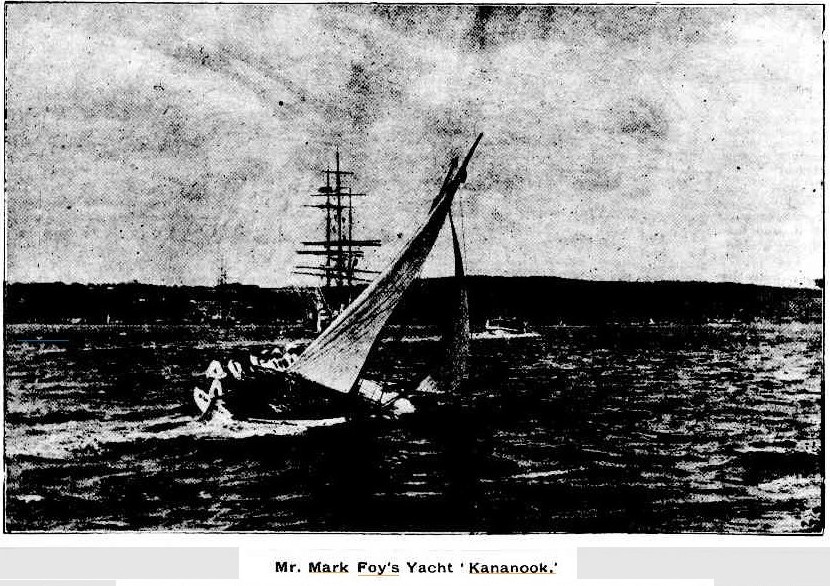
The Kananook, 26ft., quarter - deck, centre - board boat, hails from Melbourne, where she was first known to us as the ' Mayflower,' successfully competing at the Victoria Regatta Carnival, in November, 1888. On arrival here, her name was altered, and although taking part in a number of Sydney and Botany races, she has not been victorious.
Her owner is Mr. Mark Foy, the well-known draper of this city, who has enrolled the ' Kananook ' in the Sydney Amateur, Port Jackson, East Sydney, and Botany Sailing Clubs. AQUATICS. (1891, April 11). Illustrated Sydney News (NSW : 1853 - 1872), p. 3. Retrieved from http://nla.gov.au/nla.news-article63616436
Kara Crescent:
Kiah Close: an Aboriginal word meaning 'a beautiful place'.
Kiewa Close: The name Kiewa is an Aboriginal word, derived from cy-a-nun-a, meaning sweet, and wher-ra, meaning water. - of Victorian origin; For thousands of years prior to the arrival of European settlers, the Dhudhuroa and Yaitmathang Aboriginal Clans roamed the Kiewa and Mitta Valleys... ... They hunted and gathered along the valley and the cool, clear waters of the river, which was given the indigenous name “Kiewa” meaning "sweet water".
King Edward Avenue: Roche subdivisions, earliest named of roads off main Bay View, later Pittwater Road - Named for Edward VII (Albert Edward; 9 November 1841 – 6 May 1910) was King of the United Kingdom of Great Britain and Ireland and Emperor of India from 22 January 1901 until his death in 1910. He was the eldest son of Queen Victoria and Prince Albert of Saxe-Coburg and Gotha, Prince of Wales and heir apparent to the British throne for almost 60 years. As king, Edward played a role in the modernisation of the British Home Fleet and the reorganisation of the British Army after the Second Boer War. He reinstituted traditional ceremonies as public displays and broadened the range of people with whom royalty socialised. He fostered good relations between Britain and other European countries, especially France, for which he was popularly called "Peacemaker", but his relationship with his nephew, the German Emperor Wilhelm II, was poor. The Edwardian era, which covered Edward's reign and was named after him, coincided with the start of a new century and heralded significant changes in technology and society, including steam turbine propulsion and the rise of socialism. He died in 1910 in the midst of a constitutional crisis that was resolved the following year by the Parliament Act 1911, which restricted the power of the unelected House of Lords.
Konda Close: an Aboriginal word/name for the Cabbage Tree Palm (this plant was also called Bang'ly in this area as well).
Kookaburra Close: named for the bird, there are a lot of kookaburras in Bayview.
Kunari Place: an Aboriginal word/name for 'flat country'.
Lentara Road: an Aboriginal word meaning 'dawning of the day'.
Loquat Valley Road: named for the loquat fruit - there were a some these trees in this vicinity - named by Sir Patrick Gordon Taylor, this also became the name of the school he established here.
Maxwell Street:
Mccarrs Creek Road: was originally M'Garrs Creek road - Tenders for building this were advertised in late 1890:
Department of Public Works, Roads and Bridges Branch.
Sydney, 28th November, 1890.
TENDERS will be received up to 11 o'clock 11 a.m. on TUESDAY, the 9th December. 1890, for Contracts
43T Manly to Pittwater-road, 44T Pittwater- to Barranjoey-road and 45T M'Garr's Creek-road, Pittwater.
Tenders to be addressed to the Roads Office, Sydney where specifications, &c., may be seen. Advertising (1890, December 1). The Daily Telegraph (Sydney, NSW : 1883 - 1930), p. 2. Retrieved from http://nla.gov.au/nla.news-article235798340
Minkara Road: Aboriginal word/name for the Silver Wattle Tree, Acacia dealbata, the silver wattle, blue wattle or mimosa, is a species of flowering plant in the legume family Fabaceae, native to southeastern Australia in New South Wales, Victoria, Tasmania and South Australia.
Minmai Road: an aboriginal word meaning 'giant lily' - possibly referring to the Gymea Lily(which is also known as the Giant Lily), Doryanthes excelsa, a flowering plant in the family Doryanthaceae that is endemic to coastal areas of New South Wales near Sydney. It has sword-like leaves more than 1 metre long and it grows a flower spike up to 6 metres high.
Mona Street:
Nangana Road: an Aboriginal word meaning 'to see'.
Narla Road: Narla is an Aboriginal word meaning 'red gum tree' (Source: "Australian Aboriginal Words and Place Names" by S.J. Endacott). Narla is an aboriginal name, which is usually used as a name for a girl.
Noolinga Road: an Aboriginal word meaning 'Darkness or dark'.
Old Samuel Street: possibly named after Samuel Terry, uncle of John Terry Hughes, land holder - see under Extras. Also worth noting, although this may have been associated with the then State Government's development of the Village of Turimetta (Mona Vale Street Names):
Department of Roads and Bridges
Sydney , May 23, 1889
TENDERS will be received at this Office until 11 o'clock on FRIDAY. May 31, from persons willing to contract for
Section 15, road, Manly to Pittwater
Section 16, road Bay View to Foley's Hill, Pittwater
Section 17, road Bay View to Foley's Hill, Pittwater.
Tenders to be addressed to Roads and Bridges Department, where Plans and Specifications may be seen. Advertising (1889, May 25). The Australian Star (Sydney, NSW : 1887 - 1909), p. 8. Retrieved from http://nla.gov.au/nla.news-article227316057
SHIRE OF WARRINGAH.—Naming and Renaming of Roads.—Ordinance 30, Clause 53, Local Government Act.— Notice is hereby given that the undermentioned roads have been named or renamed in accordance with section 249 (a) of the Local Government Act:—
Past Name or Names and Location and New Name.
Parish of Narrabeen.
Road leading north-easterly through portion 87 and between portions 62, 68 and 93 and 75, off the old Lane Cove to Mona Vale road—Walter-road.
Northern part of road formerly known as Samuel-street, Mona Vale, prior to the deviation and realignment of Samuel street—Old Samuel street. SHIRE OF WARRINGAH.—NAMING AND RENAMING OF (1953, May 1). Government Gazette of the State of New South Wales (Sydney, NSW : 1901 - 2001), p. 1469. Retrieved from http://nla.gov.au/nla.news-article220014297
CROWN LAND SALE, ALLOTMENTS £6 to £17 each. Village of Turimetta, close to Rock Lily Hotel Pittwater; day of sale, 25th January, 1897 at 11.30 a.m. E. C. V. Broughton. Auctioneer, 260 Pitt-st. Sydney. Advertising. (1896, December 26). Evening News (Sydney, NSW : 1869 - 1931), p. 8. Retrieved from http://nla.gov.au/nla.news-article108215572
Crown Land Sale. As announced in our advertising columns, Mr. E.C. V. Broughton, under instructions from the Minister for Lands, will conduct a Crown land sale at his rooms, 250 Pitt-street. The land to be offered comprises sixty-six blocks in the village of Turimetta, adjoining the Rock Lily Hotel, Pittwater. Areas, from ½ s to nearly 3s. Upsets, from £6 to £22 per lot.. Terms, quarter cash, balance in three equal annual payments, interest 5 per cent. From the inquiry, evinced it is anticipated that a successful sale will result. Crown Land Sale. (1897, January 27). Evening News (Sydney, NSW : 1869 - 1931), p. 3. Retrieved from http://nla.gov.au/nla.news-article108861575
Prior to then an 1886 Land map indicates previous names for this 'Recreation Area' and that 86 acres and 83 acres were set aside on February 8th 1870 and it was envisioned people would go camping in a black swamp! Perhaps there were plenty of cow pats about, good for keeping mosquitoes at bay by burning the dried ones prior to the invention of insecticides. Interestingly, Mona Vale Beach was called 'Bongin Reach' on this chart:
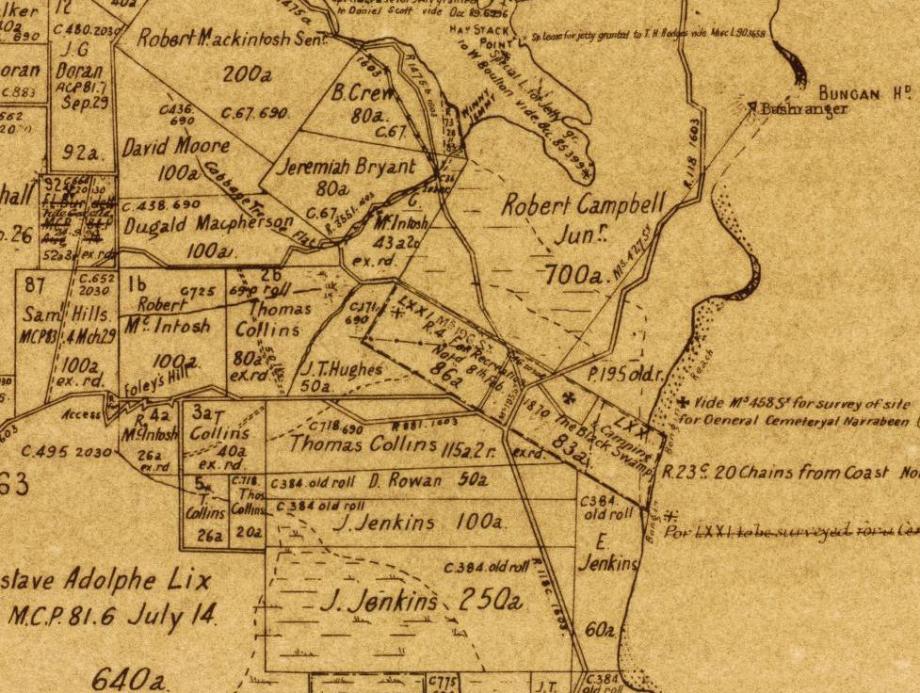
Parish of Narrabeen, County of Cumberland [cartographic material] : Metropolitan Land District, Eastern Division N.S.W. 1886. MAPG8971.G46 svar (Copy 1). Courtesy National Library of Australia
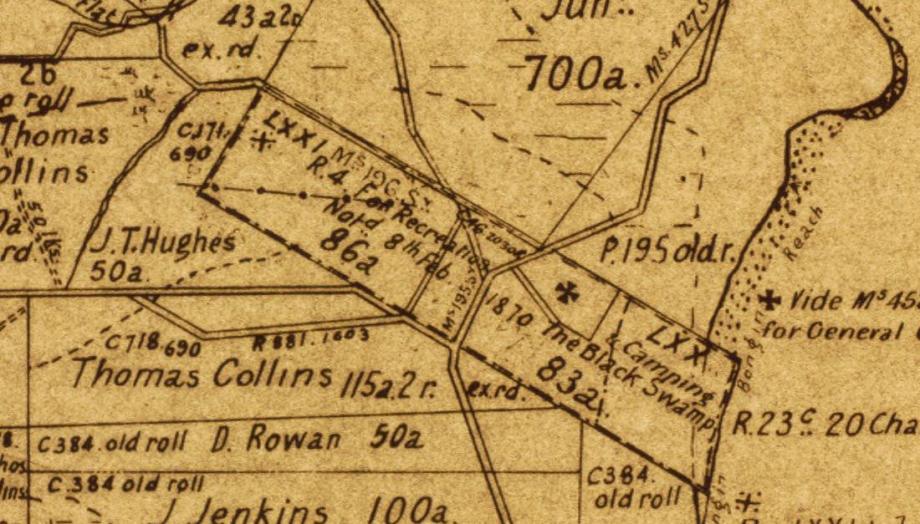
The Gazette Notice:
Department of Lands,
Sydney, 8th February, 1870.
HIS Excellency the Governor, with the advice of the Executive Council, directs it to be notified, that in pursuance of the provisions of the 4th section of the Crown Lands Alienation Act of 1861, the land specified in the Schedule appended hereto shall be reserved from sale for Recreation and for Camping.
WILLIAM FORSTER.
No.4 County of Cumberland, parish of Narrabeen, at Pitt Water, 180 acres: Commencing on the sea-coast at the north-eastern corner of E. Jenkins' 60 acres ; and bounded thence on the south-west by the north-eastern boundaries of that land, D. Rowan's 50 acres, Thomas Collins' 115 acres 2 roods, and J. T. Hughes' 50 acres, being in all a line bearing north 60 degrees west 93 chains; on the north-west by (lie south-eastern boundary-line of J. T. Hughes' 50 acres aforesaid, bearing north 30 degrees east 19 chains to the margin of Winnererremy Swamp ; thence by the margin of that swamp northerly about 4 chains; on the north-east by a line (dividing it from Robt. Campbell's 700 acres grant) bearing south 60 degrees east 85 chains 20 links to the sea-coast; and on the east by the sea-coast southerly, to the point of commencement. Government Gazette Notices (1870, February 8). New South Wales Government Gazette (Sydney, NSW : 1832 - 1900), p. 306. Retrieved from http://nla.gov.au/nla.news-article223285883
The State Government subsequently sold off the 86 acres shown above and below - to create the 'Village of Turimetta':
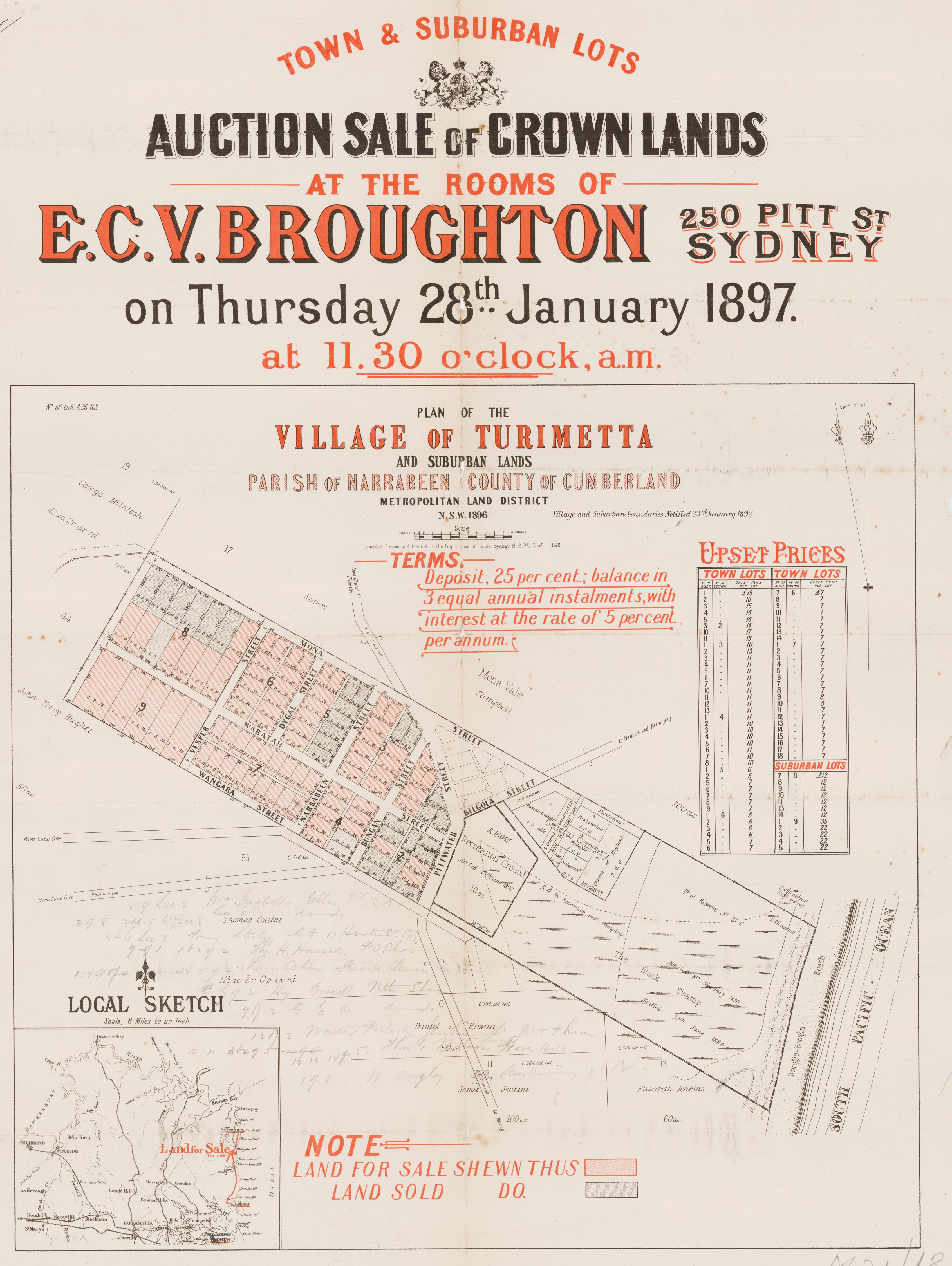
Plan of the Village of Turimetta and Suburban Lands - Parish of Narrabeen - Vesper St, Mona Street, Allen St, Pittwater St, Wangara St, 1897. Item c046820016 , from album Mona Vale Subdivisions, courtesy State Library of NSW - NB: John Terry Hughes land holding.
Parkland Road:
Peita Crescent: an Aboriginal word meaning 'tree'.
Pindari Place: Aboriginal word meaning 'high ground' Also - historically, an irregular horseman, plunderer, or forager attached to a Muslim army in India who was allowed to plunder in lieu of pay. The name is Marathi and probably derives from two words, meaning “bundle of grass” and “who takes.”
Pittwater Road:
Quarter Sessions Road: AN ACCOMMODATION ROAD
In conformity with the provisions of the Act of Council, William V , No 11, section 21, George Brown being the owner of portion No 6, parish of Narrabeen, applied to the Chairman of the Quarter Sessions for an accommodation road from his land to run through land supposed to be the property of trustees of the Wesleyan Church Dr Tibbetts and Alfred McIntosh being part of Olivers grant, portion 7, until it should meet the road from Manly, at the public wharf Church Point, Pittwater, such being the nearest highway. Evidence was given by the applicant that he had no thoroughfare nor right of away to get to a highway from his land as described consisting of 11 acres, and the accommodation road he now applied for was the best available, considering all the interests. No objection was raised to the road being made and the application was granted by His Honor. QUARTER SESSIONS. (1897, November 19). The Sydney Morning Herald (NSW : 1842 - 1954), p. 3. Retrieved from http://nla.gov.au/nla.news-article14100043
The track that led from Church Point to Brown’s estate was replaced some years ago by a narrow road to the spot where the house stood, now a turning point for motorists. The first half of this road is Quarter Sessions Road, and it may be mentioned in passing that a Quarter Sessions Road is a road established under the Public Roads Act following a reference to the Court of Quarter Sessions. This application is made to the Court by the proprietor of land alienated by the Crown, to no part of which grant any road of access had been provided to the nearest high-way. The portion through the old “Waterside” Estate is named Brown’s Road. WARRINGAH SHIRE COUNCIL.—Re-naming of Upper Section of Quarter Sessions Road, Church Point as Captain Hunter Road.—Notice is hereby given that the Council, in accordance with the provisions of section 249 of the Local Government Act, 1919, as amended, has re-named the upper section of Quarter Sessions Road, Church Point, as Captain Hunter Road. J. MORGAN, Shire Clerk, Shire Hall, Brookvale. 9337—$2.40 WARRING AH SHIRE COUNCIL.—RE-NAMING OF UPPER SECTION OF QUARTER SESSIONS ROAD, CHURCH POINT AS (1970, August 7). Government Gazette of the State of New South Wales (Sydney, NSW : 1901 - 2001), p. 3154. Retrieved from http://nla.gov.au/nla.news-article220163356
Rednal Street (Mona Vale-Newport-Bayview): Rednal was known by the Anglo-Saxon name, Wreodan Healh, meaning 'thicket nook'. Rednal is a residential suburb on the south western edge of metropolitan Birmingham, West Midlands.
Reserve Lane:
Roches Avenue: named for the Roche family.
Samuel Street: possibly named after Samuel Terry, uncle of John Terry Hughes, land holder - see under Extras.
In Warringah Shire Council Minutes of Meetings a H. Howe is requesting in early 1920 that this road be 'cleared' and made navigable. This may refer to the road now named 'Old Samuel Street' (see above).
Sydney, 11th October, 1985.
NOTIFICATION UNDER THE PUBLIC ROADS ACT, 1902, OF RESUMPTIONS AND WITHDRAWALS OF LANDS FOR ROADS, RESUMPTIONS AND WITHDRAWALS OF SEVERED LANDS, OF DECLARATION OF ROADS TO BE PUBLIC ROADS AND OF CLOSING OF ROADS
IN pursuance of the provisions of the Public Roads Act, 1902, the lands hereunder described, are resumed or withdrawn for road; such roads and the additional roads particularized hereunder are hereby declared to be public roads and dedicated to the public accordingly (except where otherwise stated); the lands hereunder described are resumed or withdrawn as severed lands; and the roads specified are hereby closed.
JANICE CROSIO, Minister for Natural Resources.
Descriptions
Parish Narrabeen, County Cumberland, Land District Metropolitan, Shire Warringah
Widening of Samuel Street, Mona Vale—D.P. 586250. (Council's reference: ESF:4232.) MN85 H 148.
Land resumed for road: Lot 3. Title affected and area resumed: C.T. 13385-81 (the whole) (1 211 square metres). NOTIFICATION UNDER THE PUBLIC ROADS ACT, 1902, OF RESUMPTIONS AND WITHDRAWALS OF LANDS FOR ROADS, RESUMPTIONS AND WITHDRAWALS OF SEVERED LANDS, OF DECLARATION OF ROADS TO BE PUBLIC ROADS AND OF CLOSING OF ROADS (1985, October 11). Government Gazette of the State of New South Wales (Sydney, NSW : 1901 - 2001), p. 5383. Retrieved from http://nla.gov.au/nla.news-article231293303
Sunnyridge Place: it's a sunny ride.
Taminga Street: Taminga - Aboriginal word/name for the White Gum Tree. Also; Taminga is white Australian wine grape variety that was developed in the late 20th century by viticulturalist and grape breeder A.J. Antcliff.
Torumba Avenue: an aboriginal word meaning or name for Eucalyptus resinifera the Red Mahogany - from Darug - according to Arthur Capell in 1970, Darug was the name of the Aboriginal language group for most of the Sydney region. The Darug language has been divided into two dialects according to location; coastal and inland - the border between these two dialects was fi rst mentioned by diarist Watkin Tench in 1793 as being just to the west of Parramatta. In 1987 Jim Kohen published a dictionary for the Darug inland dialect that was based on words (not place names) recorded by: - Collins, Hunter and Tench in the 1790s, John Rowley in 1878 and R.H. Mathews in 1903.
Utingu Place: an Aboriginal word utingu means 'place of big trees' (Source: "Aboriginal Words and Place Names" by SJ Endacott).
Valley Close: it's in the valley - of Bayview!
Vista Avenue: good view from here - a vista.
Waterview street (Mona Vale-Bayview): has a view of the water (or did).
Whipbird Circuit: named for the eastern whipbird, Psophodes olivaceus, an insectivorous passerine bird native to the east coast of Australia, its whip-crack call a familiar sound in forests of eastern Australia.
Whitney Street:
WARRINGAH SHIRE COUNCIL.—Naming and Re-naming of Streets.—Present Name and Situation and New Name:—
Stuart-road, Manly Vale—Quirk-road; Hayes-street, Deewhy —Lewis-street; Little Reef parade, Newport—Bungan Head road; Old Pittwater road, deviation of Condamine-street— Condamine-street; Condamine-street, from Campbell-parade to the intersection with the deviation just south of Kentwell-road—Sloane-crescent; Condamine-street, through District Park from opposite Kentwell-road to Pittwater-road, North Manly —Kentwell-road; unnamed road running west from Pymble-road between portions 1.655-58 and portions 1,660-64, Belrose, parish of Manly Cove—Hews-parade; unnamed road off Pymble-road between portions 1,625-30, 1,634 and 1,639, and portions 1,651-2 and 1,640-44, Belrose, parish of Manly Cove —Ralston-avenue; unnamed road between proposed Ralstonavenue and proposed Hews-parade, Belrose—Pringle-avenue; unnamed road leading south, from Warringah-road between portion 1,245 and 262, French's Forest—Melwood-avenue; Old Powderworks road, from Garden-street to Pittwater-road, North Narrabeen—Garden-street; Kobado-road and unnamed sections of road between junction of Old Powderworks road and Kobado-road and Gordon-road, North Narrabeen—Powderworks-road; Powderworks-road, from Kobado-road to Garden-street, North Narrabeen—Bolwarra-road; unnamed road between portions 1,804 and 1,862 and portions 1,869, 1,805 and 1,960—Davidson-avenue; Unnamed road leading north from proposed Ralston-avenue, Belrose—Tarakan-road; unnamed road leading east and north off Allambie-road, between portions 1,725-9 and portions 1,705, 1,713-1,721, North Manly —Lilli-street; unnamed road between portions 1,249, 1,253, 118 and portions 1,259,1,262, 1,266, French's Forest—Cannon's-parade; Bungalow-road, Morella-road (north of its junction with Bungalow-road) and Scott-road, Whale Beach—Whale Beach road; Farnell-street between Gardere-avenue and Carrington-parade, South Curl Curl—Gardere-avenue; unnamed road off Samuel-street, Mona Vale, at northern boundary of lot 55, Rocklily Estate—Whitney-street. W. U. GORS, Shire Clerk, Brookvale, 17th February, 1947, 565—£1 18s. WARRINGAH SHIRE COUNCIL.—NAMING AND RE-NAMING OF STREETS.—Present Name and Situation and New Name:— (1947, February 21). Government Gazette of the State of New South Wales (Sydney, NSW : 1901 - 2001), p. 461. Retrieved from http://nla.gov.au/nla.news-article224766434
GEOGRAPHICAL NAMES ACT 1966
PURSUANT to the provisions of the Geographical Names Act 1966, the Geographical Names Board hereby notifies that it proposes to assign the names listed hereunder as geographical names.
Any person objecting to this proposal may, within one (1) month of the date of this notice, give to the secretary of the Board, notice in writing of that objection, setting out the grounds of the objection.
Proposed Name: Maybanke Cove
Designation: Cove
L.G.A.: Pittwater
Parish: Narrabeen
County: Cumberland
Latitude: M°3993S"
Longitude: 151°1750"
C.M.A. Map: Mona Vale
1:100 000 Map: Sydney 9130
Reference: GNB4416. GEOGRAPHICAL NAMES ACT 1966 (1997, March 21). Government Gazette of the State of New South Wales (Sydney, NSW : 1901 - 2001), p. 1576. Retrieved from http://nla.gov.au/nla.news-article231972935
PURSUANT to the provisions of section 10 of the Geographical Names Ad 1966, the Geographical Names Board has
this day assigned the geographical names listed hereunder.
Name Assigned Maybanke Cove
Designation Cove
L.GA. Pittwater
Parish Nanabeen
County Cumberland
Latitude 33°39'35"
Longitude 15l°17'50"
C-MAMap Mona Vale
1:100000Mq> Sydney 9130
Reference GNB4416. GEOGRAPHICAL NAMES ACT 1966 (1998, February 13). Government Gazette of the State of New South Wales (Sydney, NSW : 1901 - 2001), p. 674. Retrieved from http://nla.gov.au/nla.news-article231980313
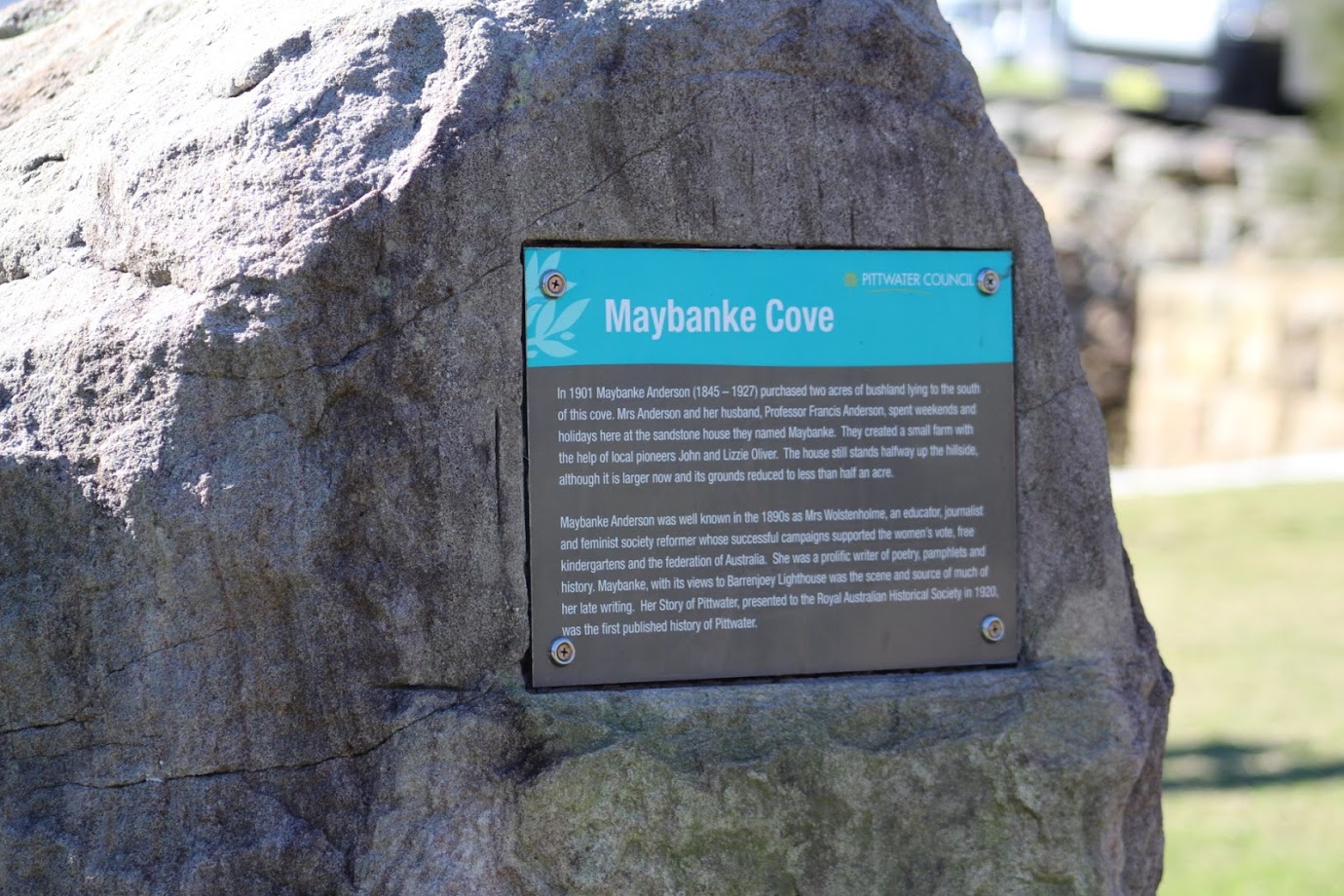
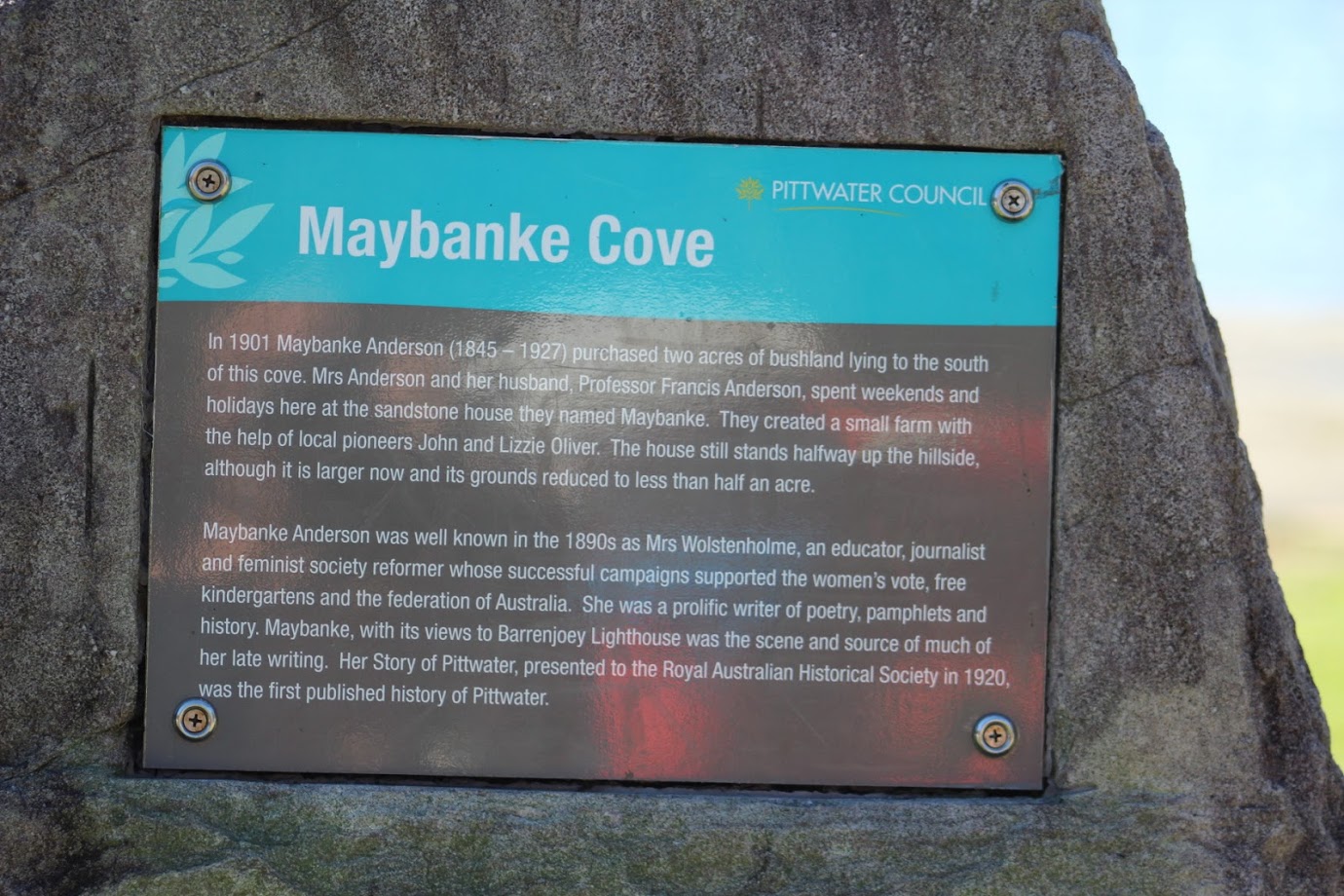
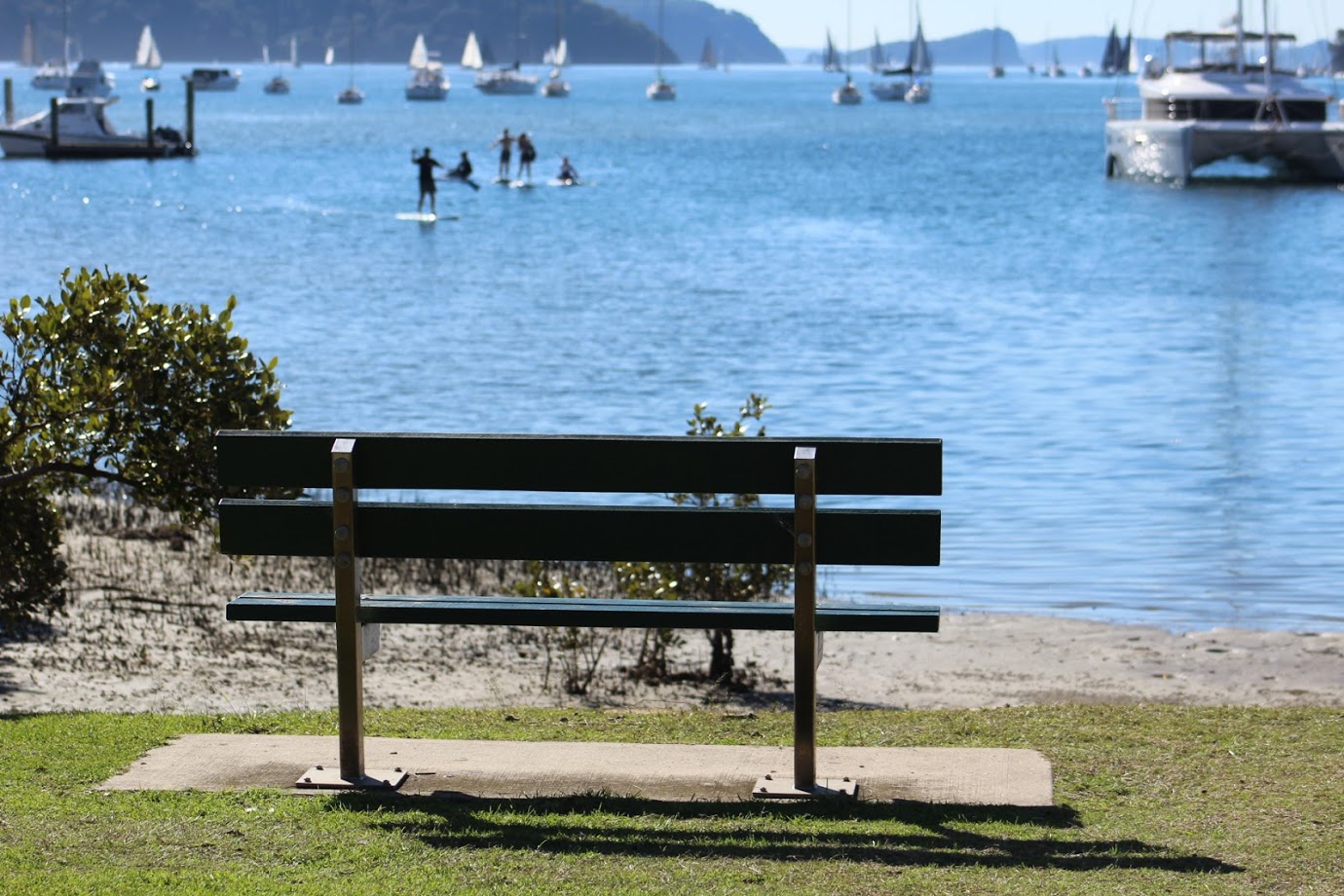
PITTWATER COUNCIL
Roads Act 1993
Naming of Public Roads - Lucinda Place, Maybanke Court and Eric Green Drive
IN accordance with Clause 162 of the Roads Act 1993, it is notified that, after consideration of all submissions lodged, the Council, at its meeting of 17th April, 2000,
approved the naming of the following roads:
Description
New roads within the Winnererremy Bay Parkland Estate Subdivision.
Names
Lucinda Place;
Maybanke Court;
Eric Green Drive.
A. GORDON, General Manager, Pittwater Council, PO Box
882, Mona Vale, NSW 1660. PITTWATER COUNCIL (2000, April 28). Government Gazette of the State of New South Wales (Sydney, NSW : 1901 - 2001), p. 3668. Retrieved from http://nla.gov.au/nla.news-article231987086
REAL property act notices
Department of Lands,
Sydney, 28th May, 1880,
DEEDS OF GRANT.
REFERRING to the notification on the above subject, which appeared in the Government Gazette of 5th September last, it is hereby notified, for public information, that the Deeds of Grant specified in the following schedules, being for lands sold or granted previously to the 1st January, 1863 (the date on which the Real Property Act came into operation), are still Awaiting delivery at the Deeds Branch of this Department, no application having been made for the same.
2, It is requested that the grantees, or their duly authorized agents or representatives, will apply for the Deeds, with as little delay as possible.
W. W. STEPHEN,
Under Secretary.
DEEDS OF GRANT. (1880, May 28). New South Wales Government Gazette (Sydney, NSW : 1832 - 1900), p. 2501. Retrieved from http://nla.gov.au/nla.news-article221629408
NOTICE UNDER REAL PROPERTY ACT
No. 9,766. County of Cumberland, parish of Narrabeen, 31 acres 0 roods 32 1/2 perches, at Pitt Water, adjoining the properties of Katharine M. Roche, F. Anderson, F. Chave, and James Shaw,— is part of 80 acres granted to Benjamin Crew. – Applicant: Honorah Collins.
No. 9,767. County of Cumberland, parish of Narrabeen, 42 acres 3 roods 20 perches, at Pitt Water, adjoining the properties of Honorah Collins and F. Anderson,—is part of 80 acres granted to Benjamin Crew. – Applicant Katharine Mary Roche NOTICE UNDER REAL PROPERTY ACT. (1899, June 9). New South Wales Government Gazette (Sydney, NSW : 1832 - 1900), p. 4485. Retrieved from http://nla.gov.au/nla.news-article220943318
No. 17,898. APPLICANTS:—Ada Louisa Ethel Black, Auckland, New Zealand, and Mabel Daisy Black, Annandale. LAND: —County Cumberland, parish Narrabeen, shire Warringah, 18 acres 2 roods, 244 perches, on Bay View road, at Pittwater,—part 40 acres (portion 43 of parish"), granted to George Weller; adjoining properties of D. Millar, A. M. Simpson, and J. Ware. NOTICE UNDER REAL PROPERTY ACT. (1912, April 10). Government Gazette of the State of New South Wales (Sydney, NSW : 1901 - 2001), p. 2230. Retrieved from http://nla.gov.au/nla.news-article227591158
Ada and Mabel Black were daughters of Broken Bay Customs Station Master Albert Thomas Black. All of their siblings, and themselves, were born at Barrenjoey and Christened at the newly opened St John the Baptist Church in Pittwater in 1871. The land had been bought by their father. He had also purchased land at Careel Bay.
Albert and Kate Black with their family at Barrenjoey - W. Deaton standing (mod Centre), Kate's sister is lower left - Kate is mid picture
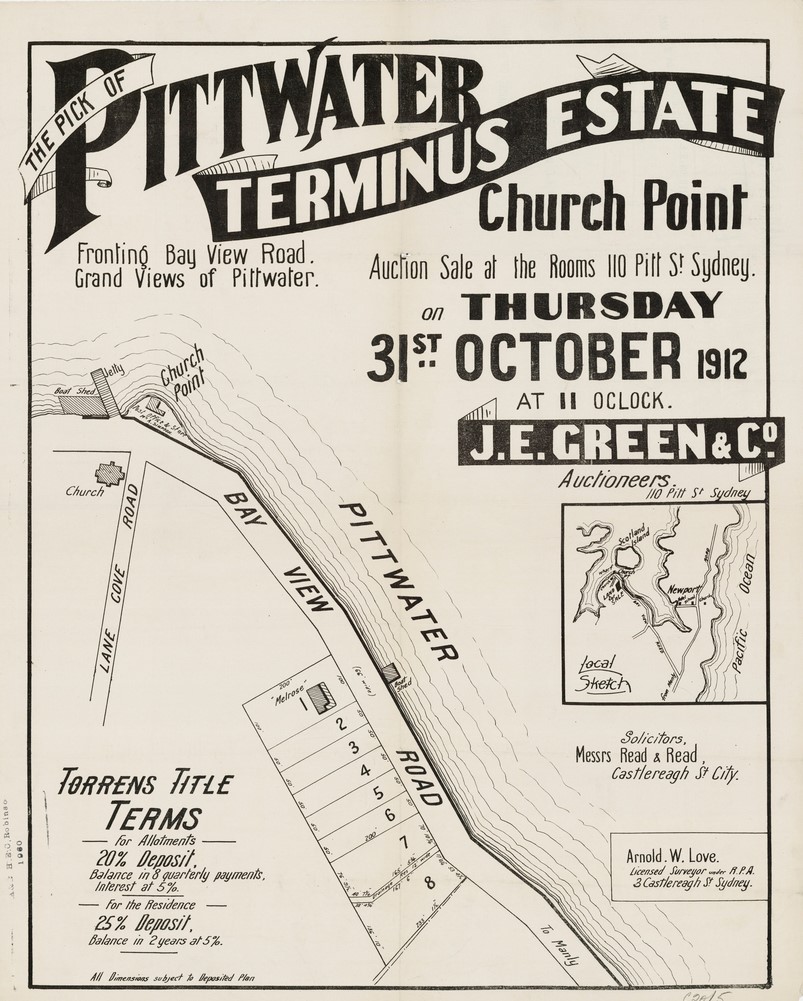
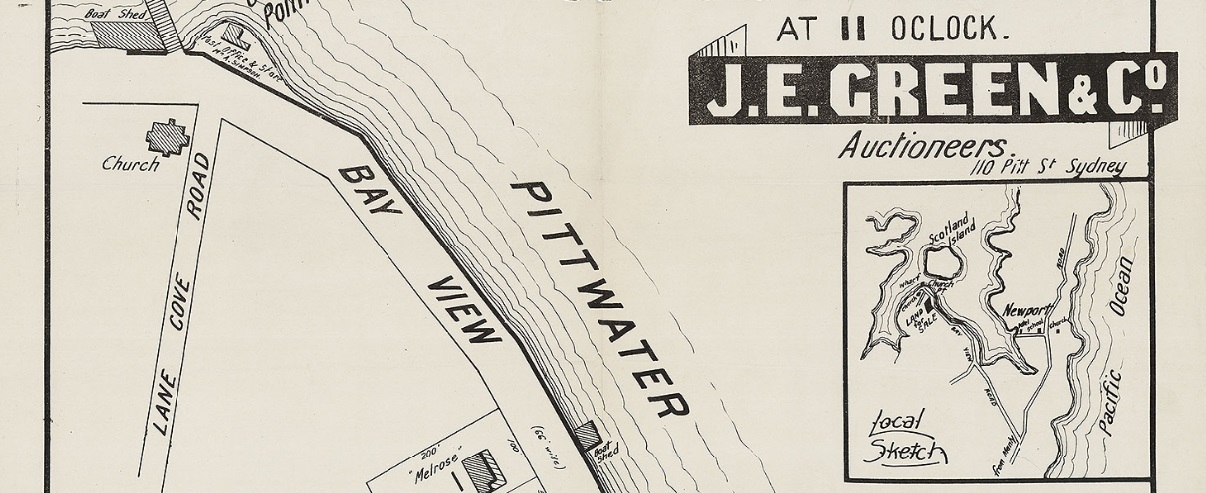
Pittwater Terminus Estate Church Point, Lane Cove Rd, Bay View Rd, Thurs. 31st Oct. 1912. Image No.: c035690006,courtesy Mitchell Library, State Library of NSW, and enlarged section from to show detail
Visit - The Green Frog - Melrose - NB: annotation by the Champions
No. 18,323. APPLICANT :—Ann Susan Johnson, Mona Vale. LAND:—County Cumberland, parish Narrabeen, shire Warringah, 1 acre 2 roods 26| perches, in Bay View road and Mona-street,—part lot 9, section 1, Mona Vale Estate, and part 700 acres (portion 17, parish), granted to Robert Campbell ; adjoining properties of J. Booth and C. Johnson. NOTICE UNDER REAL PROPERTY ACT. (1913, July 16). Government Gazette of the State of New South Wales (Sydney, NSW : 1901 - 2001), p. 4388. Retrieved from http://nla.gov.au/nla.news-article227051363
No. 18,571. APPLICANT Joseph Kentigern Heydon, Mosman. LAND: —County Cumberland, parish Narrabeen, shire Warringah, 6 acres 1 rood 1 perch, on Pittwater-road and at intersection Waterview and Mona streets,—lot 5 and part lot 4, section 5, Mona Vale Estate, and part 700 acres (portion 17, parish), granted to Robert Campbell; adjoining property of E. E. Cook. NOTICE UNDER REAL PROPERTY ACT. (1913, September 3). Government Gazette of the State of New South Wales (Sydney, NSW : 1901 - 2001), p. 5495. Retrieved from http://nla.gov.au/nla.news-article221609154
No. 18,863. APPLICANT:—Edward Marsh Brodie, Sydney. LAND:—County Cumberland, parish Narrabeen, shire Warringah, 6 acres 19 1/2 perches, in Bay View road, Mona and Parley streets,—lot 53, section 1, Mona Vale Estate, and part 700 acres (portion 17, parish), granted to Robert Campbell; adjoining properties of T. Oliver and B. McCarthy. NOTICE UNDER REAL PROPERTY ACT. (1914, April 15). Government Gazette of the State of New South Wales (Sydney, NSW : 1901 - 2001), p. 2278. Retrieved from http://nla.gov.au/nla.news-article227334466
No. 19,248. APPLICANT .—Mabel Daisy Black, Annandale. LAND: County Cumberland, parish Narrabeen, shire Warringah,—8 acres 20 perches, at Pittwater, on Bay View road and a road 30 links wide,—being part 40 acres (portion 43. of parish), granted to George Weller; adjoining properties of F. J. S. Young, S. R. Mitchell, P. T. Taylor, Dr. J. Isbister, and G. Leslie. NOTICE UNDER REAL PROPERTY ACT. (1914, August 19). Government Gazette of the State of New South Wales (Sydney, NSW : 1901 - 2001), p. 5039. Retrieved , from http://nla.gov.au/nla.news-article227674898
No. 19,526. APPLICANTS:—Russell Sinclair and Margaret Jane Sinclair, both of Sydney. LAND: — County Cumberland, parish Narrabeen, shire Warringah, 2 roods 11 perches, on Bay View road, Pittwater,--being part 200 acres (portion 28, parish), granted to Robert Macintosh, the elder; adjoining properties of C. W. Bennett and Mrs. M. Wilshire. NOTICE UNDER REAL PROPERTY ACT. (1914, November 25). Government Gazette of the State of New South Wales (Sydney, NSW : 1901 - 2001), p. 7040. Retrieved from http://nla.gov.au/nla.news-article227424527
No. 20,790. APPLICANT:—Robert Shannon, of Stanmore. LAND: County Cumberland, parish Narrabeen, shire Warringah, 11 acres 22 perches, in Bay View road and Mona-street, Pittwater, part lots 12 and 13, section 1. Mona Vale Estate, and part 700 acres (portion 17 of parish), granted to Robert Campbell: adjoining properties of R. J. Collins and Warringah Shire Council. NOTICE UNDER REAL PROPERTY ACT. (1918, June 7). Government Gazette of the State of New South Wales (Sydney, NSW : 1901 - 2001), p. 2610. Retrieved from http://nla.gov.au/nla.news-article229426690
No. 22,825. APPLICANT:—William James Large, Mona Vale. LAND:—Shire Warringah. 12 acres 3 roods 8 perches, fronting Darley and Johnson streets, north-westerly from Bay view-road. NOTICE UNDER REAL PROPERTY ACT. (1920, October 15). Government Gazette of the State of New South Wales (Sydney, NSW : 1901 - 2001), p. 6086. Retrieved from http://nla.gov.au/nla.news-article224612976
NOTICE UNDER REAL PROPERTY ACT.
APPLICATIONS by the undermentioned have been made to bring the lands respectively described under the provisions of the Real Property Act. Caveats may be lodged on or before the respective dates mentioned:—
No. 22,216. Charles Woolfield Bennett, 30 acres.3 r. 18 1/2 p., and 1 a. 0 r. 38 3/4 p., parts of por. 28 (of ph.), ph. Narrabeen, co. Cumberland, on Bay View rd., at Pittwater. 4th Nov., 1921. NOTICE UNDER REAL PROPERTY ACT. (1921, September 30). Government Gazette of the State of New South Wales (Sydney, NSW : 1901 - 2001), p. 5621. Retrieved from http://nla.gov.au/nla.news-article222044200
Charles Woolfield Bennett; Born in 1863 and died in Nov 16 1947 North Ryde, New South Wales. International House, 104 Bathurst Street, Sydney - completed in 1908: The building was commissioned, built and occupied for the first 53 years of its life by Bennett & Wood, a prominent manufacturer of bicycles and importer of motor cycles during the late nineteenth century and for over half the twentieth century, to accommodate the manufacture and sale of bicycles and other items sold by the company. The company’s co-founder, Charles Woolfield Bennett, was a prominent competitive cyclist during the last quarter of the nineteenth century and headed it for many years. Accordingly the building has strong links to the growth and popularity of cycling in NSW during the first half of the twentieth century, in particular the Speedwell brand.
SERVANTS BENEFIT FROM ESTATE
SYDNEY, Wednesday.
Mrs. Margaret Court, housekeeper to the late Charles Woolfield Bennett, of Bennett and Wood, Pty., Ltd., who died on November 18, will receive £20,000, a car and a house, while the chauffeur, Charles W. Ramm, will receive £250 and the cook, Nellie Miles, £100.
The estate was valued at £314,703 and probate was granted to-day. The bulk of the money, goes to his family, two daughters. SERVANTS BENEFIT FROM ESTATE (1947, December 25). The Canberra Times (ACT : 1926 - 1995), p. 2. Retrieved from http://nla.gov.au/nla.news-article2733683
No. 26,596. Arthur Clyde Giles, 1 acr. 2 r. 30p., in Newport-rd.4 and Bassett-st. Mona Vale. NOTICE UNDER REAL PROPERTY ACT. (1925, September 25). Government Gazette of the State of New South Wales (Sydney, NSW : 1901 - 2001), p. 4078. Retrieved from http://nla.gov.au/nla.news-article220255062
Warringah Shire Council Minutes of Meetings records;
February 18th, 1929:
Bay View & Church Point Progress Assn. 4/2/1929. – Extensions; requesting the Council to endeavour to secure an adequate water supply for the Bay View and Church Point District. ' Resolved ( Cr. Austin, Cr. Hitchcock) that the Water Board be asked to give favourable consideration to this matter.
December 15th, 1930
Main Roads Board 5/12/30. Concurring in proposed prosecution respecting unauthorised removal of material from Bayview Road, and stating that it is not considered necessary for the Board to join in such prosecution. Received. 7 Same. 4/12/30. Requesting that the rate of expenditure on Warringah Road be regulated so that funds will be in hand to finance further maintenance work throughout the remainder of the financial year ending 30th June next. Received. 8.. Same. 5/12/30. Requesting that the work of renewing the bridges on Bayview Road and Cabbage Tree Road at Figtree Flat be charged to the grants already made by the Board, and stating Board is unable at present time to make available the funds required for the extensive repairs listed in the Council's letter. "Received" 9. Same. 4/12/30. Replying that the Board prefers to defer the construction of the drain at Robertson Street, Narrabeen, until this length of the main road is reconstructed, as the funds at the Board’s disposal are required at the present time for works of maintenance improvements of an urgent nature only. "Received"
W.J. Oliver, 15/5/34, re his Special Lease between Bayview Road and highwater mark, Bayview, and requesting Council to agree to the cancellation of the clause in the lease whereby he is required to give free parking space on his land on the opposite side of the road. Resolved, - That the Council do not object to the cancellation of the clause referred to. (Crs. Austin, Hughes)
At Mona Vale a farm of 40 acres known as the 'Zoo Farm’ produced feed for the creatures of Taronga Zoo. The farm was managed by Charlie Bishop with other workers including Stan Wenman and Brian Godwin. The land was purchased in 1947 by Sir Edward Hallstrom (1886-1970) solely for this purpose. A member of the Taronga Zoo Park Trust from 1941 to 1959, its president from 1948 to 1959 and honorary director until 1967, an animal lover from an early age, Mr Hallstrom thought the farm would ensure the animals in his keeping would have the fresh food they required.
During the 1960’s the food from the farm was analysed and found to be lacking in Vitamin E and the lucerne far too rich for the animals it had been grown for. By the 1970’s the Western Plains Zoo began producing hay for the Taronga zoo and the farm was subdivided and sold from 1976 until the last parcel had been bought in 1984. The Koala Sanctuary was known as the Bellbird Estate by 1977 and although used for 'orientation' runs by local schoolchildren, who recall lots of koalas in the trees there, the sanctuary was gone.
The lands at Mona Vale were also brought under the Real Property Act and sold off:
No. 38028 Edward John Lees Hallstrom 3 a. 1 r. 251 P- lot 56 sec. 1 Mona Vale Est. Bassett St. Mona Vale.
No. 38029 Edward John Lees Hallstrom 2 a. 1 r. 39 1/2 p. pt. lot 57 sec. 1 Mona Vale Est. Darley St. Mona Vale. REAL PROPERTY ACT NOTICE. (1953, August 14). Government Gazette of the State of New South Wales (Sydney, NSW : 1901 - 2001), p. 2601. Retrieved from http://nla.gov.au/nla.news-article220067730
No: 38027 Edward John Lees Hallstrom 5 a. 2 1/2 p, Lot 54 sec. 1 , Mona Vale Est. Darley St. Mona Vale. REAL PROPERTY ACT NOTICE, (1954, January 29). Government Gazette of the State of New South Wales (Sydney, NSW : 1901 - 2001), p. 288. Retrieved from http://nla.gov.au/nla.news-article220289165
No. 39128 Edward John Lees Hallstrom 3 r. 39 1.2 p. pt. lots 51 and 52 sec. 1 Mona Vale Est. Mona St. Mona Vale.
No. 39129 Edward John Lees Hallstrom 3 a 2 1/2 p. lot B in M.P.S. (O.S.) 5270 Bassett St. Mona Vale. REAL PROPERTY ACT NOTICE. (1956, June 15). Government Gazette of the State of New South Wales (Sydney, NSW : 1901 - 2001), p. 1646. Retrieved from http://nla.gov.au/nla.news-article220304536
No. 38030 Edward John Lees Hallstrom 2 a. 3 r. 39 p. lot 59 of Sec. 1 of the Mona Vale Estate Bassett St. Mona Vale. REAL PROPERTY ACT NOTICE (1960, September 9). Government Gazette of the State of New South Wales (Sydney, NSW : 1901 - 2001), p. 2862. Retrieved from http://nla.gov.au/nla.news-article220316080
Overlooking Bayview Golf Course, with Annam Road and Beaumont Crescent as its perimeters, E J Hallstrom had a private zoo that came to be known as a Koala Sanctuary. On these acres Mr Hallstrom nursed koalas back to health and reintroduced them to their natural habitats.
19. Lands Department, 6/10/42, advising that the Department has received from Mr. E.J.L. Hallstrom an application for the purchase of part of a private subdivision road which runs into Cabbage Tree Road, requesting that the Council furnish particulars of the dedication of the road as a public road, and suggesting if no evidence of dedication is available, the Council consider taking action under the provisions of Section 224 of the Local Government Set to make the road a public road, after which it could be closed and sold under the Public Roads Act provided such a course is found to be unobjectionable in the public interest. Resolved, - That, as recommended by the Engineer, the Council object to the closing of the road, and that it take action under the provisions of Section 224 (3) of the Local Government Act to make the road a public road. (Crs. Baths, McLean)
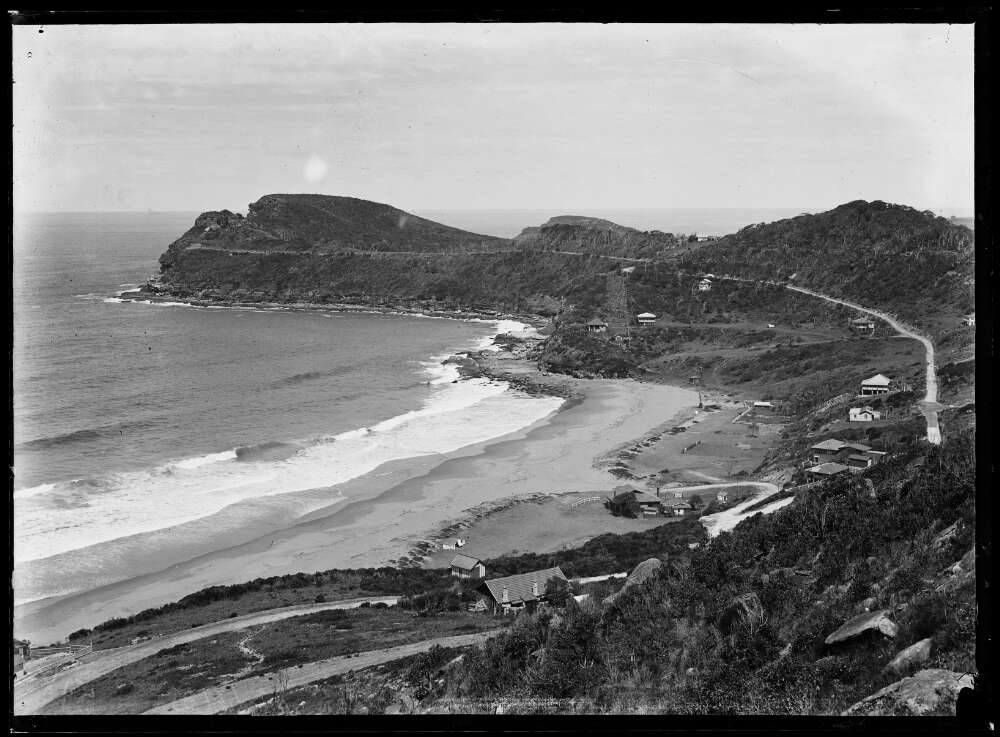
RE: will of THOMAS SIDNEY DOUGLAS, late of Sydney, in the State of New South Wales, insurance manager, deceased.
—Probate granted by Supreme Court of New South Wales on 23rd November, 1948.—Pursuant to the Wills, Probate and Administration Act, 1898-3947 (Testator's Family Maintenance and Guardianship of Infants Act, 1916-1938, and Trustee Act, 19125-1942), Rachel Maude Douglas and Douglas Alexander Douglas, the executors of the will of the said Thomas Sidney Douglas, who died on 13th June, 1948, hereby give notice that creditors and others having any claim against or to the estate of the said deceased are required to send particulars of their claims to the said executors at c.o. Dudley Westgarth & Co., 369 George-street, Sydney, on or before the 28th February, 1950, at the expiration of which time the said executors will distribute the assets of the said deceased to the persons entitled, Having regard only to the clnims of which thev then have notice.—Dated 19th December, 1949. DUDLEY WESTGAETH & CO., Proctors for the Executors, 369 George-street, Sydney. RE will of THOMAS SIDNEY DOUGLAS, late of Sydney, in the State of New South Wales, insurance manager, deceased. (1949, December 23). Government Gazette of the State of New South Wales (Sydney, NSW : 1901 - 2001), p. 4002. Retrieved from http://nla.gov.au/nla.news-article225594816
NSW BDM's - Marriage:
5835/1898 DOUGLAS THOMAS S PASSAU RACHEL M MANLY
DOUGLAS—PASSAU.—June 29, at St, Matthew's, Manly, by the Rev. A. G. Stoddart, Thomas Sidney, second son of the late A. W. Douglas. of Redfern, to Maude, eldest daughter of F. C. Passau, J.P., of Manly. Family Notices (1898, July 30). The Sydney Morning Herald (NSW : 1842 - 1954), p. 1. Retrieved from http://nla.gov.au/nla.news-article14177983
Maude was the daughter of the then Mayor of Manly, Fred Charles Passau, a jeweller by trade:
MANLY WILD FLOWER SHOW.
The annual Manly Wild Flower Show, which Is the most popular fete associated with the beautiful seaside village, was opened yesterday afternoon In the presence of a crowded and fashionable attendance. Lady Hampden was to have performed the opening ceremony, but was unavoidably absent. About half-past 3 o'clock his Eminence Cardinal Moran delivered a neat little oration, prefatory to the opening of the show, the proceeds of which, it may be mentioned, are in aid of the Manly Catholic Church. His Eminence alluded with a touch of pride to the associations of the village with the name of the late Mr. Dalley, of whom they were all so justly proud— a name which would remain attached to It as long as Australia was Australia, Reference was also made to the traditional naming of Manly a hundred years ago. when the explorers, struck by the manly attitude of the natives, gave the name to these shores. His Eminence pointed out that, the people now were as manly as those people of a century ago. He dwelt on the distinctive tints of the wild flowers of the district, which had been given the palm for its choice flowers. All these things- lent prestige to the flower show, which could Justly be named the Federal Flower Show. It was true they had not as yet a united Australia, but federation was In the air, and they had all the colonies bound together with the Idea of union, so that they hoped the wealth of one would become the common heritage of all. If federation was not fully realised It was brought home to us, so that we all long for Its consummation. He trusted that before the next flower show they would have that consummation. Mr. Dugald Thomson, M.L.A., echoed the hope that federation would be accomplished before the next flower show. He was aware that the success of all these flower shows was-due to a minor federation, that of alt creeds and sections of the community. He referred to the beautiful weather, and the large number of visitors, and congratulated everybody concerned on the beautiful show, with its .exquisite designs of wild flowers.
Mrs. Passau, the Mayoress, then declared the show open. The committee included the Rev. Dr. Burke, the Rev. Father Hayden, hon. secs.; Drs. Watkin and Thomas, the Mayor (Alderman Passau), and Aldermen Carroll and Quirk, the Rev. Father M'Dermott, and Messrs. J. H. Butler, Hosking, Macfarlane, Millett, Dargan, M'Carthy, and C. J. Smith. The ladies who co-operated with the committee Included Mesdames J. T. Toohey, Prendergast, James Toohey, A; M'Donald, and F. B. Freehlll, from the metropolis, and Mesdames J. German, W. J. Douglas, ,T. Hansen, H. Murray, Bourke, Macfarlane, Butler, Smith, and the Misses Phillips and O'Grady, of Manly.
Among those present were, besides the Cardinal, the Hon. J. T. Toohey, M.L.C., Mr. F. B. Freehill, M.A. (Consul for Spain), Monsignor O'Brien, the Very Rev. Dr. Murphy, the Very Rev. Dr. Burke, the Rev. Fathers Hayden, M'Dermott, Brosnan, Dowling, and Fitzgerald, the Mayor of Manly (Alderman Passau), Aldermen Quirk and Carroll, and Dr. Watkins. The stall-holders were:. Mrs Normandie, Mrs. F. B. Freehill, Mrs. James Toohey, Mrs. Aloysius ' M'Donald, Miss Marlon Plomley, Miss Alice Irving, Miss Sylvia Williams, Miss May Baxter, Miss O'Grady, and Miss Ruby Carroll. ' Post-office Stall: Mrs. J. Ferris,. Miss Jenkins,', and the Misses Kelly. Shamrock Stall: Mrs. W. Douglas, Mrs. Joseph German, Mrs. J. H. Butler, and Mrs. Prendergast, Miss Bryan, Miss Fltzsimons, Miss J. Hanson, Miss Lane, Miss Needham, Miss Harvey, and Miss Montagu. Boomerang Stall: Mrs. Hubert Murray, Miss M. Phillips, Mrs. . P. Burke, Miss Kirkpatrick. Miss G. Ralfe, Miss Passau, Miss A. Bedwell, Miss Mollis Watkins, Miss M. Bed-well; and Miss Lyne. Cafe Espagnol: Mrs. G. Macfarlane. Mrs. C. E, R: Murray, Mrs. Brennan, Miss Baxter, Miss Macltfer, Miss Oxenham, Miss Macfarlane, and Miss Green. MANLY WILD FLOWER SHOW. (1898, September 28). The Australian Star (Sydney, NSW : 1887 - 1909), p. 2. Retrieved from http://nla.gov.au/nla.news-article228463459
Frederick Charles Passau was born on April 30th 1842 at Glebe, son of Samuel Passau and Matilda nee Dawes. On November 1st 1864 he married Rachael Benton at Scots Presbyterian Church in Sydney. There were six sons and four daughters of the marriage. He died at Manly on July 9th 1919, aged 77 years. His wife Rachael Passau died on November 3rd 1905, aged 62 years. Frederick Passau was an alderman on Glebe Council from 1874 to 1876. Described as a jeweller, he lived in St Johns Road Forest Lodge from about 1871 and at Bessmont Terrace St Johns Road till 1883 when the family moved to ''Fairlands'' Manly and eventually to 'Maranoa' in Belgrade street, Manly. He leased two jewellery shops in the Sydney Arcade from 1886, and in 1904 he was working as a watchmaker, jeweller, spectacle maker and optician in the Royal Arcade,at 494 George Street, Sydney. He was elected to Manly Council from 1887 to 1906. As Manly’s mayor in 1897 and 1898, he was heavily involved in the connection and improvement of the water supply to the Manly municipality and the establishment of a sewerage scheme that was finally completed in 1899. Passau was also a driving force behind formation of Manly fire brigade and its station in Fountain Street. He was first President of the Manly Bowling Club. His son Reginald and Thomas Douglas were named as executors in his will.
No. 35,341. John Corbett Jones, 8 a. 1 r. 28 p., pt. lot 1, Chave's Subdn., Cabbage Tree rd., near Bay View rd., Mona Vale. NOTICE UNDER REAL PROPERTY ACT. (1944, July 21). Government Gazette of the State of New South Wales (Sydney, NSW : 1901 - 2001), p. 1263. Retrieved from http://nla.gov.au/nla.news-article225097061
REAL PROPERTY ACT NOTICE.
Applications have been made to bring the undermentioned lands under the Real Property Act. Plans may be inspected and caveats lodged at the Land Titles Office Sydney until 12th October 1951:—
No. 37123 Mark Foy 12 a. 6 1/2 p., pts. por. 28 Bay View Rd. Pittwater. REAL PROPERTY ACT NOTICE. (1951, September 7). Government Gazette of the State of New South Wales (Sydney, NSW : 1901 - 2001), p. 2565. Retrieved from http://nla.gov.au/nla.news-article220009538
Mark Foy (15 February 1865 – 15 November 1950) had actually passed away when the above Notice for bringing acreage under the Real Property Act is listed.
Warringah council records shows that in their October 14th, 1941 Minutes of Meetings correspondence regarding Mr. Foys' Bayview holdings:
Ordinary Meeting. Subn. A 1/4/41. 39. G. S. Hackeller & Son, Solicitors, 23/3/41, submitting, on behalf of Mr. Mark Foy, plan of proposed subdivision of part of Portion 28, Bayview Road, Bayview. Resolved, - That the plan be approved provided that the strip marked "Access" are to be part and parcel of the rear block. (Crs. Campbell, O'Reilly)
G. S. Mackellar & Son, 9/10/41, on behalf of Mr. Mark Foy, requesting Council's permission to sell Lot 14 and Lot B, being part Lot 15, D.P. 9606, Bayview Road, and to retain Lot 14A. Resolved, - That the desired permission be granted, Subdn. A. provided that Lot 14A is attached in title to Mr. Foy's property known as "The Cabin", situated between Bayview Road and the waters of Pittwater.
Mark Foy had a residence in Pittwater called 'The Cabin' at 28 Bay View Road before this access was renamed 'Pittwater Road' by Warringah Council. Other family members also purchased property in Pittwater. His youngest sister Sophie, through her marriage to James Joseph Smith, had also been a visitor to Pittwater and the family had a property called 'Trincomalee' at Elvina Bay, while sister Alice married James Joseph Macken, a family still well known here, who have been associated with Collaroy and Coasters for many decades. Mr. Foy was very involved with the local community, sponsoring a race in Pittwater Regattas, a great supporter of the Bayview Yacht Racing Association (BYRA), which was formed just opposite his home, and a good firend of the Riddles, who had this as their boathouse prior to the formation of the club. He was also a great supporter of keeping the environment intact:
SPOTTED GUMS AT BAYVIEW.
Bayview, one of the most delightful of the many beauty spots round the waterfront at Pittwater, is more beautiful than usual today because of the presence of numbers of the young and middle-aged spotted gums on the roadside. Anyone, who has an eye for a tree trunk and a shapely headpiece, should see these hardwoods at work on their home holdings, over which Mr. Mark Foy and his neighbours hold sway. The grown trees are 30 and 40 feet in the barrel, and are quite perpendicular. All the young stock are lighter in body and shorter as well, but even the babies among these yellow-stemmed trees are as straight as a plumb line. Young trunks and old trunks, too, are coloured with unbroken bark of yellow-green pastel shade, blotched with spots of dull mauve, which clearly indicate the family to which they all belong. Only lately they were engaged in dropping their old bark in readiness for the work which has to be done during the year.
Thanks to Mr. Foy, Mr. Graham, Mr. Sinclair, and to the other tree lovers of Bayview, who are bent on preserving these native timber trees, visitors are able to enjoy from the roadside pictures which are too seldom seen on or near an outer suburban highway. In too many places all the native trees are cut down to make room for favourites from other continents. None of the Imported trees compare with those of our own wild land. Bayview's spotted gums stand head and shoulders above anything near them. While their present owners have power to protect them they are safe from the axemen. Recently, some splendid trees were taken off the roadside to make room for the electric light wires. Other trees were lopped or shortened for the same purpose. Many a bayside resident was sorry to see that work done. However, the chopping could not well have been avoided. The men who handled those spotted gums did their work feelingly, and saved every tree they could. SPOTTED GUMS AT BAYVIEW. (1930, January 3). The Sydney Morning Herald (NSW : 1842 - 1954), p. 10. Retrieved from http://nla.gov.au/nla.news-article16615090
IN consequence of leaving for Algiers, Mr. Mark Foy's residence, EUMEMMERING HALL, Bellevue Hill, is to Let on lease for a term of 5 years: also a water-frontage seaside Residence, THE CABIN, Bayview, Pittwater, 6 rooms, motor garage, and boathouse and baths. SHELEAGH COTTAGE, Medlow Bath, the most handsome cottage on the Blue Mountains, electric light and water laid on, beautifully furnished', also GLENARA COTTAGE, Medlow Bath, unfurnished, and a dwelling-house at Blackheath, six rooms, unfurnished. THE BUNGALOW, In KANIMBLA VALLEY, also STOEWER OFFICE, 12 City road. Full particulars of all these properties at HOOAN'S KIOSK, VICTORIA ARCADE.Opposite the Australia Hotel. Advertising. (1914, April 11). The Sydney Morning Herald (NSW : 1842 - 1954), p. 25. Retrieved from http://nla.gov.au/nla.news-article15500675
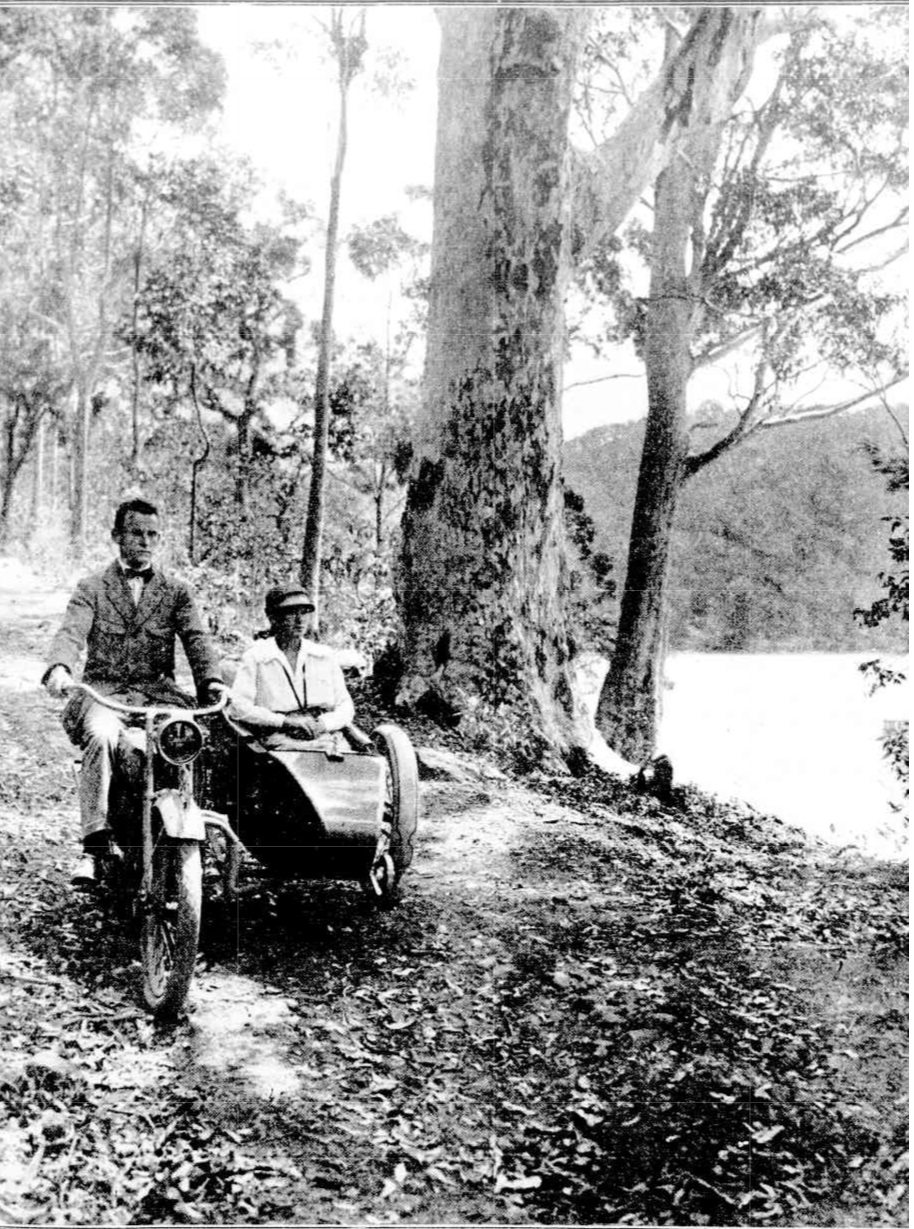
Along the foreshores of Broken Bay
The photograph was taken at Bayview, which overlooks lovely Pittwater, the southern part of Broken Bay into which runs the beautiful Hawkesbury River. The whole of this locality is wonderfully rich in scenic charms. ALONG THE FORESHORES OF BROKEN BAY. (1918, January 23). Sydney Mail (NSW : 1912 - 1938), p. 5. Retrieved from http://nla.gov.au/nla.news-article159026429
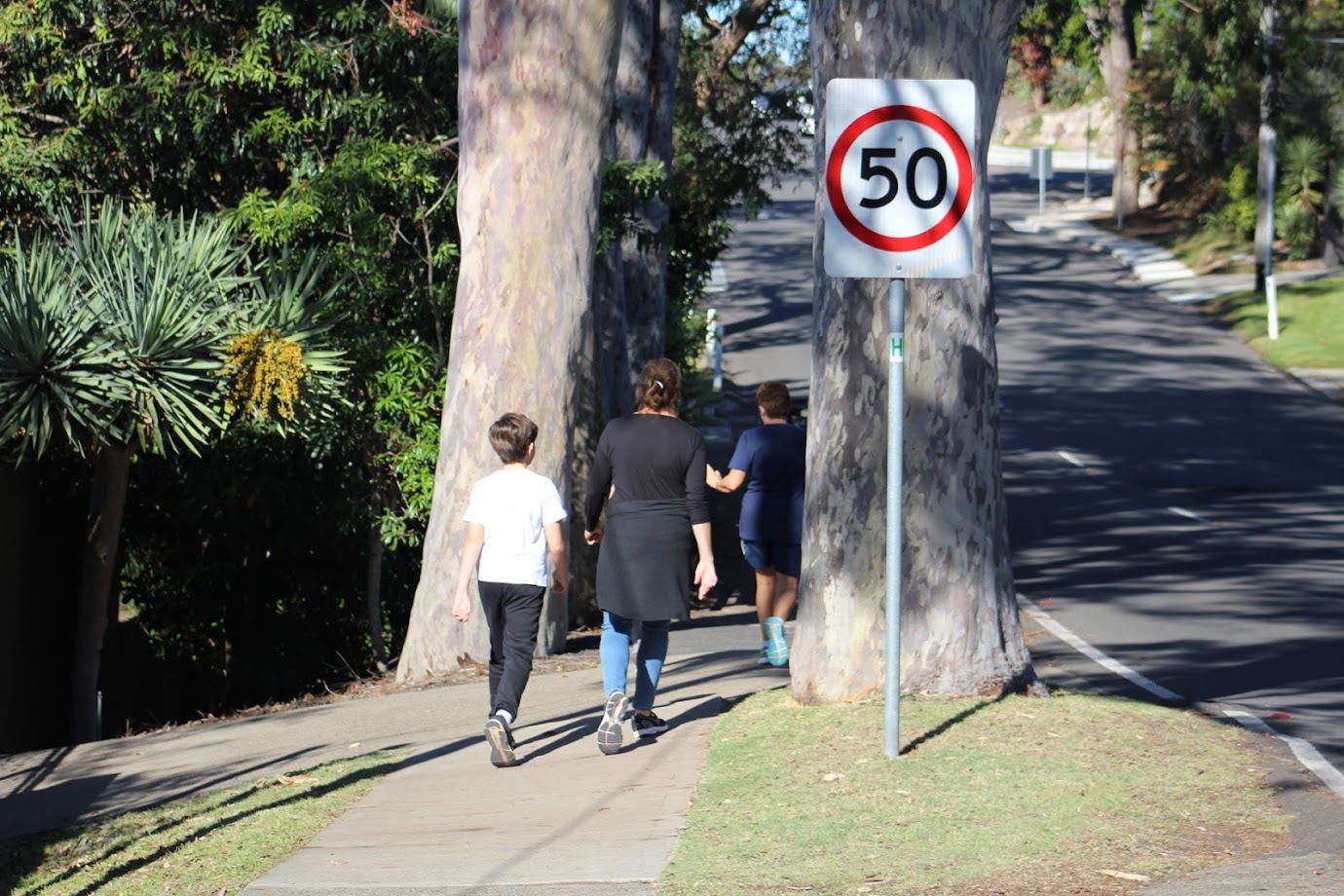
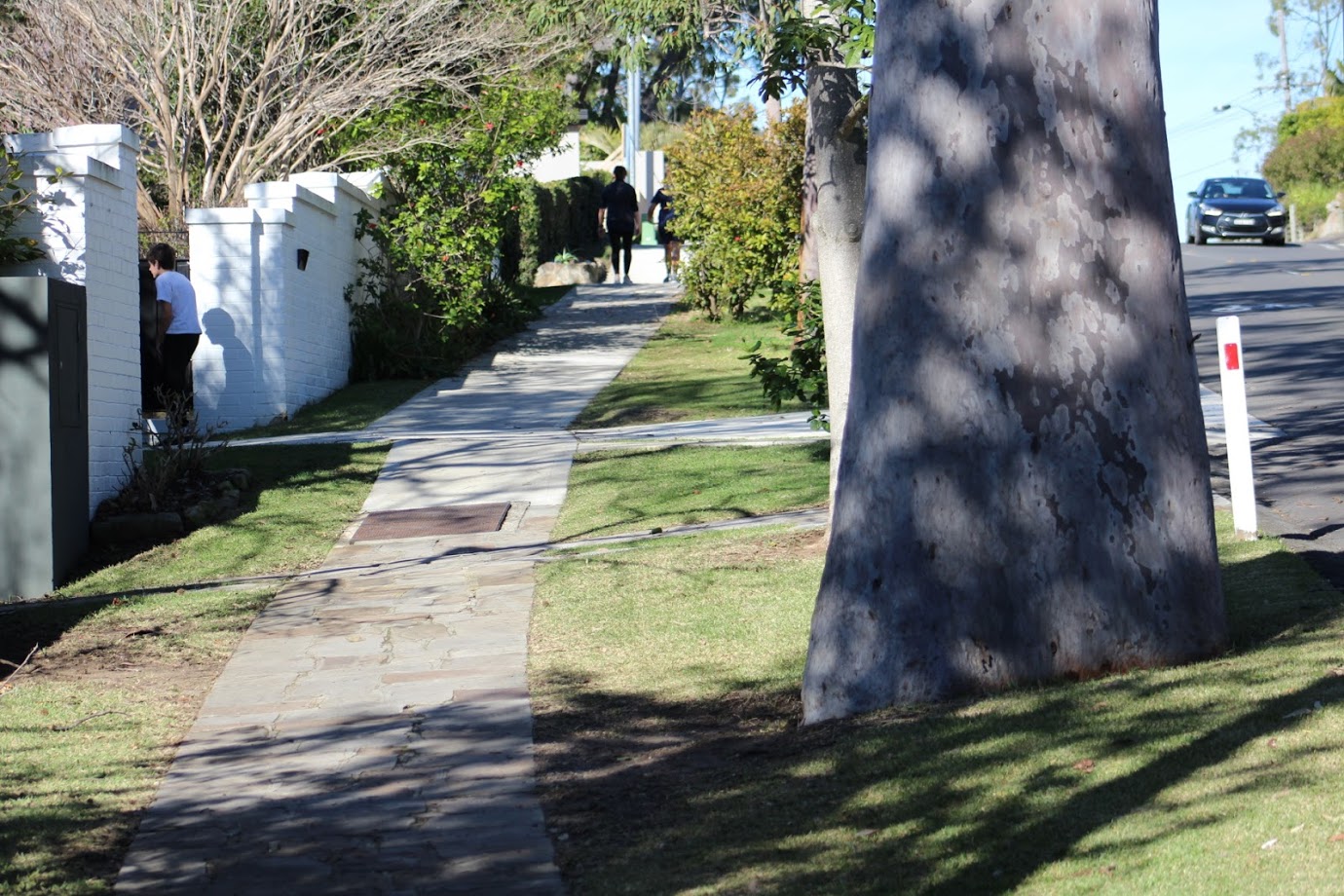
Along the Bay View Road (now Pittwater Road) in 2018 - A J Guesdon photos, full album HERE
No. 43501 Melaleuka West Investments Pty. Limited 32 3/4 per. lot 2 in D.P. 501123 Pittwater Rd. and on Pittwater at Bayview. REAL PROPERTY ACT NOTICE (1964, July 31). Government Gazette of the State of New South Wales (Sydney, NSW : 1901 - 2001), p. 2383. Retrieved from http://nla.gov.au/nla.news-article220341391
APPLICATIONS have been made to bring the undermentioned lands under the Real Property Act. Plans may be inspected and caveats lodged at the Land Titles Office, Sydney, until the respective dates mentioned:—
9th October, 1964
No. 43644 Jean Mary Field 38 3/4 per. lot 1 in D.P. 501123 Pittwater Rd. Bayview. REAL PROPERTY ACT NOTICE (1964, September 4). Government Gazette of the State of New South Wales (Sydney, NSW : 1901 - 2001), p. 2799. Retrieved from http://nla.gov.au/nla.news-article220342505
No. 44140 Frank Hogarth Willmore and Pearl Pretoria Willmore 38 1/2 per. lot 2 in D.P. 224548 being lot 2 in Regd. Plan 2183 incl. 14 Rednal St. and on Pittwater Mona Vale. REAL PROPERTY ACT NOTICE (1965, May 28). Government Gazette of the State of New South Wales (Sydney, NSW : 1901 - 2001), p. 1697. Retrieved from http://nla.gov.au/nla.news-article220392682
No. 45201 Suzanne Bispham Phillips, Josephine Dunwoodie, and Robert Frederick Lewers 1 ac. 1 r. 21 1/4 p. lot 1 in D.P. 230687 being lot B in M.P.S. (O.S.) 12839 Cabbage Tree and Pittwater Rds Bayview. REAL PROPERTY ACT NOTICE (1966, December 9). Government Gazette of the State of New South Wales (Sydney, NSW : 1901 - 2001), p. 5012. Retrieved from http://nla.gov.au/nla.news-article220021771
The Lewers girls and son Robert were the offspring of Robert David Lewers of The Eyrie, Queenscliff, a bank manager with the London Bank of Australia - the then branch in Sussex Street Sydney. Unfortunately he suffered from insomnia and had a nervous disposition andtook his own life in October 1911. His daughter Aldwyth was the one who found his body in a tent overlooking Freshwater he had been sleeping in - the family seaside 'camp'. He did own various land holdings on the peninsula, and other large property holdings, as well as leaving a large family for his wife to then look after by her self.
No. 48994 Colin William Byrnes and Pamela Joy Byrnes 33 1/2 per. lot A in M.P.S. (O.S.) 12839 (filed as F.P. 162839) as shown in D.P. 554540 Cabbage Tree Rd Bayview. 21st July, 1972. REAL PROPERTY ACT NOTICE (1972, May 19). Government Gazette of the State of New South Wales (Sydney, NSW : 1901 - 2001), p. 1847. Retrieved from http://nla.gov.au/nla.news-article220141819
METROPOLITAN LANDS OFFICE
DRAFT ASSESSMENT OF LANDS AT BAYVIEW PITTWATER UNDER PART 3 OF THE CROWN LANDS ACT, 1909 AND THE CROWN LANDS REGULATION 1990.
The Minister for Conservation and Land Management has prepared a draft land assessment for Crown lands situated at Bayview-Pittwater being the land described hereunder.
Inspection of this draft assessment can be made at the Metropolitan Lands Office, 22 Main Street, Blacktown; Department of Lands, 23-33 Bridge Street, Sydney; Dee Why Civic Centre, Pittwater Road, Dee Why and the Mona Vale Branch Library, Park Street, Mona Vale, during normal business hours.
Representations are invited from the public on the draft assessment These must be in writing and lodged, within 28 days from the date of this notice, with the Regional Director, Metropolitan Lands Office, P. 0. Box 678, Blacktown, 2148.
GARRY WEST, MP., Minister for Conservation and Land Management
Sydney, 25th October, 1991
Description Parish Narrabeen (Sheet 2) County - Cumberland Locality Bayview-Pittwater Land District - Metropolitan Shire - Warringah
About 6768 square metres being Crown land below mean high water mark of Pittwater comprising the area held partly under Special Lease 1966/2 Metropolitan by Bakers Marina and Yacht Company Pty Ltd and land partly within RS6146 trom sate or lease generally, notified 11th May, 1923. (at 1714 Pittwater Road, Bayview). MN80 H2325/4 DRAFT ASSESSMENT OF LANDS AT BAYVIEW-PITTWATER UNDER PART 3 OF THE CROWN LANDS ACT, 1989 AND THE CROWN LANDS REGULATION 1990. (1991, October 25). Government Gazette of the State of New South Wales (Sydney, NSW : 1901 - 2001), p. 9096. Retrieved from http://nla.gov.au/nla.news-article231901298
ROADS ACT 1993
LAND ACQUISITION (JUST TERMS COMPENSATION) ACT 1991
NOTICE OF COMPULSORY ACQUISITION OF LAND AT BAYVIEW IN THE PITTWATER COUNCIL AREA
The Roads and Traffic Authority of New South Wales by its delegate declares, with the approval of His Excellency the Governor, that die land described in the Schedule below is acquired by compulsory process under the provisions of the Land Acquisition (Just Terms Compensation) Act 1991 for the purposes of the Roads Act 1993.
D Shatford
Manager Statutory Processes Roads and Traffic Authority of New South Wales
SCHEDULE
All those pieces or parcels of Crown land situate in the Pittwater Council area, Parish of Narrabeen and County of Cumberland shown as Lots 1, 2,3 and 4, Deposited Plan 843238.
The land is said to be in the possession of the Crown. (RTA Papers 366.12051). ROADS ACT 1993 (1995, March 24). Government Gazette of the State of New South Wales (Sydney, NSW : 1901 - 2001), p. 1700. Retrieved from http://nla.gov.au/nla.news-article231940485
NOTICE UNDER REAL PROPERTY ACT
No. 25,089. Sir Arthur Alfred Clement Cocks, 60 a. 1 r. 4 p., por. 33 (ph.), on Pitt Water, ph. of Narrabeen, co. Cumberland. 11th July, 1924. NOTICE UNDER REAL PROPERTY ACT. (1924, June 6). Government Gazette of the State of New South Wales (Sydney, NSW : 1901 - 2001), p. 2696. Retrieved from http://nla.gov.au/nla.news-article219978986
Sir Arthur Alfred Clement Cocks (1862-1943), merchant and politician, was born on 27 May 1862 at Wild Duck Creek, Heathcote, Victoria, fourth son of English parents Thomas Cocks, farmer, and his wife Elizabeth, née Adams. About 1873 his father moved to Melbourne and set up as a hosier and tailor. Arthur was educated at a state school at Richmond and started work at 14 in a softgoods warehouse. About 1880 he joined W. Wood & Co., wholesale opticians, and became a commercial traveller. On 17 September 1884 at Richmond he married Elizabeth Agnes Gibb - they had a son and a daughter. In 1886 he was sent to Sydney to establish a branch of the firm. He gradually gained financial control and in 1899 registered his own firm, Arthur Cocks & Co., wholesale jewellers and opticians; he remained managing director until 1939. In 1911 the company was reconstructed and by 1914 he had set up branches in Melbourne, Adelaide and Brisbane. - Australian Dictionary of Biography, Volume 8
Cocks became active in commercial circles - as listed below:
RECIPIENTS
SIR ARTHUR COCKS.
Sir Arthur. Alfred Clement Cocks, K.B.E., entered Parliament in 1910 as member for St. Leonards, which constituency he has represented over since.
He served eight years on the Sydney City Council, and was Lord Mayor in 1913. He was a member of the council of the Chamber of Commerce from 1907 to 1921, and was president for the terms 1916-17 and 1917-18. He is managing director of Arthur Cocks and Co., has been a director of the City Bank since 1913, and is also a director of Arthur Rickard, Ltd., the Australian Alliance Assurance Co., Union Theatres, Australasian Films, and the Carrington Hospital. Sir Arthur Cooks, who is a strong supporter of the City Mission, has for the greater part of his life been a worker In Sunday school and church life. He was one of the founders of the Civic Reform Association, and president of this body during the 12 months' campaign which resulted in the return of 17 Reform aldermen at the City Council election of December, 1921. Asked last night whether, as has been suggested, he intended to resign from the Legislative Assembly, Sir Arthur said he had given his promise to Sir George Fuller to remain with him as long as his services are required. "That promise,". he added, ''still holds good."
Lady Cocks, who is an unostentatious worker in the world of charity, is a member of the committee of the Hyde Home for Incurables, and a vice-president of the North Sydney Benevolent Society. She is an active member of the Bush Book Club, and is on the committee of the Women's National Club. As Lady Mayoress in 1913 she established a reputation as a gracious hostess, and she is always sought after at functions associated with the well-being of charitable efforts.
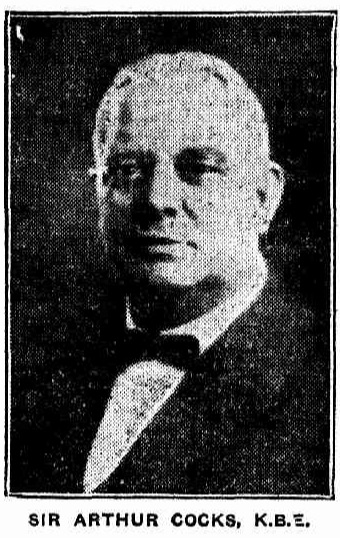
.jpg?timestamp=1599774837119)
RECIPIENTS (1923, June 2). The Daily Telegraph (Sydney, NSW : 1883 - 1930), p. 7. Retrieved from http://nla.gov.au/nla.news-article245815455
Sir Arthur Cocks Dead
Sir Arthur Alfred Clement Cocks, who died yesterday, was 80 years of age. He was born in Victoria on May 27, 1862.
He had many business Interests in. the city. As well as being managing director of Arthur Cocks and Co., Ltd., wholesale opticians, of York-street, he was at various times a director of the Australian Alliance Insurance Co.; Arthur Rickard Extended, Ltd.; Spencer Pictures, Ltd.: Australasian Films, Ltd.; General Film Co.; and of Union Theatres. Ltd. He was an alderman of the City Council for eight years, and Lord Mayor in 1912-13, when the big gas strike occurred. Sir Arthur by leading a squad of amateur stokers to the gas works kept the city from darkness and eliminated any serious interference with gas production. As a Nationalist he represented St. Leonards in the Legislative Assembly from 1910 to 1920.
After a redistribution of electoral boundaries, he became one of five members for North Shore, and was appointed Treasurer by Sir George Fuller. He held this office until he was appointed Agent-General for New South Wales in London. He resigned following the election of the Lang Government, and returned to Sydney, but, due to ill-health, did not take up public life again. He was president of the Chamber of Commerce from 1916-18: chairman of the Importers' Association; a member of the boards of the Benevolent Society of NSW and of various hospitals; and president of the Sydney branch of the YMCA. The funeral will take place tomorrow afternoon. Sir Arthur Cocks Dead (1943, April 26). The Sun (Sydney, NSW : 1910 - 1954), p. 2 (LATE FINAL EXTRA). Retrieved from http://nla.gov.au/nla.news-article231754341
His estate was valued for probate at £42,908- both his son and his daughter had predeceased him:
COCKS.— March 27, Arthur Thomas Cocks, at Leura; suddenly, age 20, years, only son of Arthur A.. C. Cocks, of 59 York-street, Sydney. Family Notices (1908, March 28). The Daily Telegraph (Sydney, NSW : 1883 - 1930), p. 8. Retrieved from http://nla.gov.au/nla.news-article238092688
WILLMOTT-COCKS - On August 19, at Mosman Congregational Church, by Rev. A H Austin, Stanley Willmott, third son of Mr. James Willmott and Mrs. Willmott, Birmingham, England, to Ellen Margaret, only daughter of Arthur A C Cocks, ansd Mrs. Cocks of Harrison-street, Neutral Bay.
At home, afternoon, Wednesday 27th instant, Afternoon and Evening, Friday 29th instant, at Sunny Side, Roseville-avenue, Roseville. Family Notices (1911, September 23). The Sydney Morning Herald (NSW : 1842 - 1954), p. 14. Retrieved from http://nla.gov.au/nla.news-article15276362
MRS. STANLEY WILMOTT.
The death occurred at Fremantle of Mrs. Stanley Wilmott, only daughter of Sir Arthur and Lady Cocks.
Mrs. Wilmott left Sydney on March 10, with her husband and daughter, Margaret, on a trip to England. She became suddenly ill, and when the liner reached Fremantle she was taken to hospital, where an operation was performed There are two sons in Brisbane, Oscar and Ronald. The funeral took place at Fremantle yesterday. MRS. STANLEY WILMOTT. (1931, April 1). The Sydney Morning Herald (NSW : 1842 - 1954), p. 21. Retrieved from http://nla.gov.au/nla.news-article28041549
RE will of Sir ARTHUR ALFRED CLEMENT COCKS, late of Sydney, Knight of the British Empire, deceased.—Probate granted by Supreme Court of New South Wales on 11th August, 1943.—Pursuant to the Wills, Probate and Administration Act, 1898-1940 (Testator's Family Maintenance and Guardianship of Infants Act, 1916-1938, and Trustee Act, 1925-1940), The Union Trustee Company of Australia Limited and Horace Thurston Cocks, the executors of the will of the said Sir Arthur Alfred Clement Cocks, who died on 25th April, 1943, hereby give notice that creditors and others having any claim against or to the estate of the said deceased are required to send in particulars of their claims to the said executors at 2 O'Connell-street, Sydney, on or before the 23rd October next, at the expiration of which time the said executors will distribute the assets of the said deceased to the persons entitled, having regard only to the claims of which they then have notice.—Dated 14th August, 1943. OWEN JONES, McHUTCHISON & CO., Proctors for the Executors. 1905. RE will of SIR ARTHUR ALFRED CLEMENT COCKS, late (1943, August 20). Government Gazette of the State of New South Wales (Sydney, NSW : 1901 - 2001), p. 1487. Retrieved from http://nla.gov.au/nla.news-article225081522
DOROTHY HAWKINS
Published by Pittwater Pathways, December 16, 2019
Dorothy Hawkins family ran this dairy near Winnererremy Bay at Mona Vale from 1936. Mona Street is in the foreground, Bassett Street with the ocean beyond in the far distance. Brock’s Folly (La Corniche) is on the hill to the right of the ocean.
Dorothy, still 14, lived in this house and worked in these fields. Her father, Joseph Homer, later purchased all the land seen here bounded by Bassett and Mona Streets, including the buildings on the hill. 98 year old Dorothy’s story as told here is a case study of a young woman living a semi-rural life at Mona Vale prior to WWII through to the late 1960s.
Dorothy was the last person to live on what is now Winnererremy Bay Park. Her account of eviction from the home she loved, following a brutal forced resumption, is wrenching. This was a private development by Warringah Shire Council in partnership with developer ‘Pacific Paradise’. After examining numerous documents and newspaper clippings and listening to Dorothy and her children, it seems doubtful due process was followed. A significant injustice may have been perpetrated against Dorothy and her sister, co-inheritors of the Centenary Estate Land which 32 years later became Winnerrremy Bay Park.
Angus Gordon - Winnererremy Bay, Bayview
Published by Pittwater Pathways, March 23, 2020
John Illingsworth (Pittwater Pathways): Angus Gordon was General Manager of breakaway Pittwater Council from 1996 to 2005. He turned the new council around. Central was the successful development of Winnererremy Bay into both residential area and beautiful public park, a work almost of genius given that Warringah Council had botched the initial public land resumption in favour of a dodgy commercial development focused on a 'boatel' and marina development. When that failed the NSW State Government prepared a residential development of up to 300 blocks. Resident opposition and some clever footwork by the new Council instead produced a public good. Lightly edited, this film offers rare insight into processes that govern us that are more usually obscure to the general public.
References and extras
- TROVE - National Library of Australia
- Roads In Pittwater: The Bay View Road
- Shelagh Champion OAM and George Champion OAM - Profiles of the Pioneers, 2103 Revision
- Bayview - Links with a Past : A Hisrory of Bayview Golf Club. Published in 1998 by Bayview Golf Club Ltd. Retrieved from: https://www.bayviewgolfclub.com.au/wp-content/uploads/2019/04/Bayview-Links-With-A-Past.pdf
- Report on talk by John Bungey on Bayview Gardens – zoo to retirement complex by Jim Boyce, Peninsula Historian, Newsletter of the Manly, Warringah & Pittwater Historical Society, VOLUME 6 NO. 12 January 2014.
- Mark Foy Of Bayview
- The Macphersons Of Wharriewood: The William Joseph Macpherson Albums
- Daniel Gordon Soutar's Influence On Local Golf Courses: Some History Notes (Bayview GC included)
- Harold Tristram Squire: October 28, 1868 - May 16,1938; Artist of Mona Vale
- Maybanke Selfe-Wolstenholme-Anderson
- Sir Francis Anderson
- John Roche
- Katherine Mary Roche - Pittwater Matriarch
- The Riddles of The Spit and Bayview/Church Point: sailors, boat makers, road pavers and winning rowers
- Church Point and Bayview: A Pittwater Public School Set on the Estuary
- La Corniche, Bayview
- Bayview Baths Centenary Celebration in November 2016 hosted by Bayview-Church Point Residents Association Dr. Jenny Rosen's Historical Timeline
- Bayview Days
- The Bayview Tea Gardens 1920 to 1923 When Run By Thomas Edward And Annie Newey (Nee Costello)
- Early Bayview - insights courtesy Don Taylor and Margaret Tink
- Some Bayview Memories: The Lloyd Family - see Notice below
- Pittwater Summer Houses: Waiwera and Hopton Lodge, Bayview
- Bayview Wharf
- Bayview Koala Sanctuary
- Pittwater Restaurants You Could Stay At: Pasadena Road House – Church Point
Also Available:
- Pittwater Roads II: Where the Streets Have Your name - Scotland Island
- Pittwater Roads II: Where the Streets Have Your Name - Newport Beach
- Pittwater Roads II: Where the Streets Have Your Name - Clareville
- Pittwater Roads II: Where the Streets Have Your Name - Avalon Beach
- Pittwater Roads II: Where the Streets Have Your Name - Warriewood
- Pittwater Roads II: Where the Streets Have Your Name - Elanora Heights, Green Hills and Ingleside
- Pittwater Roads II: Where the Streets Have Your Name - Mona Vale
- Pittwater Roads II: Where the Streets Have Your Name - Bungan
- Pittwater Roads II: Where the Streets Have Your Name - Bilgola
- Pittwater Roads II: Where the Streets Have Your Name - Coaster's Retreat and The Basin
- Pittwater Roads II: Where the Streets Have Your Name - Great Mackerel Beach
- Pittwater Roads II: Where the Streets Have Your Name - Whale Beach
- Pittwater Roads II: Where The Streets Have Your Name - Palm Beach
- Pittwater Roads II: Where The Streets Have Your Name - Careel Bay
- Careel Bay Reserves and Playing Fields in Careel Bay Playing Fields Reserve - Including Hitchcock Park: Birds, Boots & Beauty
- Roads In Pittwater: The Bay View Road
- Roads In Pittwater - The Barrenjoey Road
- Motor Car Tours To And In Pittwater Show Us The Way This Place Once Was
- Roads To Pittwater: The Wakehurst Parkway Along Old Oxford Falls Track
- Roads To Pittwater: The Pittwater Road
- Roads To Pittwater: The Sandspit Punt and Spit Bridge
- Roads To Pittwater: The Mona Vale Road
- My Holiday by Charles de Boos – 1861
The Late Mrs. W. F. Lloyd.
INTERESTING LINK WITH THE PAST.
The "Manly Daily" has the following report of the funeral of an old resident, some of whose relatives reside in Manaro : There was laid to rest in the Manly cemetery last Monday (26th August) the mortal remains of the late Mrs. W. Fred. Lloyd, of Manly, and Bayview, whose death requires more than passing notice, as she was one of the few remaining links of some of the oldest families in New South Wales, and whose history goes back nearly one hundred years. She was descended on her father's side from old Captain Brooks, or, as he was called, the Squire of Denham Court, Liverpool, a man who had great influence in the early twenties, and died in the fifties, leaving a large family and much wealth. The Mackenzies also were old historical families then. On her mother's side she was from the House of Druitt, Major Druitt being in command of one of H.M. Regiments, the headquarters of which was in Barrack Street. He afterwards lived and died at Mt. Druitt, Rooty Hill, leaving large properties, both in New South Wales and Dublin. Druitt Street, Sydney, is called after the Major. The deceased lady had many good and kind friends, some of whom were over 90 years of age, were present at her interment, with many others to see the last sad rites performed. Rev. J. J. Willings, of Manly, officiated at the burial. Mrs. Lloyd leaves a husband and family of two sons and five daughters, also two sisters, Mrs. W. and H. Brooks, and one brother, Mr. R. W. Brooks. Her many friends beyond Manly will be glad to know that, although she suffered much of late years, her end was very peaceful. She just quietly passed away into the presence of her Maker. The Late Mrs. W. F. Lloyd. (1912, September 6). The Manaro Mercury, and Cooma and Bombala Advertiser (NSW : 1862 - 1931), p. 2. Retrieved from http://nla.gov.au/nla.news-article119125969
WARRINGAH SHIRE COUNCIL.—Re-naming of Portion of Halesmith Road. Mona Vale.—Notice is hereby given that the Council has decided to re-name Halesmith Road, between Winji Jimmi Park and Rednal Street, as "Rednal Street", in accordance with the provisions of clause 53 of Ordinance 30—Local Government Act, 1919, as amended. J. MORGAN, Shire Clerk, Shire Hall, Brookvale. WARRINGAH SHIRE COUNCIL.—RE-NAMING OF PORTION OF HALESMITH ROAD. MONA VALE.—Notice is hereby given (1965, December 10). Government Gazette of the State of New South Wales (Sydney, NSW : 1901 - 2001), p. 4154. Retrieved from http://nla.gov.au/nla.news-article220001479
Sydney, 4th November, 1977.
NOTIFICATION OF RESUMPTION OF LAND UNDER THE PUBLIC WORKS ACT, 1912
IT is hereby notified and declared by His Excellency the Governor, with the advice of the Executive Council, that so much of the land described in the Schedule hereunder as is private property has been resumed under the Public Works Act, 1912, for the following public purpose, namely, for Improvement of Harbour at Winji Jimmi Bay, Newport, and the said land is vested in the Minister for Lands as Constructing Authority on behalf of Her Majesty.
Signed and sealed at Sydney, this 12th October, 1977.
A. R. CUTLER, Governor. By His Excellency's Command,
W. F. CRABTREE, Minister for Lands.
Schedule
Land District—Metropolitan; Shire—Warringah
Parish Narrabeen, County Cumberland, 50.6 square metres, being lot 3, in Deposited Plan 233471, and being also the whole of the land in Certificate of Title, volume 10751, folio 219. Ten. 68-4925. NOTIFICATION OF RESUMPTION OF LAND UNDER THE PUBLIC WORKS ACT, 1912 (1977, November 4). Government Gazette of the State of New South Wales (Sydney, NSW : 1901 - 2001), p. 4859. Retrieved from http://nla.gov.au/nla.news-article220125935
LOCAL GOVERNMENT ACT, 1919.—PROCLAMATION.
(l.s.) J. NORTHCOTT, Governor.
17th September, 1947.
I, Lieutenant-General John Northcott, Governor of the State of New South Wales, with the advice of the Executive Council, and in pursuance of the Local Government Act, 1919, do hereby (1) abolish Residential Districts No. 2—Warringah Shire, as proclaimed in Government Gazette No. 1.1 of 14th February, 3930, No. 3—Warringah Shire, as proclaimed in Government Gazette No. G2 of 9th April, 1930, No&. 4 and o—Warringah Shire, as proclaimed in Government Gazette No. 187 of 1st November, 1935, and No. 8—Warringah Shire, as proclaimed in Government Gazette No. 9 of 22nd January, 1937; (2) declare the portions of the Wairingah Shire defined in Schedule "A" hereto to be Residential Districts (Nos. 2, 3, 4, 5 and 8— Warringah Shire); and (3) prohibit in Residential Districts Nos. 2, 3, 4, 5 and 8—Warringah Shire (a) the erection of any building for use for the purposes of any trade, industry, manufacture, shop or place of public amusement whatsoever other than the trades, industries, manufactures, shops or places of public amusement described in Schedule "B" hereto; (b) the use of any building for the purposes of any trade, industry, manufacture, shop or place of public amusement whatsoever other than as aforesaid; (c) the erection or use of advertisement hoardings; (d) the use of any land for the purposes of the trades, businesses, avocations or callings described in Schedule "C" hereto; and (e) the election or use of any building for the purpose of a residential flat building oilier than a building which conforms to the standard prescribed for Class "A" as set out in Schedule Seven to the Act.
By His Excellency's Command, J. J. CAHILL.
GOD SAVE THE KING!
Schedule "A."
Residential District No. 2 (Bayview).
Commencing on the right bank of McCarr's Creek at the westernmost corner of portion 23, parish of Narrabeen, county of Cumberland; and bounded thence by the south-western boundary of portion 25 and part of the south-eastern boundary of that portion south-easterly and north -easterly to the westernmost corner of portion 43; by the southwestern boundary of that portion south-easterly; by part of the northwestern boundary of portion 27 and the south-western boundary of that portion south-westerly and south-easterly to the northwestern boundary of portion 2S; by boundaries of portion 28 south-westerly, south-easterly and north easterly to the westernmost corner of portion 29; by the south-western boundary of that portion south-easterly to the western side of Bay view-road; by a line along Bayview-road northeasterly to the southernmost corner of lot 12a, deposited plan 4.010; by a line along the eastern boundary of lot 12a and part of lot 11 a northerly to the foreshore of Pittwater; by that foreshore generally north-westerly to the right bank of McCairs Creek aforesaid; and by that bank generally south-westerly to the point of commencement.
Residential District No. 3 (Newport, Avalon and Palm Beach).
Commencing on a southern foreshore of Pittwater at its intersection with Waterview-street; and bounded thence by that foreshore generally northerly to the south-eastern corner of lot 5, section E, township of Newport, shown on roll plan 599 at the Registrar-General's Office; by the eastern boundary of that lot northerly to the southern side of Beaonsfield-street; by that side of that street westerly to the north-western corner of lot 3 of the said section E; by the western boundary of that lot southerly to the foreshore of Pittwater; by the foreshores of Pittwater, Broken Bay and the South Pacific Ocean generally northerly, easterly and southerly to the easternmost corner of lot 20, shown on plan catalogued 776 (L) at the Registrar-General's Office; by a line along the northeastern boundary of that lot north-westerly to Grandview-parade; by that parade generally north-westerly to Newportroad; by that road south-westerly to the aforesaid Waterview-street; and by that street generally north-westerly to the point of commencement,—but exclusive of Residential District No. 7.
Residential District No, 4 (Dee Why).
Commencing on the eastern side of Pittwater-road at it'' intersection with the northern side of Pacific-parade; and bounded thence by Pittwater-road generally north easterly to the Dee Why Lagoon; by the generally southern foreshore of that lagoon generally easterly to the shore of the South Pacific Ocean; by that shore generally southerly to its intersection -with the easterly prolongation of the northern* side of Pacific-parade aforesaid; and by that side of that parade westerly to the point of commencement.
Residential District No. 5 (Collaroy-Narrabeen).
Commencing on the eastern side of Westmoreland-avenue at its intersection with the northern side of Pittwater-road; and bounded thence by a line along that side of that avenue northerly to the southernmost corner of lot 15. section 4, deposited plan 10.649; by the north-eastern side of Westmoreland-avenue and its prolongation north-westerly to the western boundary of portion 1.218, parish of Manly Cove, county of Cumberland; by part of the western and northern boundaries of that portion northerly and easterly to Edgecliffe-boulevarde by that boulevarde generally north-westerly to the westernmost corner of lot 39, deposited plan 8,035; by the northwestern and part of the north-eastern boundary of that lot north-easterly and south-easterly to the southernmost corner of lot 22; by a line along the eastern boundary of that lot, across Wetherill-street and along the western boundary of lots 17 and 7, section B, deposited plan (5,445, northerly to Clarke-street; by that street easterly to the shore of the South Pacific Ocean; by that shore generally south-easterly to Anzac-avenue; by that avenue south-westerly to Pittwater-road aforesaid; and by that road generally southerly and westerly to the point of commencement.
Residential District No. 8 (Narrabeen).
Commencing on the shore of Pacific Ocean at the eastern end of Clarke-street, Narrabeen; and bounded thence by the shore of that ocean northerly to the entrance to JSTarrabeen Lagoon; thence by the shore of Xarrabeen Lagoon generally westerly, southerly and westerly to the junction of The Esplanade and Plateau-road; thence southerly by Plateau-road to its ;junction with Mactier-street; thence easterly by Mactier-street to its junction with Lindley-avenue; thence by Lindley-avenue generally south-easterly, easterly and noith-easterly to its junction with Clarke-street; thence easterly by Clarke-street to the shore of the Pacific Ocean at the point of commencement.
Schedule "B''
Bakers' shops, bicycle shops, boat-building and repairing, booksellers' shops, boot and shoe shops, boot and shoe repairing shops, bread manufacture, butchers' shops, cab proprietors, cake shops, chemists' shops, commission agents, confectionery shops, drapers' shops, dressmaking, dressmakers' shops, dyeing and cleaning, electrical goods and radio shops, electricity substations, estate agents' shops, fishing depots, fish shops, florists' shops, fruiterers' shops, greengrocers' shops, grocers' shops, haberdashery shops, hairdressing saloons, hardware shops, ironmongers' shops, jewellers' shops, knitting, lace making, libraries, mercers' shops, milk vendors' shops, milliners' shops, motor accessories selling and repair shops, newsagents' shops, pastry goods shops, pastry goods manufacture, picture theatres, plumbers' shops, poulterers' shops, public halls, refreshment rooms, sale of crockery and glassware, sale of ice, sale of music and musical instruments, sale of petrol and lubricants, servicing, hiring and garaging of motor vehicles, smallgoods' shops, sports goods shops, stationers' shops, tailoring, tailors' shops, tobacconists' shops.
Schedule "C.''
Brick-making, concrete or earthen ware pipe making, pottery-making. tile-making, bottle dealing and exchanging, secondhand machinery dealing and exchanging, saw-milling, timber merchants* yards, dairying and/or keeping of cows for profit. LOCAL GOVERNMENT ACT, 1919.—PROCLAMATION. (1947, September 26). Government Gazette of the State of New South Wales (Sydney, NSW : 1901 - 2001), p. 2241. Retrieved from http://nla.gov.au/nla.news-article224772483
Land grants and Owners Map 1886
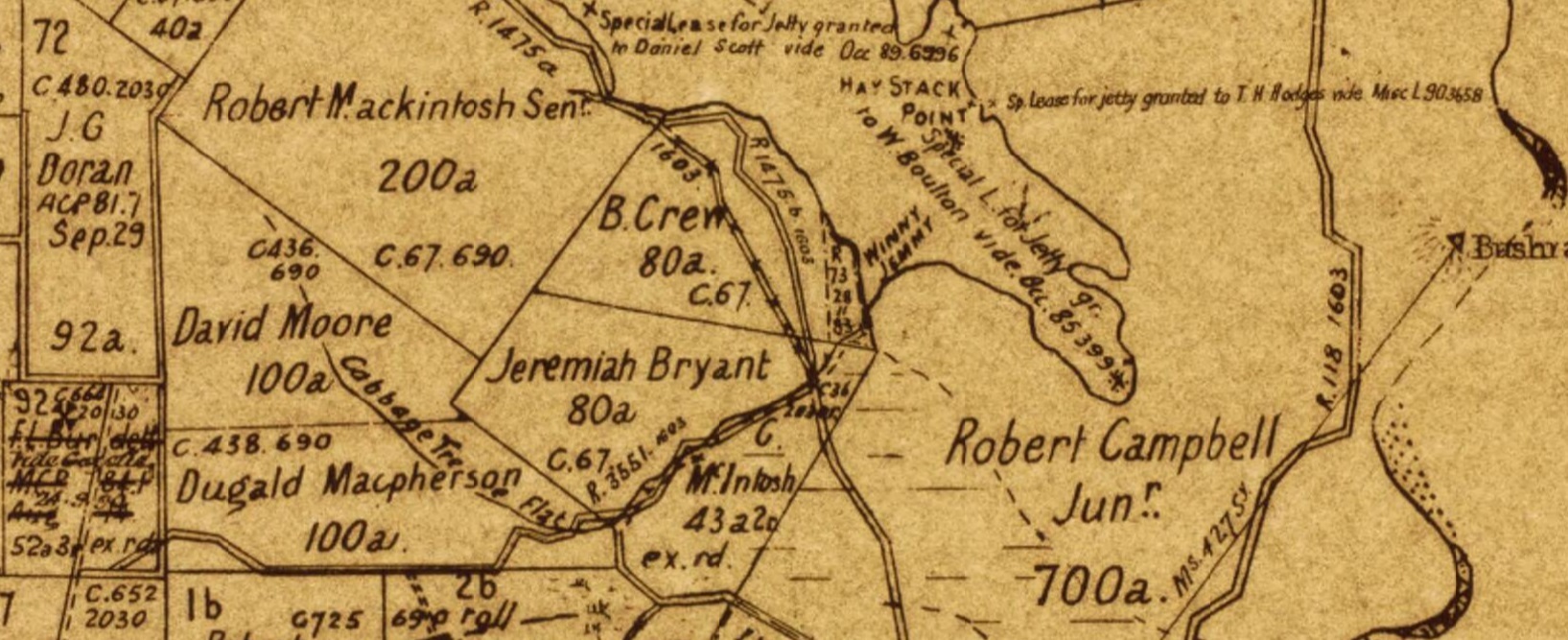
New South Wales. Department of Lands. (1886). Parish of Narrabeen, County of Cumberland Metropolitan Land District, Eastern Division N.S.W Retrieved from http://nla.gov.au/nla.obj-233833505 Section from - NB; 'Winny Jemmy'
Sam Hills: 100 acres near Foley Hill: beside this land is 100 acres that was acquired by Robert McIntosh II and included present day Katandra Sanctuary
Possibly (?):
The Late Samuel Hill.
THE OLDEST RESIDENT OF PARRAMATTA.
The late Mr. S. Hill, whose death we recorded last issue, was the oldest resident of Parramatta, and he carried with him to his last home an invaluable knowledge of the early days of the town and colony. His funeral, which took place last Saturday afternoon at Rookwood, was followed by a large circle of friends.
In January last a representative of the Cumberland Argus interviewed the old gentleman, and the result will he found to contain many interesting facts in connection with the early life of the colony. In answer to our representative's enquiries, Mr. Hill afforded the following information : —
'I've been 67 years in the colony, and never had a tea-cup full of medicine the whole of that time. 'Yes,' he said, warming to his subject, ' I came here in '20 ; there were very few houses about then. Over this side of the water all I can remember was eight huts and skillions, until Governor Macquarie took the land from those living at Pitt Row and gave them instead land on this side, which caused them to shift their huts and tents over. Parramatta was then known as Rose hill. The first hotel was in Pitt Row, Mr. Peasley's. There were a few houses in Church Street, but only small places with gardens in front. There were no bricks in those days. The Courthouse used to be a little weather board house in Macquarie-street, opposite tho present residence of Mr. John Taylor, and the lockup was a small place where tho Anderson Fountain now stands. The Courthouse was afterwards removed, about 1830, to the rear of what is now Dave Henderson's grocery. The corner of George and Church streets used then to be a big lagoon, which was filled up by Superintendent Rouse from material which was being carted to make up the carriage ways in the Park. Mr. Rouse afterwards got that land as a grant from the Government.
Sir Thomas Brisbane was governor when I came, he having landed there days before I did. The soldiers' quarters were down near the Queen's Wharf, and so were the Government stores, where the old asylums are now. The officers quarters used to be in Church and Macquarie streets, just about where Fuller's Buildings are now. The building now known as Mrs. Griffith's School was also occupied by the officers, and took four years to build. The blacks used to camp where the gaol now stands. As near as I can recollect the first substantial house was built in 'Pitt How, at the back of Mr. Vallacks new residence. Dr. Brown's residence was buiit soon after. The houses in George-street had, by the Governor's order, to be built 60 foot from the roadway, so that the Governor could see down to the wharf from Government House. Land could be had for the asking of it, if you were, a good character. You had only to go to the Rev. Mr. Marsden, and he would take your application to the Governor, who would sign it at once. I was offered the corner where Shayler's public-house stands, but I would not take it, and some years after I paid 140 pounds for the same place, which I could have had for nothing, Bushranging was carried on a good deal, but most of those who took to the bush were driven to it by hunger and bad treatment. Their masters used to make them work hard and give them nothing to eat. They used to be shot down without much ceremony. I had a farm on the Windsor Road at the time the police were after two men. These fellows made for the farm, and the police blew one of their brains out on to some trees near the house.
I've only left Parramatta twice since I landed, and that was to go to the diggings. What is now known as the Parramatta Hospital used to be the prisoners' hospital. They used to hang prisoners pretty often. I remember seven being hung in one day, two on the Sydney Road, near Neich's, two on the Western Road, two on the Liver pool Road, and one at the door of the gaol. It was the rule to hang them near where the deed was committed. A man could elect to be either tried by seven soldiers' officers, or a jury of twelve civilians. A rough scaffold would be erected, and the men would be placed on a bullock dray, and as soon us the rope was fixed, the bullocks would be started, and the men would be left hanging. I had an old fellow working for me who had been hung up. He was cut down and came round all right. Men were hung for the least thing then. I remember two men being hung on the Western Road for stealing tea and sugar out of a cart at Smithfield. My word ! the laws were strict. I think if the laws had been easier the colony would have got along better. I carted the first stone for the old King's School, which was built on the old Australian garden. This was run by a company, and they used to grow tea and coffee, and all sorts of things. For sixteen months they were sinking for coal on Duck River, but they had to give it up. 'The Monitor' was the first paper I can remember, it was edited by the late Mr. Statham, and printed in Sydney. All sorts of coins were used in those days — coins of every nation. I remember one time all the soldiers being paid in English farthings. All Saints was built in 1849, and my son Henry was the first christened there in 1845. The Late Samuel Hill. (1888, November 24). The Cumberland Argus and Fruitgrowers Advocate (Parramatta, NSW : 1888 - 1950), p. 6. Retrieved from http://nla.gov.au/nla.news-article86270313
Esther Marshall - 340 acres on Bayview-Ingleside escarpment
THE LATE MRS. MARSHALL.
The remains of the late Mrs. Esther Robinson Marshall were interred at Waverley, Cemetery, Rev. R. M'Keown conducting the service at the graveside. Mrs. Marshall, who had attained the advanced age of 95 years, was the relict bf Mr. Joseph Marshall, founder of Marshall's Brewery Company, and was the granddaughter of an old county' family in England, the Robinsons of Carnaby Hall, near Bredlington, Yorkshire. The family were the noted owners of the prize sheep and Durham cattle, besides being the first consignors of Durham cattle to New South Wales in the early forties.
Mrs. Marshall arrived with her parents at the Cape of Good Hope in 1836, and came to Australia in the sailing ship Lady Clarke in 1840. She married here in 1843, and resided in Sydney up until the time of her death. She leaves, two sons (Mr. 'Thomas Marshall; of Marshall and Marks, solicitors, and Mr. John Marsh Marshall of Elizabeth Bay, Brewer), six grandchildren and one great grandchild. THE LATE MRS. MARSHALL. (1910, April 22). Evening News (Sydney, NSW : 1869 - 1931), p. 7. Retrieved from http://nla.gov.au/nla.news-article115247669
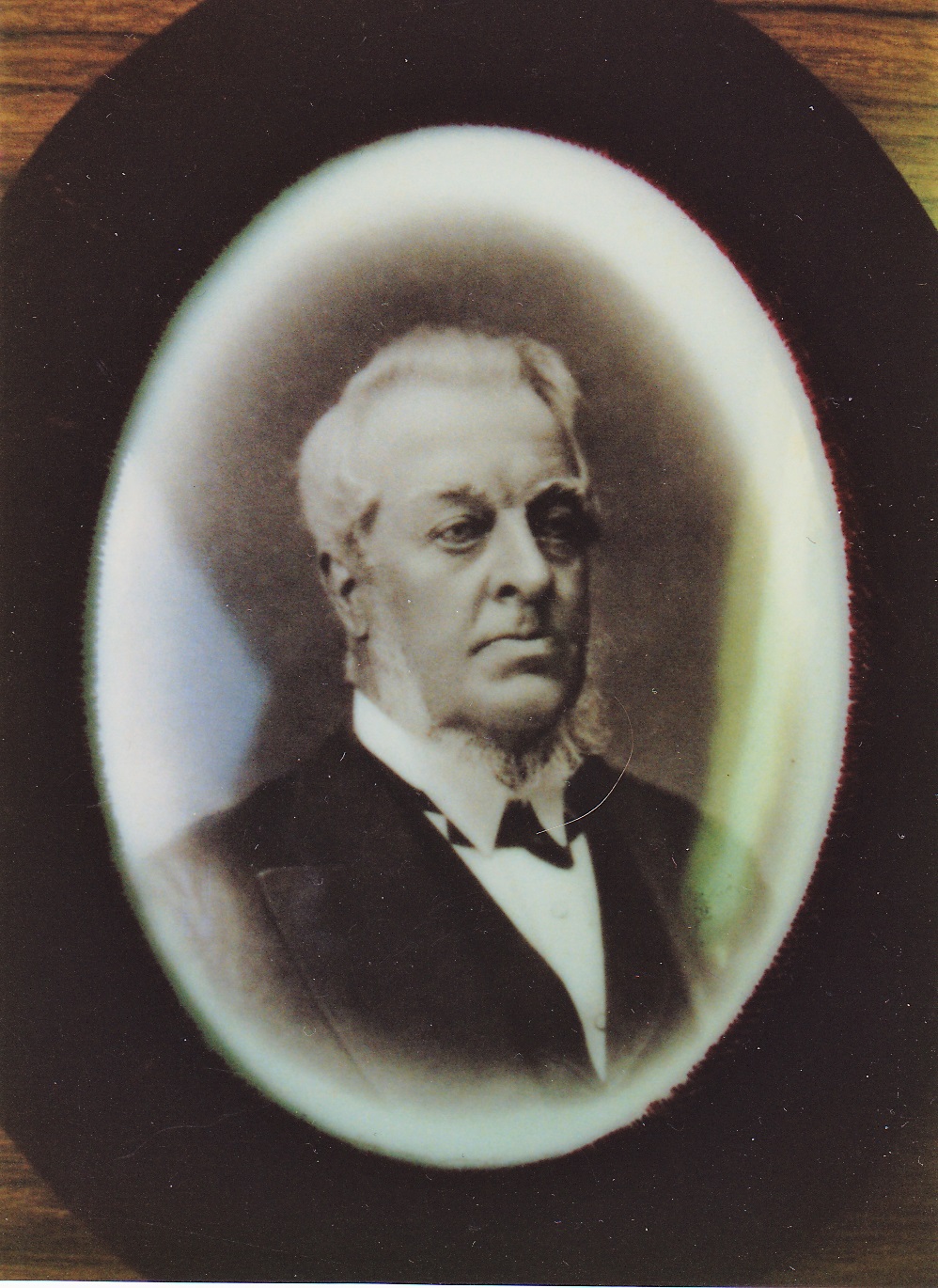
Joseph Marshall the 1st. 1814-1880, Marshall`s Brewery Paddington, NSW. Wife Esther Stockdale 1817-1910.
Joseph Marshall acquired land in 1853. He resided on Lot 5 and established the Paddington Brewery on Lot 6. Marshall slowly acquired the neighbouring allotments to grow the Paddington Brewery. In the late 19th century, the brewery supported its own Paddington Brewery Fire Brigade. In or by 1910, the brewery land was sold to Olympia Limited and demolition of the extensive brewery complex began. The Olympia Theatre currently occupies the site.
MARRIAGE.
On Saturday last, the 15th instant, at the residence of Thomas Robinson, Esq., Cam-perdown, by the Rev. Dr. McGarvie, Mr. Joseph Marshall, of Sydney, to Esther, eldest daughter of Mr. James Stockdale, of Brisbane Water, and grand-daughter of George Robinson, Esq., of Carnaby, near Burlington, Yorkshire. Family Notices (1843, April 20). The Sydney Morning Herald (NSW : 1842 - 1954), p. 3. Retrieved from http://nla.gov.au/nla.news-article12413481
In the Supreme Court of New South Wales.
PROBATE JURISDICTION.
In the will and codicil thereto of Esther Marshall, late of " Fairlight," Elizabeth Bay, near Sydney, in the State of New Soyth Wales (formerly of Wahroonga, in the said State), widow, deceased.
NOTICE is hereby given that all creditors and other persons having any claim upon or affecting the estate of the abovenamed deceased, who died on the 16th day of April, 1910, and probate of whose will and codicil was granted by tho Supreme Court of New South Wales, in its Probate Jurisdiction, on the 15th day of June, 1910, are hereby required to send in full particulars of their claims to The Permanent Trustee Company of New South Wales (Limited), 0 Connell-street, Sydney, the executors of the said estate, on or before the 4th day of August next, after which date the said The Permanent Trustee Company of New South Wales (Limited) will proceed to distribute the assets of the said deceased among the parties entitled thereto, having regard to the debts and claims only of which it shall then have had notice ; and the said Company shall not be liable, for the assets or any part thereof so distributed, to any person of whose claim it shall not have had notice at the time of such distribution.—Dated this 17th day of June, 1910.
For The Permanent Trustee Company of New South Wales (Limited).
A. PERCEVAL BEDFORD.
T. Marshall & Marks, Proctors, 70 Pitt-street, Sydney. 4132 Manager. PROBATE JURISDICTION. (1910, June 22). Government Gazette of the State of New South Wales (Sydney, NSW : 1901 - 2001), p. 3488. Retrieved from http://nla.gov.au/nla.news-article226906583
In the Supreme Court of New South Wales.
ECCLESIASTICAL JURISDICTION.
In the will of Joseph Marshall, late of Fairlight, Elizabeth Bay Point, Sydney, in the Colony of New South Wales, brewer, deceased.
NOTICE is hereby given, that after the expiration of fourteen days from the publication hereof in the New South Wales Government (3-azette, application will be made to this Honorable Court, in its Ecclesiastical Jurisdiction, that probate of the last will and testament of the abovenamed deceased may be granted to Esther Marshall, of Fairlight, Elizabeth Bay Point aforesaid, the widow of the abovenamed deceased, the executrix in the said will named, leave being reserved to the executor therein named to come in and prove the same if he shall think fit.—Dated this 19th day of May a.d. 1880.
THOMAS MARSHALL,
Proctor for Executrix,
133, Pitt-street, Sydney. ECCLESIASTICAL JURISDICTION. (1880, May 21). New South Wales Government Gazette (Sydney, NSW : 1832 - 1900), p. 2370. Retrieved from http://nla.gov.au/nla.news-article221628950
The Late Mr. Joseph Marshall.
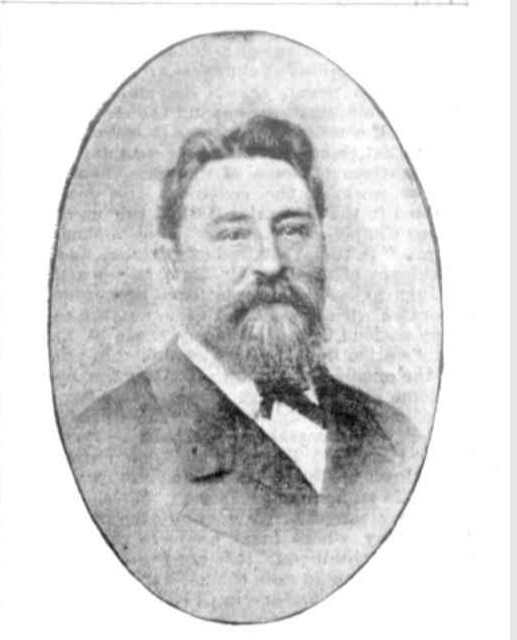
The late Mr. Joseph Marshall, whose death has recently been announced, was the managing director of Marshall's Paddington Brewery, Limited. He was born in Sydney May, 3, 1845, and was the oldest son of Mr. Joseph Marshall, sen., who died sometime in 1880, and was the founder of the business. His education was of the most liberal character, and evincing a tendency for business, he was, after a slight novitiate in the office of Messrs. Keele, Campbell and Co, wine and spirit merchants (who then carried on business in Hunter-street) at his father's request, induced to enter the office of 'the brewery.
After the death of Mr. Marshall, sen., the subject of this sketch, with the assistance of his brother, continued with the greatest success the management of the business. Under the joint control of the two brothers the industry grew at such a rate that it was deemed advisable to float the business into a limited liability company. This object was accomplished about three years ago by Messrs. Bernard, Michael, and Collier; Mr. Joseph Marshall being chosen managing director, which position he held with the highest credit and respect up to the time of his death. Mr. Marshall had the good opinion of all the commercial men of standing in the city, and his demise came as a shock to those who were best able to estimate his honor, friendship, and the promising career that lay before him.
He was a prominent Mason, and at one period held the position of Grand Master of one of the metropolitan lodges. For some years he took great and active interest in the scheme for supplying Broken Hill with water. He was one of the originators of the scheme which engaged to bring the water from the Darling River, via Speculation Lake, and in which he was joined by the Hon. Henry Cox and the Hon. R. H. D. White.
Mr. Marshall promoted with great energy the introduction of the electric light, and was a member of the firm of Westcott, Marshall, and Adams, electricians, York-street, Sydney. This firm, it may be mentioned, erected the electric lighting plants at Newcastle, Broken Hill, and Bullock Island, the latter work being done for the Government. He was a great sportsman in all its phases, inheriting the quality from his family before him. His grandfather, the late Sir Henry Robinson, of Carnaby, Yorkshire, being in his day the breeder, of the best strain of racing blood in England.
Mr. Marshall's charity and kindliness of disposition were proverbial, his ready help in the cause of distress costing him, without exaggeration, thousands of pounds.
The deceased gentlemen was taken ill on August 12, and notwithstanding the skill and attention of five medical men, died at his residence, Plevna, Elizabeth Bay, on the night of August 14. He leaves a widow and four children, two boys and two girls. His mother, who has attained a ripe age, resides at Bondi. He has also left two brothers, well known and respected in business circles, namely Mr. James John Marshall, of the brewing firm, and Mr. Thomas Marshall, of the firm of Want and Marshall, solicitors, Pitt-street, Sydney. The Late Mr. Joseph Marshall. (1891, September 5). Australian Town and Country Journal (Sydney, NSW : 1870 - 1907), p. 27. Retrieved from http://nla.gov.au/nla.news-article71257007
Dugald Macpherson - 100 acres - also shows on some early lithographs as 'D Mcpherson'
There are several 'Dugald' Macphersons. The one who would appear to be most likely associated with the land grant or as owner who shows in the 1886 map may be the Dugald Macpherson, Chief Clerk of the NSW Treasury Department, who held this position from 1839 until he died in 1854 and was also in charge of selling land. He held several small and larger plots of land within the Sydney area and outer districts.
On the 14th instant, at his residence, Coogee, Mr. Dugald Macpherson, of the Colonial Treasury. Much respected. - 1854
At Naremburn, near Willoughby, the land on which Central Township developed originally comprised two crown grants, of about six acres (2.4 hectares) each, granted to Dugald MacPherson in 1853 and 1854. MacPherson died in 1854 and the land remained in his wife's name until her death in 1877. At this time George Penkivil Slade, a solicitor from Sydney, obtained ownership. In October 1879 Slade sold the land to the Surveyor of Sydney, George Bishop, who completed subdivision of the land for development. The exact origin of the name Naremburn is unknown, although a number of theories have been proposed. One such theory is that the term is a corruption of Merrenburn, the name of the home of Alexander Dodds, who was an early landowner in the area. There has also been speculation that Naremburn is a variation on the Scottish term 'near a burn', alluding to the proximity of Flat Rock Creek. Yet another theory is that Naremburn is an anglicised version of the Aboriginal terms 'narra', referring to forks, forking or forked, and 'burren', which means creek or a similar feature. Prior to development, Flat Rock Creek in Naremburn was joined by another creek creating a 'fork', so the Aboriginal terminology would have aptly described a significant geographical feature. This theory is strengthened considering that Naremburn referred to the entire district from the late 1800s, as opposed to just the town.Evans, Clare, Naremburn, Dictionary of Sydney, 2008, http://dictionaryofsydney.org/entry/naremburn
In the Supreme Court of New South Wales.
ECCLESIASTICAL JURISDICTION.
In the Will of Dugald Macpherson, late of William-street, in the City of Sydney, in the Colony of New South Wales, gentleman, deceased.
NOTICE is hereby given, that after the expiration of fourteen days from the publication hereof, application will be made to this Honorable Court, in its Ecclesiastical Jurisdiction, that Probate of the "Will of the said Dugald Macpherson, be granted to Christy Anne Macpherson, the widow of the said deceased.—Dated this 25th day of April, A.D. 1854.
DUNSMURE & STAFFORD, Proctors for the said Christy Anne Macpherson. ECCLESIASTICAL JURISDICTION. (1854, April 25). New South Wales Government Gazette (Sydney, NSW : 1832 - 1900), p. 858. Retrieved from http://nla.gov.au/nla.news-article230695893
In the Supreme Court of New South Wales.
ECCLESIASTICAL JURISDICTION.
In the estate and effects of Christy Ann Macpherson, late of Balmain, near Sydney, in the Colony of New South Wales, widow, deceased, intestate.
NOTICE is hereby given, that after the expiration of fourteen days from the date of the publication hereof, application will be made to the Supreme Court of New South Wales, in its Ecclesiastical Jurisdiction, that letters of administration of all and singular the estate and effects of the abovenamed deceased may be granted to Alexander Macpherson, of Sydney aforesaid, mercantile clerk, son and next of kin of the said deceased.—Dated this 6th day of November, a.d, 1877.
SPAIN & SLY.
Proctors for the Applicant, Exchange, Sydney. ECCLESIASTICAL JURISDICTION. (1877, November 8). New South Wales Government Gazette (Sydney, NSW : 1832 - 1900), p. 4384. Retrieved from http://nla.gov.au/nla.news-article225826376
NSW BDMs deaths; MACPHERSON CHRISTINA A 2060/1877 Parents: PETER ISABELLA BALMAIN
NSW BDMs Births;
MACPHERSON ROBERT S 95/1845 V184595 48 Parents: DUGALD CHRISTY A
MACPHERSON SARAH A 96/1845 V184596 48 Parents: DUGALD CHRISTY A
NSW BDMs Deaths;
MACPHERSON ALEXANDER 11128/1910 Parents: DUGALD CHRISTINA Registered at: ST LEONARDS
MACPHERSON.—September 7, at his residence 104 Carabella street North Sydney, Alexander Macpherson late accountant Presbyterian Church Office in his 69th year Service in St Stephen s Church today Thursday at 1 o'clock. Family Notices (1910, September 8). The Sydney Morning Herald (NSW : 1842 - 1954), p. 8. Retrieved from http://nla.gov.au/nla.news-article15171718
TREASURY IRON CHEST.
REPORT of the Board appointed by command of his Excellency the Governor-General to inquire into the amount of deficiency that has been alleged to have existed in the Iron Chest kept in the Receiving room of the Colonial Treasury by the late Dugald Macpherson.
Sydney, 5th April, 1856.
Sir-Having made a careful investigation into the deficiency alleged to have existed in the moneys received by the late Dr. Dugald Macpherson, (in connection with the iron chest kept by him in the Receiving Room of the Colonial Treasury, the Board have now the honour to submit a statement of accounts which has been compiled by them from the Cash books kept by that officer, as also a copy of the evidence taken by the Board, and to report the result of their inquiry for the information of his Excellency the Governor-General.
2. Before proceeding to describe the character and description of the several debits set forth in the statement annexed, the Board think it may be well here to explain the reason given to them for the establishment of the iron chest ' in connection with the receiving department of the Colonial Treasury, and the course of proceeding adopted by Mr. Macpherson in reference to moneys entrüste 1 to his charge which ought to have been deposited there, until required to be applied as intended by the persons who remitted them.
3. In a communication addressed to the Board by the Honorable the Colonial Treasurer, dated the 22nd of January, that officer there explains the purpose for which the Chest was established, in the following way : -" The Chest in the receiving room was kept as a place of security for the deposit of such moneys as were received by post, but which could not be carried to the public account from the want of proper authority, or vouchers, or the absence of the necessary information to enable their being credited."
4. The course of proceeding was as far as can be ascertained by reference to the books kept in connexion with the chest) as follows :
The first halves of cheques or notes when remitted were deposited in the chest, there to remain until the second halves had been received. Such other moneys as were either insufficient for the purposes intended, or on ( account of which authorities had not reached the Treasury for their reception, were also deposited there, and allowed to remain until they could be properly applied, or returned to the persons who had originally remitted them. The amount of these remittances, whether in a complete or incomplete state, was .entered in a cash book kept for that purpose, having a column showing the date on which received, as well as that on which appropriated or returned as the case might be.
5. The statement herewith submitted by the Board has, therefore, been compiled from these books, commencing in the latter part of the year 1818, and extending to the period of Mr. Macphersons' death, which took place on the 14th of April, 1854. The debits which appear to have remained unappropriated during that period have been carefully compared with the communications received from the persons who remitted them, as well as with such Returns from Crown Land Commissioners-account sales of land and leases -furnished by the respective officers resident in the districts in which they have been made, and with the vouchers deposited in the Treasury, bearing on the several remittances, and the daily, cash book kept in the receiving room, which contains entries of all sums which have been carried to the credit of each branch of the revenue during each day.
6. The examination, therefore, which has now been made, although not entirely satisfactory, in consequence of the great lapse of time that has intervened since the death of Mr. Macpherson, may, as far as the claims are reported to be due to the Government, be taken as correct: those, however,;'which the Board suppose to ha due to individuals, (not having been appropriated as intended) may be capable of some reduction, as it is quite possible, from the unbusiness-like manner in which these accounts have been kept, the moneys may have been returned to those remitting them, or taken credit for in subsequent payments, and in either case omitted to be written off in the cash book, or an acknowledgment taken for the amount.
7. With these preliminary observations, the Board now proceed to analyse the statement of accounts submitted by them, under the several heads Into which they have been divided. The first account shews the amounts which were paid by Mr. Hollinworth, then next clerk in seniority in the Treasury to the late Mr. Macpherson, during his (Mr.Macphersons) absence from office on the score of ill health, amounting in all to £87513s. 9d., and which demands were met by payments out of the sums received as remittances during that period, as well as by an amount of £420, which was sent to Mr. Hollinworth by Mr. Macpherson expressly for that purpose. The second account is of a similar description, but the amounts were paid by Mr. Lennon, a junior clerk in the Receiving Branch of the Colonial Treasury, who acted in the absence, not only of Mr. Macpherson, but also of Mr. Hollinworth, who had at that time obtained leave to proceed to England. The sum paid away by Mr. Lennon amounted to £59 3s. 7d. The third account consists of amounts which appeared to have been received during Mr. Macpherson s lifetime, and which were duly claimed by the persons who remitted them, or were carried to the credit of the several branches of revenue for which they were intended, and the funds which were available for this purpose were found in the iron chest when examined after the death of Mr. Macpherson.
Amongst the payments made in this account, (No. 3) will be found the sum of £420, which was claimed by Mr. Byers, as Executor of Mr. Macpherson's estate, as money not belonging to the Government, but only advanced during Mr. Macpherson's illness to meet the demands on the iron chest, and thereby to prevent the necessity of disturbing any of the moneys deposited there. This money was, it appears, allowed to be paid to Mr. Byers by the Colonial Treasurer, who was not at that time, cognizant of any deficiency that existed in regard to public moneys received by Mr. Macpherson. The amount appearing in this account (No. 3) as thus paid is £1090 10s. 6d.
The fourth account consists of various claims which were towards the latter part of the year 1854, made against the iron chest, and these sums having been clearly ascertained to have been received by the late Mr. Macpherson, were, by direction of the Colonial Treasurer, provided for by moneys which were advanced out of, the Suspense Fund, to meet the required payments, the whole of the sums discovered in the iron chest having been by that time paid away, and, there being no further moneys available from Mr. Macpherson's estate to meet the pressing demands which which were made by these people. The amount thus advanced amounted to £251 Is. 11d. The next account consists of claims which have been ascertained to belong to the iron chest, which have been allowed to the several persons claiming them as payments made to the Government, and on account of which several additional amounts have been received to complete the payments or purchases which now remain in the Suspense Fund, which amounts, as well as the sums ascertained to have been received by Mr. Macpherson, ought to have been credited to the several branches of revenue to which they properly belonged, on the date on which the additional payments were received, but were not so credited in consequence of the absence of funds where-with to meet them. The amount of claims due to the Government under this head is £292 12s. 6d.
The next account consists of various sums which the Board have ascertained to have been received by the late Mr. Macpherson, to be applied in payment of certain amounts due to the respective branches of the revenue for which they were intended, and which sums do not appear to have been so credited. These claims amounting to ' £252 4s. 9d., which are clearly due to the Crown, when taken into conjunction with the preceding'accounts make a debit of £2821 7s.
The next class of claims against the Iron Chest which the Board have to submit, consists of amounts which have been remitted at various times in payment of sums which the parties remitting conceived were due to the Government, but which sums could not be recognized by the Government, at the time the moneys were so remitted, for various causes which it is not requisite here to allude to ; and as they could not be appropriated as intended, ought to have been returned to those who sent them, or should have been still available, when demanded. The Board have no doubt as to the correctness of a portion of this claim, as many remittances have been established beyond a doubt, which ought to be-in the Chest still intended to be applied as originally proposed, but there are others respecting which, since the amount may have been returned, and no record of such return been made, the Board have not found themselves in a position to arrive at any satisfactory conclusion, feeling precluded from addressing inquiries to the parties who had remitted such sums, by the consideration that their doing so might possibly operate to the prejudice of the estate of the deceased,-of this class the total amount of claims reaches the sum of £687 2s. 10d.
The eighth and last account exhibits the particulars of a few receipts which are of so doubtful a character that the Board are quite unable to say to whom they belong, or whether they ought at all to form a claim against the'estate.' These receipts amount to £22 9s. 6d.' The gross total of these several accounts is £3430 19s. 4d. which will stand to the debit of the Iron Chest.
8. Having now disposed of the debit side of the account, the Board propose to offer a few observations on the several 'amounts which the chest is entitled to be credited with, as well as on the mode which has been adopted for ascertaining the contents of the chest after Mr. Macphersons death. The only amount which Mr. Macpherson is entitled to receive credit for, in addition to the moneys found in the chest, are two sums of £420, and £8 10s,, the first of which was brought to Mr. Hollinworth, during Mr. Macpherson's illness, and the latter was paid by his widow after his death, to meet some immediate demand then made upon the chest. The amount reported to the Board by Mr. Hollinworth to have been discovered in the chest after Mr. Macphersons death, consisting of cheques, notes, cash, and other securities, more fully set out in the credit side of the account, amounted in all to £1659 Ils. 6d. This amount is demurred to by Mr. Byers, for the reason that the original memorandum which was made in the presence of himself, Mr. Macdonald, and Mr.Hollinworth, and which was in Mr. Macdonalds handwriting, was destroyed by Mr.Hollinworth, before a copy which had been made by Mr. H. had been compared with the original.
Mr. Hollinworth acknowledges that this was, he believes, the case, but at the same time asserts that the memorandum made by him contained a true account of all the moneys or other valuable securities found in the chest and entered in Mr. Macdonalds memorandum of the previous day, and that the only difference that existed was in reference to the arrangement of the several items, which he had divided into classes, with a view of simplifying the document, "and thus rendering' reference more easy. The Board are willing to place every confidence in the assertion made by Mr. Hollinworth, more particularly as neither Mr. Byers nor Mr. Macdonald can point out any practical discrepancy in the existing document ; but they are nevertheless constrained to observe that it is much to be regretted that the original memorandum is not _ forthcoming, or that a more formal investigation had not been directed at the time to have been held in a matter in which the interests of the revenue were, it now appears so deeply involved. Assuming, therefore,' that the amount set forth as that found in the chest is correct, the actual sum that will be due from the estate of the late Dugald Macpherson to the revenue, will amount to £1342 17s. 10d.
9. The board have, in conclusion, to observe, that the fact elicited from Mr. Byers, in his evidence in reference to the cheque given by his firm to meet a deficiency acknowledged by Mr. Macpherson then to exist, and which cheque was found in a separate cash box contained in the iron chest, and the proceeds used to pay the then existing demands, leads them to the conclusion that the late Mr. Macpherson had been in the habit of making use of the public moneys entrusted to his charge, and that the large balances which appear to have been constantly in his hands, prevented any discovery of this having been, made previous to his death.
In addition to the accounts previously alluded to, the Board have to submit a return of certain dishonored promissory notes and unpaid cheques, amounting in all, to £5,021 12s. 10d., which notes and cheques were found in Mr. Macpherson's desk; but as to whether these notes and cheques have been taken up by subsequent payments, or ought to be collected as moneys due to the Crown, the Board are unable to offer any opinion.
We have, &o,,'
W. C. MAYNE.
H. H. BROWNE. '
The Honorable the Colonial Secretary, &c, &c, &o.'
TREASURY IRON CHEST. (1857, May 18). The Sydney Morning Herald (NSW : 1842 - 1954), p. 3. Retrieved from http://nla.gov.au/nla.news-article12995707
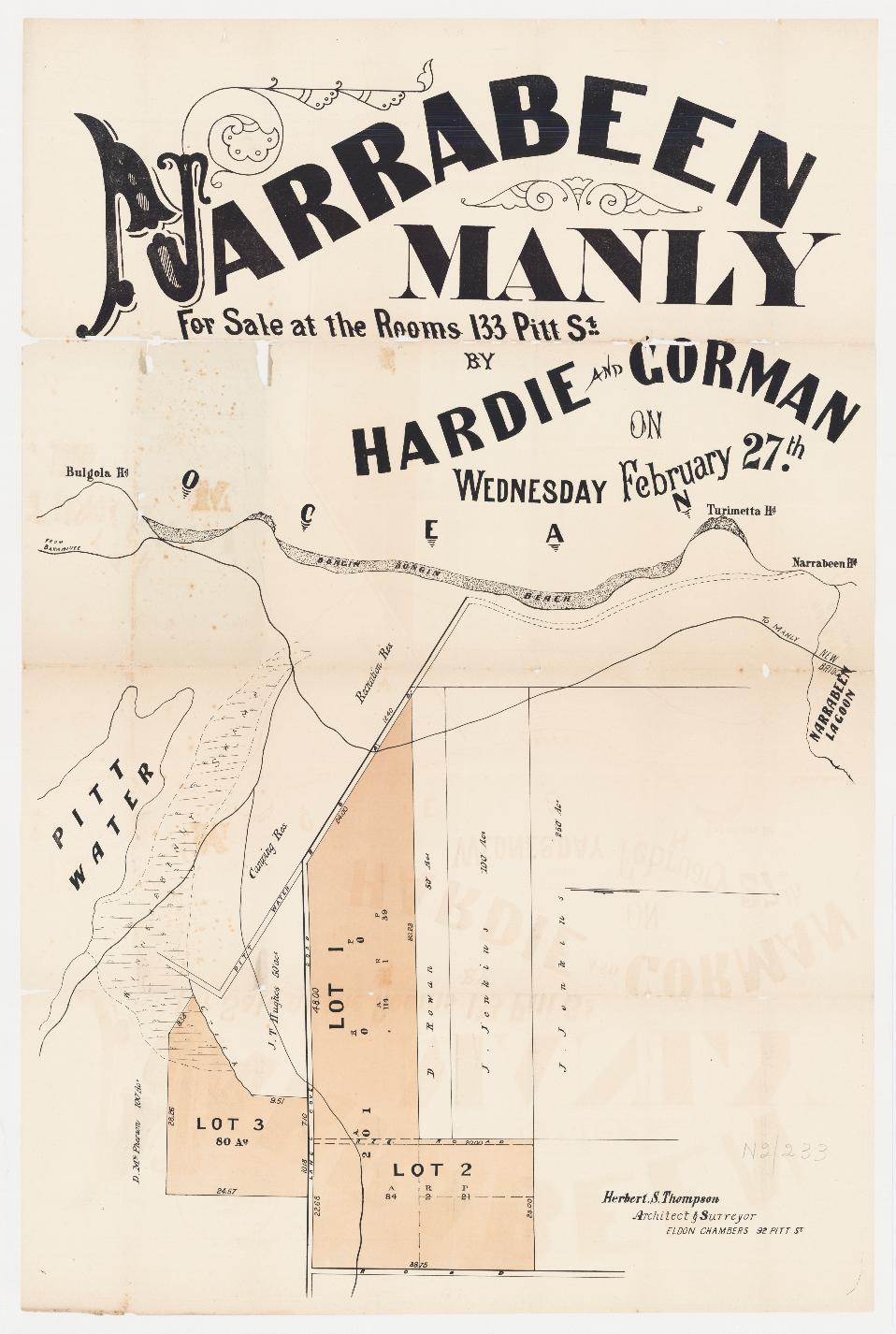
Narrabeen Manly - Pittwater Rd, Lane Cove Rd, [1881] Item No.: c050370239 , courtesy State Library of NSW, Narrabeen Subdivision Plans album - this is towards Mona Vale (then called the 'Village of Turimetta') - showing 'D. McPherson'
Another 'Dugald Macpherson land holder - on a larger scale:
PASTORAL PIONEERS
By R.V.B. and A.S.K.
DUGALD MACPHERSON
No. 90.
ONE of the many MacPhersons who have figured conspicuously in the pastoral affairs of Australia, Dugald from Ashens, left Greenock for Port Phillip in 1840. He arrived in July, when much of the present site of Melbourne was under water, following heavy rains. Soon after his arrival in Port Phillip, MacPherson joined William Taylor—afterwards known as Taylor, of Overnewton—in partnership. For some years they depastured sheep along the Moorabool River. In 1843 Mac- Pherson did some exploring. Accom-panied by G. F. Belcher, a Treasury' official of Geelong, he followed the track of Eyre, then the overlander, and later the great explorer, down the Wimmera River to Lake Hindmarsh. Eyre's old camp at Lake Hindmarsh was found. There Eyre had been repulsed on his attempted over landing trip to Adelaide.
MacPherson and Belcher went on by the Becquon (Big-one) and Tullyvea water holes, to the swamp called by the blacks, Nyell, or the abode of evil spirits. The consonant Y was changed to H later, and the vowel to I, making the name a hill.
MacPherson returned to the Moorabool, and the partners (MacPherson and Tay- lor) took up and stocked Ashens, a run of more than 200,000 acres on the Wimmera and Yarriambiack Creek. That was early in 1844. Fours years later the partnership was dissolved. MacPherson re- tained 53,600 acres of the run, which con- tinued to be known as Ashens, while Tay- lor's share was 153,000 acres, called Longerenong.
Subsequently Nhil and Coolanuck were purchased by MacPherson from Atkinson and Pepper. Afterwards Cow Plains came into his hands. Macdonald, who had stocked Cow Plains, was taken into part nership. Western Strathdownie, bought from the Learmonths of Ercildoune, was one of MacPherson's runs for a time. Bunjeeltap was purchased from an old Gee- long friend, John Cowie, and Bunjeeltap became the favourite possession of Mac-Pherson.
When Woriagworm was subdivided in 1865, the Winiam portion, a very considerable slice of the old run was secured by MacPherson, whose land interests were not confined to Victoria. He had con-siderable property in New South Wales.
Dugald MacPherson married a daughter of Richard Ocock, a much respected solicitor of early Melbourne. They had seven sons and five daughters. Peter MacPherson, a brother, seven years younger than Dugald, came to Victoria in 1864. He married another daughter of Richard Ocock, and had four sons and four daughters. Peter was widely known as the owner of Paika. John, a brother still younger, also had extensive pastoral interests. Aged 82, Dugald MacPherson died at Bunjeeltap in 1901. Peter died at Toorak in 1894. John died at Nice in 1888.
(This series of articles was begun in "The Argus" on August 14, 1934, and was transferred to "The Australasian" on October 6.)NOTES AND QUERIES (1935, September 14). The Australasian (Melbourne, Vic. : 1864 - 1946), p. 4. Retrieved from http://nla.gov.au/nla.news-article141762392
Dugald McPherson (1820-1901)was a pioneer squatter who first settled at Ballan, north-west of Melbourne, and subsequently developed huge landholdings in north-western Victoria, New South Wales and Queensland. A stalwart of the Scottish immigrant community, Dugald was chief of the Highland Society of Ballarat and an elder of the Presbyterian Church. With other wealthy pastoralists, he later helped form the Australian Club in William Street.
Dugald's mother had been a McKellar, with later family connections to the Western District. Dugald's second son Arthur married Annie Fawkner, a daughter of John Fawkner. In 1861, William Wills, father of William John Wills of Burke & Wills fame, stayed briefly with Dugald during the agonizing wait for his missing son.
The regalia was passed onto Dugald's youngest son John (aka Jack). It was subsequently passed to Dugald's great-great-granddaughter, Hope Macpherson, a long-time employee of Museum Victoria. Hope says that the family remembered Dugald as very interested in his Scottish heritage and 'land-hungry'. A revolver also apparently used by Dugald is also held in Museum Victoria's collection.
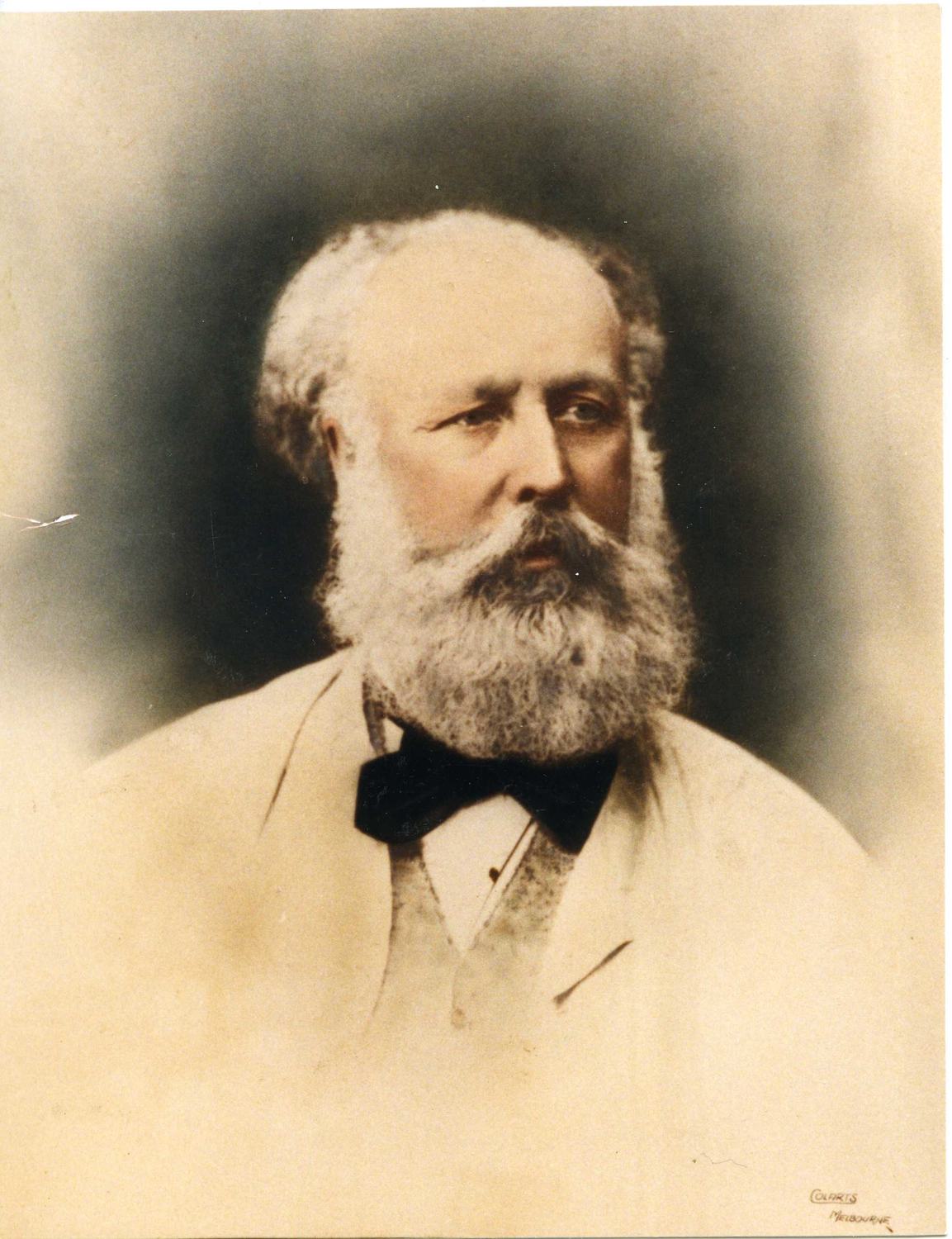
Dugald McPherson, Photographer: Colarts Studio. Source: Museums Victoria. Credit: Courtesy of Ballan Shire Historical Society Inc. Public Domain (Licensed as Public Domain Mark). Text Museums Victoria Collections https://collections.museumsvictoria.com.au/items/382341
J. T. Hughes - John Terry Hughes - 50 acres
This gentleman had accusations of fraudulent selling of his own cattle and sheep levelled against him in 1839 and subsequent trials, which went on for years, found he had been falsely accused in a move to steal his property. He was imprisoned and despite appeals for bail, it took a few years before even this was granted - meantime, those conducting the fraud, were selling his goods and property out from under him.
Unfortunately the newspapers of the time seemed to be on the side of the those against him and the reports went on for the length of the trials and appeared in other states as well as NSW journals:
THE CELEBRATED JOHN TERRY HUGHES.
At the Court of Quarter Sessions on Friday last, John Terry Hughes was convicted of "stealing" an order for the payment of some five pounds from Daniel Shea. The order had been drawn by Hughes him-self in favor of Shea, on Hughes' agent in the country, by whom it was dishonored. Shea, on his return to Sydney, presented the order to Hughes, stating that his agent had refused payment, on which Hughes, as we are informed, tore the order, and told Shea to, go to ____. For the offence, Hughes was indicted at the Quarter Sessions, convicted, and sentenced to six months' imprisonment. The terrible evils which the insolvency of this man brought upon many respectable persons, evils which extended to the suspension of the operations of one of the leading banks of the colony, have given such notoriety to his name, as to render his imprisonment for stealing, a matter of more than ordinary interest. An action had already been commenced against him by the chairman of the Bank of Australia, for fraudulent insolvency, his certificate of discharge having been refuted by the Supreme Court; and should the action be maintained, we sincerely trust that the law will cause this unprincipled man to feel the effects of that course of mercantile chicanery which has already elicited the strong indignation of the whole community. The defalcations of men of Hughes' stamp reflect discredit on the Community to which he belongs, and though it may not be often that a single individual, of a single firm, has the power of shaking the public character to such an extent, the occurrence of such nefarious transactions ought to be and in this instance, we hope will be, followed, not only by the condemnation of public opinion, but by the severest punishment which the law allows to be inflicted. Sydney Sentinel. THE CELEBRATED JOHN TERRY HUGHES. (1847, February 26). Colonial Times (Hobart, Tas. : 1828 - 1857), p. 3. Retrieved from http://nla.gov.au/nla.news-article8760137
THE QUEEN ON THE PROSECUTION OF STIRLING v. J. .T. Hughes.-On the calling of this case on Tuesday last, Mr. Dowling said that having looked over the depositions taken in the case, he was of opinion that they presented a case of fraudulent insolvency against Mr. Hughes, and that it therefore became his duty to send it on for trial. Mr. Hughes was admitted to bail--himself in £80, with two sureties in £40 each. Goulburn Herald and County of Argyle Advertiser (NSW : 1848 - 1859), Saturday 22 February 1851, page 3
John Terry Hughes was a nephew of Samuel Terry (1776?-1838), merchant landowner and 'The Botany Bay Rothschild'; he married a step-daughter, Esther Marsh, of Samuel Terry.
When (Samuel) Terry died on 22 February 1838, three years after a paralytic seizure, he was buried with Masonic honours and the band of the 50th Regiment led the procession. The funeral, described as the grandest seen in the colony, may be taken as the summation of his life's striving. He left a personal estate of £250,000, an income of over £10,000 a year from Sydney rentals, and landed property that defies assessment. His will was eventually published by the government as a public document. His wife lived until 5 September 1858. The family sold to the government the land now occupied by Martin Place and the General Post Office, Sydney.
Although transported for theft, Samuel Terry by had a farm on the Hawkesbury River by 1809. By 1815 Terry had established a farm, Mount Pleasant, on the Nepean River and also had Illawarra properties; in 1817 Governor Lachlan Macquarie, who granted him city allotments, described him as a 'wealthy trader'. Terry was also an important supplier of flour and fresh meat to the government. Between 1817 and 1820 he held more than a fifth of the total value of mortgages registered in the colony, a higher proportion than that of the Bank of New South Wales. Commissioner John Thomas Bigge reported that in 1820 he had 1450 cattle, 3800 sheep, and 19,000 acres (7689 ha), almost exactly half of the land held by former convicts. He was also one of the largest shareholders in the bank, but when he stood for election as director in 1818, 1819 and 1820 he was unsuccessful; when elected in 1822 he was refused his seat on the pretext that, as an expiree, he was not 'unconditionally free'. - from Gwyneth Dow, 'Terry, Samuel (1776–1838)', Australian Dictionary of Biography, National Centre of Biography, Australian National University, http://adb.anu.edu.au/biography/terry-samuel-2721/text3833
John Terry Hughes, 1803–1851 came to Sydney as a 21 year old, landing May 27th, 1824, via the ship 'Hope'. In 1824 John was granted 1200 acres by Governor Brisbane, and 800 acres more in 1825. He bought 1000 acres in May of that year and 4000 more in November. These figures were given in a report by John Oxley who had serious misgivings regarding the concentration of such large amounts of property, because Samuel Terry and his sons, as well as Hughes, had been authorised to purchase other large blocks of land in the same period. - Hornsby Shire Historical Society (comp). Pioneers of Hornsby Shire, 1788-1906 : a history / compiled by the Research Committee of the Hornsby Shire Historical Society. Sydney: Library of Australian History, 1979
John Terry Hughes a bachelor of Sydney was married to Esther Marsh a spinster of the same place by Rev. W. Cowper in Sydney on 23 Sep 1825, a licence having been obtained 20 Sep 1825. They were married at St Philips; The 'Sydney Gazette' reported that 'after the ceremony, the happy couple set off in their chariot to Mr Terry's country seat at Box Hill.' They 'took the world easy and lived in fine style'.
John Terry Hughes became a brewer, miller, hotelier, whaler, shipowner, merchant and land speculator. He went into partnership with John Hosking, who had married Samuel and Rosetta's daughter, Martha. When their underinsured Albion Mills burnt down in 1841, they attempted to save themselves from financial collapse by borrowing large sums against the assets of the Bank of Australia. Their company finally collapsed in 1843 and they brought the bank and themselves down to spectacular bankruptcy proceedings which went on and on.
Despite objections regarding the purchase of large tracts of land by individuals, John continued to obtain leases and to purchase property. On 18 Aug 1842 he got a grant of 2000 acres at South Colah, with a quit rent of one peppercorn. This land included Mt. Pretoria to the west of the present Hornsby, and went across by a narrow strip to the east of Spring Gully Creek.John does not appear to have made any constructive use of this land. - Hornsby Shire Historical Society (comp). Pioneers of Hornsby Shire, 1788-1906 : a history / compiled by the Research Committee of the Hornsby Shire Historical Society. Sydney: Library of Australian History, 1979
John lived at 'Albion House' in Elizabeth Street Sydney, and for the last 5 years of his life, was involved in legal proceedings following his bankruptcy in 1843. His numerous activities included brewing, flour milling, hotel-keeping and trading. He was aged just 49 when he died.
Death. On the 17th instant, at his residence, Albion House, Elizabeth-street South, Sydney, John Terry Hughes, Esq., in his forty-ninth year. Family Notices (1851, October 22). The Maitland Mercury and Hunter River General Advertiser (NSW : 1843 - 1893), p. 3. Retrieved from http://nla.gov.au/nla.news-article678563
The couple had daughters and one son: Ellen Rosetta Hughes 1826–1914, Samuel Terry Hughes 1829–1865, Ann Elizabeth Hughes 1831–1907, Martha Theresa Hughes 1832–1841, Priscilla Hughes 1834–1896, Esther Matilda Hosking Hughes 1837–1900, Emma S. Hughes 1839–1841, Henrietta Hughes 1841–1908.
LAWRY—HOSKING—March 25th, at Christ Church, by the Rev. J. Pendrill, Thomas Lawry, Esq., of her Majesty's War Department, to Esther Matilda Hosking, daughter of the late John Terry Hughes, Esq. Family Notices (1858, April 10). The Sydney Morning Herald (NSW : 1842 - 1954), p. 7. Retrieved from http://nla.gov.au/nla.news-article13008614 - Thomas died in 1890 and Esther M H remarried - to a James Taylor.
J T Hughes devised much of his larger holdings to family members prior to passing and during the year when his holdings were being sequestered for his creditors who then, along with anyone they had married, became the targets for litigators - an example; -
ILLAWARRA- 19. Rosetta Therry, 1200 acres, county of Camden, at Illawarra ; promised by Governor Thomas Brisbane, on the 26th June, 1824, to John Terry Hughes, and now at his request advertised in favour of Mrs. Rosetta Terry. Quit rent £9 per annum. GOVERNMENT GAZETTE. (1851, February 21). The Sydney Morning Herald (NSW : 1842 - 1954), p. 4. Retrieved from http://nla.gov.au/nla.news-article12924960
Rosetta Terry was the wife of Samuel Terry, she had come free to NSW although was on a ship where her then common law husband, a convict, purportedly died on the voyage here. On the death of her step father, Samuel Terry in 1838, Esther Hughes inherited a substantial amount in her own right and as the heir of her brother Henry Marsh. When Esther died in 1873 her personal estate was valued at £24,000 excluding the value of any land still held. Much of her property was held in trust for the benefit of her children and grandchildren. At least two of these trusts, with assets of land in King and Pitts Streets in the heart of Sydney, were not finally wound up until their sale in the 1940s and 1950s.
On the 20th August.at Albion House, Elizabeth-street south, Esther, relict of the late John Terry Hughes, Esq , aged 70 years. Family Notices (1873, September 6). Australian Town and Country Journal (Sydney, NSW : 1870 - 1907), p. 28. Retrieved from http://nla.gov.au/nla.news-article70480787
In the Supreme Court of New South Wales.
ECCLESIASTICAL JURISDICTION.
In the will of Esther Hughes, late of Albion House, Elizabeth street, Sydney, in the Colony of New South Wales, widow, deceased.
NOTICE is hereby given, that after the expiration of fourteen days from the publication hereof, application will be made to this Honorable Court by James Taylor and Ellen Hughes, the executors named in the will of- the abovenamed deceased, that probate thereof may be granted to them as such executors.— Dated this 1st day of September, A..D. 1873.
ELLIS & MAKINSON,
Proctors for said Executors, 89, Elizabeth-street, Sydney. ECCLESIASTICAL JURISDICTION. (1873, September 2). New South Wales Government Gazette (Sydney, NSW : 1832 - 1900), p. 2400. Retrieved from http://nla.gov.au/nla.news-article223104202
John Redman
John Redman (1812–1888) was the eldest son of John Redman, one of 1063 convicts transported on the ships Neptune, Scarborough and Surprize, December 1789 and Mary George, conditional pardon, Canada, 1810, life, wife of Mr. Redmond, Sydney. John snr. Sentence details: Convicted at Sussex Assizes for a term of 14 years on 27 March 1787.
John Redman (the convict) was born c.1763. He impressed authorities in the Colony for he received a conditional pardon in 1794, was appointed a Constable in 1800 and became Chief Constable of Sydney in 1802. By that time he was the owner of a large property between the tidal flats of Sydney Cove and what is now George Street. Ten years later, in 1812 aged 49, he married Mary George by special licence. Mary was under 21 (born c. 1793).
John Redman’s stocks continued to rise and he became an entrepreneur of some magnitude. He owned the schooners Mary and Sally and the sloop Martha (his wife was Mary and his eldest daughter was Martha). As well as leasing his boats he also used them to ship cedar from Port Stephens and Shoalhaven.
In 1820, aged about 60, he retired from that role and was granted a pension of £30 a year. However he was almost immediately appointed as Chief Gaoler of the colony and was also granted a cart licence for George Street. This permitted the carriage of goods to and from the heart of the city. By the following year he was running a shop inside the gaol, which also happened to be in George Street, and was accused of charging higher prices than the shops. He was assigned a convict servant in 1821 and again in 1829 and 1830. He also owned and was the publican of the Keep Within Compass Hotel which was located almost opposite the gaol on the other side of George Street. The first issue of the Sydney Herald (to become the Sydney Morning Herald) was published from there in April 1831.
In 1830 John Redman took a trip back to England as the authorities ordered his pension to be paid there. He died in Sydney in 1837 at the age of 74, the Sydney Morning Herald of Thursday 30 November reporting “At an advanced age, on Sunday last, at his residence, Liverpool-street, Mr John Redman, a very old and respected Colonist, and many years Governor of HM Jail.”
His wife Mary survived for another 22 years, dying at the age of 67.
John Redman’s will indicates some of his wealth. There were five farms totalling 750 acres in the Botany Bay area, a farm in Belmore of c.450 acres and city properties in George Street, Liverpool Street and others. John and Mary Redman had three daughters and five sons. One son, William, became a solicitor and mining entrepreneur. When he in turn died in 1882, aged 58 years, he left large holdings of land in the Campsie/Belmore area - perhaps based on property inherited from his father - and also large holdings in Manly Warringah. His connection to our area - and also that of his older brother John - is commemorated by Redman Road at Dee Why and now by the Redman Road Plaza.
William died on 13 September 1882 at his residence, "Graycliff', Forest Lodge, aged 58 years. He had no children (SMH 19 Sept 1882). An Equity Suit, Redman and Redman and others, followed his death, whereby his Honour Mr Justice Faucett and a jury of four determined that William's Estate, sworn at just under £57,000, was to be divided as follows:- five-sevenths for his brother John Redman, one-seventh for William's widow Adelaide Redman and one-seventh for Mrs Dwyer, Adelaide's sister. (SMH and NSW Advertiser 25 Aug 1883). His vast land holdings began to be sold off from 1884.
On 4 February John Redman of Pittwater purchases 23 acres at Church Point on the point overlooking Pittwater from Jane James (nee Buist), the wife of Benjamin James (married 1868). Formerly the land was part of William Oliver’s land grant of 66 acres. On this property was a 3 room weatherboard cottage. After his death in April 1888, the land now 17 ¼ acres, not 23 acres, is advertised for Auction on 13 August 1888:
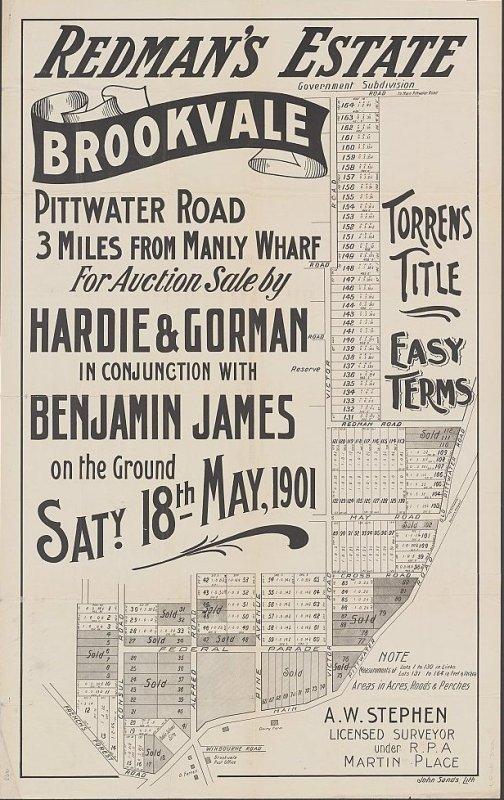 In the Supreme Court of New South. Wales.
In the Supreme Court of New South. Wales.
ECCLESIASTICAL JURISDICTION.
In the will of John Redman, late of Pittwater, near Sydney, in the Colony of New South Wales, Esquire, deceased.
NOTICE is hereby given that after the expiration of fourteen days from the publication hereof in the New South Wales Government Gazette, application will be made to this Honorable Court, in its Ecclesiastical Jurisdiction, that probate of the last will and testament of the abovenamed deceased, who died on or about the 24th day of April, 1888, may be granted to Benjamin James, of Sydney, Esquire, and John Redman, of the same place, gentleman, the two executors in the said will named.—Dated this 1st day of May, a.d. 1888
STEPHEN, JAQUES, & STEPHEN,
Proctors for the said Executors,
81, New Pitt-street, Sydney. ECCLESIASTICAL JURISDICTION. (1888, May 4). New South Wales Government Gazette (Sydney, NSW : 1832 - 1900), p. 3195. Retrieved from http://nla.gov.au/nla.news-article222760791
BY ORDER OF THE EXECUTORS OF THE LATE MR. JOHN REDMAN.
LOT 1. CARLYLE, EDROP-STREET, BURWOOD, FAMILY RESIDENCE containing hall, 5 rooms, &c, also sUbling, &c The LAND has a frontage of 100ft. by 175ft
LOT 2. PITTWATER, W. B. COTTAGE containing 5 rooms, &c., also W. B. COTTAGE containing 4 rooms, &c, erected on a Block of Land containing an area of about 2 1/2 acres, fronting Pittwater Bay.
LOT 3. PITTWATER, BLOCK of LAND containing an area of about 17 1/2; acres, fronting the Bay, and close to the Post Office, upon which is erected a W. B. COTTAGE, containing 3 rooms, &c.
HARDIE and GORMAN have received instructions from the executors of the late Mr. John Redman to sell by public auction, in the Rooms, at 11.30 o'clock, ON AUGUST 15th, 1888. The above described properties. Advertising (1888, August 13). The Sydney Morning Herald (NSW : 1842 - 1954), p. 11. Retrieved from http://nla.gov.au/nla.news-article13693226
Benjamin and Harriet James (nee Murday - mother Frances): two daughters and two sons: John (born 1843) Benjamin (born 1845) Mary S (born 1847) and Frances A (born 1851).
JAMES-On Tuesday, February 12th, Harriet, wife of Benjamin James, aged 39 years. Family Notices. (1861, February 13). Empire (Sydney, NSW : 1850 - 1875), p. 1. Retrieved from http://nla.gov.au/nla.news-article60495716
Department of Lands, Sydney. June 1, 1885.
APPLICATION TO PURCHASE RECLAIMED LAND. ATTENTION is invited to the notice in the Government Gazette of the 22nd May, 1885, calling for objections (if any) to the application of BENJAMIN JAMES, Jun., to purchase reclaimed land in front of his property at Pittwater, parish of Narrabeen, county Cumberland. CHARLES OLIVER, Under-Secretary. Department of Lands, Sydney. June 1, 1885.APPLICATION TO PURCHASE RECLAIMED LAND. (1885, June 3). The Sydney Morning Herald (NSW : 1842 - 1954), p. 2. Retrieved from http://nla.gov.au/nla.news-article13590040
Right: Hardie & Gorman Pty. Ltd. Redman's Estate, Brookvale [cartographic material] : Pittwater Road, 3 miles from Manly Wharf : for auction sale 1901. MAP Folder 29, LFSP 382.Courtesy National Library of Australia
Benjamin James Snr:
The Late Mr. Benjamin James.
AMONG our obituary notices yesterday morning was the well known name of Mr Benjamin James, who died after a painful illness at the age of 69. Mr James had been in failing health for many months and often dining the last year the members of his family had gathered round what they feared at that time, would be his death-bed. With the stubborn activity, however, that had distinguished him in the prime of life he bore up towards its clono against the warnings of age and the threatenings of disease. Six weeks ago alarming symptoms were manifest, and from then until his death shortly before midnight on Sunday he gradually sank. A colonist of 42 years' standing, Mr. James had identified himself with the early welfare of the city, and took a warm and active interest in every movement that promised to advance, his adopted colony, His public life, commencing with the anti-transportation movement, and continuing through all the stages of reform that has produced our present social happiness, ended with the loss of health, made attention to business intermittent and at best uncertain.
For many years he was, a staunch political supporter of the late Sir Charles Cowper, and of the late Dr. Lang he was an ardent admirer. Mr James was no seeker of office. Honors were repeatedly offered to him, but as often rejected. During, the last your of the old City Council he was elected one of its representatives, but without his consent, and he refused to sit. ' Neither would he become a justice of the peace. He was repeatedly solicited to enter the Legislative Council, but that honour he also declined, accounting it more than compensation for his public efforts that he had the goodwill bf his fellow-citizens who manifested their appreciation , of his worth by presenting him with a handsome testimonial a few years 'ago on the occasion of his return, for a few months, to the old country. In no other sphere were the good utilities of our late fellow-citizen more apparent than in his business relations. By trade he was a builder, and contractor, and many of the handsome terraces that were brand new 20 years ago, were erected under his superintendence. As an instance' of his sterling honesty, it may be said that Mr James was never known to take work in hand that he did hot intend at, all risks to carry through, and not only were his intentions good, but this practice was uniform. "When he was engaged in the erection of the large row of houses in Wynyard-square, the gold, fever broke out and wages doubled. Still the work went on to completion-with this difference, however, that instead of receiving a hand-some profit, the contractor made a "dead loss." Upon the death of the late Mr William Watkins, he took a great amount of interest in arranging the details of the deceased’s affairs. Mr James had a singularly powerful memory, easily laying hold in a practical way of what-ever ho took in hand, and whether from books or events of everyday life, he never failed in gleaning facts which, retained with wonderful accuracy, afforded their possessor a fund of knowledge from which he readily drew in conversation. Knowing what it was by sheer industry to attain a position of honour and independence, he was ever ready to lend a helping hand to others, and there are wealthy men in Sydney to-day who owe their start in life to "Old Ben James." Even in the crowded streets many will miss his familiar face, but they will not soon forget the genial friend and honourable man. The Late Mr Benjamin James. (1885, July 18). Clarence and Richmond Examiner and New England Advertiser (Grafton, NSW : 1859 - 1889), p. 8. Retrieved from http://nla.gov.au/nla.news-article62148489
IN THE SUPREME COURT OF~NEW SOUTH WALES. Ecclesiastical Jurisdiction. In the Will and Codicil of BENJAMIN JAMES, late of Brisbane street, Sydney, in the colony of New South Wales, Builder, deceased. NOTICE is hereby given that, after the expiration of fourteen days from the publication hereof In the New South Wales Government Gazette, application will be made to this Honorable Court, in its Ecclesiastical Jurisdiction, that Probate of the last Will and Testament and Codicil of the above named deceased, who departed this life on or about the 12th day of July instant, may be granted to JAMES GREEN, JOHN JAMES, and BENJAMIN-JAMES the younger, the Executors In the said Will named. Dated this 22nd day of July, a.d. 1885. HOLDSWORTH and EVANS, Proctors for the said Executors, 73 Pitt-street, Sydney. Town Clerk' Office, Sydney, 23rd July. 1885. Advertising. (1885, July 24). The Sydney Morning Herald (NSW : 1842 - 1954), p. 2. Retrieved from http://nla.gov.au/nla.news-article13593724
JAMES—BUIST—May 2nd, at the Wesleyan Chapel, Prince-street, by the Rev. H. H. Gaud, Benjamin, second son of Mr. B. James, to Jane, youngest daughter of Mr. D. Buist. No cards. Family Notices. (1868, May 20). The Sydney Morning Herald(NSW : 1842 - 1954), p. 8. Retrieved from http://nla.gov.au/nla.news-article13166464
Benjamin James Jnr.:
FOR SALE, Business of a General Storekeeper, trades over £45 per week, within easy distance of Sydney, splendid position, and no reasonable offer refused, all particulars on application. BENJAMIN JAMES, Estate Agent, 'Phone, 2477_49 Castlereagh-street. Advertising. (1908, May 16). The Sydney Morning Herald (NSW : 1842 - 1954), p. 6. Retrieved from http://nla.gov.au/nla.news-article14950241
Sudden Death of Mr. Ben James. Mr. Benjamin James, who was widely known in commercial and political circles in New South Wales, died suddenly in Sydney. Mr. James was educated at schools in Sydney, Hobart, and elsewhere. For many years he was in partnership with Mr. Parker in the grocery business, the firm being known as Parker and James. Subsequently Mr. James became a real estate and commission agent, and was engaged in that business for many years. - December 1908
Recently he was offered a seat in the Legislative Council, and he declined to accept it. His advice as an expert in regard to land and business matters had often been sought. The deceased leaves a widow and no children. A brother, Mr. John James, is engaged in the office of the Liberal and Reform Association. Mr. James was a well-known figure about Sydney, being of rather striking appearance, with a kindly face, crowned by a wealth of hair, dusted by the snows of his passing years. For many years he was associated with the Liberal cause, and was exceedingly popular. On behalf of that cause he was an enthusiastic and hard worker, and for a long time occupied the position of honorary secretary to the party, which owes a considerable debt to his valuable work as an organiser, and his loyal service at critical times. Some of his hardest work was put in during the close campaign which followed the See^O'Sullivan Administration. Although a Very busy man, he always found time to give a friendly word of advice to those anxious for political information. The members of the Liberal party engaged in the Legislative Assembly on the consideration of the Estimates were exceedingly grieved to hear of Mr. James' death, it meaning in many cases the loss of an esteemed friend as well as a loss to the party as a whole. Sudden Death of Mr. Ben James. (1908, December 18). Albury Banner and Wodonga Express (NSW : 1896 - 1938), p. 33. Retrieved from http://nla.gov.au/nla.news-article100761302
Mr. Benjamin James, widely known in commercial and political circles, died suddenly this morning at his office. Deceased was 62 years of age, and for many years was associated with the Liberal cause. LATEST WIRES. (1908, December 12). The Dubbo Liberal and Macquarie Advocate (NSW : 1894 - 1954), p. 4. Retrieved from http://nla.gov.au/nla.news-article76953160
